

HIKING in PATAGONIA – The Ultimate Guide to the Best Treks
- Last Updated: February 5, 2024
Everything you need to know about hiking in Patagonia. From trekking in Torres del Paine to El Chalten and everywhere in between, this list of the best hikes in Patagonia will help you plan your big adventure!
Often and widely considered as having the most breathtaking, scenic landscapes in the world, trekking in Patagonia is every hiker’s dream, whether it is for the avid day hiker to the seasoned, experienced multi-day trekker.
Patagonia is a land of dreams, ranging from the raging rivers of the Rio Moscu to the iceberg glacial lakes of Tigre Sur.
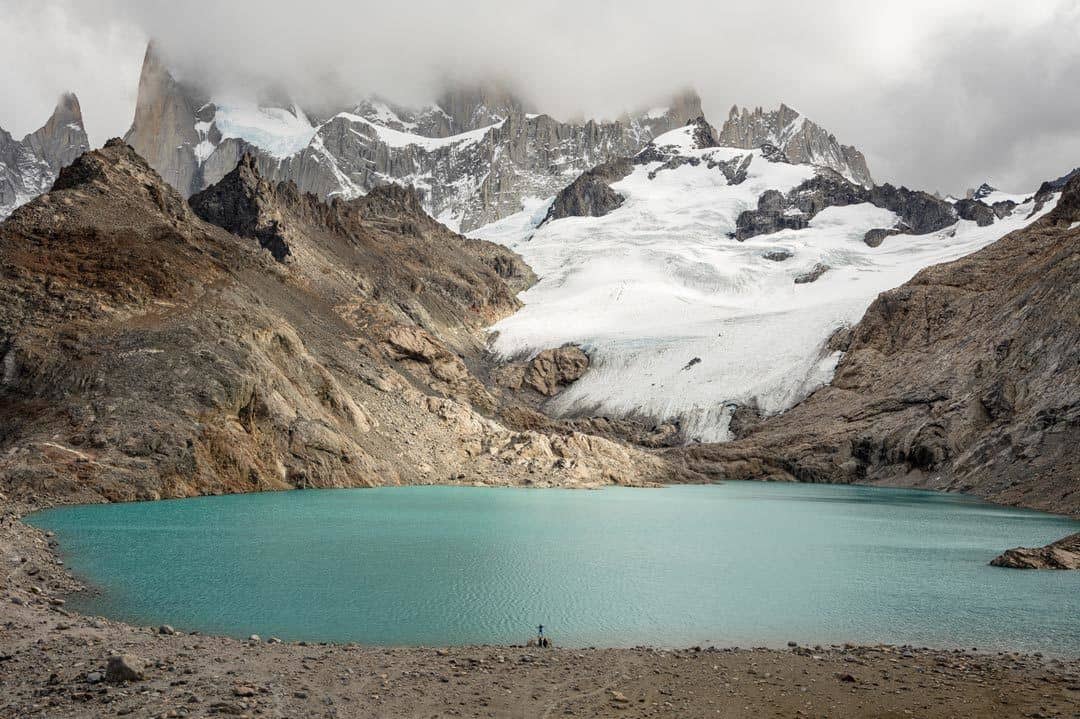
The hiking routes take you from lush meadows of wild flowers to snowy-rugged peaks at the base of the world famous Mount Fitz Roy.
Just the thought of hiking in Torres Del Paine National Park sends shivers down my spine. Ever wanted to visit one of the world’s most famous granite peaks? Cerro Torre in Patagonia is your place to do so.
There are literally endless kilometres of hikes to do, but it can be very difficult to choose just one when everything looks like it’s worthy of being on a postcard.
Patagonia truly is one if not the most beautiful places on earth, so where do you begin?
It’s every adventurer’s desire to get a taste of what trekking and hiking in Patagonia is like, so I have established a list of the best day hikes to the some of the world’s most stunning multi-day treks.
READ MORE: Don’t miss our guide on backpacking in Patagonia on a budget.
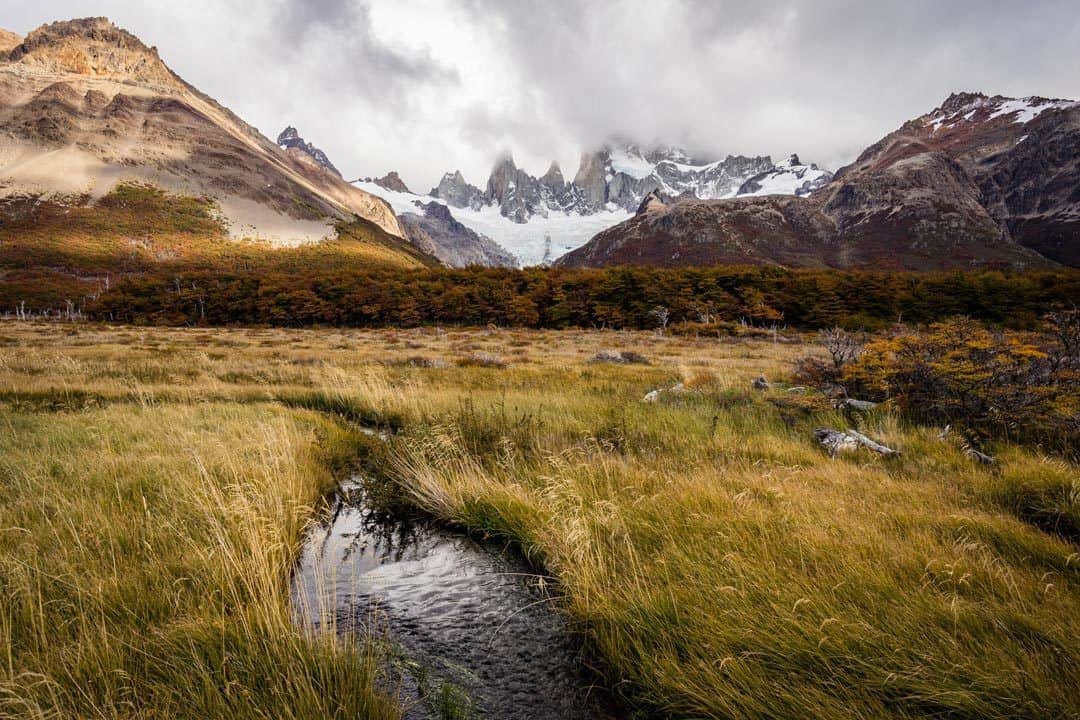
Table of Contents
Hiking to Mirador Las Torres
Lago grey (grey glacier), the french valley – valle del frances, los cuernos trail, the “o” circuit, short hike to condor lookout, day hike to the base of mount fitz roy – laguna de los tres, day hike to cerro torre, the huemul circuit, laguna esmeralda, glaciar vinciguerra, sierra valdivieso circuit, laguna tigre sur, valle rio moscu, cerro castillo, pumalin park – cascadas waterfalls hike (escondidas), save this pin for later, the best time to go hiking in patagonia.
Early November until late April are generally the best times to go hiking in Patagonia, however this can change from year to year due to varying amounts of snowfall.
Not a fan of the cold? Try and head there in February and March for the warmer months for some great Patagonia trekking.
Also it’s necessary to know that weather in Patagonia is so varied and can change at any time, which can very quickly alter your Patagonia hiking trip. Keep that in mind when planning your adventure.
Hiking according to the seasons in Patagonia has both pros and cons no matter what time of year you decide to go, so if you were going to pick a time, aim for the end of March to mid-April, where weather seems to be slightly cooler but more stable allowing you to enjoy Patagonia in all its glory.
But the best reason for visiting Patagonia at that time of year is to see the entire region in autumn colours! Simply breathtaking.
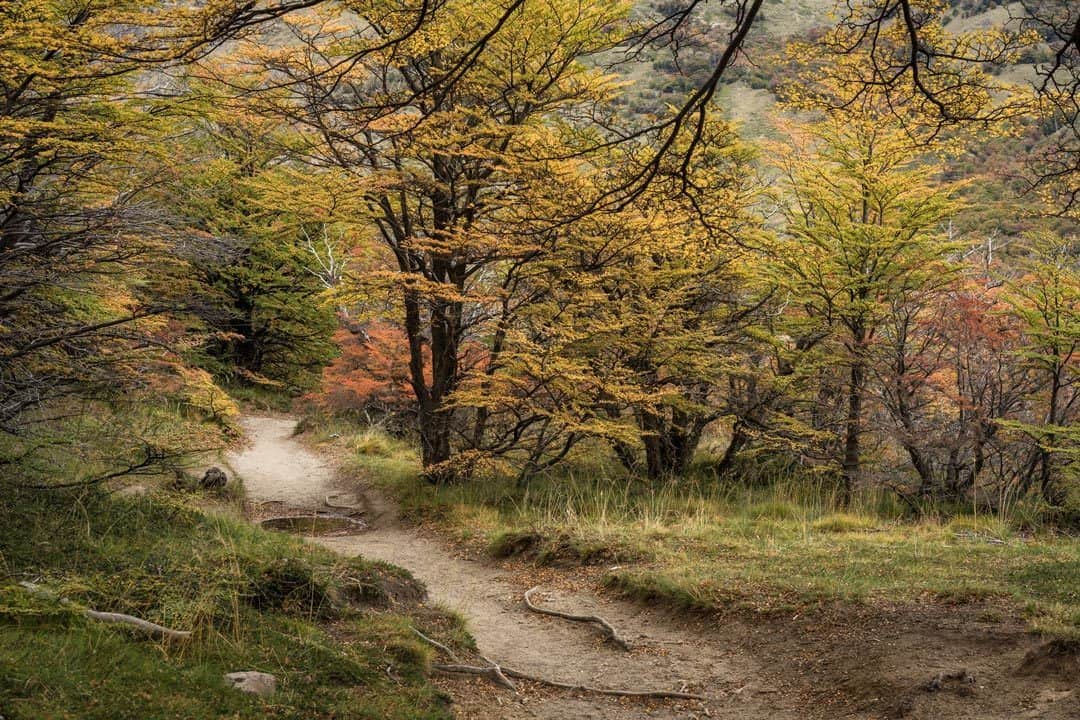
Hiking In Torres del Paine National Park
When it come to hiking in Patagonia, no trip would be complete without spending at least a few days in Torres del Paine National Park, the crown jewel of Chile.
Whether you’re interested in just heading into the park for a day hike, using one of the accommodations inside the park as a base (we personally recommend EcoCamp ), or carrying all of your camping gear and completing the famous O Circuit, you definitely won’t be disappointed with the trekking here.
- Time Required: 8 to 9 hours
- Distance: 18km
- Difficulty: Hard
- Start / Finish Points: Hotel Las Torres
Widely considered to be the most popular day hike in Torres del Paine, Mirador Las Torres is just one of the magical places you can hike to when in Torres del Paine.
Las Torres translated to English means ‘The Towers’, and mirador means ‘Lookout’ , so you should have an idea of what to expect up there.
The Towers are a series of 3 jagged peaks that literally tower over a turquoise lake below, and chances are you’ve already seen a photo of them at least once in your life.
This particular trek is 18 kilometres of visual delights, despite it being considered as a difficult hike, and the views once you reach the top are just awesome!
Most of the trek is uphill, but don’t let that put you off this classic day hike, as cascading waterfalls, forests beaming with life and boulder fields dominating the higher landscapes and just waiting for you to enjoy.
The last hour is extremely steep, so make sure you save some energy for the final slog.
If you are after a really magical experience spend the night in the park and start hiking up in the dark. If the weather cooperates you’ll be rewarded with Las Torres looking as though they’re on fire with the red sun lighting them up at sunrise.
Las Torres is a hiker’s dream, and if you could only choose one trek in the whole of Patagonia, this would be it! Return via the same way you climbed, starting and finishing at the Hotel Las Torres.
Prefer to hike with a guide? Book your Mirador Las Torres tour here with Get Your Guide.
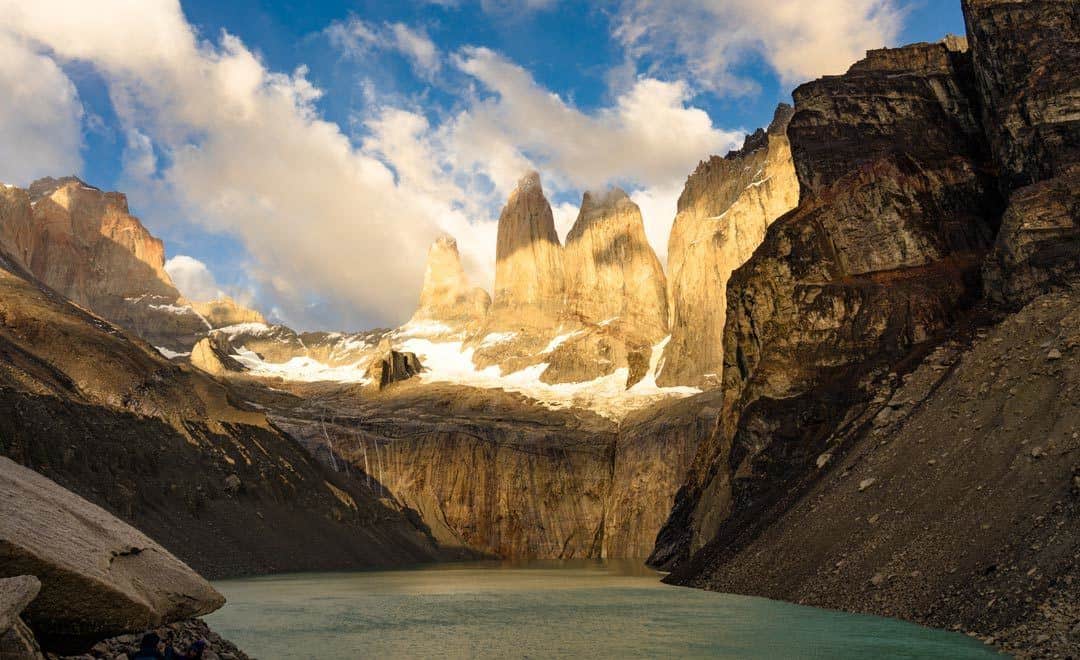
- Time Required: 3 to 4 hours
- Distance: 11 kilometres
- Difficulty: Easy to moderate
- Start / Finish Points: Mountain Lodge Paine Grande to Refugio Grey
As you might know there are quite a few glaciers in Patagonia (you can even visit some on an amazing glacier cruise in the Chilean fjords ), but this one takes the cake as the best of the best.
Along the famous “W” Trek, towards the western part of the hike, is a long section that follows the Lago Grey lake, which is gradually fed by a huge glacier known as Glaciar Grey.
Here you can expect to see pale blue icebergs floating around in the Lago Grey, as parts of Glaciar Grey collapse into the lake below and it’s a spectacular sight to see!
From Refugio Grey to Mountain Lodge Paine Grande is a 3 to 4 hour hike spanning over 11 kilometres, with little ascent or descent making it a fairly easy day out.
Expect to see vast areas of vegetation, wild flowers and the odd section of track that requires a tricky traverse but nothing too major. Keep an eye out for the majestic Cerro Torre piercing the sky.
Camping is available at Mountain Lodge Paine Grande and Refugio Grey if you want to spend the night there. Otherwise take the ferry to Paine Grande or Refugio Grey and start walking.
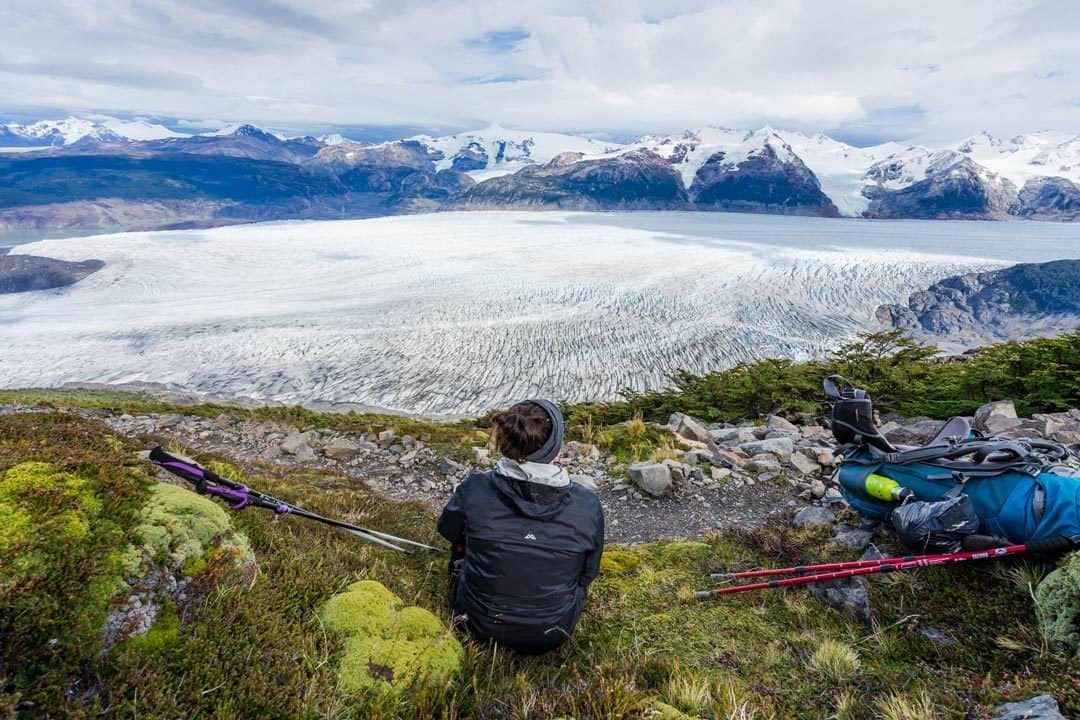
Alesha enjoying the view over Grey Glacier.
- Time Required: 3 to 4 hours
- Distance: 12km
- Difficulty: Moderate
- Start / Finish Points: Refugio Los Cuernos
You always have energy in Patagonia, even when you are literally falling asleep, so don’t miss this epic side trip that takes you between the Cerro Paine Grande and the Cuernos del Paine following the flowing river of the Rio Frances.
Why this hike is the one of the most spectacular side trips is because it has frozen waterfalls…how cool is that?!
READ MORE: We’ve just published our best hiking tips after 15 years trekking!
Also pretty dangerous though, so don’t be getting your ice picks out too soon, because there are views much higher up that you can enjoy, such as the 15 minute trek past the Campamento Britanico placing you in an almost cathedral of mountains.
The Mirador right towards the end is complete with a series of tarns beaming the reflections of the surrounding mountains making it that ideal moment to getting that camera of yours out! Camping is available (minus the facilities of toilets etc). Return the same way you came.
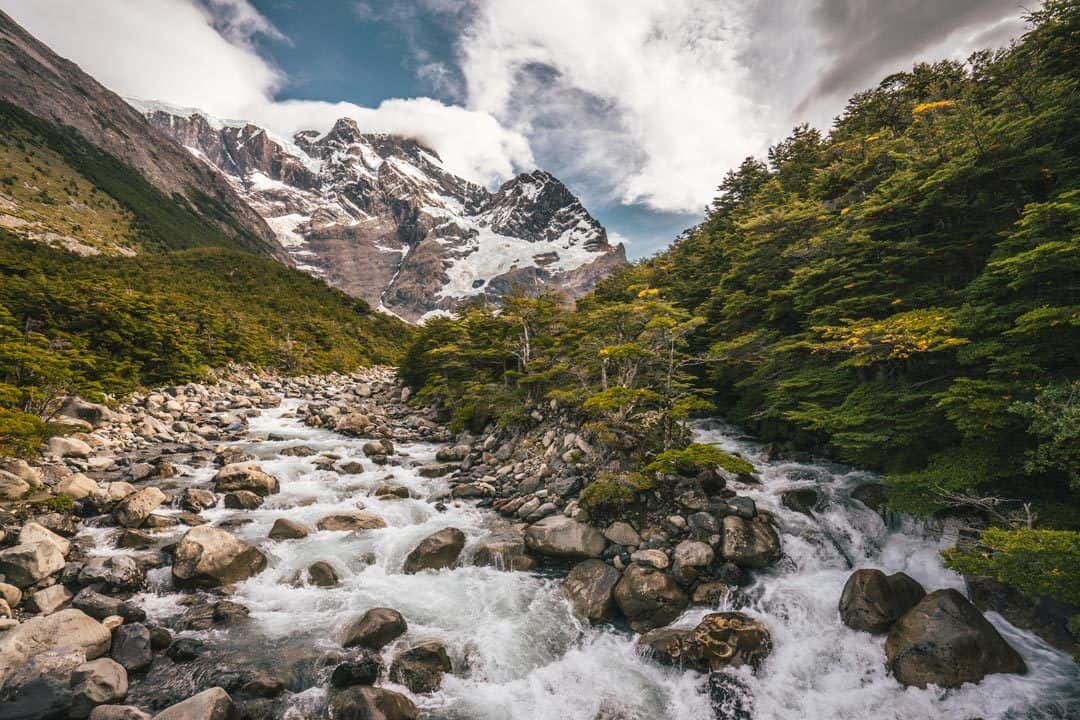
- Time Required: 6 hours
- Distance: 22km
- Difficulty: Moderate
- Start / Finish Points: Hotel Las Torres to Refugio Los Cuernos
Based along the front half of the park, home to the W Trek, is a fantastic day hike weaving around a series of steep banks perched along the edges of the Lago Nordenskjold.
Los Cuernos Trail, which means ‘The Horns’ in English and named after the mountains you can see that are shaped like horns, is a beautiful stretch offering views of the Cuernos del Paine, which never cease to amaze, and gorgeous vistas over the lake.
If you still have bounce in your step when you finish the trail, consider a side trips up the Valle del Frances, an additional 12 kilometre stunning section of track.
Plenty of camping is available on the south side of Cuernos Del Paine if you prefer to take more time on this hike (just keep in mind it gets quite windy in these camp spots).
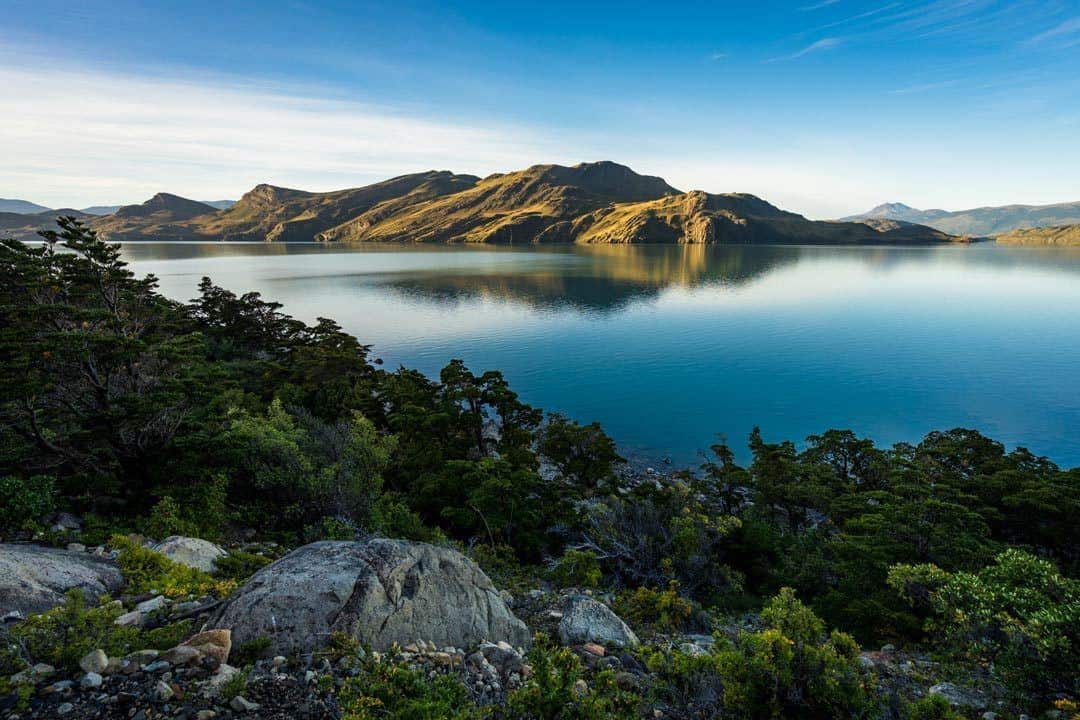
- Time Required: 6-8 days
- Distance: 135km
- Difficulty: Hard
- Start / Finish Points – Hotel Las Torres
Defined as one of the best treks on earth, the Paine Circuit, commonly known to the hiking world as the “O” Circuit due to its shape on a map, is a must do if you have a sense of adventure.
The circuit literally has it all, from pristine forests, meadows of native wild flowers to the grand peaks of Cerro Paine and Cuernos del Paine…and let’s not forget the addition of Las Torres along the eastern side of the trek.
You are best off starting at Hotel Las Torres and heading to Campamento Seron, where views of Cerro Paine (1,508 metres) dominate your surrounds along with rivers flowing off Lago Paine.
Once you connect with the track along the Rio de los Perros, mountains begin to pop-up more frequently along with glaciers, but be sure to pitch your tent at the campsite on Lago Dickinson, as views here are some of the best along the hike.
As you continue to be blown away by Grey Glacier in Torres del Paine (hopefully not by the wind), you find yourself on the trail that begins the “W” trek, which is the shorter, more popular sister of the O Circuit, which begins at Refugio Grey camping area.
Finishing the “O” circuit adds side trips along the French Valley (a must-do hike) and up to Las Torres to watch the sunrise, then heading back down to where you started.
If you want to finish on an alternative route, from Mountain Lodge Paine Grande you can hike along the Rio Grey to the Lago del Toro administration centre.
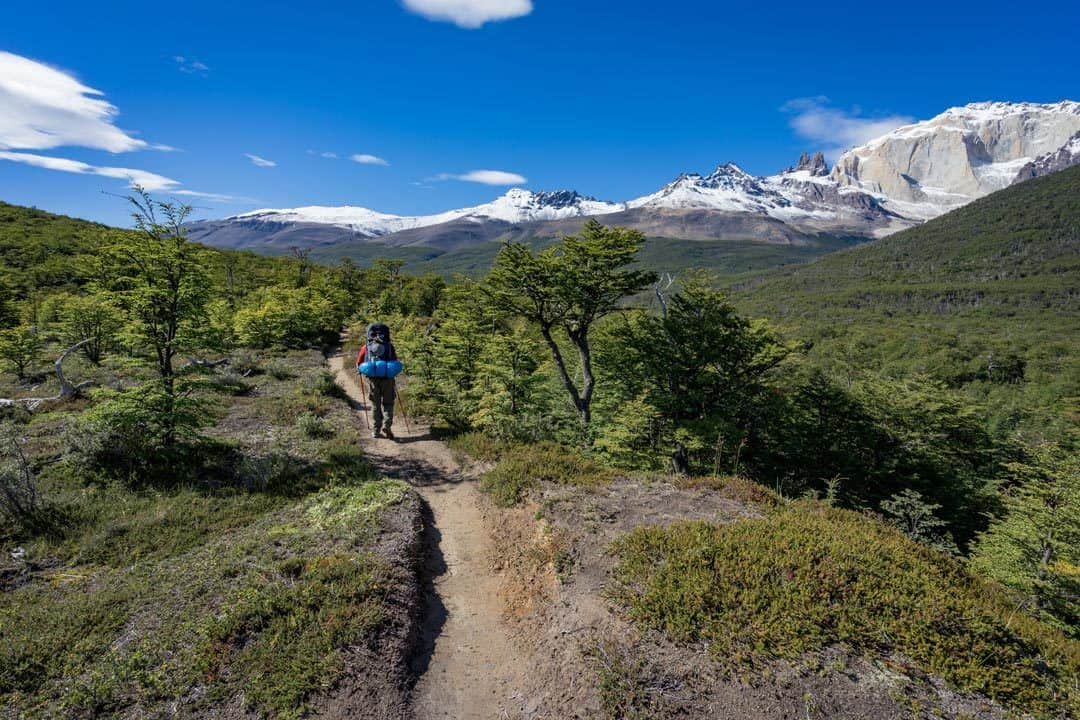
Trekking In El Chalten
While Torres del Paine is the most popular place to go hiking in Patagonia, the truth is El Chalten is the place that will steal most people’s hearts.
Across the border in Argentina, further north of Perito Moreno and its amazing glacier, is a tiny village called El Chalten that sits in the middle of Los Glaciares National Park.
What makes El Chalten so epic is that not only is entrance to the national park free (yes!!!), all of the hikes start from right in the middle of the village.
So once you’ve finished ticking off the quintessential Torres del Paine treks, head off to tackle some of the best hikes in El Chalten!
- Time Required: 1 hour
- Distance: 2km
- Difficulty : Easy
- Start / Finish Points: El Chaten
Based out of El Chaten is one of the shortest hikes in Patagonia, which mostly consists of a gradual ascent to views from Las Aguilas.
Just because it’s short doesn’t mean it’s not worth doing. The views are quite unexpected, as Viedma Lake appears with a backdrop of stunning, ever-covered mountains of snow.
This is a great hike to do for sunrise in case you don’t feel like camping out in the middle of the park. Return the same way you came.
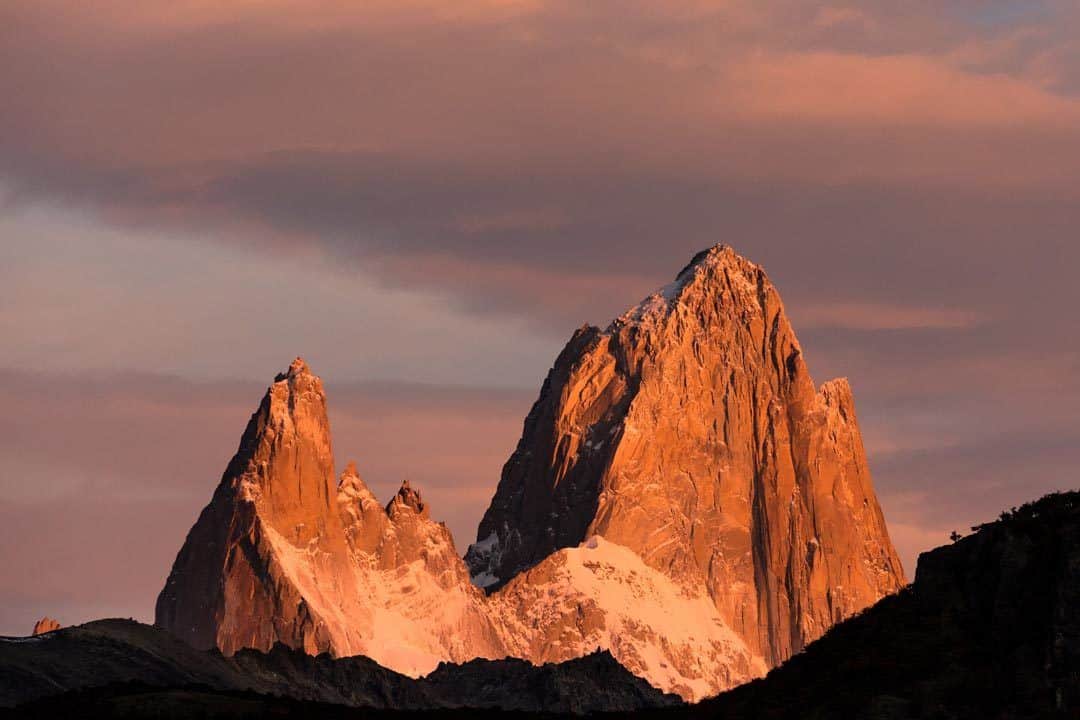
- Time Required: 8 hours
- Distance: 26km
- Difficulty: Moderate to hard
- Start / Finish Points: Northwest end of El Chalten
This hike will be the one that takes you as close as you can get to the foothill of Mt Fitz Roy, and one of the best hikes in El Chalten.
It’s best off to start early to enjoy the morning alpine glow on the peaks above, but that could be said of most treks in Patagonia.
The trail is pretty mellow to begin with, and there are a few narrow sections through forests which are lovely. Then the hard part comes.
Zig-zagging up and up for the last hour, you will finally reach Laguna de los Tres, with the most epic views of Mt Fitz Roy soaring above you!
Depending how skilled you are in the mountains, there is a climb that proceeds up the peak of Cerro Madsen (1,806 metres) for even better views of Fitz Roy.
Return the same way you came to head back to El Chalten, unless you are deciding to camp at Campamento Poincenot.
Prefer to have a guide? Book your Mount Fitz Roy tour here with Get Your Guide.
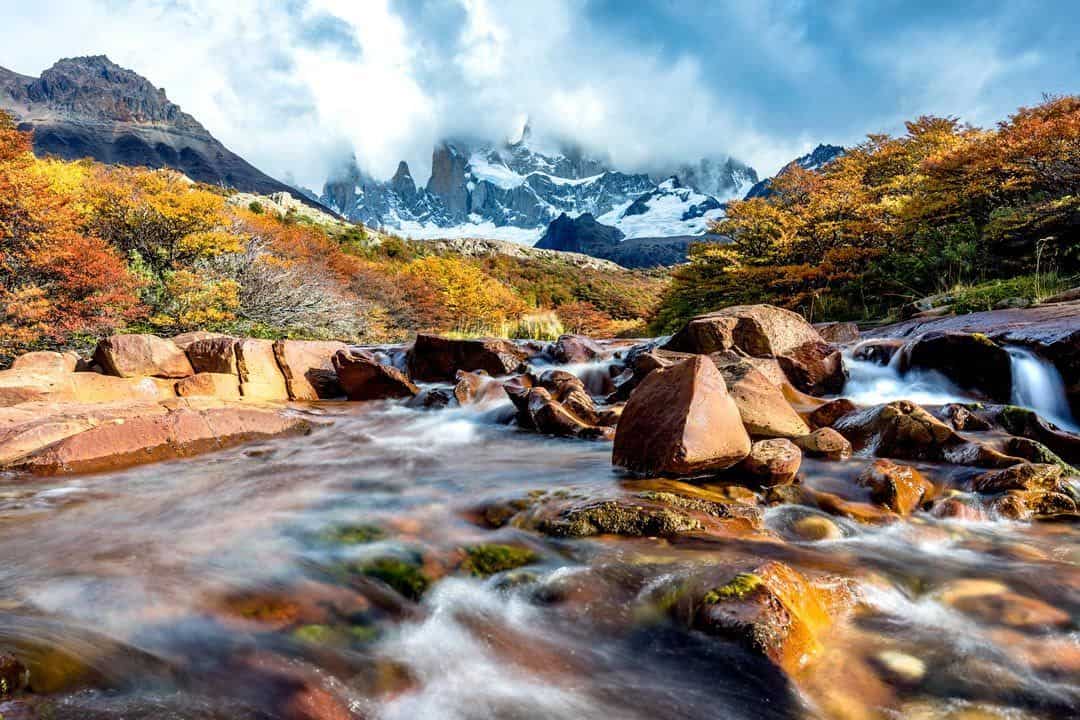
- Time Required: 2 days (can be done as a day hike)
- Distance: 19km
- Difficulty: Easy
- Start / Finish Points: El Chalten
A perfect opportunity to get up close and personal with Cerro Torre, reaching into the sky at 3102 metres, can be done as a day hike, but I think it’s pretty cool to take refuge at Campamento de Agostini at the base of Laguna Torre.
This 2-day trek is a culmination of lush meadows, rugged ever-changing glaciers and stunning views of Cerro Torre and its surround snowcapped peaks.
As a side trip, opt for the Mirador Maestri lookout which will add an additional 5 kilometres to your adventure. At Mirador Maestri be prepared for uninterrupted views of Cerro Torre in all its glory!
On return, head back the same way you came with views looking down the Rio Fitz Roy (a glaciated river from Glaciar Torre).
Prefer to have a guide? Book your Cerro Torre tour here with Get Your Guide.
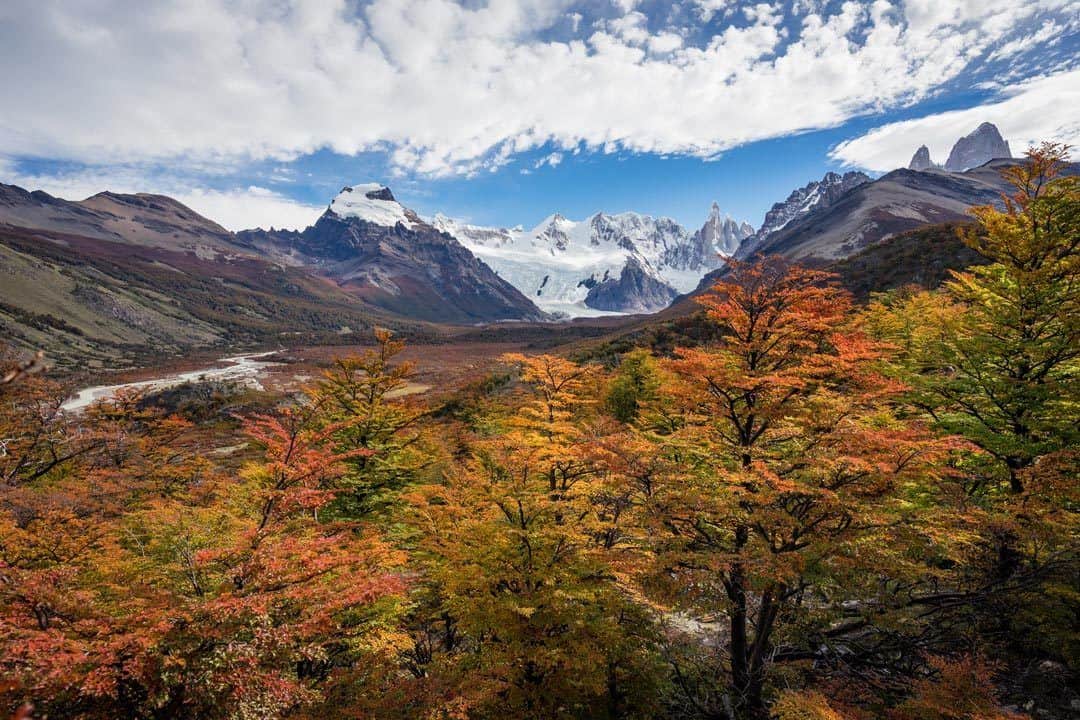
- Days Required: 4 days
- Distance: 63km
- Difficulty: Very difficult
This one is up there as one of the most difficult treks in Patagonia, so be prepared to be fully tested in this stunning lesser-known area of El Chalten.
This Patagonian trek, while demanding in nature, takes you into areas where Cerro Solo can be seen almost standing alone, hence the name ‘solo’.
Mount Huemul is also just as impressive as the contrast between the forest floor, fields of green pastures and rocky spires mix to create stunning views.
The Huemul track puts you to the test with a river crossing almost chest deep as you navigate the Rio Tunel with majestic mountain backdrops.
It only gets harder from here as the Southern Patagonian Ice Field nears, with a climb to Paso del Viento, which is sure to get your blood pumping.
But that’s not all, with a demanding climb to Passo Huemul presenting the clash of Lago Videma (lake) and the walls of the Videma Glaciar.
Views here are gobsmackingly awesome! Take your time to breathe in the fresh air before descending back the way you came.
The Huemul Circuit is considered as a very difficult trek, so its best off to hire a local guide who can help you navigate the rivers and provide insights into one of Patagonia’s most magical areas if you aren’t experienced.
Either way you’ll need a harness and know how to use it, so all hikers on the Huemul Circuit must check in at the information centre before departure to prove they know what they’re doing.
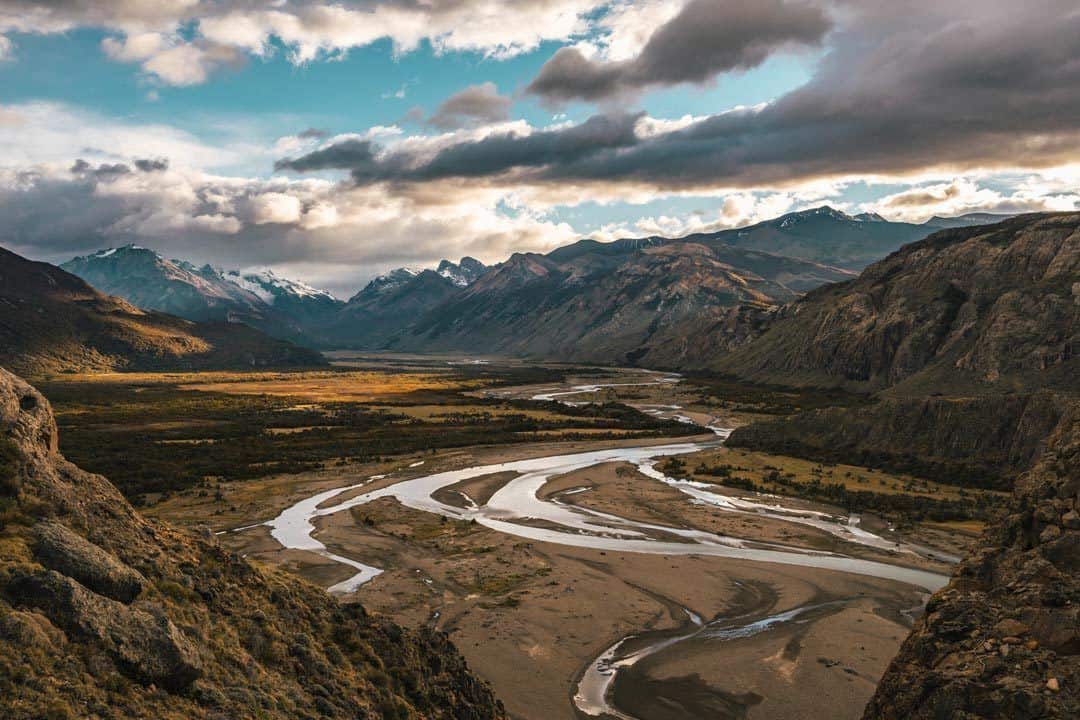
The Best Hikes in Ushuaia
Located at the bottom of Argentina and known as being ‘the end of the world’, Ushuaia is a place that often draws visitors looking to hang out at the bottom of South America. (Click here to read about our experience there.)
It also is a departure point for many people heading off on an expedition to Antarctica.
For those of us that love the outdoors, Ushuaia offers so much more though, and it’s worth spending a few days here to get in some good treks. These are some of the favourite hikes in Ushuaia!
- Distance: 9km
- Start / Finish Points: Refugio Valle Los Lobos
Patagonia isn’t all about multi-day treks, as sometimes the shorter it is the sweeter it tastes. Laguna Esmeralda is an easy 9 kilometre hike to the base of a glacier known as Glaciar Del Albino.
If you prefer to spend extra time taking in the stunning views, a refugios ‘ campsite’ is available near the lake towards the end of the hike allowing you to absorb your surrounds.
At the top, be rewarded with mesmerising views of the Esmeralda Valley down below.
Although this day hike is short, there is an opportunity to put on your crampons and go for a walk along Glaciar del Albino.
The walk on Glaciar del Albino does require advanced hiking skills and that extra bounce in your step, so add up to 4 hours on to your day.
If you’re not fully prepared for it and know what you are doing, don’t go past the 50 metre marker unless your name is Jimmy Chin.
- Days Required: 5 to 6 hours
- Distance: 13km
- Difficulty: Moderate
- Start / Finish Points: Tubera Valle Andorra
This moderately difficult Patagonian trek takes you to a series of glacial lakes with a few steep ascents, making this hike a worthy challenge for avid single day trekkers.
After a series of gradual/steep ascents, Laguna Encatada is finally reached, which is surrounded by lush meadows of grass with reflections of rugged peaks glimmering off its surface.
Hiking to Laguna Encatada provides a unique opportunity to climb the steady peak of Cerro Esfinge, rising to 1275 metres. At the top, the views are breathtaking!
When I think of this hike, I see rugged peaks, flowing hills of dark green grass blowing in the wind with cascading streams of water, and that’s exactly what it is!
The Glaciar Vinciguerra hike sees glaciers precariously wedged between the mountains you are hiking around, as glacial melt trickles past fields of wild flowers.
The water from the glaciers ends up accumulating in glacial lakes where the odd chunk of ice sits bobbing in the freezing waters.
Return the same way you came.
- Time Required: 4 Days
- Distance: 48.5km
- Difficulty: Demanding
- Start / Finish Points: Ruta Nacional 3 or Posada del Peregrine
Deep within the heart of the Fuegian Andes lays one of the more challenging treks in Argentina, but one that you definitely need to consider as a must do hike in Patagonia.
Trekking in the Patagonian Andes wouldn’t be complete with just lush-rugged forests; allow some icy peaks extending from the area’s many glaciers and crystal clear lakes (probably not ideal for swimming) to encompass your surrounds.
This particular trek is a lot quieter than some like the “O” Circuit, as tracks remain barely trodden, so a good sense of direction is always appreciated before attempting this 4 day, 48.5 kilometre trek.
Due to unstable weather conditions in this part of Argentina, it’s always appropriate to take more supplies than you think you will need.
Sierra Valdivieso is a culmination of muddy paths with contrasting streams of blue glimmering glacial water and is something that will acquire your sense of adventure.
This hike in the Fuegian Andes is a classic mix of snow, ice and scree which can be difficult in parts, but once you ascend to the high passes it all makes getting dirty worth it!
Prefer to have a guide? Book your Ushuaia hiking tour with Get Your Guide.
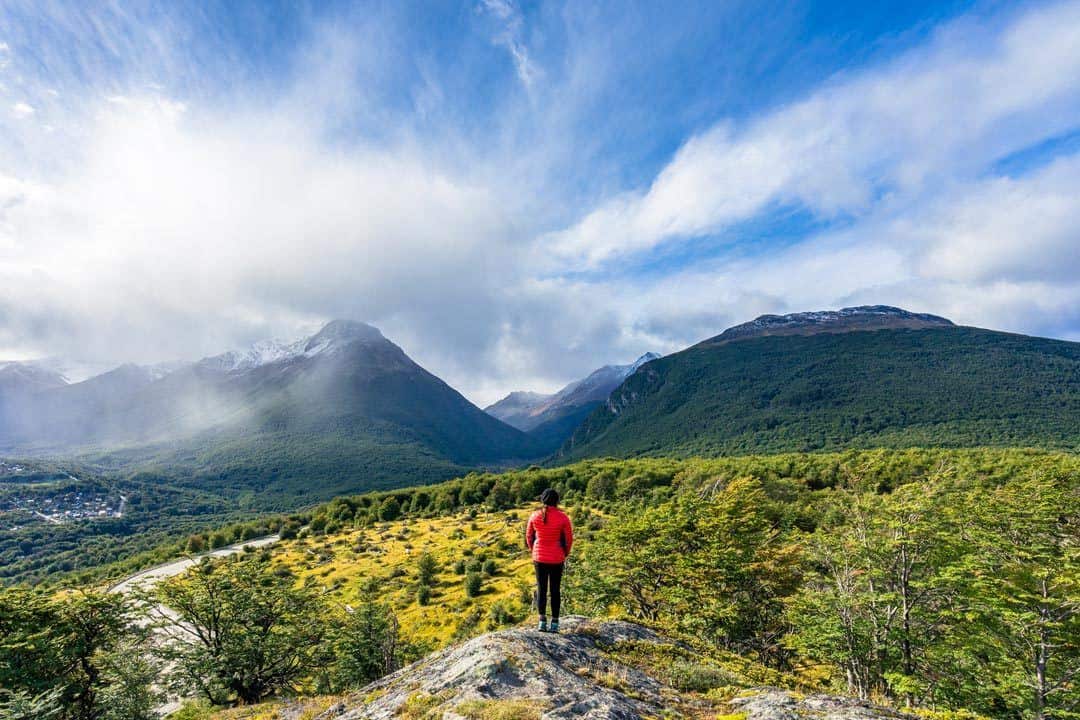
The Best Hikes Along The Carretera Austral
One of the least-visited parts of Patagonia is the long, narrow strip of coastline that makes up the bottom part of Chile.
While most people will make it to Torres del Paine and Puerto Natales , few cross back into the country and continue along the epic highway known as the Carretera Austral.
Public transport is just about non-existent along this long, rugged road, which leaves people to either hitchhike or self-drive between the towns.
When winter comes the place all but shuts down, so that leaves a big part of Chile that not many people see. But that doesn’t mean you shouldn’t check it out!
The Carretera Austral has some insane landscapes and gorgeous mountains and lakes. The coastline is as dramatic as you could imagine, and that all ads up for some amazing hiking!
- Time Required: 4 hours to 2 days (depending on side trips)
- Distance: 8km
- Start / Finish Points: Villa O’Higgins
Patagonia is known for its spectacular glacial landscapes and what better opportunity than to view them by hiking the Laguna Tigre Sur, a moderately difficult hike into some of the most densely populated region of glaciers.
This particular hike is best undertaken with the expertise of a local guide due to it being slightly confusing in regards to finding the correct track to take.
But don’t let that put you off visiting this glaciated area, as Laguna Tigre Sur offers a look into the wilder side of Patagonia, with the odd tricky ridge walk leading you to nearly undiscovered views, glaciers and mountain peaks.
High above the Glaciar Tigre is the Cordon Nevado where chilling winds and extreme temperatures can make things difficult so come prepared for the cold.
There are two side trips to choose from or you can do both with camping spots available. The first side trip leads to the base of the larger Glaciar Tigre Sur where wild flowers thrive in small pockets.
There are a few sections which require the use of your hands to navigate smaller gaps in the larger boulders. At the end of the trail its icebergs galore! Allow 2 hours for this side trip.
The 2 nd side trip continues onto the smaller glacier known as Glaciar Tigre, taking you past large gorges, pristine streams and colourful meadows. Allow 3 hours for this side trip and return the same way you came.
- Time Required: 2 days
- Start / Finish Points: Villa O’Higgins
Similar to what Laguna Tigre Sur provides in terms of glacial views, Valle Rio Moscu is an easy walk generally hiked in 2 days in order to explore a heavily glaciated valley towered by Patagonia’s famous jagged mountain tops.
Hiking at Valle Rio Moscu has a few tricky components such as small stream crossings, best to be taken when the river is low (check with local guides when this is).
The Rio Moscu is a fast-flowing river fed by smaller streams originating from the Cordon de Villa O’Higgins range, while glacial melt from the Ventisquero Rio Moscu contributes an overwhelming amount of water to the raging river.
Ideally it’s best to spend 2 days in the valley as you can explore a spectacular frozen world sitting high in the mountains above.
Camping is available at Refugio Rio Moscu, approximately halfway along the Rio Moscu.
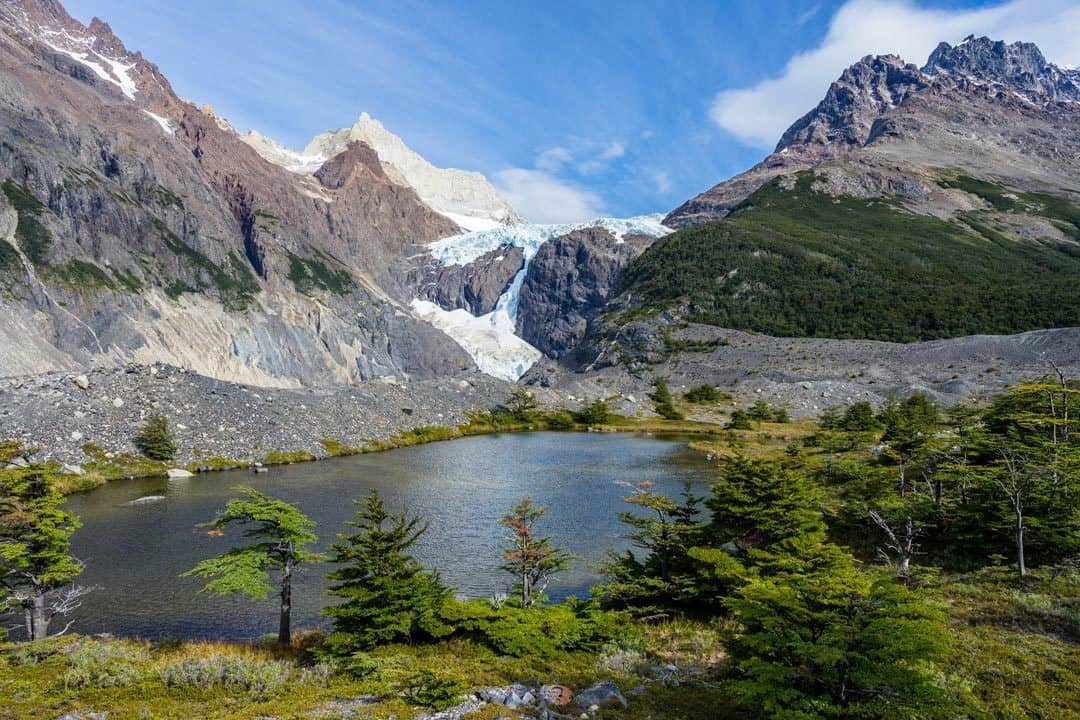
- Days Required: 4 days
- Distance: 62km
- Difficulty: Moderate to demanding
- Start / Finish Points: Las Horquetas Grandes to Villa Cerro Castillo
This 4-day trek will take you through majestic alpine landscapes guaranteed to lead you to plummeting waterfalls, isolated glaciers tucked away into the mountainous backdrops which you will find yourself immersed.
Cerro Castillo is a culmination of everything you think Patagonia is, all jam packed into this one epic Patagonian trek.
It will put you to the test with river crossings in freezing glacial waters, and parts of it needing spot-on navigational skills. Although tracks are well-trodden, they can be impeded by Patagonia’s wild untamed weather.
The whole hike consists of weaving in and out of a valley where mountains range from 1500 metres to a massive 2,675 metres of Cerro Castillo.
Camping is available the whole way along the trek, allowing you to take your time on one of Patagonia’s lesser known hikes which is increasing in popularity.
To gain a different perspective of Cerro Castillo, opt for the side trip into Upper Valle Parada, adding an additional 3 kilometres to your trek, where small lakes such as Laguna Duff remain hidden gems and well worth the extra few hours’ efforts.
The hike finishes at Villa Cerro Castillo, which can be taken by following either the Rio Ibanez or the adjacent path at Morro Rojo peak.
- Days Required: 1 to 2 hours
- Distance: 3.5km
- Start / Finish Points: Caleta Gonzalo
Pumalin Park is one of the world’s most remarkable nature reserves, not just because it is absolutely stunning, but because it would have been wiped off the planet if it wasn’t for a one awesome human being.
Doug Tompkins, the founder of the adventure gear company North Face, bought 400’000 hectares of land that was under threat from logging companies and turned it into a privately-owned by public-accessed park.
He later donated it to the Chilean government under the condition it would continue to be protected. The government agreed, adding more land to it, and today it is South America’s largest national park.
Pumalin Park can be kayaked if you prefer water, as 4 to 10-day kayak trips are available in this stunning part of the world.
However this article is all about hiking in Patagonia, so your best bet is to go for either those shorter hikes taking up to 30 minutes to the more demanding 8-hour plus hikes.
Cascadas is the one to go for as it showcases (as the name suggests) ‘cascading’ waterfalls. You will have to navigate through dense forests and wobbly wooden bridges and ladders before you reach the prize at the end of the trail, being the majestic Cascadas Bajas waterfall.
Camping is available at Rio Gonzalo.
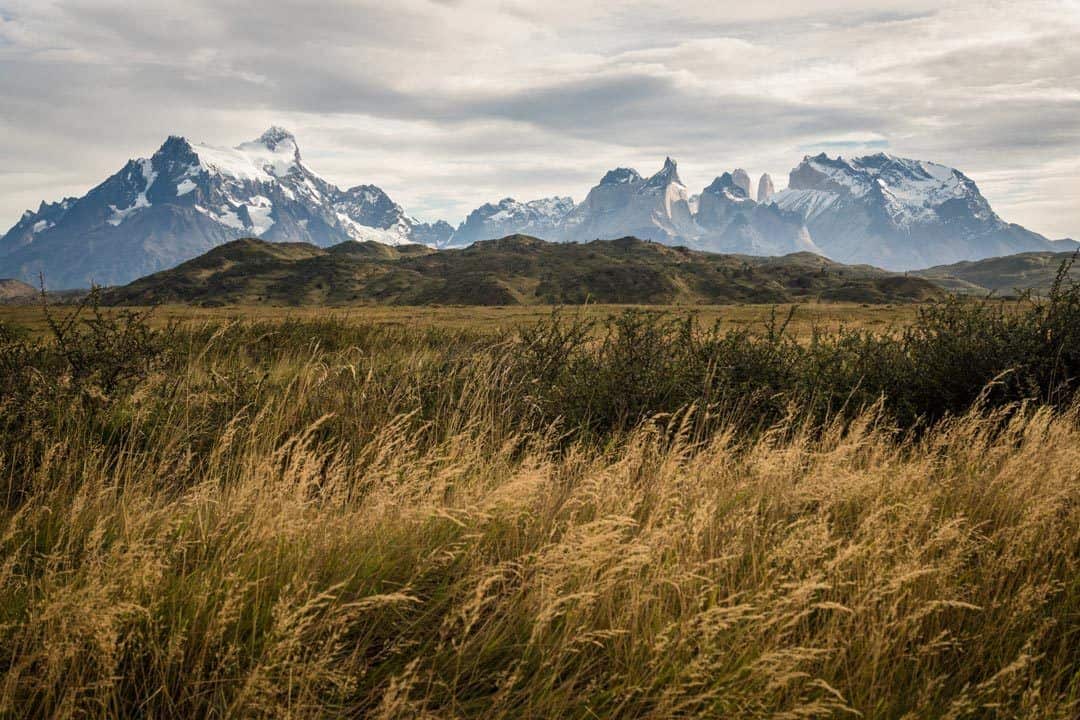
The Ultimate Trekking in Patagonia Packing List
Patagonia is certainly one of the most extreme, potentially harsh climates on earth, therefore it’s necessary to be prepared for all conditions months before you venture to the South American continent.
Hiking gear in Patagonia is quite expensive therefore it’s better to have your gear sorted before you travel to your destination. This packing list for hiking in Patagonia should give you a good idea on what to bring.
- Good quality, lightweight tent. Check out our guide to the best backpacking tents to find one that suits your style and budget.
- Thermal layering including top and pants
- Hiking pants, both long and short, or get convertible pants. These should be waterproof, otherwise get a pair of slip-over waterproof pants as well
- Gore-Tex (waterproof) hiking boots
- Quality backpack for hiking
- Down jacket – these puffy jackets are essential for keeping your torso warm
- Rain and wind jacket – make sure you get a quality jacket that doesn’t leak
- Sleeping bag and silk liner – The warmer the sleeping bag the better
- Cold weather gloves – you will need waterproof gloves aswell as a pair of inner gloves to keep your fingers warm
- Plenty of socks (dry socks are the best)
- A beanie – keeping your head warm is essential
- Hiking poles – if you’re carrying a heavy bag, hiking poles will help you balance. They also provide support for your knees.
- Ability to carry sufficient water (5 litres is ideal)
- Food to last the entire hike. You can pre-order food in some of the refugios in Torres del Paine, but that’s about it. Better to be over-prepared and over-fed then the other way around when hiking.
[box] Have you ever been hiking in Patagonia? Leave a comment below and tell us what your favourite trek was![/box]
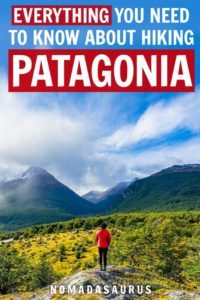
Calumn Hockey
Hi, We’re Alesha and Jarryd!

We’ve been traveling the world together since 2008, searching for the planet’s best destinations and adventures.
Love Travel?
Sign up for our free weekly newsletter for the best travel tips, ideas and deals!
We respect your privacy. Unsubscribe at any time.
READ MORE...
The Best Time To Visit Antarctica – Month By Month Breakdown
Siyam World Review – The Best 5-Star Resort in the Maldives
Sun Siyam Iru Fushi Review – 5-Star Luxury in the Maldives
Related Posts
Surviving the world’s most dangerous hike – mt huashan, cape fahn hotel review – the best luxury resort on koh samui, the true cost of free wifi, possibly my favourite travel poop story, ever, 18 thoughts on “hiking in patagonia – the ultimate guide to the best treks”.
Happy to read your post. I found your blog is very useful and informative. Thank you for sharing with us.
Actually, I am planning to hike in Patagonia in December. I hope I will have good weather. I loved your article; fascinating and helpful.
Patagonia is such a special place. Hope you get good weather. Even if you don’t it is still so beautiful in the rain or snow. Happy travels
Why you keep lying that Patagonia is chilean? Patagonia is ONLY on the Argentinian side (EAST of Los Andes.
Mt. Fitz has been high on our list since we saw Tommy Caldwell and Alex Honnold do the traverse there. I don’t think we’re up to the standards of the traverse but we’d definitely like to do some hiking around there, looks epic!
Great article guys, thanks!
Glad you enjoyed the article. Hope you get to climb Mt Fitz one day. 🙂
Great work guys, will definitely follow you in instagram, could you recommend some good travel companies who can help me with these hiking circuits, will be a solo traveller.
Hi Basu, thank you so much. We did our hikes through Eco Camp and they were brilliant. They have nice accommodation. We did not go with any other agent. 🙂
Thanks for this comprehensive list of treks near El Chalten. Could you tell me how is the biking scene in the town? I am a cyclist and love to ride in new places I visit. I was planning to take my bike on my trip to El Chalten, but not sure if it will be a good idea.
Glad this article could help. We didn’t go biking ourselves in El Chalten so we can not say about the treks. We are sure there is some in the area. If you contact one of the adventure tour companies they may be able to help. All the best and have a great time.
Fantastic blog! For the short hikes ie. <5 hours, are the trails easy to follow or well marked or do we need to know how to navigate? Thank you!
Thank you so much. Yes the paths are easy to follow and there are signage. You do have to have your own wheels to get to some of the hikes as the tourist shuttle doesn’t go near the beginning of them. Have a great time
This was great! Thanks! I know the answer to this, but I’m going to ask it anyways. Since there are camping spots along the way, are there toilets? Should we buy biodegradable TP for the day hikes?
Hi Sam, there are toilets at the campgrounds. Surprisingly all of them are flush toilets. Toilet paper is provided but always bring your own as the toilets run out. When you are hiking and need to use the bush toilet. Please bury your business and pick up your toilet paper. Thanks
Great Post, looking forward to exploring Patagonia.
Thank you so much
Love your blog 🙂 I wish I had more money to travel, cos nothing is better then collecting memories while traveling.
Thank you so much Miljan. Collecting memories is beautiful
Leave a comment Cancel reply
Save my name, email, and website in this browser for the next time I comment.

14 best hikes in Patagonia: from short walks to multi day treks
There is an incredible amount of stunning hiking trails in Patagonia. It is definitely a hiker’s paradise. You don’t even have to be in an incredible physical shape – some of the best hikes in Patagonia are accessible even to relative beginners!
We spent 10 days in Patagonia when we visited South America (Chile mostly, but still) in 2017, which is not exactly enough time to do any serious hiking.
In our case, we managed to do exactly one full day hike, since the weather made it rather dangerous to try others – the Laguna de los Tres hike from El Chalten in Argentina.
In addition to that we managed a short hike in Torres del Paine National park to the lago Nordenskjöld, which offers an incredible view of the Cuernos del Paine, and Mirador Los Condores from El Chalten in Argentina.
Plus, we did a guided tour on the Perito Moreno glacier in Los Glaciares national park – definitely, a must do.
Since we didn’t get to enjoy more hiking, I decided to do a lot of research to put together a list of some of the best hikes in Patagonia.
Honestly, it was almost impossible to choose between them, as each of the treks offers something different, but equally amazing.
As a side note, most of the hikes in Patagonia can be done without a travel guide. There are some companies, though, that offer guide services and who might even provide you with equipment for camping and preparing food if you’d like.
In this article you’ll see some of the best hikes in Patagonia, both multi-day treks, single day, and not even day hikes (I’d call them walks even).
Here you can see all of them on a map.
This post might contain affiliate links, which means that if you purchase anything via them, we might earn a small commission – at no extra cost to you. Check our affiliate disclaimer for more information. As an Amazon Associate we earn from qualifying purchases .
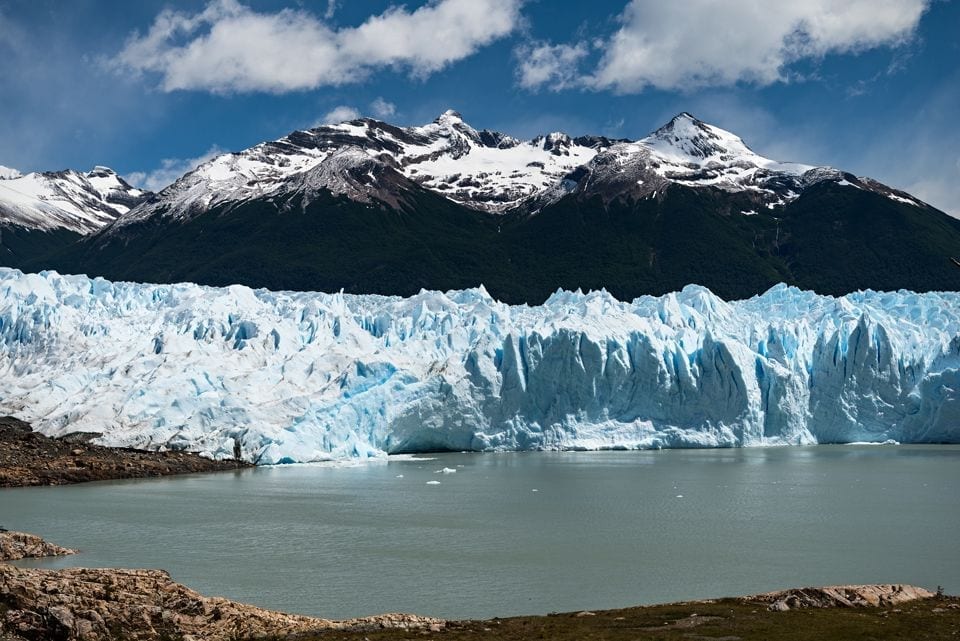
Best short hikes in Patagonia
By short hikes, I mean those that can be completed in less than 3 hours. You can do the trek and be back for a lunch in town.
Just because the hike is short, doesn’t mean that you won’t get to enjoy incredible views.
Hell, even the views from the side of the road tend to be jaw-dropping, so don’t be hesitant to add some of the easy hikes to your Patagonia itinerary.
Lago Nordenskjöld in Torres del Paine NP, Chile
The beautiful lake Nordenskjöld lies at the feet of the Cuernos del Paine in the Torres del Paine national park in Southern Chile.
The viewpoint of the lake and the Cuernos is just a short hike away from the Salto Grande waterfall.
The hike is more of a walk, and you’ll get to enjoy many interesting sceneries of the Patagonia wilderness – ragged peaks, emerald waters, and mesmerizing green meadows.
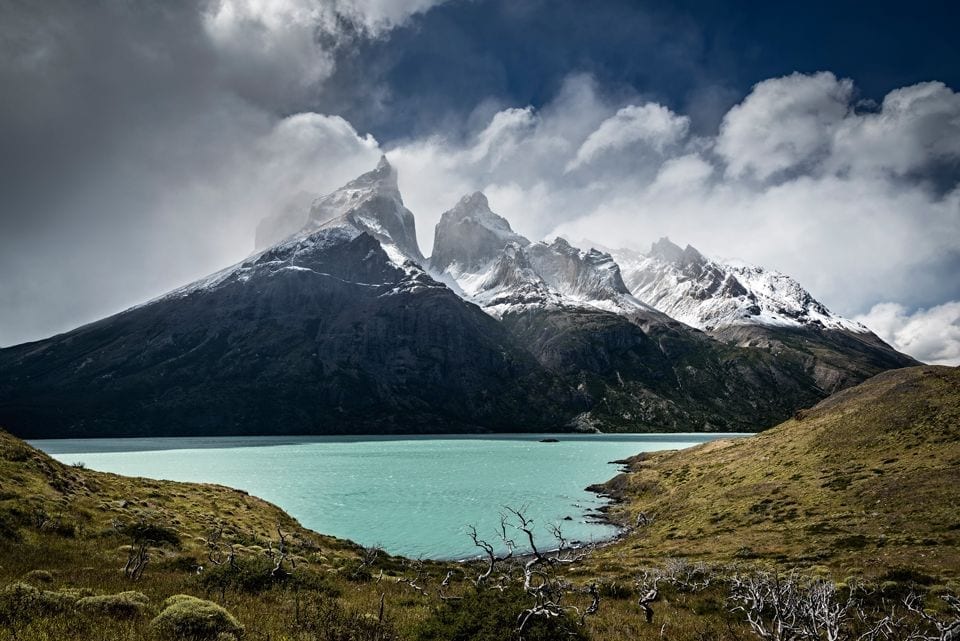
Location: Torres del Paine National Park in Chile Duration: 40 minutes to 1 hour Distance: approximately 2km Difficulty: very easy, minimal elevation gain What to carry: nothing extra is needed Paid? No, the only fee is to enter the park itself
Mirador Los Condores and Las Aguilas in Los Glaciares NP, Argentina
Technically, it’s two different hikes, but they are both at the same place. Just at one point of the trail, there’s a fork – if you turn left, in 10 minutes you’ll reach the Los Condores viewpoint, and if you turn right, it’s 30 minutes to the Las Aguilas.
The starting point of this walk is at the National park visitor’s centre in El Chalten. The trail is well signed, and it gives you the opportunity to enjoy some incredible views just a short and easy walk away.
As the name suggests, the trails offer you a chance to see some condors, as well as give a view of the lago Viedma.
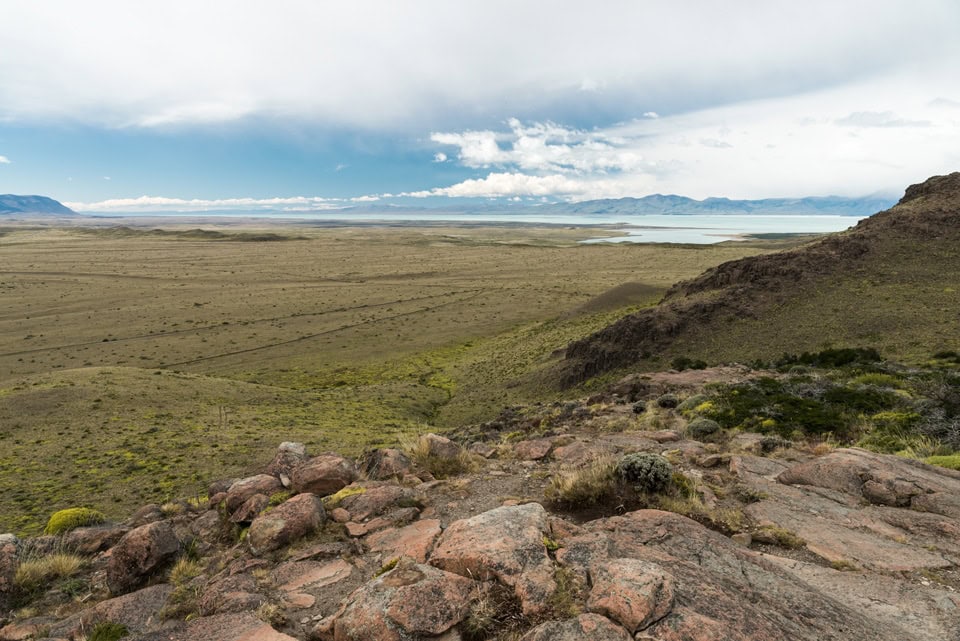
We did this hike the next day after doing one of the best hikes in Patagonia – Laguna de los Tres, when I thought that I wouldn’t be able to walk uphill ever again because of the muscle pain. But alas, we did it!
Location: Los Glaciares National Park in Argentina Duration: 2h Distance: 4 or 6km Difficulty: Easy, minimal elevation gain What to carry: nothing extra Paid? No
Related: Where to stay in El Chalten
Cerro campanario in nahuel huapi national park.
One of the most popular hikes in the Argentinian lake district, the Cerro Campanario hike is located near the town of Bariloche.
This easy walk offers you incredible views of Lake Nahuel Huapi, the Llao Llao peninsula, and the surrounding peaks and valleys.
At the top of the mountain, you get to enjoy views of some of Patagonia’s most stunning landscapes, such as El Trebol Lagoon and some of the mountains – Cerro Otto and Cerro Catedral.
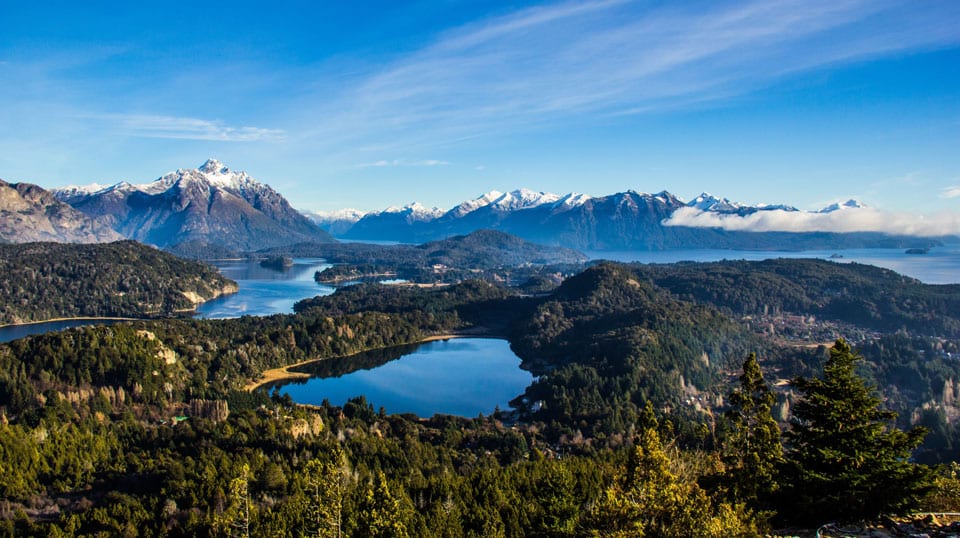
Location: Nahuel Huapi National Park in Argentina Duration: 30 minutes Difficulty: Easy, if a little steep at times; you can even take a chair lift What to carry: snacks and drinks. There’s a café at the end, but it’s expensive Paid? No, but the lift is paid
Mirador of Exploradores Glaciar in Laguna San Rafael NP, Chile
Get an unobstructed view of the Exploradores Glaciar with this rather easy and short walk to the mirador Mirador Glaciar Exploradores.
This short walk through the forest setting leads to a balcony where you can overlook the glacier in all its glory.
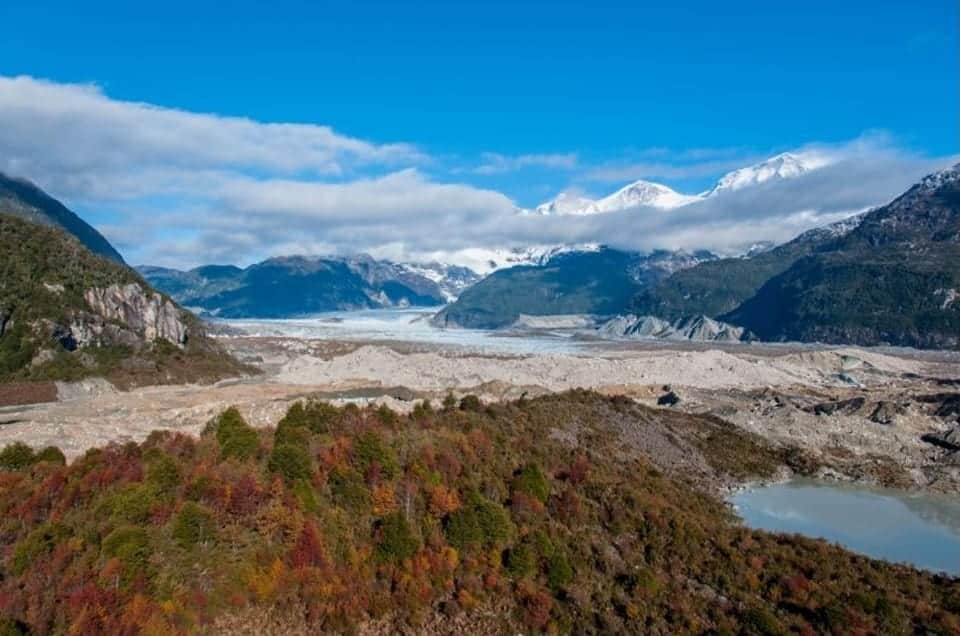
Is just looking at it not enough? You can go on a tour that takes you on the glacier itself!
On the tour , you get to experience walking on glacial ice, looking in some turquoise glacial ponds, and even going through ice tunnels!
Location: Laguna San Rafael National Park, Chile Duration: 25 minutes (6-7h for the guided trek) Distance: 1km (8,5km for the glacier hike) Difficulty: moderate, 60m elevation gain ( the glacier hike is rated moderate ) What to carry: snacks and drinks. Paid? The tour is paid
Best day hikes in Patagonia
Not too many people are ready to commit to a multi-day trek, so they (and us, for that matter) chose to go on day hikes instead.
But there are quite a few options of where to go for full-day hikes in Patagonia, both in Chilean and Argentinian one.
Minitrekking on Perito Moreno glacier in Los Glaciares NP, Argentina
Although this might be the most popular glacier hike in Patagonia and it’s definitely one of the most popular things to do in Los Glaciares , and you must do it with a tour guide, it’s definitely a remarkable experience to have.
Despite most of the glaciers in the world losing their mass due to global warming and climate change, the Perito Moreno glacier remains in a state of equilibrium, meaning that it loses as much of the ice as it gains. Plus, you can constantly hear the ice breaking and cracking, as the glacier moves approximately 2 meters a day!
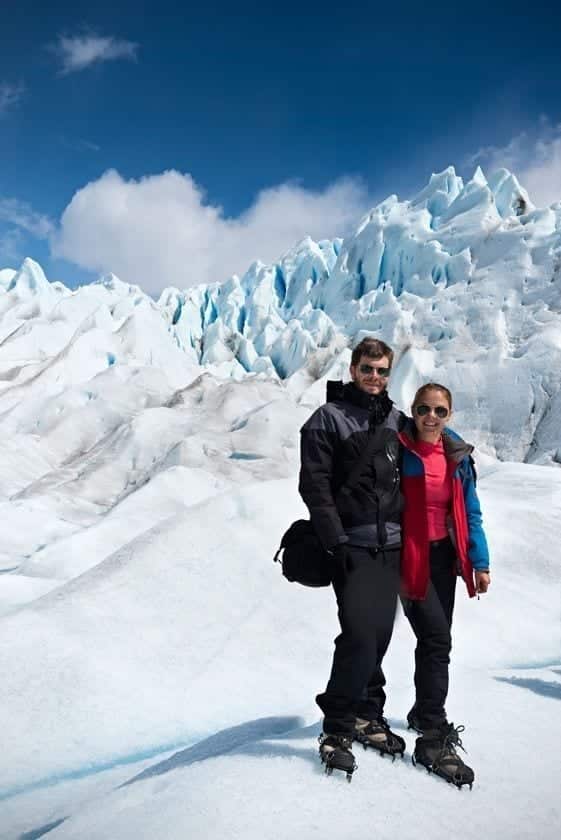
The company that does the tour we did – Hielo y Aventura – has two tours on ice – Minitrekking and Big Ice . There are also some other companies doing it – check out which ones in our article about activities that you can do in Los Glaciares National park.
Honestly, we did the minitrekking , but I wish we had done the Big Ice tour. I loved the minitrekking so much that I wished we could stay longer! And really, the minitrekking was much easier than I expected.
The tour guides speak English, Spanish, and Portuguese. They not only take you on the trek but provide you with information about the glacier and glaciology in general.
After the tour, definitely spend a bit of time on the balconies overlooking Perito Moreno! We saw some enormous chunks of ice fall off the side of the glacier, it was just phenomenal!
Location: Los Glaciares National Park in Argentina Duration: 10 hours (1,5h on ice); includes transfer times (optional) Difficulty: moderate What to carry: food for after the hike, warm clothing Paid? Yes
Don’t feel like hiking on the ice? There are cruise tours available as well.
Laguna de los Tres in Los Glaciares NP, Argentina
Obviously, since we did the Laguna de los Tres hike in Los Glaciares National Park ourselves, I had to start with it.
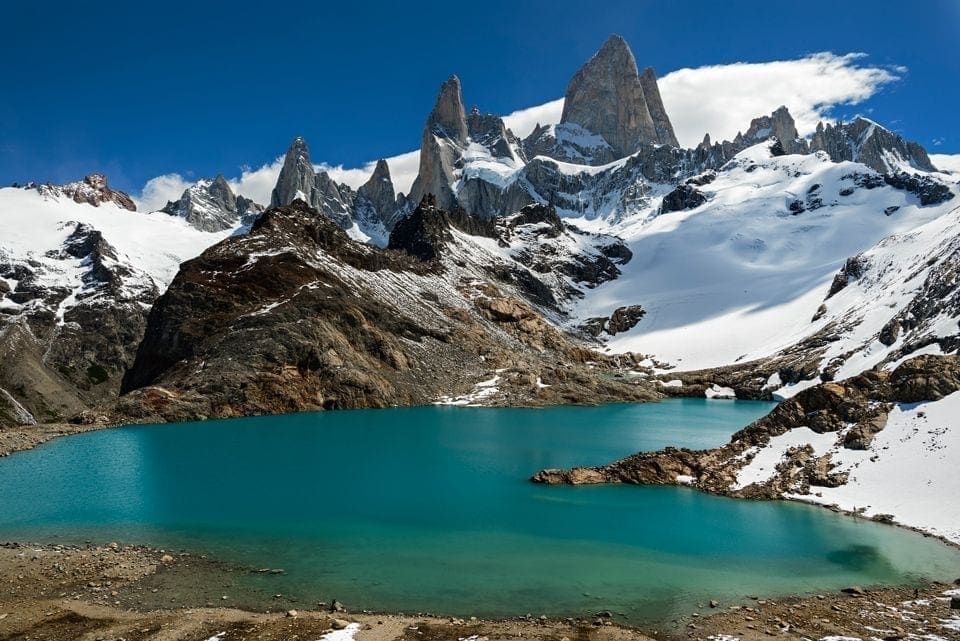
It’s one of the most famous hikes in Patagonia, so expect lots and lots of crowds. On the plus side, though, it means that it’s hard to get lost (the trail is well marked as well, though)!
The hike itself is rather easy for the most part, but the final hour or so is very strenuous.
We saw some children climb to Laguna de los Tres as well! It took them much longer than an hour to do the last part, though – we saw them both on the way up and down.
The view at the end, though? Definitely worth it.
The peaks of Mt Fitz Roy, Poincenot and Torre – the tres in the name of Laguna de los Tres – reflect nicely in the lagoon.
Don’t forget to check out the other laguna – laguna Sucia, located a tiny bit to the left of the Laguna de los Tres. Just a short hike uphill will open up another incredible view to you.
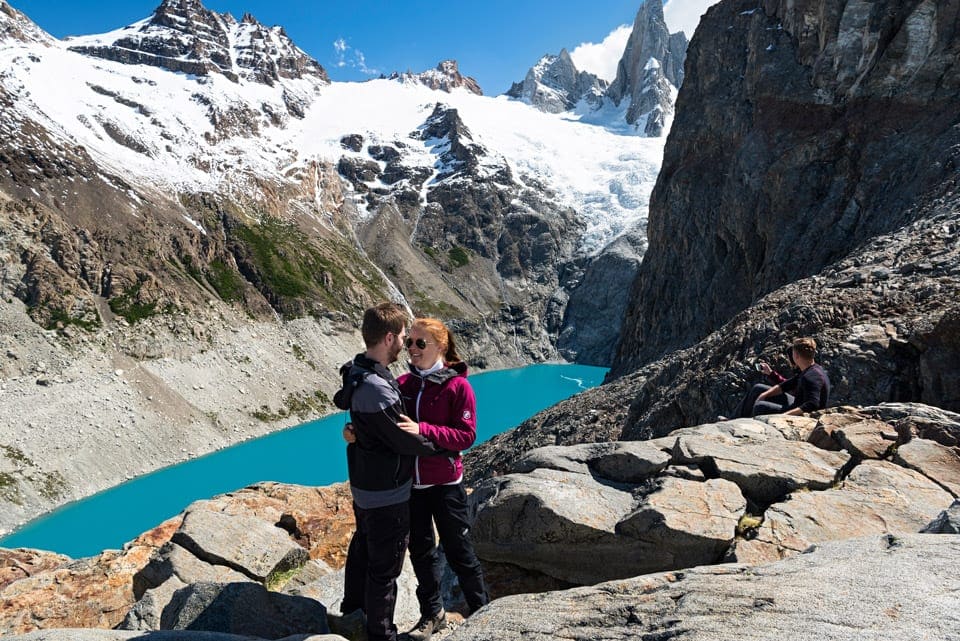
You can even make this a multi-day trek – there are campgrounds on the trail near the last ascent to the laguna de los Tres. It’s one of the most unique things to do in Argentina!
Give yourself the unique chance to enjoy the sun rise over the lagoon!
Location: Los Glaciares National Park in Argentina Duration: 8 to 10 hours Distance: 23km Difficulty: moderate to hard, cumulative approximately 960m elevation gain What to carry: Hiking poles Paid? No (unless you do a transfer)
Laguna Torre in Los Glaciares NP, Argentina
Another amazing day hike in Los Glaciares with the starting point in El Chalten.
This relatively easy hike offers several incredible lookouts (miradores) where you’ll have a chance to see the peaks of Cerro Torre. Most of the hike is along the shores of the Rio Torre, until you reach the glacial laguna Torre.
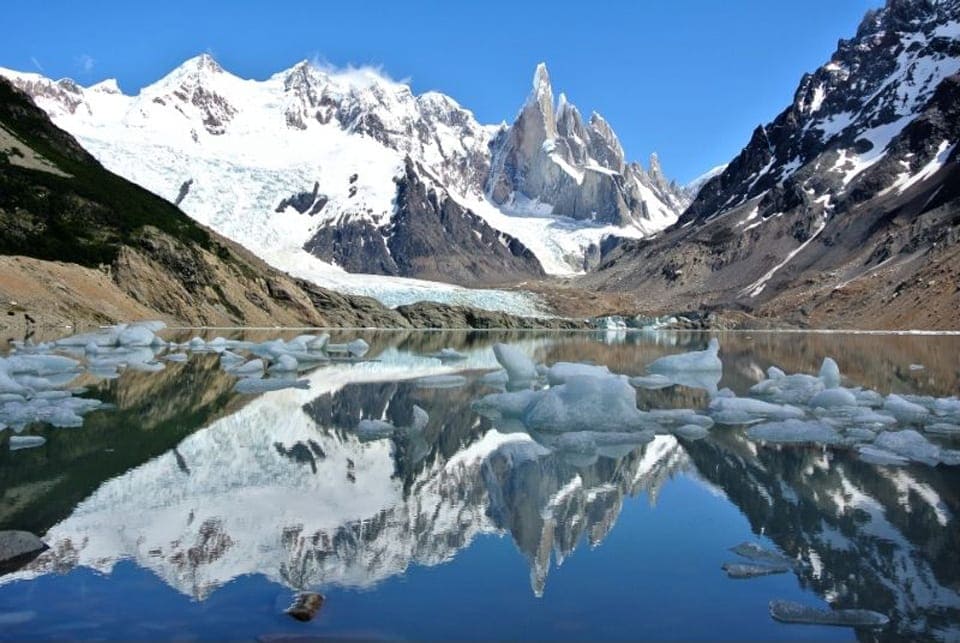
If you decide to go the extra distance along the laguna Torre to Mirador Maestri, you’ll get to see the icy tongue of Glaciar Torre peeking out of the rocks.
Laguna Torre is the start of the Huemul Circuit, so even if you don’t do the full one, you still get to experience at least a part of it!
Location: Los Glaciares National Park in Argentina Duration: 5 to 6h Distance: 20km Difficulty: easy, 250m (350m to mirador Maestri) elevation gain Paid? No
Grey Glacier in Torres del Paine NP, Chile
The Grey Glacier is one of the most spectacular glaciers in Torres del Paine National Park , which tumbles into Lago Grey.
There are several ways to explore the glaciar Grey – go on a boat tour, kayak, go on a glacier hike, and, of course, do one of the best hikes in Patagonia – a day trek to the Grey Glacier.
The Lago Grey hike is part of the famous W trek, so you get to enjoy a part one of the best multi-day treks in the whole Patagonia!
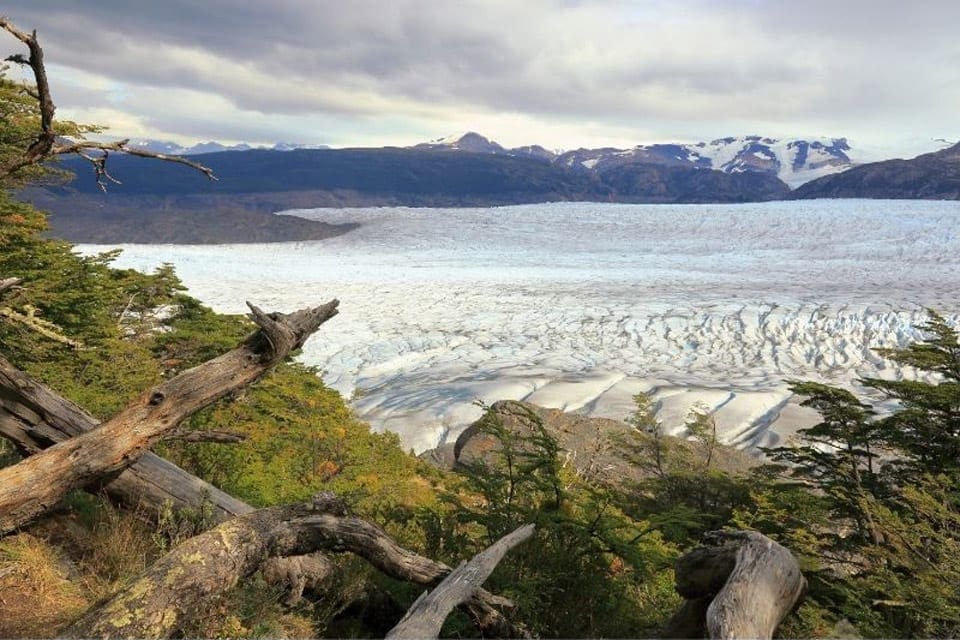
A huge glacier creating icebergs with a deep growl, the blue lago Grey, and the Torres del Paine mountains around – it is definitely a view not to miss.
The hike can be done in one day, but you must make sure to get back to the last ferry. Alternatively, you can reserve a spot at a refugio and enjoy it as a 2-day trek.
Location: Torres del Paine National Park, Chile Duration: 6h Distance: 22km Difficulty: hard Paid? Entrance fee to Torres del Paine, plus the ferry to the trailhead
Laguna Cerro Castillo in Cerro Castillo NR in Chile
Do you want to enjoy the Cerro Castillo mountains, but don’t feel like doing a multi-day hike?
A hiking trail that used to be an emergency route has opened up, letting you hike up to the Laguna Cerro Castillo in just a day!
Enjoy the turquoise lake, rocks covered in glacial ice, and the stunning looks of the castle -looking Cerro Castillo without worrying about camping in snow and rain.

Unlike the multi-day trek, you start this hike in Villa Cerro Castillo and return back to it.
Location: Cerro Castillo National Reserve, Aysen, Chile Duration: 6h Distance: 14km Difficulty: hard, 1000m elevation gain Paid? Yes, the entrance fee
Best multi-day treks in Patagonia
Patagonia is a hiker’s paradise with an enormous number of remote areas that have been barely touched by people.
That’s why it makes sense that most of the best hikes in Patagonia take more than just a day.
Take your pick of spending just a night in the wilderness or hiking for days on end. All of these hikes in Patagonia are breathtaking, each in its own way.
W trek (or the longer O trek/Torres del Paine circuit) in Torres del Paine NP, Chile
The most popular multi-day trek in Torres del Paine National Park is the W trek. It’s quintessential for any hiker who’s up for the challenge of a multi-day hike in Patagonia.
This crown-jewel hike takes you through the backcountry of the park on the trail that makes a W shape.
The W hike allows you to enjoy the best of Torres del Paine – the Glacier Grey, Valle Frances, Los Cuernos, Torres del Paine (the mountains), and Paine Grande. And that’s just in addition to all the turquoise lakes, raging rivers, wind-ripped forests, and emerald meadows.
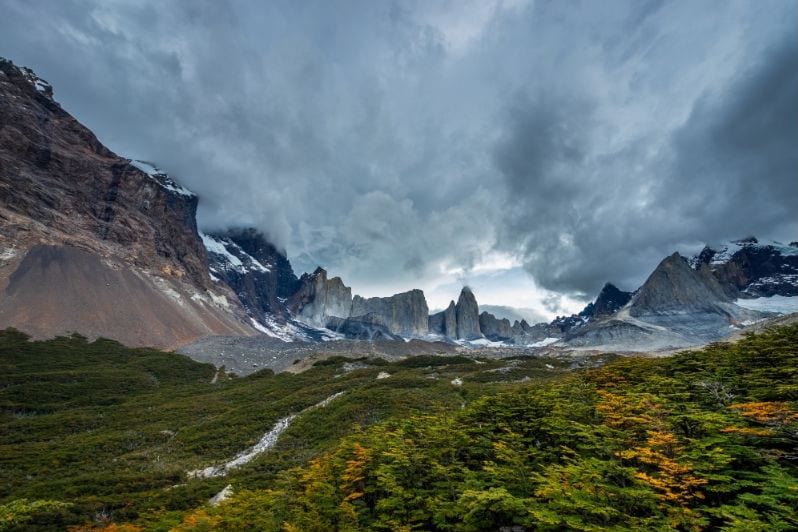
But, do you feel that the W is just not enough and have 3 more days to spare?
Add a little loop to your W and go on the O-trek, also known as the Torres del Paine circuit. It allows you to enjoy the lesser-walked Northern parts of Torres del Paine.
The extended O-trek gives you an opportunity to experience the Southern Patagonia ice field in all of its glory. Keep in mind that there are no refugios on the northern side .
Location: Torres del Paine National Park in Chile Duration: 5 days (9 for the O trek) Distance: 71km (120km for the O circuit) Difficulty: moderate-hard, elevation gain cumulative 2,956 meters for the W trek What to carry: camping equipment and food. Some refugios offer beds with bedding and food, though, but not on the O trek, where you’ll have to camp. Paid? Yes – you need to pay the park entrance fee and the accommodation/camping.
Cerro Castillo circuit in Cerro Castillo NP in Chile
One of the least crowded and most beautiful hikes in Patagonia is the Cerro Castillo Circuit in Chile. In some places, like the Cerro Castillo National Park website, this circuit is known as Las Horquetas, which is the starting point of the trail. It ends in Villa Cerro Castillo, which is 30km away.
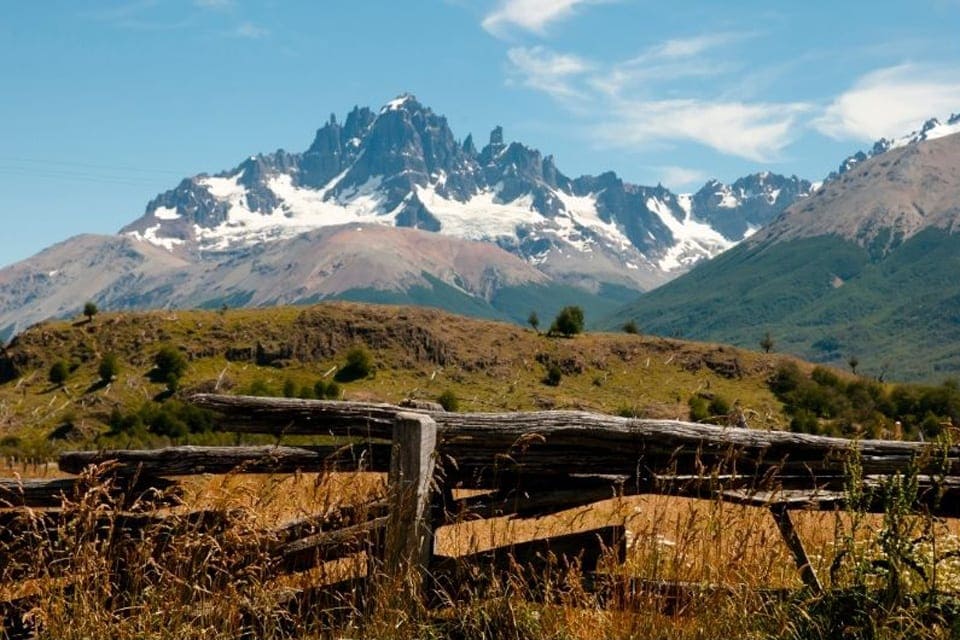
It offers Patagonia at its finest to you. There are turquoise lakes and blue lagoons, hanging glaciers, high mountains and deep valleys, lush forests and rich meadows.
Another outstanding thing about this one of the best trails in Patagonia? It’s still relatively unknown, so you can enjoy all the beauty Patagonia has to offer while meeting a fraction of people that would flood Los Glaciares or Torres del Paine!
On this exceptional trail, there are some campgrounds that have common picnic tables and even outside bathrooms. But make sure to carry food with you, as well as water purification equipment!
Location: Cerro Castillo National Park in Chile Duration: 4 days Distance: 57km Difficulty: hard, elevation gain 2374m What to carry: camping and cooking equipment, hiking poles Paid? Entrance fee. You have to cross private ground, which the owners charge for.
The Huemul Circuit Los Glaciares NP, Argentina
The Huemul Circuit is considered to be one of the hardest hikes in Patagonia. Only experienced hikers should go on these.
It goes over two mountain passes, is badly marked, and you cross rivers which sometimes requires ziplining. Since it’s a very demanding hike, you wouldn’t meet a lot of people, which means that you need to prepare for emergency situations as well.
On the other hand, the views definitely are worth it. There are massive glaciers, incredible mountain views, turquoise waters, and lush greenery. The view from Paso del Viento of the Southern Patagonian Ice field, though, definitely makes this one of the best hikes in Patagonia.
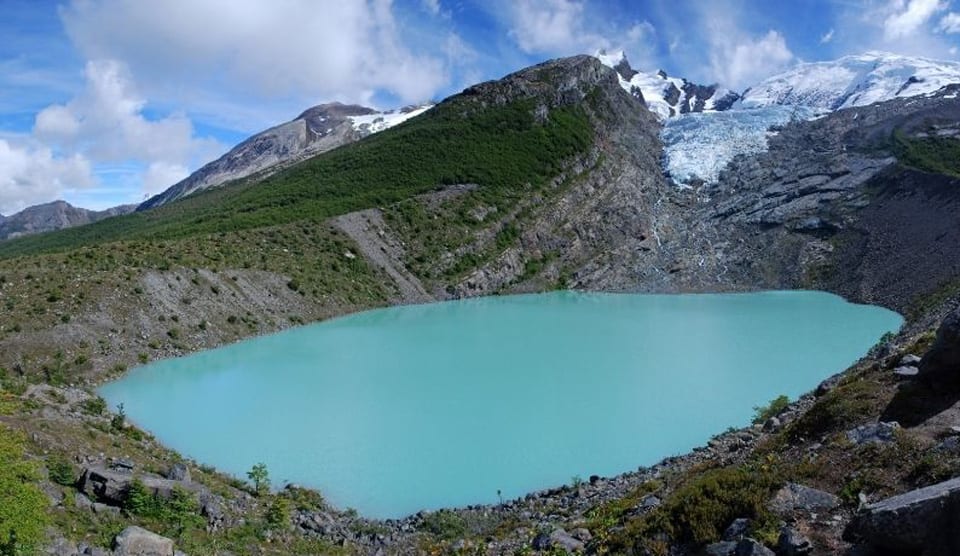
To go on this hike, you need to register with the Centro de Informes Ceferino Fonzo for the national park in El Chaltén to get a hiking permit, plus the rangers will check that you have the safety gear and know-how to use it. You need (per person) 1 harness, 2 carabiners, 1 safety line or sling, 1 thin cord or rope (35m long), a map of the circuit, and a cooking stove.
Location: Los Glaciares National Park in Argentina Duration: 5 days Distance: 64km Difficulty: hard What to carry: Safety equipment, map, compass or GPS. Camping and cooking equipment. Trekking poles. Bigger (45l at least) hiking backpack. Paid? Not, unless you go with a guide.
The Lago del Desierto Border Crossing – hiking from Villa O’Higgins to El Chaltén (Chile/Argentina)
This almost one-of-a-kind trek takes you over the Chile-Argentina border through the no man’s land.
Its starting point is located at the very end of the Chilean highway Carretera Austral – in the village of Villa O’Higgins (if you start in Chile), and you cross over the border to the town with the best hikes in Patagonia – El Chalten.
You can do it either from Villa O’Higgins to El Chaltén or the opposite way.
This trip involves ferries, buses, and camping.
On this hike, you get to enjoy the incredible lago del Desierto, views of the Mount Fitz Roy, plus the ferry on Lago O’Higgins will stop at the Glaciar O’Higgins before continuing on.
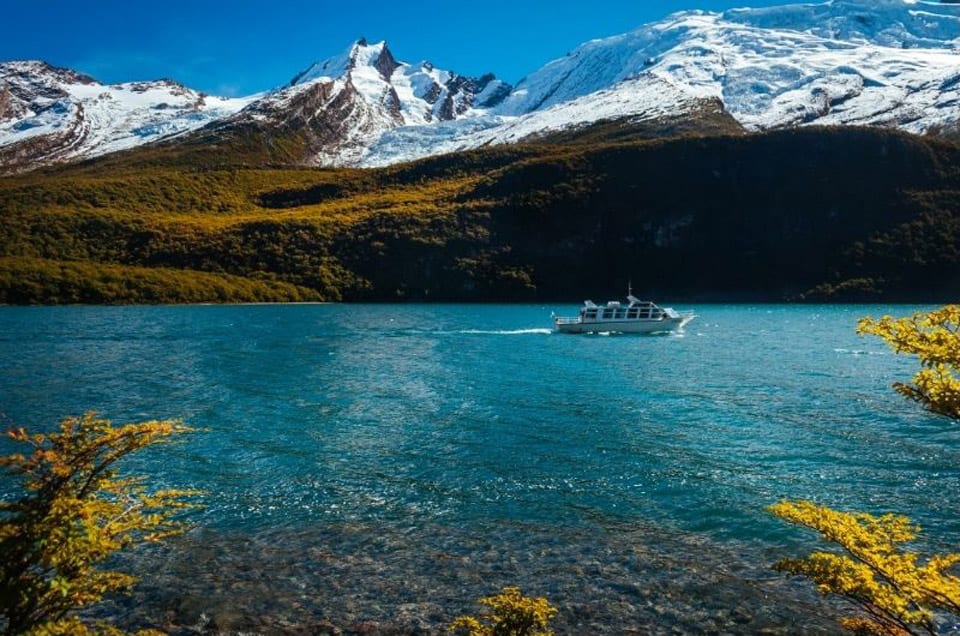
Location: End of Carretera Austral highway, border of Chile and Argentina Duration: 2-3 days Distance: 22km Difficulty: relatively easy What to carry: both Chilean and Argentinian pesos, camping equipment, food (in case you have to wait for a ferry). Keep in mind that you can’t bring fresh food into either country . Paid? Ferries and buses are paid
Los Dientes de Navarino in Chile
Named after the Dientes de Navarino mountains, this is considered to be the world’s southernmost long-term trek. It starts in the southernmost settlement known to sailors – Puerto Williams.
The trail circuits the jagged spires of Cordon de los Dientes, which looks like teeth, hence the name – dientes.

This trail in the very Southern Patagonia is not for the beginners nor the faint of heart. It goes through raw wilderness, the weather is savage, to put it mildly, and the trail rather empty, plus there’s no official rescue service.
But if you want to enjoy untouched landscapes with hundreds of lakes, view of the Cape Horn and the Beagle Channel, condors, guanacos, and so much more, plus you have the extensive trekking knowledge, then you can be one of the very few to complete the Dientes de Navarino circuit .
Location: Tierra del Fuego National Park, Chile Duration: 4-6 days Distance: 53km Difficulty: moderate What to carry: Camping equipment, cooking equipment and food, map, and GPS is beneficial as well. Paid? No, but if you don’t feel 100% sure about your abilities, it’s better to go with a guided tour. Plus, you need to get there (plane or ferry)
Tierra del Fuego is an incredible place. If you’d like to visit it, know that there are many more hikes here, and of course, so many other things to do. Matej from Czech the World can teach you a lot more about Tierra del Fuego .
Things you should take on all hikes in Patagonia
Although the hikes mentioned in this article differ in length and difficulty, there is some equipment that you should carry on all of them.
For ease of reading, I decided to write these basic items here in a separate paragraph. If the hikes listed below require anything more, I’ll add those items there.
Related: our full Patago nia packing list
Hiking clothes.
Definitely wear layers! In Patagonia, it’s not unusual to experience all four seasons in one day, even if you visit in summer. It can go from sun to rain to snow and hail in all of 10 minutes.
So, it’s a good idea to pack – and wear – some lightweight thermal underwear , a fleece jacket, a windproof jacket , and a winter jacket on top. Gloves and a scarf is a good idea as well.
On the bottom, I wore normal hiking pants . And, obviously, hiking shoes.
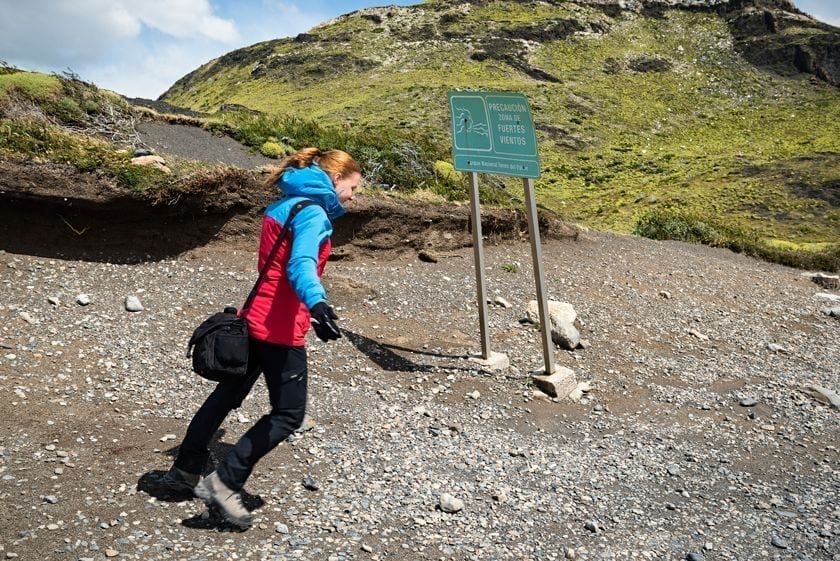
Proper hiking shoes
Although some of the hikes are more like walks, it’s better to always wear proper hiking boots .
The weather, as I already mentioned, is unpredictable – it can be sunny in one minute and snow-raining the next (it’s always bloody windy, though).
It means that the trails can get slippery very fast – you definitely don’t want to end up with a sprained ankle (or worse) because you wore improper shoes.
If possible, try to go to a store and really try the shoes out before buying them. Good shops will have a place where you can try the shoes out on different terrains and angles, to make sure that they fit perfectly. Alternatively, you can check them on Amazon .
The weather in Patagonia changes like crazy, so it’s good to be prepared for rain even if it’s not forecasted. It’s not unusual to have all four seasons in one day – even when visiting Patagonia in summer.
Of course, having waterproof clothes and bags is great, but the rain cover just gives you that extra sense of staying dry.
Proper backpack
A day back (or bigger, if you’re doing a multi-day hike) that is a proper size (we usually do with a 25-30l backpack for each of us for a day hike).
Check the straps on the backpack so that they don’t cut into your shoulders. It’s good to have the chance to fasten the straps on the chest and waist as well, as it helps distribute the weight.
A place for hiking poles with straps to hold it in place is convenient to have.
I like having an outside pocket for a water bottle as well, as it’s more comfortable than reaching in the backpack. Some people enjoy having the straw that reaches from the backpack to your front.
First aid kit
There are specific hiking first aid kits that you can buy, but it’s not that hard to put together your own little one.
The basic items to have in your first aid kit are:
- Take some band-aids or medical tape for those blisters that always sneak up at the worst possible time.
- Gloves to protect possible cuts from contamination.
- Sanitizer for hands.
- Antiseptic cream and wipes .
- Medicine: for pain, for stomach troubles, anti-allergy
- Scissors or even better – a swiss army knife thing (remember, though, that it’s not allowed to bring these onboard an airplane)
- A fire starter .
I would like to believe that it goes without saying, but there have been too many times that I’ve seen and heard about people not taking enough water with them.
It’s better to take more than you think you’d need, not “just enough”.
Another good idea is to have some water purification system with you – take the special purification tablets or even a bottle with a filter like this one – the filter makes almost any water into a drinking one.
It’s especially useful if you go on some of the best multi-day treks in Patagonia.
Snack bars, chocolate, etc. Or even a whole picnic.
It’s amazing to just enjoy your sandwich with the incredible views. Somehow, it makes the simple bread and cheese taste heavenly!
How to choose the best hike in Patagonia
If you don’t want to spend your whole time in Patagonia hiking, you can choose just a couple of hikes to do.
But how to choose those hikes that you’ll like and enjoy the best?
Ask yourself a few questions.
Are you in good shape?
Just be honest with yourself.
Some of the hikes, as you could see, are difficult. If you have trouble walking upstairs to, let’s say, the 10 th floor, don’t go on the W-trek in Torres del Paine.
Or make sure to get in shape! The views are definitely worth it!
Short walks, single day, or multi-day hikes?
There is an enormous amount of hiking trails in Patagonia. They range from 30 minutes long to even more than a week long.
What fits into your itinerary?
Are you ok with sleeping in a tent or just a simple refugio or do you prefer your own hotel room?
Are you ok with having simpler meals or would you prefer to eat at a proper restaurant each evening?
These questions might help you choose the length of the trail.
Why choose a day or shorter hikes?
You can check the weather forecast the day before and base what to do on it.
Do a shorter hike and then do some other activity – horseriding, kayaking, etc.
Do an easy hike one day and a more challenging one the next. It’s all about flexibility.
Why choose a multi day trek?
See the best of Patagonia in one longer hike instead of losing time going back to the base.
You can enjoy the sceneries slower because – again – you save time by not going back.
Explore more remote areas which are much less crowded.
Would you like to see the highlights or explore some lesser-known trails?
Yes, the most popular trails get very crowded.
If you hate crowds, consider some lesser visited places, for example, Tierra del Fuego in the southernmost part of Patagonia or maybe the comparably new Patagonia National park in Chile which encompasses the Northern Patagonian Ice Field.
The multi-day treks will probably still be rather full of people, but it should filter out the amateurs, so to say.
What landscapes would you like to see?
Steppe? Ragged peaks? Glaciers?
There is so much to choose from!
Summary of hiking in Patagonia
Hiking Patagonia is every hiker’s dream, that’s for sure. Some of the best hikes in the world are found here.
These 14 treks that I’ve described here are definitely not all of them. If I wanted to list all the best hikes in Patagonia, this article would never end!
But this definitely gives you a little insight into what Patagonia has to offer in terms of scenery and hiking.
Which one is your favourite one? And which one would you never do?
Save on Pinterest!
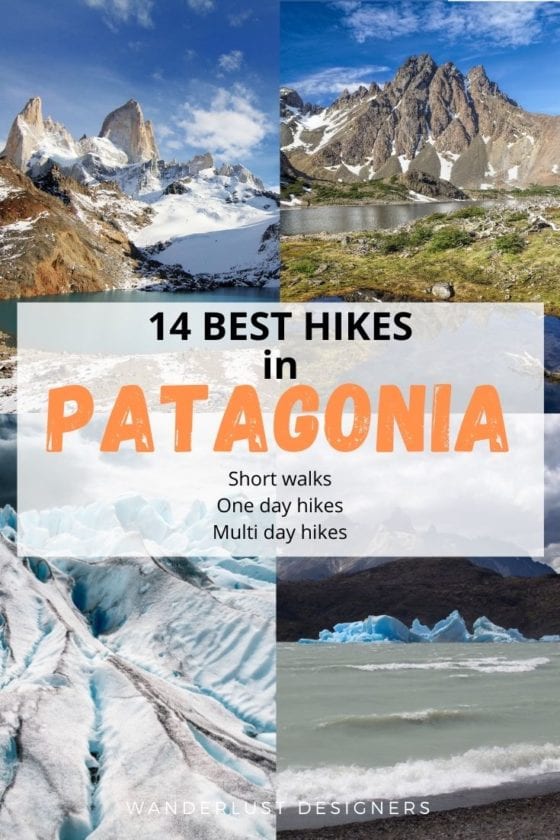
Guest Author
Kristine Eksteine-Nizka is a guest author of Wanderlust Designers. She has lived in 4 countries and has visited over 200 places in 30 countries, all while holding a full-time job or studying, and is determined to inspire and teach others to do the same.
Similar Posts

13 most interesting birds and animals in Torres del Paine and Patagonia
Torres del Paine National park in the Chilean Patagonia is one of the most incredible destinations in the world. It offers some of the best hiking trails in the world, full of glaciers, turquoise waters, and towering mountains. But what some people might not realize is that there are some very interesting and even endangered…

Los Glaciares National Park: your ultimate guide in 2024
The name of the Los Glaciares National Park in Argentinian Patagonia literally means “the glaciers”. I guess that gives you quite an idea of what you can find in the park! But it’s not only glaciers there, though. There are countless hiking opportunities; incredible lakes, including lago Argentino – the biggest lake in Argentina; Patagonian…

Visiting Perito Moreno Glacier: absolute guide
Visiting Perito Moreno glacier is one of the main and most popular attractions in Los Glaciares national park Although there are many glaciers in Los Glaciares (47 major glaciers and about 190 smaller glaciers actually), Perito Moreno is definitely the most famous one there. And it’s quite special as well – I talk about it…
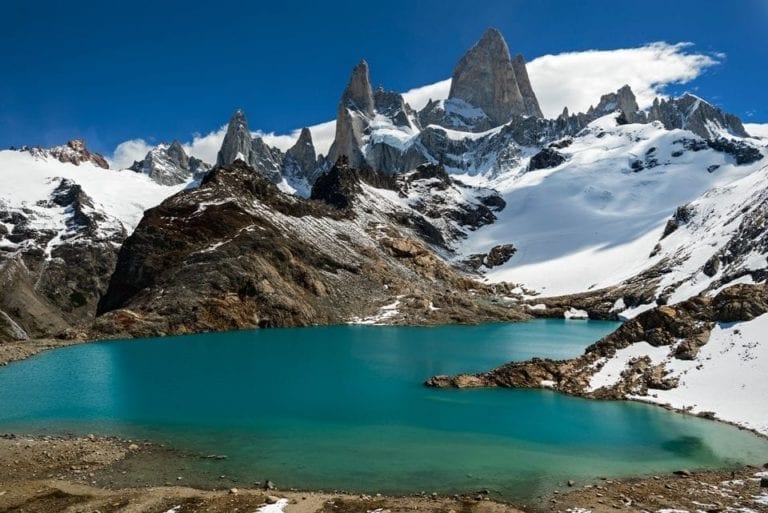
7 best hikes in El Chalten: short walks and day hikes
Hiking in El Chalten, Argentina, is like a dream come true for any hiking enthusiast out there. Or even nature enthusiasts, to be fair. Patagonia itself is a hiker’s paradise, and El Chalten is its capital. And you don’t even have to be in perfect shape to hike in this corner of Patagonia! Some of…
![What to pack for Patagonia and what not to pack [2024] kiss at laguna jpeg What to pack for Patagonia and what not to pack [2024]](https://www.wanderlustdesigners.com/wp-content/uploads/2019/03/kiss-at-laguna-jpeg-768x513.jpg)
What to pack for Patagonia and what not to pack [2024]
What to pack for Patagonia? Well, it’s quite easy to answer – winter stuff! Even if you’re travelling to Patagonia during summer, that is, December or January, you still need winter stuff. Patagonia is located in the very south of South America where the Atlantic and Pacific winds meet, so it’s one of the windiest…
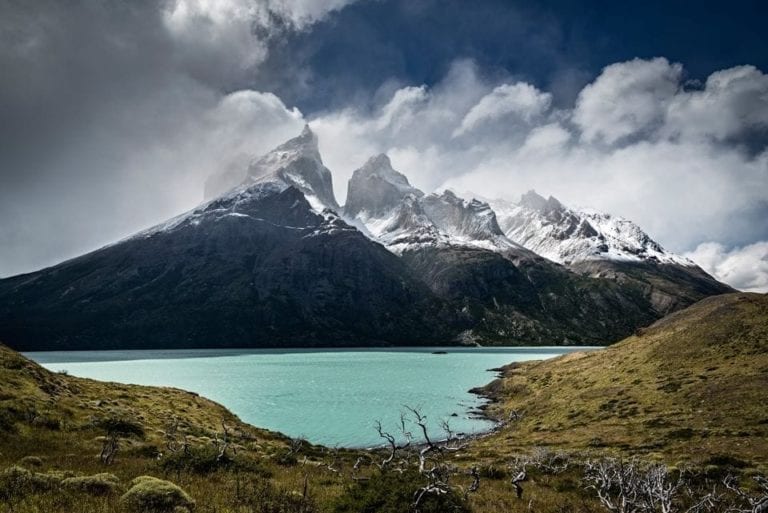
Ultimate Patagonia 10 day itinerary that will knock your socks off
Jagged mountains, howling wind and the raw beauty of nature – that is Patagonia. This amazing part of the South American continent is one of the most scarcely populated, one of the windiest, and easily one of the most beautiful regions in the world. Our Patagonia 10 day itinerary takes you through the most exciting…
Oh wow, what an informative post. It is such a dream of mine to visit Patagonia as the landscapes look incredible and the hikes sound wonderful! I really hope I get to visit and complete at least some of these hikes 😊 it all looks wonderful for photography, especially the Dientes 😍
Thank you so much, Sarah! And I definitely hope that you get to visit Patagonia – I already can’t wait to see your pictures! They are amazing!
Wow, your photos are spectacular. We traveled Chilean Patagonia a few years ago and were blown away by the scenery and it seems we need to visit Argentinian Patagonia too. I am glad that you have some shorter hikes in your list as we don’t like to do 10h hikes in the middle of nowhere.
Thanks, Rudy! You definitely should visit Argentinian Patagonia, you’re right! And yes, I was baffled that there were almost no short hikes in Patagonia mentioned in any articles that I read. Not everyone can do the long ones!
Leave a Reply Cancel reply
Your email address will not be published. Required fields are marked *
Save my name, email, and website in this browser for the next time I comment.
This site uses Akismet to reduce spam. Learn how your comment data is processed .
12 unmissable hikes in Patagonia: wonder at the pristine wilderness

Nov 16, 2021 • 9 min read

From short walks to multi-day treks, there are many inspiring hikes to choose from in Patagonia © Olga Danylenko / Shutterstock
The name “Patagonia” typically conjures up visions of endless pampas (grasslands) and southern cowboys, but there is so much more to the region than that. Covering a massive chunk of southern Chile and Argentina , this unique 402,734 sq mile region is a patchwork of diverse terrains and microclimates that challenges and surprises hikers of all abilities.
Criss-crossed by glacial rivers and streams, alternately covered in scrubland and ancient woodland, and dotted with myriad ice-melt lakes ranging from pale blue to navy, Patagonia bristles with mountain ranges (particularly on the Chilean side) and glitters with glaciers. Whether you’re looking to rough it on multi-day treks through pristine wilderness, hike from hut to hut in epic national parks , exert yourself on varied day treks before returning to the comfort of your boutique guesthouse, or just stretch your legs beneath the shade of Chile’s and Argentina’s oldest trees while road-tripping along Chile’s Carretera Austral , Patagonia has a great deal to offer.
Trekking in Patagonia and Tierra Del Fuego (included in this list of hikes) is largely confined to the peak and shoulder seasons of November to late March. If hiking off the beaten track, make sure someone knows your proposed route, take a tent sturdy enough to withstand the famous Patagonian wind – La Escoba de Dios (God’s Broom) – and all the supplies you’ll need . During any hike, all-weather gear is a must (since you may experience four seasons in one day!). Accommodations must be booked many weeks in advance for the December to February high season.
Here are 12 of the region's very best hikes.

The "W", Torres del Paine National Park (Chile)
Best overnight hike
46 miles (74km) one way, 3–5 days, moderate
The shorter of the two multi-day treks that Chile’s iconic Torres del Paine National Park is known for, this trail is shaped like the letter "W" (hence the name). You take a boat across Lake Pehoé, hike through woodland along the banks of Lake Grey to the icy monolith of Glacier Grey before retracing your steps. You then pass along the shores of glacial Lake Nordenskjold, and climb steeply up the French Valley for an up-close look at Los Cuernos – the park’s bell-shaped mountain range. A final stint through scrubland, across hills and up the Ascencio river valley brings you to the trident peaks of Las Torres. You can either camp en route at designated campsites, go from refugio (bunk hut) to refugio , or even glamp along the way. Due to Torres del Paine’s immense popularity, all accommodations and camping spots have to be pre-booked months in advance. The "W" is best hiked west to east if you’re camping, so that you’ll have used up most supplies before tackling the steep ascent to the granite towers.
Laguna de Los Tres, Parque Nacional Los Glaciares (Argentina)
Most scenic and most challenging
15.5 miles (25km) round trip, 8–10 hours, moderate
Only accessible on less windy days, this is the most scenic and challenging of all the day hikes around southern Argentina’s compact trekking capital of El Chaltén . The well-marked trail ascends through ñire (small southern beech) woodlands from the north end of El Chaltén’s main street, past the turquoise Laguna Capri, and across boggy terrain to Camapamento Poincenot, popular with climbers. A steep, exposed trail zigzags up the mountain side to the glacial lagoon, where you get excellent bonus views of Cerro Fitz Roy (11171ft/3405m) – the mountain resembling a jagged tooth. Dip your feet in the water and see how quickly they lose all feeling!
Lagunas Altas Trail, Parque Nacional Patagonia (Chile)
Easiest to access
14.2 miles (23km) loop, 8 hours, moderate
The most easily accessible trail in Parque Nacional Patagonia , due to its location near the entrance to the park this invigorating leg-stretcher is stupendously scenic. Climbing a forested ridge from the Westwind Campsite near the visitors center, the trail passes several tiny glacial meltwater lakes as you cross open terrain. You’ll find that your jaw drops open more than once during the hike at the all-encompassing views of the northern Patagonian ice field, Chacabuco Valley and the Jeinimeni Mountains en route.

The "Circuit", Torres del Paine National Park (Chile)
Best long-distance trek
68 miles (110km) loop, 6–10 days, moderate
If you have more time to spare, hike the loop-shaped Circuit, the longest trek in Torres del Paine, trekked in a clockwise direction. Incorporating the "W", this spectacular loop gives you unique views of the backs of Los Cuernos and Las Torres – the park’s two mountain ranges – from remote back country. The terrain is never boring, as you climb partially-forested hills en route from the Serón campsite to the Dickson campsite and refugio , enjoying views of Lake Paine and Lake Dickson along the way, and taking boardwalks across boggy sections. This first half of the hike is where you’re most likely to come face to face with one of the park’s many mountain lions.
From Refugio Dickson, you enter dense southern forest with its thickets of giant wild rhubarb and ferns, with glimpses of waterfalls through the trees. The highest and most challenging part of the trek is the weather-dependent crossing of the John Gardner Pass (4002ft/1220m) between the Los Perros Campsite and Refugio Grey. Once you reach the top, the Glacier Grey icefield opens up below you like a vast, frozen river. As with the "W", you can either camp all the way, or go from refugio to refugio .
Los Alerces Trail, Parque Nacional Pumalín Douglas R. Tompkins (Chile)
Best easy hike
0.5 mile (700m) loop, 30 minutes, easy
Alerce trees are the giants of Patagonia. Growing up to 148ft (45m) in height and living for up to 3000 years, and used for making southern Chile’s unique shingled roof tiles, they were cut down almost to extinction by colonists in the late 19th and early 20th centuries and now have protected status. Off the Carretera Austral, some 7.7 miles (12.5km) south of the Caleta Gonzalo car ferry landing, this wonderful interpretive trail passes through a particularly impressive grove of these millennia-old skyscrapers of the forest.

Laguna Torre, Parque Nacional Los Glaciares (Argentina)
Best hike with icebergs and glaciers
13.6 miles (22km) roundtrip, 6–8 hours, moderate
Another excellent day hike from El Chaltén, this trail takes you from the south of town through the Fitz Roy river valley. Passing a small hydroelectric station, you climb through lenga and ñire woods to reach the Mirador Laguna Torre, with views of glaciers beneath the Adela mountain range, Cerro Torre, Mt Fitz Roy and the granite "needles" popular with rock climbers. Crossing an alluvial plain bisected by the glacial Fitz Roy river, you pass the partially sheltered De Agostini campsite before skirting the iceberg-filled Laguna Torre to reach Mirador Maestri, overlooking the Grande glacier.
Laguna de Los Témpanos, Parque Nacional Queulat (Chile)
Best hike in Parque Nacional Queulat
1.2 miles (2km) return, 1 hour, easy
If you do just one hike in Parque Nacional Queulat , off Chile’s Carretera Austral in northern Patagonia, make it this one. From the main car park, after crossing the hanging bridge high above the raging Ventisquero river, you may have to brave the perpetual rain. Expect to beslapped in the face with moisture-laden ferns as you make your way through dense forest and damp undergrowth along this straightforward trail to a splendid glacial lagoon – but it’s well worth it. From the banks of the lagoon, you get uninterrupted views of the Ventisquero Colgante – a hanging glacier across the lagoon, filled with car-sized chunks of calved ice. The frequently inclement weather, and the park’s remoteness, means you’re likely to have it all to yourself.
Volcan Chaitén Crater Trail, Parque Nacional Pumalín Douglas R. Tompkins (Chile)
Best all-encompassing view
2.7 miles (4.4km) round trip, 3 hours, moderate
In 2008, the eponymous volcano in northern Patagonia staged a surprise eruption and buried half the town of Chaitén under mud and ash. This relatively steep five-hour round-trip trek starts near Puente Los Gigos, off the Carretera Austral, north of the now-rebuilt town. Following the eruption path of the volcano, the trail gets progressively more barren the higher you get. Your reward at the top is the all-encompassing view of the still-smoking crater and the surrounding forest.
Dientes de Navarino Circuit, Navarino Island (Chile)
Best demanding trek
33.2 mile (53.5km) loop, 4–5 days, difficult
On Chile’s southernmost permanently inhabited territory (across the Beagle Channel from Tierra del Fuego), this demanding trail loops around the jagged pinnacles of the Dientes de Navarino mountain range. Requiring camping wild and excellent navigation skills, it’s best done in a clockwise direction with at least one other companion. The trail cuts across bare stony plateaux, skirts glacial lakes, traverses boggy lowlands, and crosses exposed mountain passes, with highlights including expansive views of the Beagle Channel from Cerro Bandera and Paso Virginia (near the beginning and end of the trek, respectively). Watch your footing on the steep, rapid descent from the latter pass.
Lago del Desierto – Chile trail (Argentina/Chile)
Best hike that crosses an international border
12.4 miles (20km) one way, 6–8 hours, moderate
In recent years, this cross-border trail connecting tiny El Chaltén in southern Argentina to Chile’s equally tiny Villa O’Higgins has gained in popularity with adventurous hikers (and cyclists). Best done from Argentina to Chile (as that avoids a relentless uphill slog), it involves taking a boat across the pristine Lago del Desierto, some 23 miles (37km) north of El Chaltén, getting stamped out at the Argentine border post, then trekking through hilly, dense woodland until you reach the sign welcoming you to Chile, where the narrow trail becomes a broad, forest-fringed gravel road. It then winds its way down to Lago O’Higgins, to the tiny border post of Candelario Mancilla. From here, you have to catch another ferry across Lake O’Higgins/San Martin. During high season, when ferries across both lakes are more frequent, you can time the hike so that it’s doable in a day; otherwise you may have to camp at one or both border posts.
Avilés Trail, Parque Nacional Patagonia (Chile)
Best hike for camping wild
29 miles (47km) one way, 3–4 days, difficult
Connecting the eponymous forest lake in the Reserva Nacional Lago Jeinimeni (accessed from Chile Chico) with the Casa Piedra campsite in the scenic Avilés Valley in Parque Nacional Patagonia further south, this is a serious off-the-beaten-track endeavor that requires organizing transfers to and from the trailheads in advance and ample wilderness trekking experience. While the terrain is only moderately demanding, the trail through the valley is rudimentary and minimally marked, there are multiple river crossings and you have to camp wild, bringing all your supplies with you.
Cabo Froward (Chile)
Most remote
45.3 miles (73km) round trip, 4 days, difficult
The goal of this adventurous hike is to reach Cape Froward – the southernmost mainland point on the continent of South America. Starting at the trailhead some 56 miles (90km) south of Punta Arenas , the trail mostly hugs the coast, meandering along wind-battered cliffs, traversing boggy undergrowth, and passing the San Isidro lighthouse. Unless you’re an experienced wayfarer, it’s best to join a guided hike with Erratic Rock from Puerto Natales , as the trek involves fording narrow, deep rivers at low tide and camping wild. The trail isn’t well-marked in places.
You might also like: Chile's best hikes and treks through extraordinary landscapes The best hikes in Argentina: from ice fields to rainforest trails I went on a solo trip to Patagonia (and I loved it)
This article was first published Apr 1, 2014 and updated Nov 16, 2021.
Explore related stories

Jun 24, 2024 • 10 min read
Split between Chile and Argentina, Patagonia and neighbouring Tierra del Fuego boast more than a dozen national parks.

Jun 10, 2024 • 9 min read

Feb 8, 2023 • 4 min read

Feb 7, 2023 • 5 min read
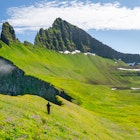
Dec 6, 2022 • 10 min read

Nov 28, 2022 • 6 min read

Oct 5, 2022 • 6 min read

Jul 29, 2022 • 14 min read

Dec 3, 2021 • 10 min read

Oct 28, 2021 • 6 min read

The 15 Best Hikes in Patagonia You Can Do Without a Guide
By Author Steph Dyson
Posted on Last updated: 17th January 2024
Home to the final, southernmost stretch of the Andes Mountains as they plunge into the Pacific Ocean, Patagonia is a remarkable place for hiking, particularly if you like wild terrain and scenery.
Some of South America’s most superlatively beautiful hiking trails crisscross this land of wind-pummelled grasslands, clusters of evergreen forests blasted by the elements, and sky-piercing mountains, many weighed down with glaciers of the deepest hues of blue.
If the promise of this scenery isn’t enough to get you packing your rucksack and out onto the trail, then I don’t know what will. But trust me: Patagonia is a paradise for hikers, with day and multi-day treks that will leave you wishing you could extend your trip indefinitely.
I’ve spent months exploring the wildernesses of Chilean and Argentine Patagonia and this list comes from mostly personal experience (although I’ll admit I’ve snuck a couple in that I haven’t had the chance to do – yet).
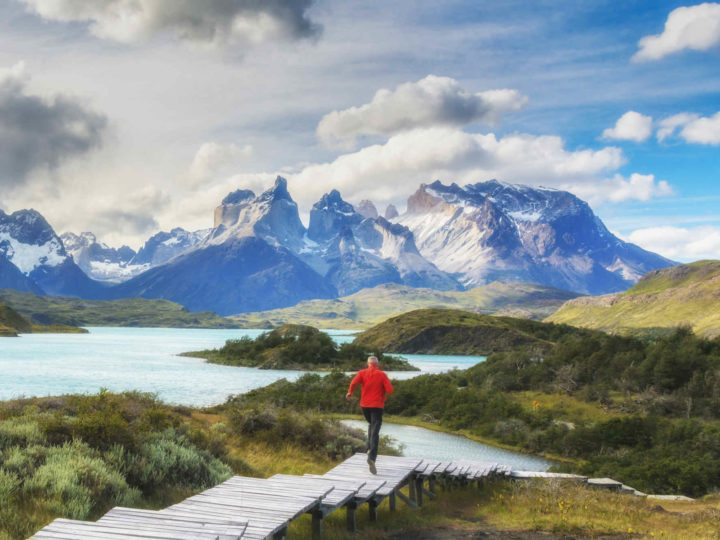
Join me on a jaunt around the region, with these fifteen of the best hikes in Patagonia.
Click to navigate this article:
A note about equipment for hiking in Patagonia
Patagonia is a rugged, remote, and untamed part of the world. Because of this, decent quality hiking gear, including hiking boots that you have worn on at least a few trails beforehand, is essential.
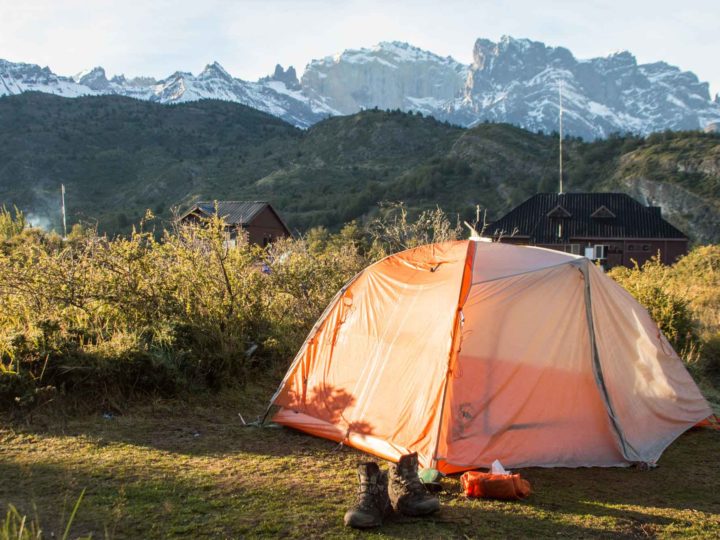
A day or larger pack , weather-appropriate clothing, and, if you’re staying overnight, a high-quality, lightweight tent and three-season sleeping bag will keep you safe and happy on these hikes.
Camping in Patagonia is all part of the adventure and I definitely recommend that you build it into your trip; camping out in a remote place, far from civilization in the very far south of the planet is quite the experience.
While you can hike these Patagonian trails without a guide, I have listed companies that do offer guide services, and who will likely provide camping and cooking equipment (or meals) where required.
A lot of these hikes have fresh water along the trail, however, I recommend bringing water purification tablets or some backpack-friendly water filtration system (such as a Sawyer filter, Grayl Geopress, or Steripen – read our review of the latter ).
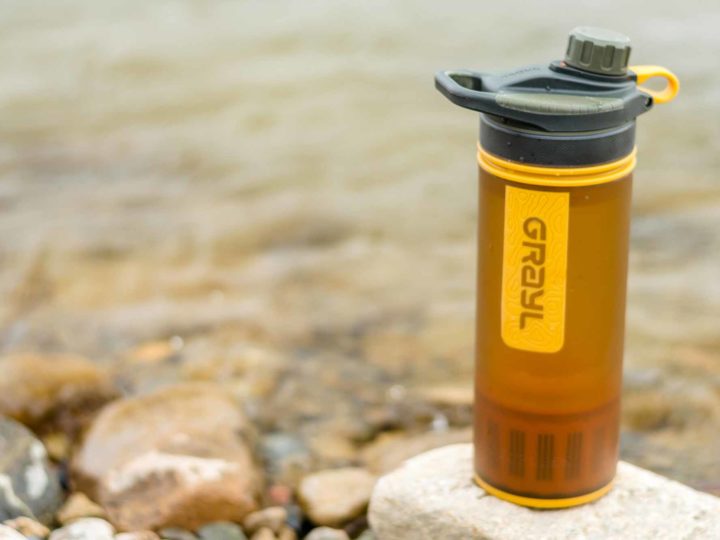
Some hikes require camping and cooking equipment, as well as carrying several days’ worth of rations.
If this is your first time packing for a hiking vacation, be sure to read our guide to what to pack for Patagonia .
I’m a huge advocate of packing light, and this list covers everything from hiking clothing and boots to camping equipment, and other day-to-day gear that will make your life on the trail markedly easier and more comfortable.
You can also find detailed descriptions of all these hikes in Patagonia in Moon Chile , a guidebook I spent two years working on.
For detailed descriptions of the longer treks, check out the Lonely Planet Trekking in the Patagonian Andes book (although don’t both if you’re in the UK – it’s insanely expensive there for some reason but you can find cheap used copies to buy on other websites!).
Planning Your Trip to Patagonia?
Save time, stress & money with a customized travel itinerary planned for you by a Patagonia expert
What previous clients have said:
“Steph’s itinerary exceeded all expectations. She provided off-the-beaten-path hikes, great restaurants and accommodations, and very helpful local contacts. Due to the weather we had to deviate from our original plan, however Steph quickly responded to our email during the trip with further recommendations. Her service took all the guesswork out of planning our vacation and led to the most fun and unforgettable trip we have ever had!”
When is the best time to hike in Patagonia?
The main season for visiting Patagonia is October through April. This is because of the weather, which can see snow and other inclement weather during the rest of the year. It’s also not advised to visit outside of these months because many hotels, tour operators, and national parks close.
The best time to hike in Patagonia is any time between October and April, although December through February is the high season for travel, so you’ll find trails busy and prices high.
The months of December, January, and February in Patagonia have the warmest temperatures, which hover around 15˚C (59˚F) and the days are long, with daylight lasting up to 17 hours. However, wind levels are high and can reach up to 190 kilometers per hour (120 miles p/h).
I always recommend visiting Patagonia in the fall months of March and April , when the landscapes turn a beautiful orange and red and temperatures hover around a mild 10˚C (50˚F) during the day – although they do drop below freezing at night. It’s a lot less windy than in summer, and there are also fewer visitors to Patagonia.
Another alternative is spring and the months of October and November. Patagonia during these months sees daytime temperatures of around 10˚C (50˚F) and winds are less fierce than in the summer, although they can be biting and, combined with overcast days, can lead to cold hiking conditions.
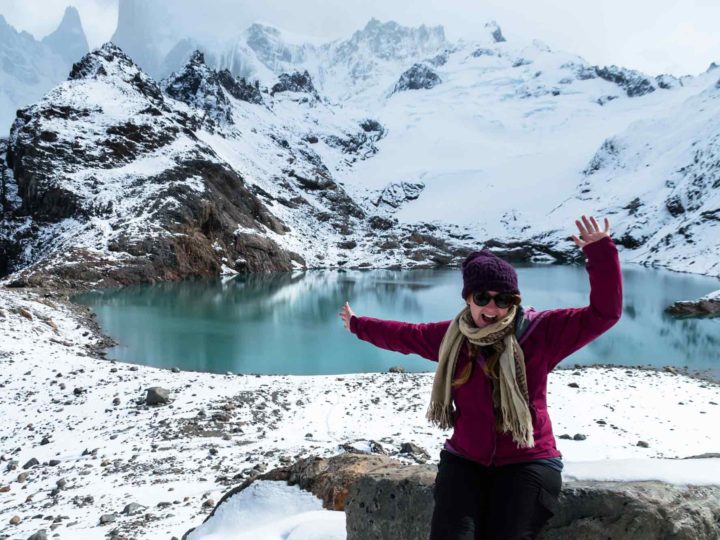
During winter, the region practically shuts down and heavy rain and snowfall close trails and even roads. Some destinations such as Torres del Paine are supposed to be spectacular, but you will need to go with a guide as entry is prohibited unless with a tour.
I re-visited Torres del Paine National Park in September and found that while the weather is cold – dropping well below freezing at night – it’s actually more settled than during summer, with lower wind speeds and, more often than not, bluebird skies.
Be aware that whenever you visit Patagonia, the chance of experiencing four seasons in a day – sun, rain, hail, and snow – is high and you’ll want to come prepared for every eventuality.
Best hikes in northern Chilean Patagonia (the Carretera Austral)
1. volcán chaitén, pumalín national park.
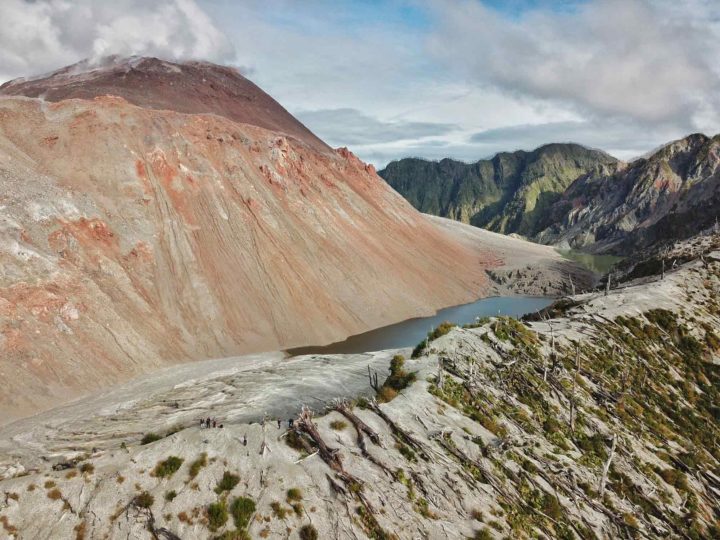
- Duration: 4.5 kilometers (2.7 miles); 3 hours.
- Best time to go: Conditions for hiking are best between October and April, although the park is at its busiest between mid-December and February
- Difficulty: Medium
- Highest point reached: Unknown. Elevation gain of 625 meters (2,050 feet)
- Starting point: The trailhead lies 24 kilometers (15 miles) north of Chaitén
- Ending point: Same as starting point
- Must-have gear: The trail is steep and the path strewn with rocky boulders, including smaller lumps of glassy obsidian and pumice stones that were hurled out of the volcano when it erupted, so hiking poles are recommended. Bring plenty of water as there is none available on the trail.
- Do I need a guide? No. The trailhead is well-marked and the path is clear to follow. Your biggest issue is getting there from Chaitén as there is no public transport. Hitchhiking or joining a very affordable tour operated by Chaitur Excursiones is the easiest means of reaching the park
- Cost: Free
- Useful information: The national park has a comprehensive website , complete with trekking information for the Volcán Chaitén hike .
- Map: OpenStreetMap
Volcano climbing is an activity that you can’t miss if you spend time in Chilean Patagonia. While Volcán Villarrica further north is perhaps the country’s most famous, Volcán Chaitén on the northern tip of Patagonia is equally impressive and the path up to the crater of this volcano easily ranks as one of the best day hikes in Patagonia, if not South America.
What’s more, the trail itself is short and sweet – if a steep climb. But, as you emerge out of the top of a grove of charred tree trunks (the debris left after the volcano erupted, when lahars of mud and ash blanketed the surroundings), the 45-minute ascent is more than worth it.
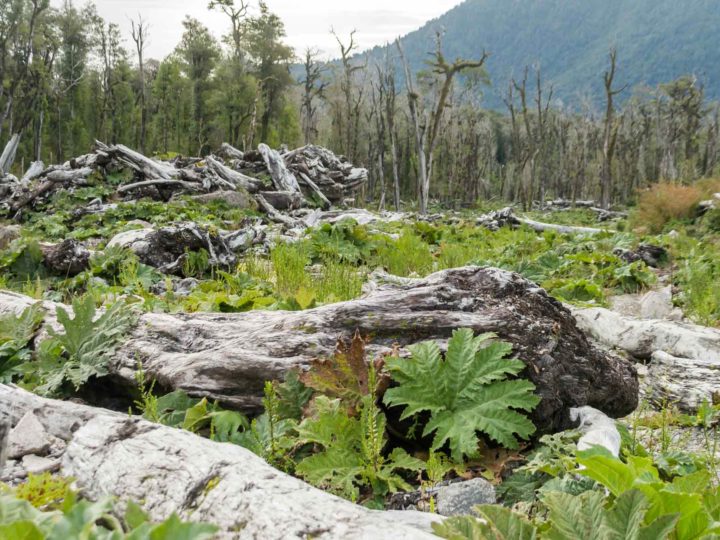
From the very top of the trail, you can appreciate the vastness of the volcano, and find yourself standing on the lip of its 3.5-kilometer (2-mile) crater.
As you do, keep an eye on the volcano itself. It’s still active, although currently offering nothing more dangerous than a tower of smoke puffing lazily from the top.
Other hikes in Pumalín National Park: the easy Sendero Alerces (0.7 km, 40 mins) is a beautiful short walk through protected alerce trees, while the medium Sendero Cascadas (5.6 km, 3 hrs) and Sendero Cascadas Escondidas (1.8 km, 2 hrs) reach some of the park’s most beautiful waterfalls. The hard Sendero Tronador (5 km, 4 hrs) and Sendero Volcán Michinmahuida (24 km, 8-10 hrs), the latter of which includes views of the snow-covered Michinmahuida Volcano, are also worth exploring.
2. Piedra del Aguila, Futaleufú
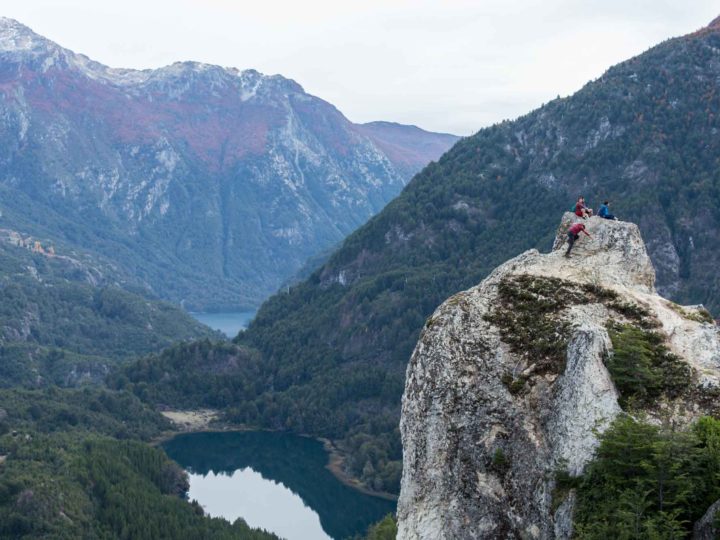
- Duration: 12 kilometers (7.5 miles); 2.5 hours
- Best time to go: Futaleufú is at its prettiest in the spring (October through mid-December) for wildflowers or fall (March-April) for the autumnal colors. Note that if you want to combine hiking with rating, the best season for the latter is November through March
- Difficulty: Easy; the ascent is gentle and on a gravel road
- Highest point reached: Unknown; the elevation gain is 420 meters (1,380 feet)
- Starting point: The center of Futaleufú
- Must-have gear: Take water or a water filter for filling up from the river and extra layers for the top of the rock where it can be cooler and windy
- Do I need a guide? No
- Cost: Access is through private land, so if you see the owner, you’ll need to pay $1,000 CLP ($1.2 USD)
- Useful information: N/A
Futaleufú might be better known as one of South America’s prime white-water rafting spots, but with the town in a picturesque river basin lined by forested mountains, there’s plenty to keep you busy on your own two feet.
Lying a few kilometers out of town, the Sendero Piedra del Aguila is an easy tramp up a gravel road to reach Eagle’s Rock, a jutting, 40-meter high lump of granite that grants sweeping views east across the valley towards two picturesque Alpine lakes.
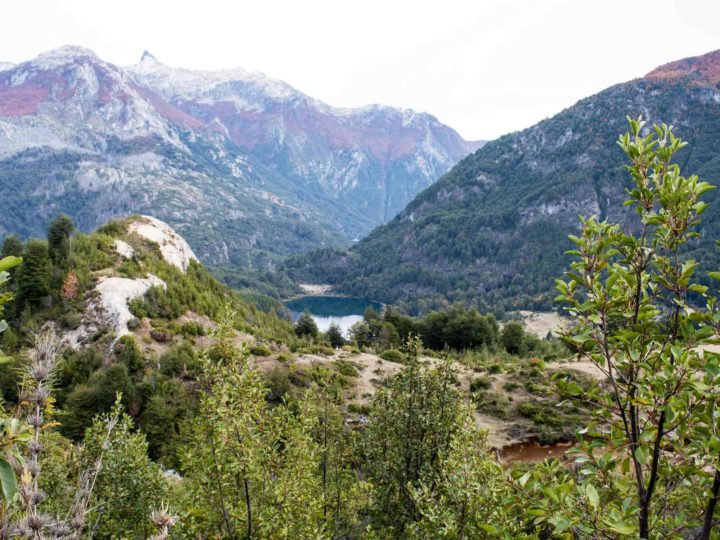
It’s not the wildest of Patagonian scenery, but it’s an easy introduction to hiking in the region.
3. Sendero Mirador del Ventisquero (Glacier Viewpoint Trail), Queulat National Park
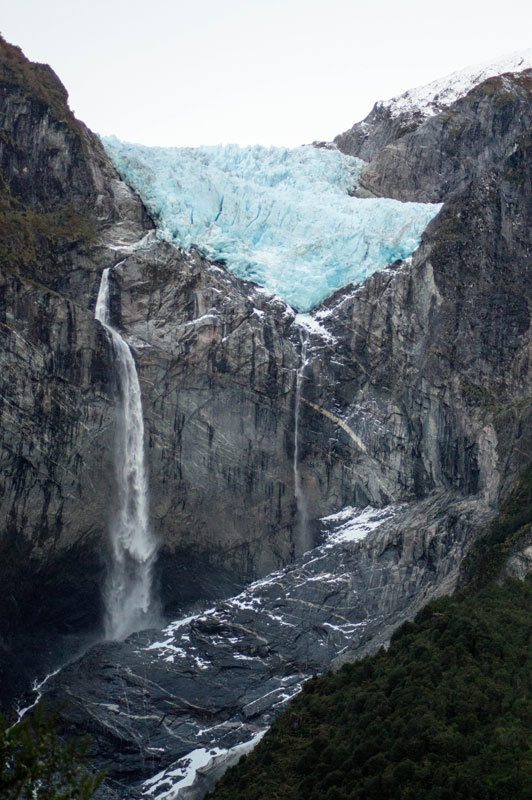
- Duration: 6.5 kilometers (4 miles); 2.5 hours
- Best time to go: This part of the Carretera Austral is best visited between October and April; outside of these months, snowfall can make the roads challenging and can close hiking trails
- Difficulty: Medium; the trail climbs continually to reach the viewpoint
- Highest point reached: Unknown; elevation gain of 305 meters (1,000 feet)
- Starting point: The ranger station at the entrance to Queulat National Park. To reach here, you can either hitchhike from Puyuhuapi or organize bikes through Turismo Experiencia Austral (who used to also operate minibusses but it’s not clear if that’s still an option)
- Ending point: Same as the starting point
- Must-have gear: A good quality Gore-Tex jacket as this part of the Carretera Austral is known for its heavy rainfall. The path can also be very slippery, so hiking boots with decent tread are essential
- Do I need a guide? No. The trail is well-marked
- Cost: $8,500 CLP ($10 USD) entry into the park
- Useful information: The national park has some basic information here
Wedged onto the cliff face high above a milk-blue lagoon, this glacier is one of the most magnificent in all of Patagonia, thanks to its magnificent colors and gush of meltwater that keeps the scene in motion.
One of the most iconic sights along the Carretera Austral is the egg-blue ice of the Ventisquero Colgante, the Queulat Hanging Glacier.
The light is better in the late afternoon, but, if you’re camping in the national park, you can take the short – if steep – trail, climbing through Valdivian temperate rainforest dripping with moss – at any time of the day.
Covid-19 update: You MUST make a reservation in order to visit the park. You can do this on this website , but you will need to pay in cash (bring small notes) upon arrival. You can only enter the park between 9:00am and 14:30pm (you can stay within the park until 16.30pm) and you must bring your reservation code on your phone or printed off to show at the park entrance.
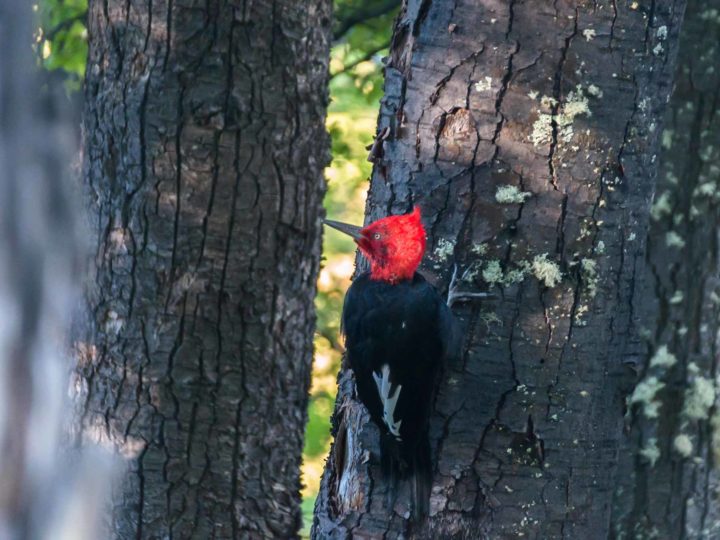
Watching the dazzling blue ice crumbling in noisy avalanches from the glacier’s snout is a sight you’ll want to absorb for as long as possible.
Other hikes in Queulat National Park: The easy Sendero El Aluvión (1 km, 30 mins) and Sendero Laguna Témpanos (1.2 km, 30 mins, easy) are also worth exploring (get information here ).
4. Cerro Castillo Traverse, Cerro Castillo National Park
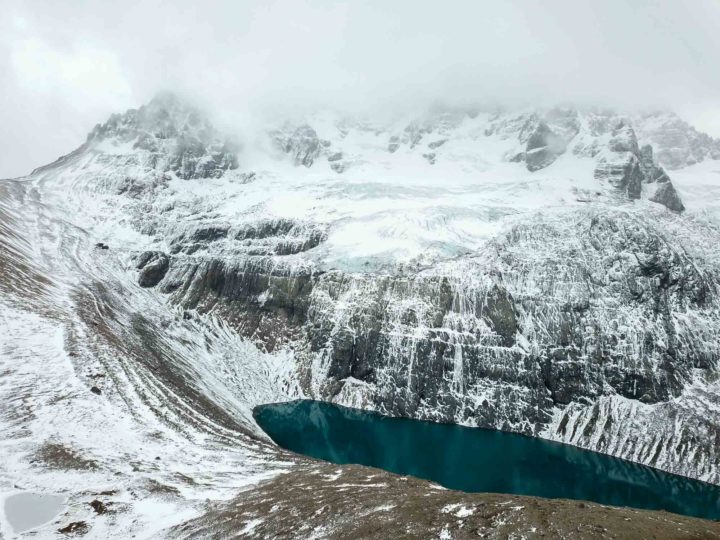
- Duration: 51 kilometers (32 miles); five days
- Best time to go: The best time to hike in the park is January through March when wind speeds drop and the weather is mostly stable; the other recommended months are between November and December and April, although snowfall is possible during these periods
- Difficulty: Medium/hard
- Highest point reached: 1,300 meters (4,265 feet) at Paso El Peñón (El Peñón Pass)
- Starting point: The Las Horquetas entrance to the park, 30 kilometers (19 miles) north of Villa Cerro Castillo along the Carretera Austral
- Ending point: TheEstero Parada entrance to the park, 7 kilometers (4.3 miles) west of Villa Cerro Castillo
- Must-have gear: A sturdy tent that can withstand high winds and a waterproof jacket and pants that can do the same. Winds at the Paso El Peñón can be fierce
- Do I need a guide? No, but you do need some experience in backcountry hiking and being able to follow a trail, while accidents have occurred in the park when hikers were unprepared for the weather conditions. You must register with the park rangers when you pay your entry fee, as well as on your way out of the trail.
- Cost: $29,000 CLP ($35 USD) park entry; local company Senderos Patagonia run 5D/4N tours of the trail, including food and English-speaking guides starting from $1,350 USD
- Useful information: The national park has an excellent website that provides plenty of detail about the trail and how to prepare for it
- Map: OpenStreetMap and the national park website
Torres del Paine National Park in southern Chilean Patagonia might have captured most visitors’ imaginations, but if you’re looking for a trail that promises outstanding mountain scenery and just a small fraction of the visitor numbers, there’s a new national park in town: Cerro Castillo.
Its cornerstone trail is the Cerro Castillo Traverse (or Travesía Las Horquetas), a challenging trek through exposed mountain passes where the rewards are delivered in the form of panoramic views of glacier-studded peaks.
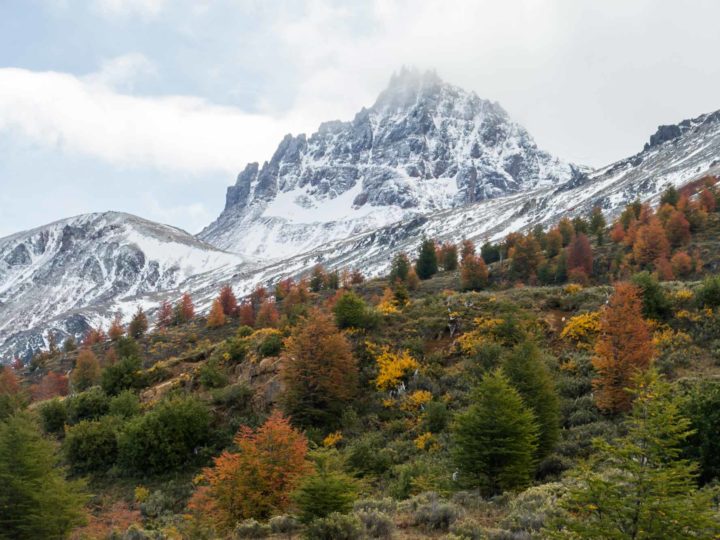
The most famous is the park’s namesake, Cerro Castillo, christened as such for its castle-like shape – and which looks, if only teeny bit, like the three granite prongs of Torres del Paine, situated, as it is, above a magnificent cobalt blue lagoon.
This hike combines pristine backcountry scenery of glittering lakes and gleaming glaciers, untechnical hiking, and few other hikers, making it a truly outstanding multi-day trek in Patagonia.
Other hikes in the national park: The challenging Sendero Mirador Laguna Cerro (14 km, 6-8 hrs) is a great day hike up to Laguna Cerro from where you can appreciate the castle-shaped peak. Information about it here .
5. Jeinimeni-Avilés Traverse, Sector Jeinimeni, Patagonia National Park
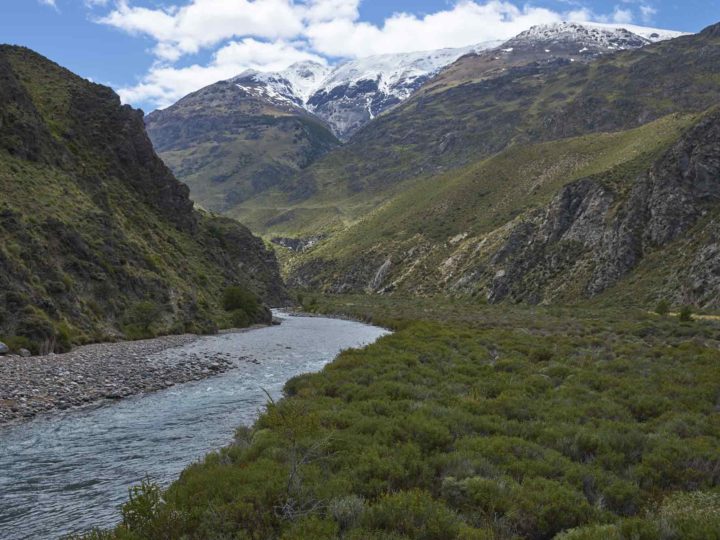
- Duration: 50 kilometers (31 miles); 3-4 days
- Best time to go: The trail is only passable between October and April due to snowfall and adverse weather conditions
- Difficulty: Hard
- Highest point reached: Unknown; elevation gain 1,084 meters (3,556 feet)
- Starting point: Laguna Jeinimeni in Sector Jeinimeni of the park
- Ending point: Stone House Campground in Sector Valle Chacabuco of the park; from here, it’s a further 26 kilometers (16 miles) to reach Los West Winds and the visitor center; you may be able to hitchhike with day visitors traveling this road
- Must-have gear: Light-weight camping and cooking gear, as well as sturdy hiking boots . A waterproof and windproof jacket , as well as plenty of layers for cold nights , are also essential. A water filter will allow you to safely drink water on the trail. A GPS or maps downloaded to your phone are also recommended
- Do I need a guide? You should only attempt this trail if you have extensive backcountry hiking experience, as the trail is remote and you are far away from help. River crossings are also necessary. Patagonia Xpress can potentially organize a guided trip
- Cost: Transport to the trailhead will cost $15,000 CLP p/p ($18 USD); camping at Valle Hermoso in Sector Jeinimeni costs $10,000 CLP ($12 USD) and at Stone House Campground costs $8,000 CLP ($10 USD). A taxi from here to Cochrane will cost $25,000 CLP ($30 USD)-$50,000 CLP ($61 USD), although in high season it may be possible to hitchhike
- Useful information: The national park has information about this trail on their website
Patagonia doesn’t get much more incredible than in the remote wildernesses of Patagonia National Park, one of Chile’s flagship new protected areas.
Brimming with jagged mountains that fold into bewitching glacial lakes, the park is home to trails crossing gurgling rivers and through valleys of sun-burned grasslands and into verdant forests of southern beech, and none is more impressive than the Jeinimeni-Avilés Traverse.
Spanning two sections of the park, Sector Jeinimeni and Sector Valle Chacabuco, this trail is a true challenge for the adventurous. The path is poorly marked, but the trek crosses the wildest parts of the national park, where huemul deer, guanaco, and even puma roam.
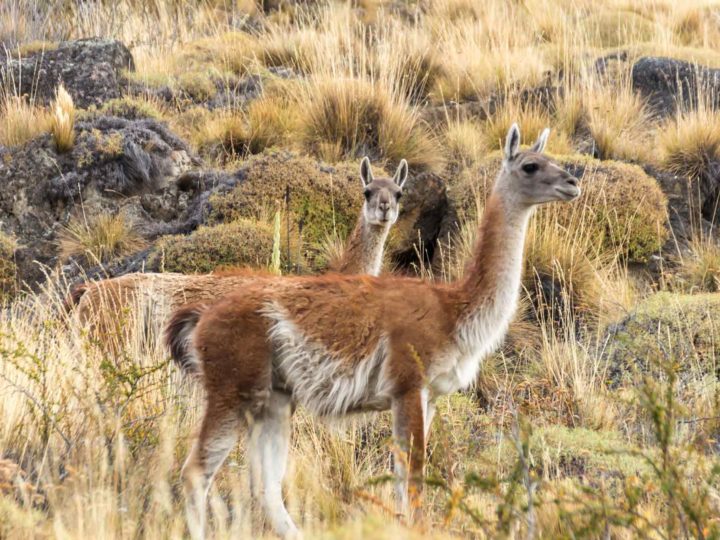
While this multi-day trek requires you to bring everything with you – you’re pretty damn remote, after all – the blindingly brilliant Patagonia vistas of undulating mountains and distant snow-dappled peaks will be more than worth it.
As one of Patagonia’s least-visited national parks, you’re also practically guaranteed to have the trail to yourself
Other trails in Patagonia National Park, Sector Jeinimeni: The Sendero Lago Verde (10 km, 2.5 hrs) takes you along the shores of Lago Jeinimeni to reach Lago Verde, both of which are similarly hued in electric blue. You can also turn this hike into the epic Patagonia National Park Trek (97 km, 5-6 days), which crosses Sector Valle Chacabuco and connects with the Paso Los Condores and the Ruta de Huemul to enter into Sector Tamango, the third part of the national park. Information about the latter here .
6. Lagunas Altas, Sector Valle Chacabuco, Patagonia National Park
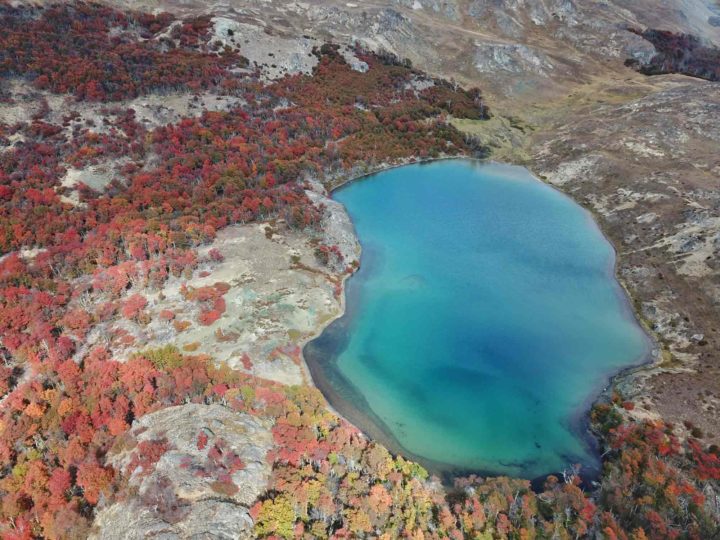
- Duration: 23 kilometers (14.3 miles); 6-8 hours.
- Best time to go: Patagonia in March is characterized by fall colors as the southern beech forests blush red, but any time between October and April is a good time to hike
- Difficulty: Medium; the trail climbs steadily on an exposed hillside for the first few kilometers
- Highest point reached: 1,240 meters (4,070 feet) just before reaching the first of the lakes
- Starting point: Just above the Los Westwinds campground, in Sector Valle Chacabuco of the park
- Ending point: The visitor center, two kilometers (1.2 miles) east of Los Westwinds
- Must-have gear: A windproof coat and layers as it can be cold up on the high plateau where the lakes are situated
- Do I need a guide? No. The trail is well-marked and you can access maps from the visitor center in the park
- Cost: Free.
- Useful information: The national park has information about all trails and logistical information on their website
- Map: The national park has a downloadable map here
The sweeping river basin of Valle Chacabuco is speckled with grazing guanaco and a carpet of ochre grasses that rustle in the breeze, and it’s probably my favorite of the three sections of the brand-new Patagonia National Park.
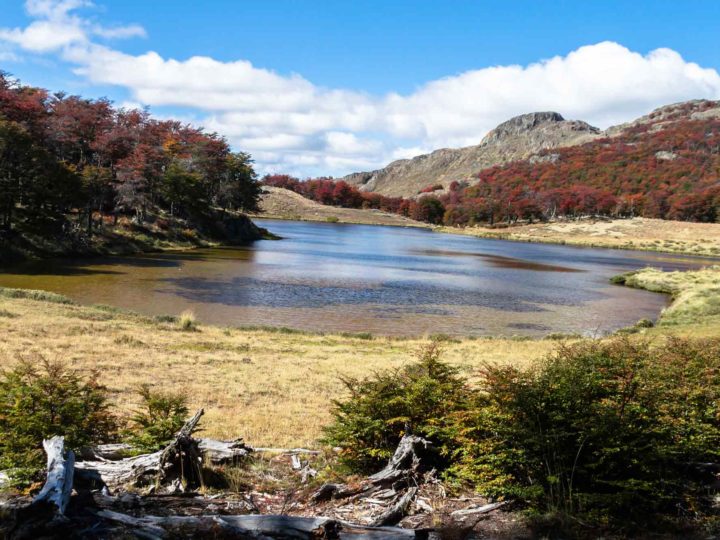
While ground level is spectacular, the views are enhanced as you climb up into the hills along the Laguna Altas trail, one of my personal favorite day hikes in Patagonia. Ascending steadily up into the flank of Cerro Tamaguito and onto an exposed plateau, you’ll find cinematic views across the entire Chacabuco valley and beyond to Argentina.
Along the way, a series of aquamarine lagoons provide the ideal spot for a picnic and, if you’re lucky, you might spy a puma padding through the undergrowth nearby.
Other hikes in the national park: The hard Avilés Loop (16 km, 5-7 hours) gives you a chance to combat the final part of the Jeinimeni-Avilés Traverse, while the medium Lago Chico Loop (12 km, 4 hrs) circuits Lago Chico for panoramic views of Monte San Lorenzo, one of Patagonia’s highest peaks.
Best hikes in northern Argentine Patagonia
7. nahuel huapi traverse, nahuel huapi national park.
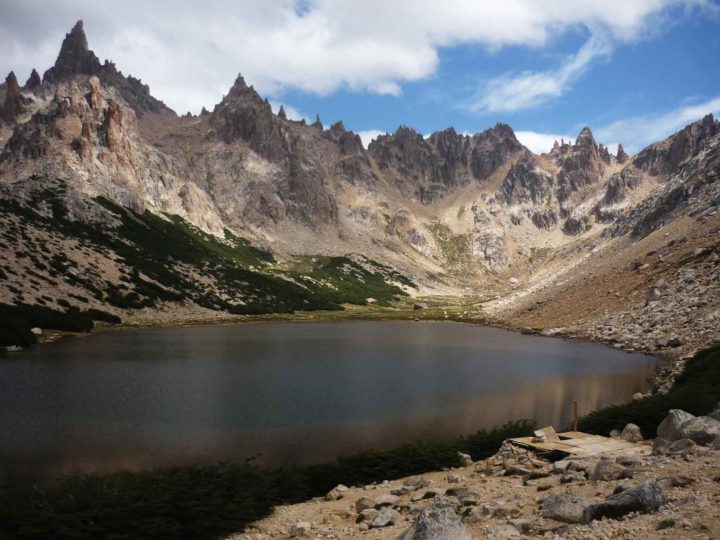
- Duration: 47 kilometers (29 miles); 5 days
- Best time to go: The trek can be impassable due to snow until mid-December, with December through March the best months for hiking
- Difficulty: Hard; some of the trail is poorly marked and there are high ridges and scrambles to be overcome
- Highest point reached: 2,060 meters (6,760 feet)
- Starting point: Cerro Catédral ski resort, 16 kilometers (10 miles) west of Bariloche
- Ending point: Arroyo Lopez, 26 kilometers (16 miles) northwest of Bariloche
- Must-have gear: Camping equipment if you don’t plan on staying in the refugios; trekking poles for the exposed sections of scree, and sturdy hiking boots , are also essential. A GPS or mobile phone with maps downloaded and GPS capabilities are also helpful when the path is poorly-marked
- Do I need a guide? No, however experience of path-finding is essential as much of it is poorly-marked
- Cost: Free; bus to the trailhead costs a few dollars
- Useful information: This website and this one have detailed information about the different stages of the hike
Hiking mecca Bariloche looks like a pleasant Swiss mountain village, with all the access to first-class trekking that you would expect. The nearby Nahuel Huapi National Park, with its craggy peaks and abundance of pristine mountain lagoons, is considered one of Argentina’s finest parks for the intrepid.
This five-day hike travels through an extremely remote part of the national park, with outstanding views of the region’s sparkling lakes (it’s part of the Argentine Lakes District, after all), picture-perfect volcanoes and the forest-fringed mountains that characterise this part of Patagonia.
Not only are the views epic, but the experience is one-of-a-kind, with remote mountain refugios offering a pleasant place to rest your head – and enjoy a beer – after a long day’s trekking in this spectacular part of Patagonia.
Best hikes in southern Chilean Patagonia
8. w trek, torres del paine national park.
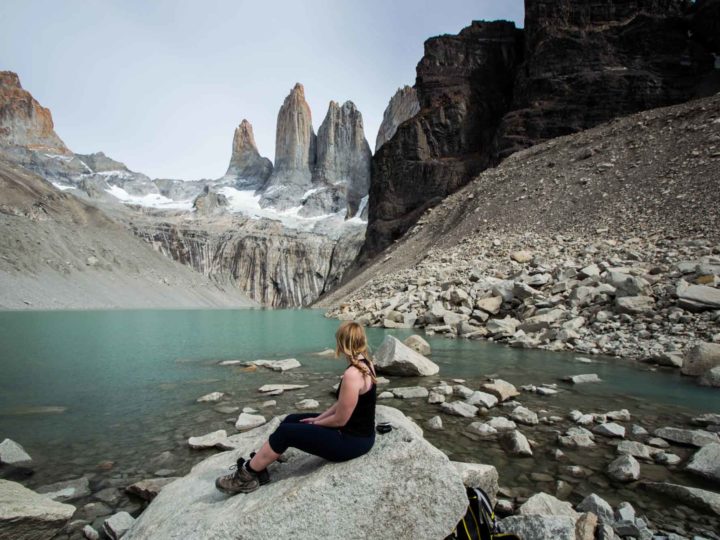
- Duration: 80 kilometers (50 miles); 4-5 days
- Best time to go: Shoulder season (November/mid-December or late February-April) when the trail has far fewer hikers and the weather is still stable and relatively warm, and, in many cases, a lot less windy than in the summer months (December through February). Refugio and campground reservations are also easier to come by during these months. From May through September, you can only hike accompanied by a tour guide
- Difficulty: Medium; to make things easier, you can pay for food and a tent or bed in a refugio to ensure you only have to carry the bare minimum in your day pack
- Highest point reached: 900 meters above sea level (2,950 feet). The trail includes two days of elevation gain of 500-700 meters (1,640-2,300 feet)
- Starting point: Guardería Paine Grande (hiking west to east) or Portería Laguna Amarga (hiking east to west)
- Ending point: Portería Laguna Amarga (hiking east to west) or Guardería Paine Grande (hiking west to east)
- Must-have gear: A Gore-Tex raincoat and waterproof pants are essentials, as high winds and heavy rain are common in Torres del Paine National Park throughout the year. A rain cover for your rucksack and waterproof dry bags to protect your belongings inside are also highly recommended
- Do I need a guide? No. However, the reservation process for the campgrounds can be complicated and must be done at least three months in advance. More details can be found in this guide to reserving refugios and camping in Torres del Paine National Park , or you can use Torres Hike , a website that will save you time and hassle
- Cost: $115,000 CLP ($153 USD), including park entry, camping, and transport; around $1,500 USD for a tour. I recommend Chile Nativo , who give readers a 5% discount when you use the referral discount code “Worldly Adventurer”.
- Useful information: I’ve covered this hike in forensic detail, so read up on how to hike it without a guide and what to pack for Torres del Paine National Park
- Map: Here .
Torres del Paine National Park, with its cobalt blue lakes, wind-buffeted sweeps of hardy forest, and majestic peaks that rise in a jagged, snow-dusted mass out of the center of the park, is Patagonia’s poster child. It’s also home to one of the region’s landmark hiking trails.
A five-day trek that follows a W-shaped trail across some of the park’s most magnificent scenery, the W is an introduction to the soul-stirring qualities of Patagonia.
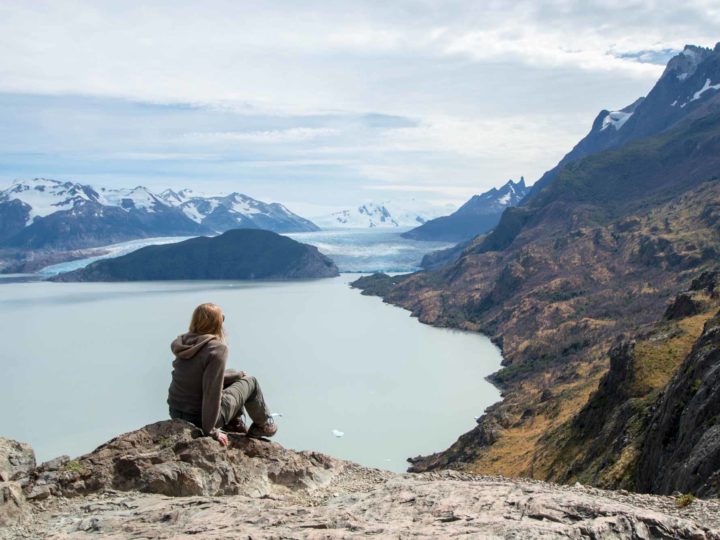
You trek through woodland and out again to face blinding panoramas, where you’ll admire Glacier Grey carving bergs the size of buses into silent waters beneath and stand in silence as you watch huemul picking through scattered vegetation beneath an amphitheater of mountains.
The final and most admired view, however, is Laguna Torres and the three granite towers after which the park is named, which, if you time it right, you can watch turning vivid orange in the light of sunrise. Once you reach the final viewpoint, head to the right along the ridge line, and you’ll get an even better view.
Other hikes in Torres del Paine National Park: There are dozens of hiking trails in the park, so read my guide to the best Torres del Paine day hikes for inspiration.
9. O Circuit, Torres del Paine National Park
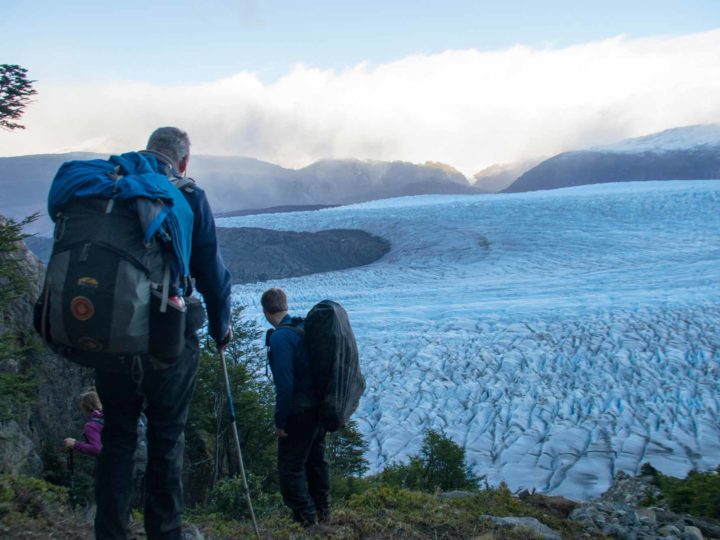
- Duration: 136 kilometers (85 miles); 9-11 days
- Best time to go: As above. For this trail, hikers are only permitted between November and April; the trail is closed during the rest of the year
- Difficulty: Hard; to make things easier, you can pay for food and a tent or bed in a refugio to ensure you only have to carry the bare minimum in your day pack
- Highest point reached: 1,200 meters (3,940 feet) above sea level at the John Gardner Pass.
- Starting point: Portería Laguna Amarga
- Must-have gear: As above. If you choose to self-cater, you will need to bring enough food for the duration of your hike, although small shops at the campgrounds along the W (which you join on day five) have basic supplies
- Do I need a guide? No. As for the O Circuit, the reservation process can be complicated and our article and Torres Hike are excellent resources
- Cost: $112,500 CLP ($155 USD), including park entry, camping and transport; $2,295 USD for a tour. I recommend Chile Nativo , who give readers a 5% discount when you use the referral discount code “Worldly Adventurer”
- Useful information: I’ve covered this hike in epic detail so read the complete guide to the Circuit , 14 things to know before you begin , and what to pack for hiking in Torres del Paine
The O Circuit promises a glimpse into the remote heart of Patagonia that goes beyond the much-trafficked trail of the W.
Instead, this hike takes a sweeping loop of the Cordillera Paine range, meandering into the park’s northern zone where each morning you awake to a new day of glaciers slung in the mountains high above you and gushing water powering its way through furious rivers that accompany the trail for miles.
On day four, you reach the trail’s most enticing viewpoint. A morning’s strenuous climb up to John Gardner Pass brings you to a view of miles of the Southern Patagonia Ice Field, with its ridged glaciers extending beyond the horizon.
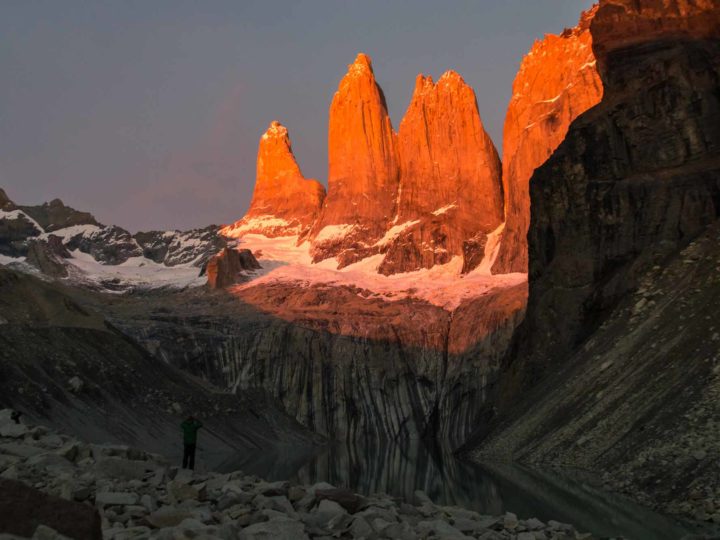
From here on in, you’re on the W trek, which you follow, bewitched, all the way to the final day and dawn rising over the towers.
Other hikes in Torres del Paine National Park: There are dozens of trails in the park, so read my guide to the best Torres del Paine day hikes for inspiration.
10. Hike to Cabo Froward, Punta Arenas
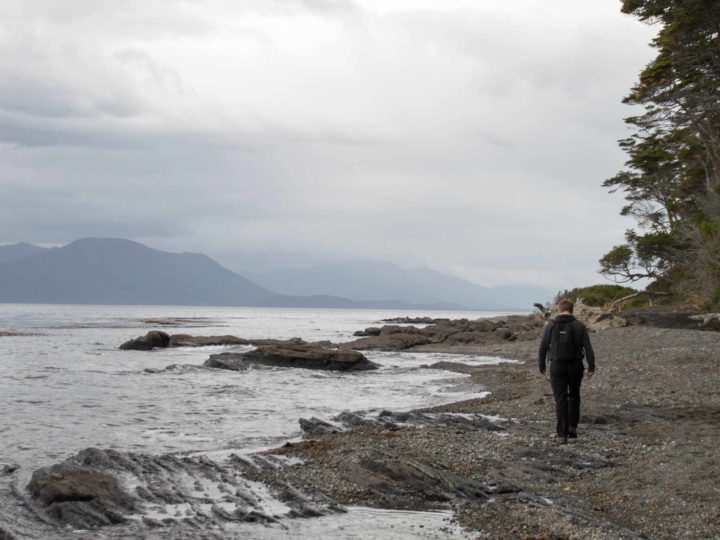
- Duration: 78 kilometers (48.5 miles); 5 days.
- Best time to go: The trek should only be attempted in summer (December through March) to avoid poor weather and rainfall that can make the river crossings even more perilous
- Difficulty: Hard; the trail is poorly marked and passes through remote and demanding terrain of forest and peat bog. Heavy rain means a likelihood of waist- to neck-high river crossings, so it’s essential you don’t attempt this alone. You’ll need to time your hike with the tide so that you can cross sections of the beach during low tide. SHOA , the Chilean navy’s hydrographic and oceanographic website, has tide tables
- Highest point reached: 365 meters (1,200 feet) at Cabo Froward
- Starting point: The trailhead begins at the end of the 9S road, 70 kilometers of Punta Arenas. You will need your own transport to get here, or hire the services of a taxi to drop you off and pick you up
- Must-have gear: Sturdy dry bags for your belongings to protect them during the numerous river crossings
- Do I need a guide? Only those with considerable hiking experience should do this trek and you shouldn’t attempt it alone. The Puerto Natales-based Erratic Rock used to offer five-day, four-night Cabo Froward trekking tours (from $900 USD) – confirm with them directly whether this is still the case
- Useful information: Check out Wikitravel for a route guide
The roaring oceans tumble and churn beyond the shoreline, providing a fierce backdrop as you hike across the beach and through peat bog and rugged forest to the very southernmost point of continental South America: Cabo Froward.
This is Patagonia at its wildest and most untamed, with the cape marking the point where the Atlantic and Pacific Oceans combine in a seething mass.
The waves are your constant companions, so it’s fitting that Cabo Froward – and the end of the trek out – is marked by the towering Cruz de los Mares, the Cross of the Seas, which rises out of the landscape to tower above you.
It’s here where you should pause, breathing in the fierce winds and absorbing the views of the Strait of Magellan across to the deserted mountains of Isla Dawson.
Keep your eyes peeled for dolphins, whales, and other sea life as you pick your route back the way you came and onwards to civilization – although the feeling of being buffeted by the wind and isolated far from everyone else is one that will last with you a long time.
11. Dientes de Navarino, Navarino Island
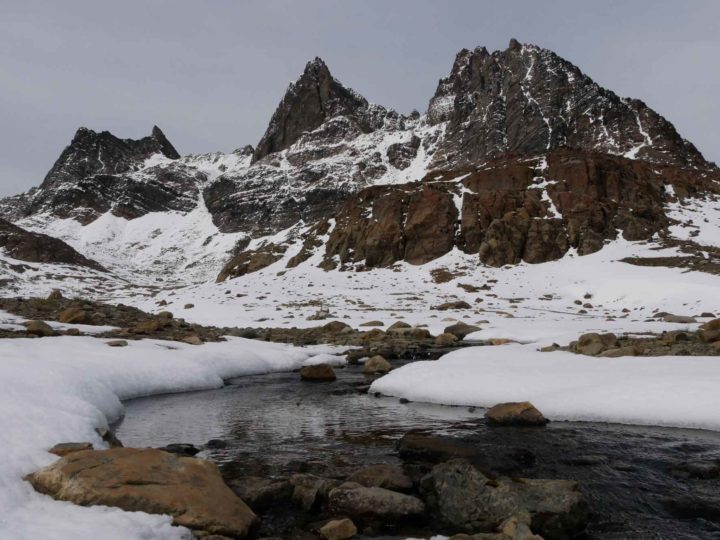
- Duration: 53.5 kilometers (33 miles); 5 days
- Best time to go: The trail is only passable in the Austral summer, between the months of December and March, although extreme weather, including high winds, rain, and even snow are possible at any time
- Difficulty: Strenuous; you must carry all of your own camping equipment and food for the duration of the trek. The trail itself is poorly marked at times, which means extensive hiking experience, plus a working GPS, are essential
- Highest point reached: 860 meters (2,820 feet) at Paso Virginia
- Starting point: Western edge of Puerto Williams
- Ending point: 6 kilometers (3.7 miles) west of Puerto Williams
- Must-have gear: Light-weight camping and cooking equipment are essential, while a durable, waterproof jacket , pants, and rucksack cover will keep you and your things warm and dry. A GPS or phone with downloaded maps and GPS capacities is also essential to ensure you can follow the trail
- Do I need a guide? No, but anyone who does not feel 100% confident with their experience of hiking in remote and extreme environments should seriously consider hiring a guide. You must register with the police in Puerto Williams before beginning this trek
- Cost: Free without a guide; $2,395 USD with a tour company. Local company Explora Isla Navarino can organize guided tours, including transfers to and from the start of the trail and the services of a guide with satellite phone.
- Useful information: This website has great information
If it’s remote, untouched Patagonia you’ve looking for on this list of hikes, then you’ll find it in the Dientes de Navarino, a trail that climbs through the final stretch of the Patagonian Andes and promises a true trekking adventure.
This five-day hike isn’t for the faint of heart of those without extensive trekking experience. But what you can expect is the truly wild, pristine, and mountainous scenery on what is officially the world’s southernmost long-distance hike.
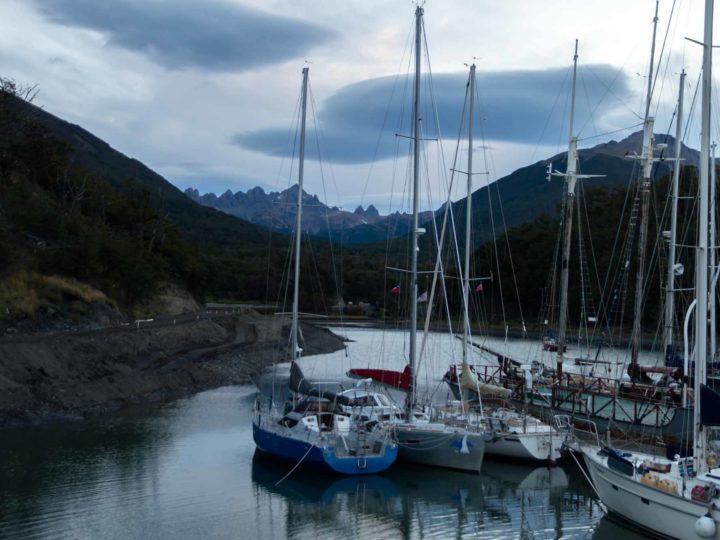
Named after the toothy mountains that jut out of Navarino Island (so far south it lies beyond Ushuaia, often mistakenly considered the southernmost settlement in the world), this trail clambers across stark, rocky land dotted with lakes and sparse, scrubby vegetation.
If you’re looking for an experience of hiking at the very ends of the earth, the Dientes de Navarino is the one for you.
Other hikes in Puerto Williams : If you don’t fancy doing the full circuit, you can do a short hike up to Cerro Bandera (4 km, 2 hrs) for stunning vistas across the town and the Beagle Channel.
Best hikes in southern Argentine Patagonia
12. laguna de los tres, los glaciares national park.
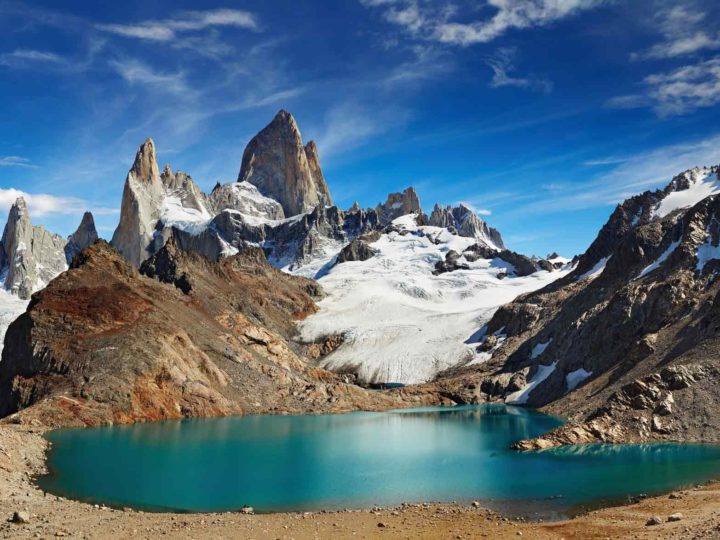
- Duration: 23 kilometers (14 miles); 8-10 hours, although you can turn it into a two-day trek, a watch dawn break over Monte Fitz Roy, if you camp overnight at Campamento Poincenot, just below the final ascent to Laguna de los Tres. If opting for a one-day trek, make sure you start early.
- Best time to go: The trail is generally only open from October through April (after which heavy snowfall closes much of the park). Like Torres del Paine National Park, visitors peak between mid-December and February, when you may find yourself queuing to make the final ascent
- Difficulty: Medium/hard; much of the hike has a gentle ascent, but the final two kilometers (1.2 miles) are very, very steep
- Highest point reached: Unknown, but the elevation gain across the trek is around 700 meters (2,300 feet), with the final 400 meters (1,300 feet) coming in the final two kilometers (1.2 miles).
- Starting point: From the northern edge of El Chaltén, the town closest to this part of Los Glaciares National Park
- Must-have gear: Sturdy hiking boots and trekking poles can help on the final ascent. If it’s raining, a good Gore-Tex waterproof coat will keep you dry, while you’ll want layered clothing ( a fleece or other warm sweater ) for the top, where it can get fiercely windy and cold
- Do I need a guide? No; plenty of other hikers on the trail will make it hard for you to get lost
- Useful information: This website has information about this trek and all others in and around El Chaltén
Like the W trek and the torres of Torres del Paine, Laguna de los Tres has become the stuff of backpacking legend in Patagonia and you can’t go hiking in South America without attempting this trail.
The Laguna de los Tres trail’s fame stems from the way it picks its way through shady forests where woodpeckers and even rare huemul deer linger, and where the occasional openings in the trees give up broad views of Monte Fitz Roy.

But mostly, this reverence stems from the very end point of the trek where, after a lung-busting climb up and up over rocky scree you appear out on the shores of Laguna de los Tres, whose green-tinged glacial waters reflect the pronged peak of Monte Fitz Roy rising directly above.
While many choose to clamber up to this dazzling viewpoint as a one-day excursion from El Chaltén, if you’ve got the time, take a tent to pitch up in the basic Campamento Poincenot, just below the final ascent to the lake, and head up early the next morning for a truly unforgettable sunrise.
Other hikes in Los Glaciares National Park: The moderate trek to Laguna Torre (18 km, 9 hrs) allows you to experience the start of the Huemul Circuit and has spellbinding views of the Cordón Adela mountains and the often cloud-covered Cerro Torre; the trail to Chorrillo del Salto (4 km, 1.5 hrs), is an easy wander out to a pretty 20-meter waterfall; the steep trail to Mirador Los Condores (2.5 km, 30 mins) and Mirador Aguila (1.3 km extra, 30 mins more) has great views of Lago Viedma, as well as the prospect of spying condors.
13. The Huemul Circuit, Los Glaciares National Park
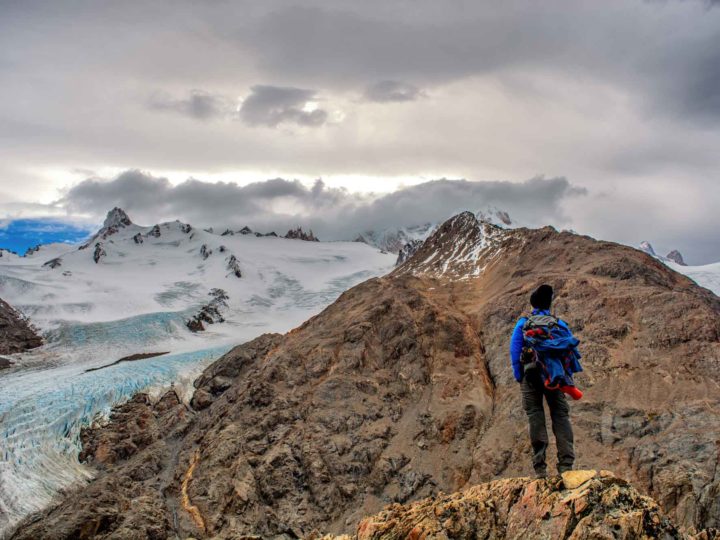
- Duration: 70 kilometers (43 miles); 4 days
- Best time to go: January and February see the best weather conditions on this hike and trekking should only be attempted between October and April. Shoulder seasons are far more challenging times to do this trek, as snowfall can prevent you from crossing the pass
- Difficulty: Strenuous; the trek includes two river crossings that often require the use of ziplines.
- Highest point reached: 1,550 meters (5,085 feet) at Paso del Viento (Windy Pass)
- Starting point: Southwestern edge of El Chaltén
- Ending point: Park ranger visitor’s center south of El Chaltén
- Must-have gear: Winds can reach up to 100 kilometers per hour, so bring plenty of layers and windproof, waterproof outer clothing to keep you warm. You will also need safety equipment (which you must show to the park rangers before you leave), including a harness, two carabiners, a safety line, and 20 meters of rope, all of which you can rent in El Chaltén; you will not be allowed to hike if you don’t have these. A GPS or phone with Maps.me downloaded is essential, as the trail is poorly marked
- Do I need a guide? As much of the trail is poorly marked, you should not attempt this trek unless you have considerable map-reading experience, as very few people – and park rangers – are on the trails and if you get into difficulty, you’re on your own. You must register at the Centro de Informes Ceferino Fonzo for the national park in El Chaltén to get a hiking permit – this will ensure that the rangers come out looking for you if you don’t come back off the mountain
- Cost: Free; tours start from around $900 USD per person. Fitz Roy Expediciones is a good option for a guided trek
- Useful information: This blog post has a level of detail that even I’m impressed by!
Laguna de los Tres might draw the day trippers, but Los Glaciares’ most superlative scenery is reserved for the most intrepid. The Huemul Circuit is just that.
What makes this trek an extraordinary adventure – and certainly among one of South America’s, if not the globe’s, best hikes – is the thrill of roaming the backcountry in this remote part of Argentina, picking your way past glaciers and around milky-blue glacial lakes.
But the most astonishing feature of this trek is the views from Paso del Viento, all the way across the Southern Patagonian Ice Field – an astonishing panorama of practically unending ice that shimmers beneath the sky.
The Huemul Circuit is by no means a walk in the park, but those who do it will find themselves safe in the knowledge that they may just well have encountered the finest views in all of Patagonia.
Other hikes in Los Glaciares National Park: The moderate trek to Laguna Torre (18 km, 9 hrs) allows you to experience the start of the Huemul Circuit and has spellbinding views of the Cordón Adela mountains and the often cloud-covered Cerro Torre; the trail to Chorrillo del Salto (4 km, 1.5 hrs), is an easy wander out to a pretty 20-meter waterfall; the steep trail to Mirador Los Condores (2.5 km, 30 mins) and Mirador Aguila (1.3 km extra, 30 mins more) has great views of Lago Viedma, plus the prospect of spying condors.
14. Crossing from Villa O’Higgins to El Chaltén (Chile/Argentina)
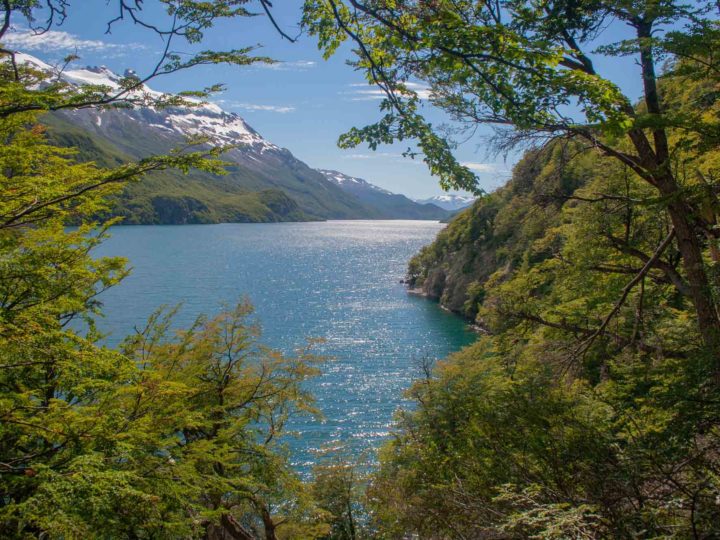
- Duration: 22 kilometers (13.7 miles) or an additional 10 kilometers (6 miles) if you don’t take the ferry on the first day; 2 days
- Best time to go: You can only take this route November through April, as the ferries stop operating outside of these months
- Highest point reached: Unknown, although there are no high peaks to be climbed on this hike
- Starting point: Lago del Desierto, 35 kilometers (21.7 miles) north of El Chaltén along the Ruta 23, although the journey can be done in the opposite direction
- Ending point: Villa O’Higgins
- Must-have gear: Bring Chilean pesos, enough food for at least two or three days of waiting around for a boat, camping equipment, and plenty of warm and waterproof clothing
- Do I need a guide? No. Note that you may find yourself waiting for a couple of days for your ferry across to Villa O’Higgins if poor weather prevents the ferry from making the crossing
- Cost: Minibus to Lago del Desierto costs $20 USD (2 hrs); ferry across Lago del Desierto costs $28 USD; ferry from Canderlario Mancilla to Villa O’Higgins costs $36,000 CLP ($50 USD) direct to Villa O’Higgins or $82,000 CLP ($113 USD) via Glaciar O’Higgins.
- Useful information: You can make reservations for all of the bus journeys and boats, plus horses for cargo and the campsite at Candelario Mancilla, in advance here
In Patagonia, even the border crossings between Chile and Argentina are an adventure, particularly the route between El Chaltén and Villa O’Higgins, one only passable on foot.
Starting on the shores of the azure Lago del Desierto, you’ll hike or take the ferry across to the northern edge of the lake, where the only way is on foot as you climb gently up into the mountains through wind-battered forests of southern beech, with Monte Fitz Roy crowing the sky behind you.
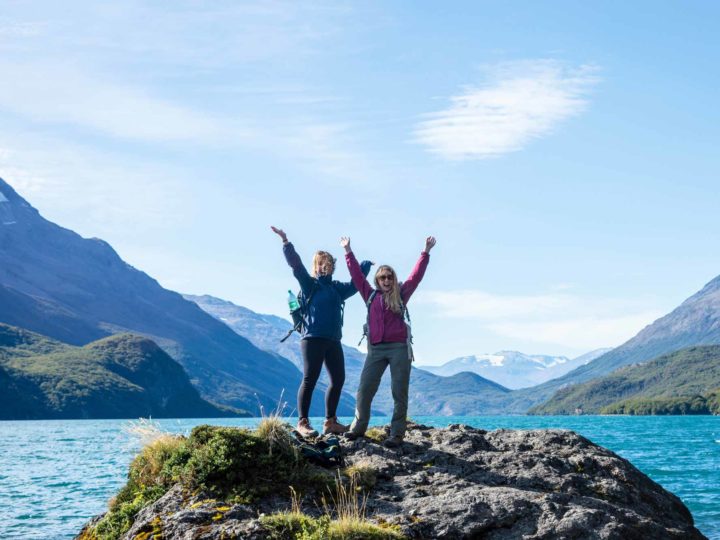
But that’s not all: after crossing the Chilean border and reaching the remote settlement of Candelario Mancilla, you’ll have to wait for your transport. It’s a boat that’ll take you past the calving ice giant that is Glaciar O’Higgins before dropping you onto the shores of the southernmost settlement along the Carretera Austral, Villa O’Higgins.
You’ll soon realize on this trail that every moment of this journey feels deliciously wild, untouched, and magical.
15. Cerro Guanaco, Tierra del Fuego National Park
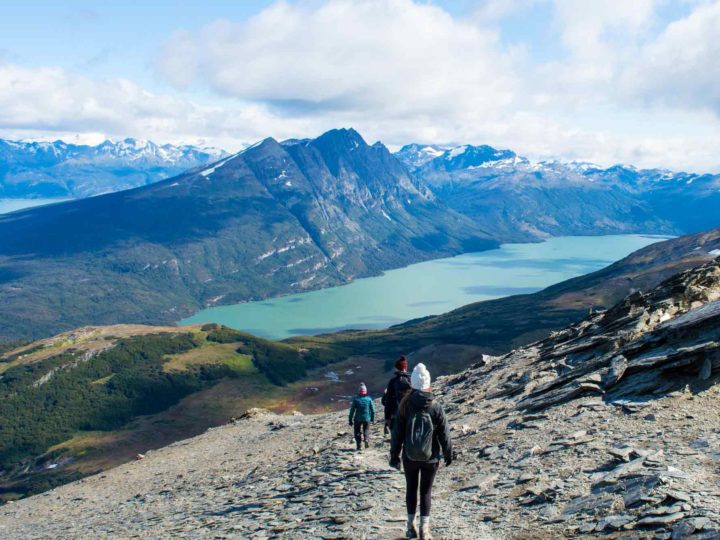
- Duration: 8 kilometers; 8 hours
- Best time to go: November through March promise the best weather, as well as public transport to the park. A small number of campgrounds are also open in the national park during these months
- Difficulty: Hard; the trek gains 973 meters (3,190 feet) over just four kilometers, making the trail extraordinarily steep
- Highest point reached: 973 meters (3,190 feet) at Cerro Guanaco
- Starting point: From outside the Centro de Visitantes Alakush. The public bus from Ushuaia picks up and drops off here throughout the day; if traveling in a pair or more, it’s often cheaper to hire a car for the day than take the bus, which costs around $20 USD return per person
- Must-have gear: A pair of trekking poles will be invaluable in the muddy section of the hike as well as in the open scree
- Do I need a guide? No; the trail is well-marked
- Cost: $8 USD for park entry
- Useful information: Park website with basic information here
Flanked by a wall of mountains on its northern edge and the frigid, whale-filled waters of the Beagle Channel in the south, Ushuaia is Argentina’s southernmost city and has access to spectacular nature nearby.
Tierra del Fuego National Park has a handful of day hikes, but the gem in its crown is the challenging trek up Cerro Guanaco. It’s a sludgy, waterlogged climb once you exit the tree line and find yourself in a bog that merges into a staggeringly steep and bone-dry outcrop of scree.
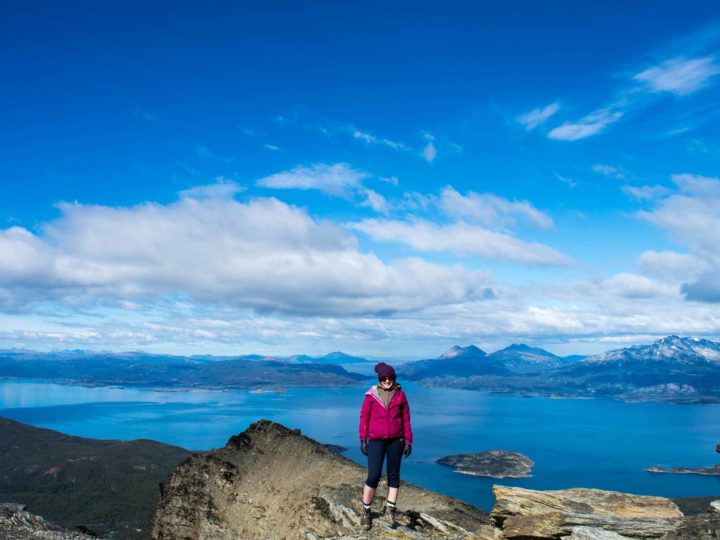
A final clamber along the edges of this and you finally reach the top of Cerro Guanaco, from whose exposed crest the cinematic views of the Beagle Channel and the mountains of Navarino Island await.
Keep your eyes peeled as you hike through the forests the first section of the trail, where red and black-headed Magellanic woodpeckers are resident.
Other hikes to do in Tierra del Fuego National Park: The easy Senda Costera (8 km 4 hrs) is a meandering coastal path with beautiful mountain views; the also easy Senda Pampa Alta (3 km, 1 hr) climbs up to a lookout for views of the Beagle Channel and the Valle del Río Pipo; the Senda Hito XXIV (7 km, 3 hrs) is an easy hike along the edges of Lago Acigami to reach the border with Chile and has lovely views across the Beagle Channel.
FAQs about hiking in Patagonia
Is patagonia good for hiking.
Patagonia is considered one of the best places on the planet to hike! With the Andes Mountains cutting through the middle of Patagonia, it’s no wonder that the region offers excellent hiking. Destinations such as Torres del Paine National Park, Bariloche, and the new national parks along the Carretera Austral top of most trekkers’ bucket lists.
The best thing about hiking in Patagonia is that, despite the proximity to the mountains, none of the hikes in Patagonia are at altitude.
In fact, unless you’re a climber, you’re unlikely to reach over 1311 (4,301) meters above sea level – the elevation of Paso Viento, the highest point along Argentine Patagonia’s Huemul trek – on any of the hikes. As a result, there’s no need to worry about hiking at altitude in Patagonia.
Is hiking difficult in Patagonia?
It entirely depends on the hiking you choose to do. While the O Circuit in Torres del Paine National Park might be a moderately challenging eight- or nine-day trek , it’s still a great choice for people who’ve never embarked upon a multi-day hike before (although you certainly want to have day hiking experience before doing so!).
Patagonia is also home to plenty of one-day treks, including those such as the Lagunas Altas trail in Chile’s magnificent Patagonia National Park and the more famous Laguna de los Tres route in Argentina’s Los Glaciares National Park.
There are also plenty of moderate multi-day hikes, such as the five-day W trek and the four-day Cerro Castillo Traverse (both in Chile), plus difficult routes such as the four-day Huemul Circuit (also in Los Glaciares National Park) and Dientes de Navarino (on Chile’s Navarino Island). As a result, you can pick and choose trails that suit your ability.
How many days do you need to hike in Patagonia?
Patagonia is packed with hiking trails, so it really depends on how many you want to do! If you fancy the five-day W trek, then you’ll need at least a couple of days on each side to fly from Santiago to Puerto Natales, the closest airport to Torres del Paine National Park (the park in which the hike is located).
Additionally, if you plan on doing day or multi-day hiking in Los Glaciares National Park just across the border in Argentina, you’ll want at least three days (for day hikes) or four days for the Huemul Circuit, plus a couple of days to get there and back from Chile or from Buenos Aires.
If you fancy tackling the best treks in Bariloche, give yourself at least four days, while Chile’s Carretera Austral, with its glut of lesser-known national parks, needs at least two weeks if you plan on hiking the best trails.

Hiking in Patagonia: Your Ultimate Guide to Scenic Trails & Multi-Day Treks
Everything you need to know about hiking in Patagonia, from Torres del Paine to El Chalten: when to visit, best hikes, how to plan and what to pack.
Are you ready to embark on the adventure of a lifetime? Patagonia beckons hikers from around the globe. Situated in the southern regions of Chile and Argentina, this remote corner of our planet boasts awe-inspiring landscapes, challenging trails and unique wildlife. From the iconic Torres del Paine to the hidden gems of Ushuaia, Patagonia has something for everyone.
Whether embarking on a scenic trail or multi-day hike, you can expect a treasure trove of windswept landscapes, jagged granite spires, immense glaciers, and some of the largest ice fields on Earth. In this ultimate guide to hiking in Patagonia, we’ll equip you with all the information you need to plan your dream trek.
This article contains affiliate links from the Amazon Associate and Travelpayouts programs. Wild Travel Tales will earn from qualifying purchases, at no extra cost to you .
The Best Time to Go Hiking in Patagonia
Before we dive into the specific treks, let’s talk about the best time to visit Patagonia. Each season offers a unique experience, and your choice will depend on your budget, tolerance for different weather conditions and other travel plans. In this section, we’ll delve into the weather patterns, seasons, and the ideal months for hiking in Patagonia.
Generally, the period from early November to late April is considered ideal for hiking. If you prefer milder temperatures, aim for February and March. For the full spectrum of Patagonian beauty, visit in late March to mid-April when the region is painted in stunning autumn colours. However, Patagonia’s weather is known for its unpredictability, so be prepared for sudden changes.
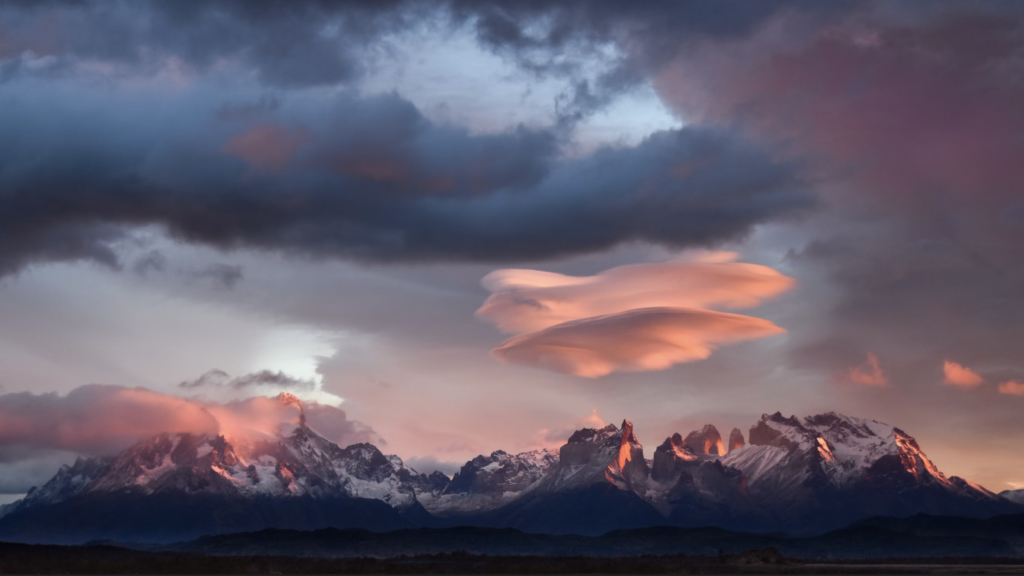
Weather in Patagonia
The weather in Patagonia is famously unpredictable, and understanding its patterns is vital for planning your trek. You can experience all four seasons in a single day, any day of the year. As Patagonia’s weather can change rapidly, you must come prepared with appropriate gear for all conditions.
Proper preparation is key to a successful hike. While the information below acts as a useful guide, local ranger stations will be an invaluable resource for up-to-date weather forecasts and safety advice.
Summer (December-February)
- Summary: December through February marks the peak hiking season in Patagonia. This period is considered the most favorable time for travelers to explore the region due to milder weather and longer daylight hours. Fierce winds are common, sometimes reaching up to 120km/hour.
- Weather: During this time, temperatures are at their warmest and typically range from 15°C to 24°C (60°F to 70°F). The weather is relatively more stable and less extreme.
- Daylight: The days are long, providing ample daylight for exploration. This is especially important for trekkers who need sufficient daylight for their adventures.
- Crowds: Patagonia can get crowded during the peak season, especially in popular national parks and trekking areas. If you prefer a quieter and more secluded experience, you might want to explore less-visited regions or consider visiting during the shoulder season.
- Precipitation: Occasional precipitation, but typically less frequent and intense than in autumn. There are also reduced chances of snowfall.
- Trail accessibility: The majority of the trekking routes, including popular ones like the W Trek in Torres del Paine National Park, are fully accessible and well-marked during the peak season. Trails are less likely to be affected by snow and ice, making hiking conditions more manageable.
- Wildlife: Peak season coincides with the breeding and nesting seasons for many of Patagonia’s wildlife species. It’s an excellent time for birdwatching and observing animals like guanacos, foxes, condors, and even penguins along the coast.
Autumn (March-April)
- Summary: Autumn offers a quieter alternative to the bustling summer season. Hiking in Patagonia over this shoulder season will provide a quiet and unique experience.
- Weather: Slightly cooler temperatures than summer, with daytime temperatures ranging from 8°C to 15°C (46°F to 59°F) on average. The wind is also milder. However, temperatures can still drop significantly at night, so packing warm layers is essential.
- Daylight: Daylight hours start to decrease as autumn progresses. You can expect around 10 to 12 hours of daylight in March and slightly less in April. While this means shorter daylight for activities, it can also lead to stunning sunrise and sunset opportunities.
- Crowds: One of the significant advantages of traveling in Patagonia during March to April is the reduced number of tourists. The peak season crowds have mostly dissipated, making it easier to find accommodations and enjoy the wilderness in a quieter, more contemplative atmosphere.
- Precipitation: Higher levels of precipitation are possible, so waterproof gear is advisable. Additionally, some areas may experience the first snowfalls of the season, particularly in late April.
- Trail accessibility: Many trekking routes and trails remain accessible during March and April, but the conditions can be more challenging due to cooler temperatures and potential rain or snow. Some higher-altitude trails may become less accessible as snow accumulates.
- Wildlife: Patagonia’s wildlife remains active during the autumn months. You may have opportunities to see animals like guanacos, foxes, and birds as they prepare for the winter season. Additionally, this time of year can be ideal for birdwatching, as migratory species pass through the region.
Spring (September-November)
- Summary: Spring is an excellent time to explore Patagonia, as the region awakens from winter but before the tourist rush. During this time, you’ll witness the landscapes coming to life with blooming flowers and newborn wildlife. However, the weather can be quite variable and trails may still have some remnants of snow and mud.
- Weather: Spring in Patagonia is characterized by gradually warming temperatures. Daytime temperatures typically range from 8°C to 15°C (46°F to 59°F) in September and can reach 15°C to 20°C (59°F to 68°F) in November. However, be prepared for chilly nights, especially in September when temperatures can drop significantly.
- Daylight: Daylight hours increase as spring progresses. In September, you can expect around 11 to 13 hours of daylight, while in November, there are approximately 15 hours of daylight. Longer daylight hours provide more time for outdoor activities.
- Crowds: Traveling during spring allows you to avoid the peak summer crowds. While some tourists may start arriving in November, the region remains relatively uncrowded compared to the December to February period.
- Precipitation: Precipitation levels can vary, but spring tends to be less rainy than the autumn months. You may still encounter occasional rain showers, especially in September, so having waterproof gear is advisable. As the season progresses, rain becomes less frequent.
- Trail accessibility: Trail conditions in early spring can be challenging, with some lingering snow and muddy sections in higher-altitude areas. As the season advances, trails become more accessible and drier. Popular trekking routes like the W Trek are generally open, but it’s essential to check trail conditions and be prepared for variable terrain.
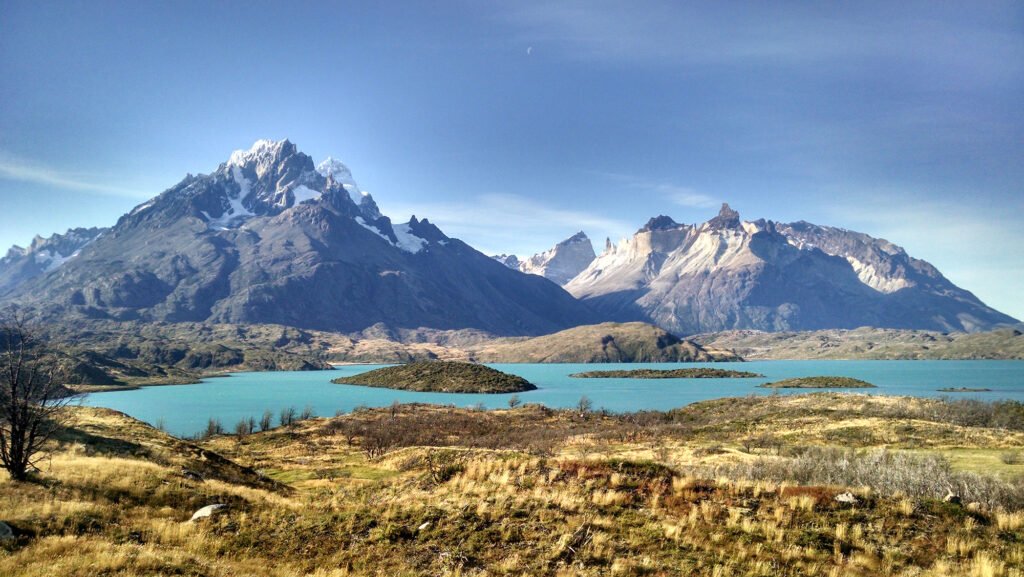
How Many Days Does it Take to go Hiking in Patagonia?
Determining the ideal duration for your Patagonian adventure depends on several factors, including your interests, fitness level, and the specific trails you plan to hike. Patagonia offers a wide range of hiking options, from day hikes to multi-day treks. Here’s a general guideline to help you plan:
- Day Hikes: If you have limited time or prefer a more relaxed experience, day hikes can be incredibly rewarding. Many of Patagonia’s iconic trails, such as Laguna de Los Tres in El Chaltén or Mirador Las Torres in Torres del Paine, can be completed in a day.
- Multi-Day Treks: For a more immersive experience, consider embarking on multi-day treks. The duration can vary significantly depending on the trail. The popular W Trek in Torres del Paine typically takes 4-5 days, while the more extensive O Circuit can span 6-9 days.
- Combination: To make the most of your visit, consider a combination of day hikes and multi-day treks. This approach allows you to explore the highlights while also delving deeper into the wilderness.
Remember that travel times between hiking destinations, rest days, and acclimatization are factors to consider when determining the duration of your Patagonian adventure. It’s advisable to plan for some flexibility in your itinerary, allowing you to fully immerse yourself in the stunning landscapes and unexpected discoveries that Patagonia has to offer.
Building in extra days also allows you to adjust your plans based on adverse weather conditions. Spending an extra night or two in a warm hostel, instead of braving the rain on a multi-day hike to ensure you keep to your itinerary, can make all the difference!
Getting to Patagonia
Patagonia spans both Chile and Argentina, and its vast wilderness is located in the southern reaches of these countries. Here’s a guide to help you reach Patagonia efficiently:
1. International Airports:
- Santiago, Chile: Many travelers fly into Santiago, Chile, for international arrivals.
- Buenos Aires, Argentina: Buenos Aires, Argentina, is another common international gateway to Patagonia.
2. Domestic Flights:
- Punta Arenas, Chile: If arriving in Santiago, consider taking a domestic flight to Punta Arenas, Chile, to minimize travel costs and time.
- El Calafate, Argentina: If departing from Buenos Aires, domestic flights to El Calafate, Argentina, offer convenience.
3. Bus Transportation:
- Connecting to Main Trekking Areas: Upon arriving in southern Patagonia, efficient and affordable bus transportation is readily available to connect you to the main trekking areas.
Hiking In Torres del Paine National Park
Now that we’ve covered essential planning aspects, let’s dive into the heart of Patagonia: Torres del Paine National Park. This iconic destination offers some of the most breathtaking hikes in the region. You can access the park via Puerto Natales .
Hiking to Mirador Las Torres
- Time Required: 8 to 9 hours
- Distance: 18km
- Difficulty: Moderately challenging with steep sections
- Start / Finish Points: Hotel Las Torres
- Highlights: Witness the famous Torres del Paine towers mirrored in the glacial lake
One cannot speak of hiking in Patagonia without mentioning Torres del Paine National Park. A must-visit for any trekking enthusiast, the Mirador Las Torres trail offers a challenging but immensely rewarding day hike. The path spans 18 kilometers and leads to the iconic Towers – three jagged peaks overlooking a turquoise lake. The last leg of the hike is steep, but the views are absolutely breathtaking. If you’re an early riser, consider starting before dawn to witness the iconic granite spires bathed in the fiery glow of sunrise.
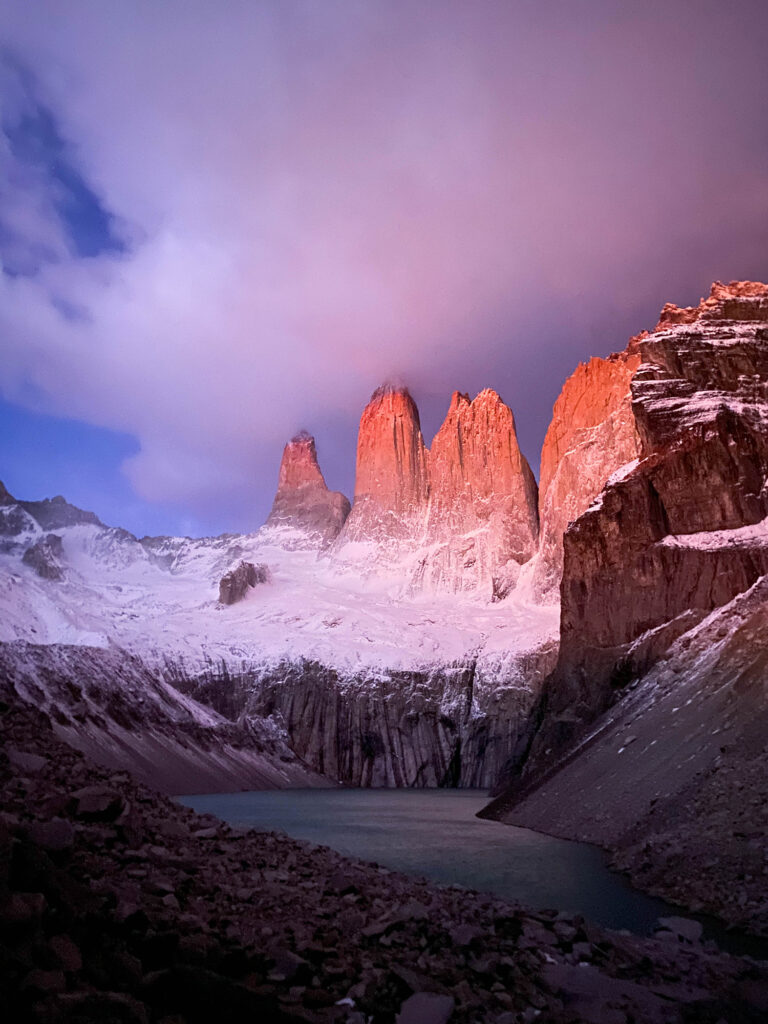
Lago Grey (Grey Glacier)
- Time Required: 3 to 4 hours
- Distance: 11 kilometers
- Difficulty: Easy to moderate
- Start / Finish Points: Mountain Lodge Paine Grande to Refugio Grey
- Highlights: Get up close to Grey Glacier’s stunning ice formations and ethereal blue glacier
For those craving a more relaxed hike with stunning glacier views, the Lago Grey trail is perfect. This 11-kilometer route takes you along the W Trek, offering glimpses of the awe-inspiring Glaciar Grey and its floating icebergs. The terrain is relatively easy, with a few tricky sections. If you’re in the mood for camping, you can spend the night at Mountain Lodge Paine Grande or Refugio Grey and enjoy the serene surroundings.
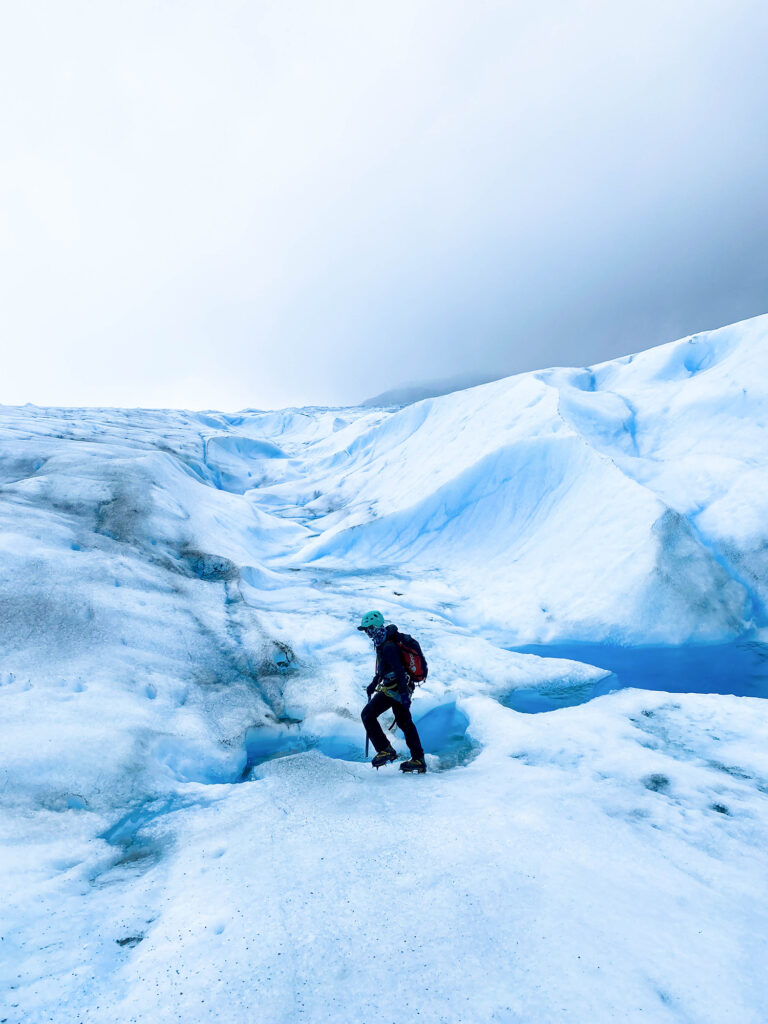
Valle del Frances (The French Valley)
- Distance: 12km
- Difficulty: Moderate
- Start / Finish Points: Refugio Los Cuernos
- Highlights: Jaw-dropping vistas of the granite peaks and hanging glaciers
Prepare to be mesmerised by the beauty of the French Valley, which offers breathtaking panoramic views of the Paine Massif. This moderate hike takes you between Cerro Paine Grande and Cuernos del Paine, following the Rio Frances. The highlight of this trail is the frozen waterfalls, a sight to behold. Although the path can be challenging, the rewards are ample. The Mirador at the end provides breathtaking views of the surrounding mountains and tarns reflecting the scenery.

Los Cuernos Trail
Offering a fantastic day hike, the Los Cuernos Trail winds its way around the stunning Lago Nordenskjold. You’ll be treated to incredible vistas of Cuernos del Paine and the lake’s clear waters. For those with extra energy, consider exploring the Valle del Frances, an additional 12-kilometer section known for its beauty. Camping options are available on the south side of Cuernos Del Paine if you want to extend your hike.
- Time Required: 6 hours
- Distance: 22km
- Start / Finish Points: Hotel Las Torres to Refugio Los Cuernos
- Highlights: Diverse landscapes and stunning views of the Cuernos del Paine

- Time Required: 4 to 5 days
- Distance: Approximately 50-70 kilometers (31-44 miles)
- Difficulty: Moderate to challenging, with steep ascents and variable weather.
- Start / Finish Points: Typically, the trek begins and ends at the administrative center of Torres del Paine National Park, near Laguna Amarga.
- Highlights: The “W” Trek in Torres del Paine National Park encompasses Mirador Las Torres, Lago Grey, the French Valley, and Los Cuernos, making it a comprehensive hiking experience.
Hiking the W Trek in Torres del Paine National Park is a bucket-list adventure for nature enthusiasts, offering a chance to immerse yourself in Patagonia’s pristine wilderness and witness some of the world’s most awe-inspiring natural wonders. You can also go ice hiking on Grey Glacier , a unique and unforgettable experience. Various accommodation options are available along the route, including campsites and mountain lodges (refugios). Reservations should be made in advance, especially during the high season. Plan ahead, pack appropriately, and embark on this unforgettable journey through Chile’s breathtaking landscapes.
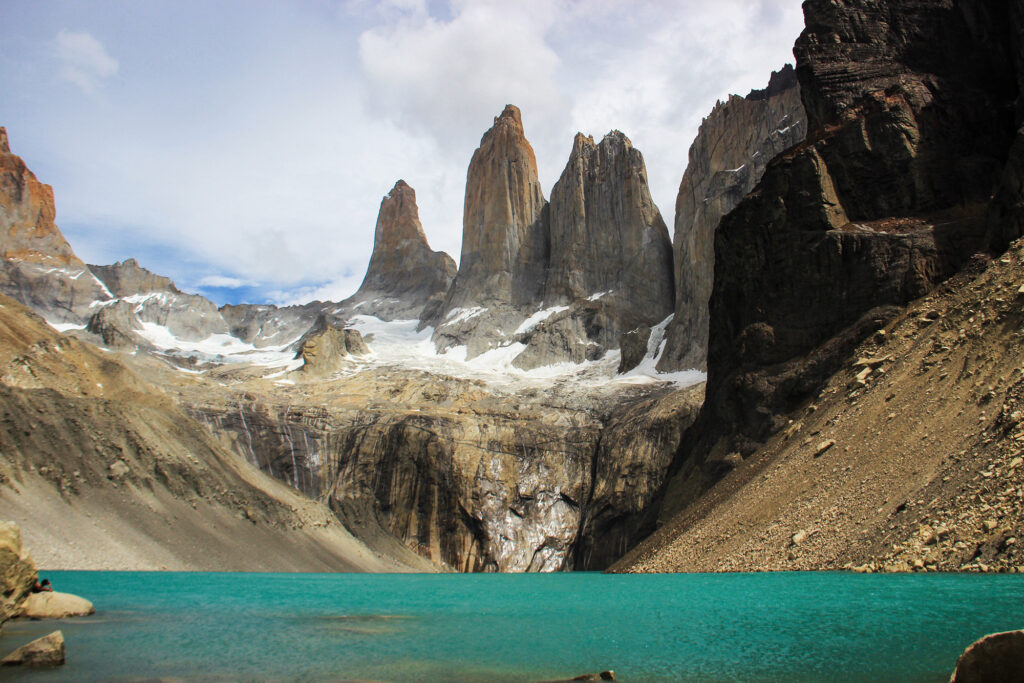
The O Circuit
- Time Required: 6-8 days
- Distance: 135km
- Difficulty: Hard
- Highlights: In addition to the sights of the W Trek, you will also see John Gardner Pass, Grey Glacier Peninsula, Paso los Perros
Considered one of the world’s best treks, the O Circuit is a must for adventurous souls. It is an extension of the W Trek, following the same trail for 4-5 days before continuing in a loop. It is a more remote, immersive wilderness experience that takes you deeper into Torres del Paine National Park.
This 135-kilometer circuit encompasses pristine forests, meadows of wildflowers, grand peaks like Cerro Paine and Cuernos del Paine, and even the iconic Las Torres. Starting at Hotel Las Torres and heading to Campamento Seron, you’ll encounter ever-changing landscapes and breathtaking scenery. Side trips to the French Valley and Las Torres are highly recommended, and you can finish your journey at Mountain Lodge Paine Grande or Lago del Toro.
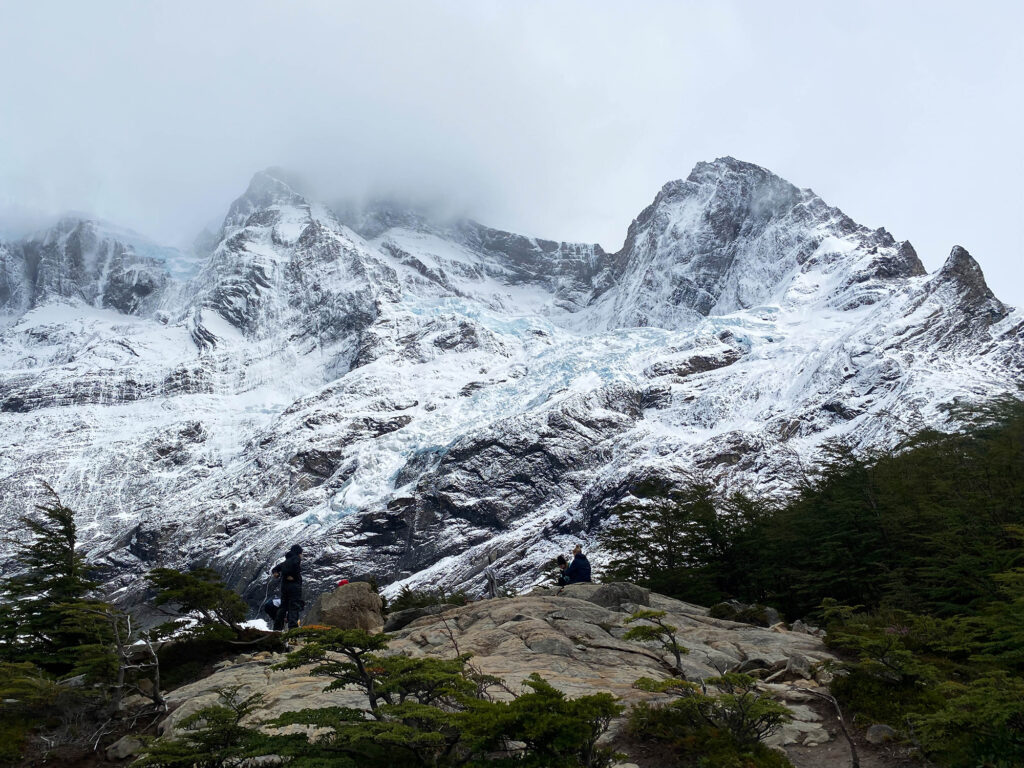
Hiking in El Chalten
While Torres del Paine is undeniably stunning, El Chalten has its own charm. It is a beloved destination for backpackers, offering unparalleled hiking opportunities amid stunning landscapes. Here are some of the best hikes in El Chalten .
Short Hike to Condor Lookout
- Time Required: 1 hour
- Distance: 2km
- Difficulty: Easy
- Start / Finish Points: El Chalten
- Highlights: Panoramic vistas and potential condor sightings
A short but sweet hike, the Condor Lookout offers unexpected views of Viedma Lake framed by snow-covered peaks. This is an excellent option for a sunrise hike, allowing you to witness the alpine glow on the mountains. The trail is gradual, making it accessible for most hikers.
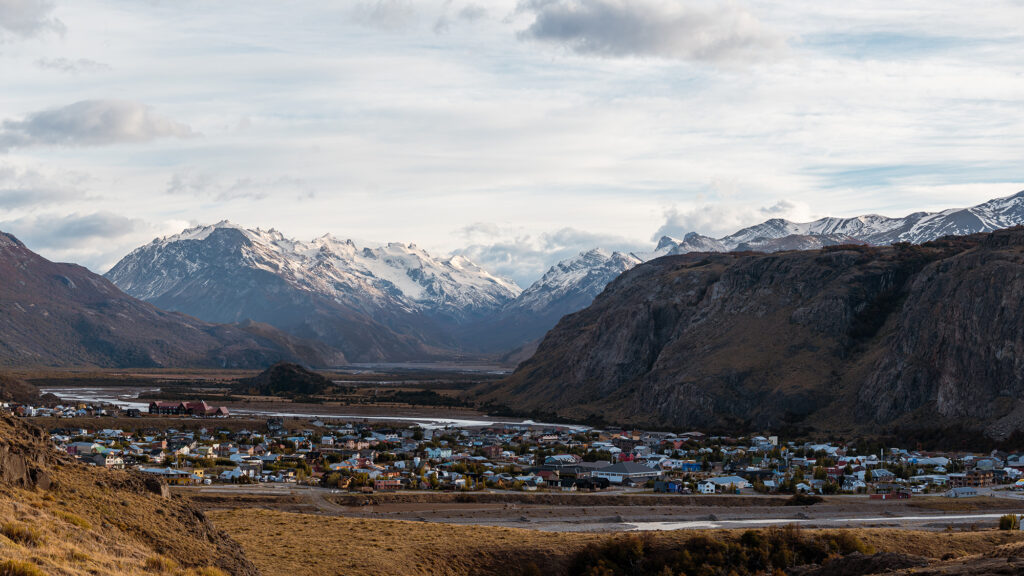
Day Hike to Laguna de Los Tres (Base Of Mt Fitz Roy)
- Time Required: 8 hours
- Distance: 26km
- Start / Finish Points: Northwest end of El Chalten
- Highlights: The incredible sight of Mt Fitz Roy mirrored in the lake
You cannot go hiking in Patagonia without visiting Mt Fitz Roy. For those seeking an up-close encounter with Mt Fitz Roy, the Laguna De Los Tres hike is a must. Starting early is advisable to catch the morning alpine glow. The trail begins gently, passing through forests, but the last hour involves a steep ascent. Your reward? The mesmerising Laguna De Los Tres with Fitz Roy towering above. If you’re up for it, consider climbing Cerro Madsen for even better views.
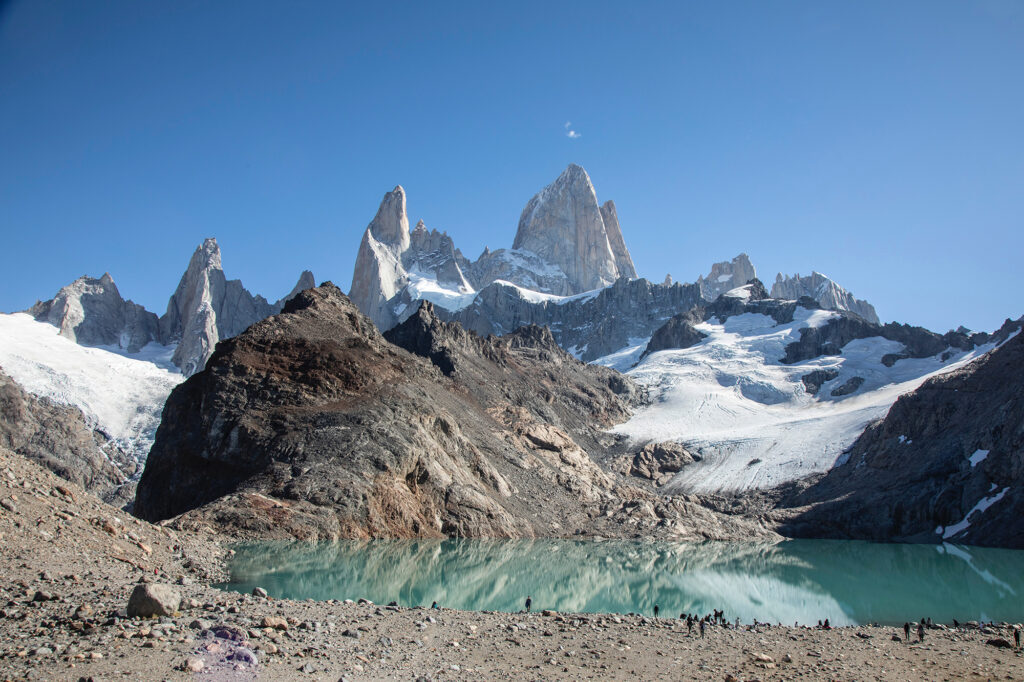
Day Hike to Laguna Suica
- Time Required: 1-2 days (can be done as a day hike)
- Distance: 19km
- Difficulty: Moderate to difficult, with some scrambling and rock climbing required
- Highlights: Scenic views of Mt Fitzroy and surrounding mountains, looming over a sparkling blue lake, with no crowds!
If you’re looking for expansive views of Mt Fitz Roy without the crowds, this is the hike for you. Instead of taking the ascent to Laguna de Los Tres, veer off the beaten path to Laguna Suica. This option offers arguably better views, and you’re likely to have the whole lake to yourself!
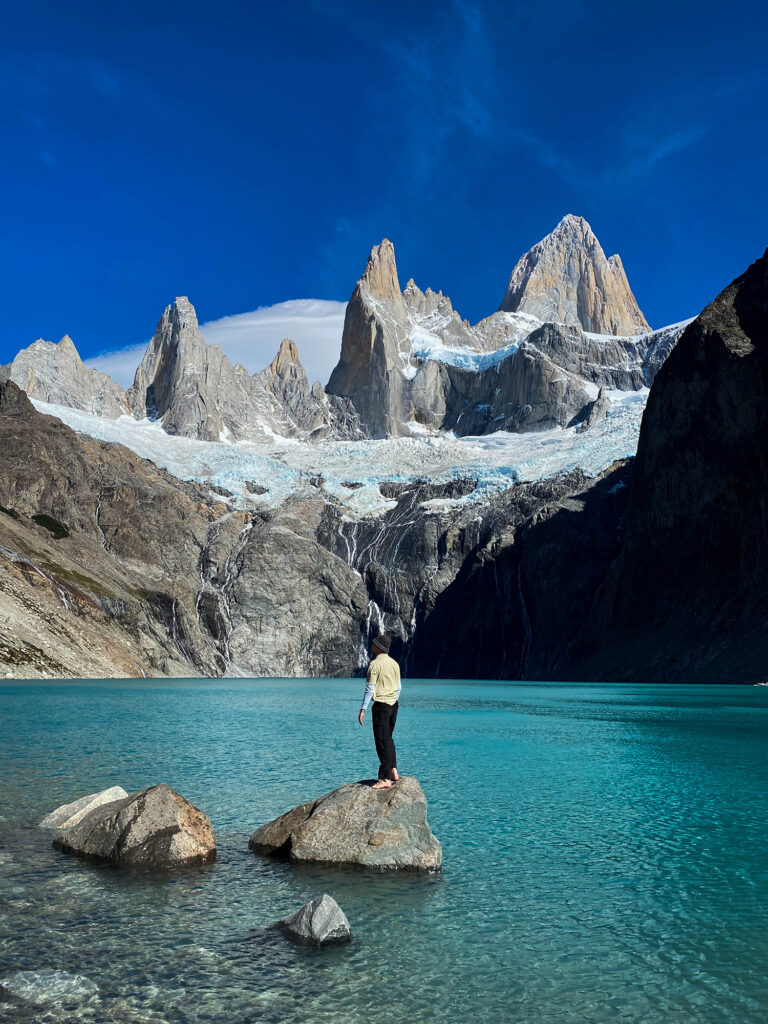
Day Hike to Cerro Torre
- Highlights: Views of Cerro Torre and its surrounding spires
Cerro Torre, reaching 3102 meters into the sky, is a sight to behold. This 2-day hike takes you through lush meadows, ever-changing glaciers, and offers stunning views of Cerro Torre and its neighboring peaks. A side trip to Mirador Maestri adds even more beauty to your journey. Return the same way you came, or camp at Campamento de Agostini for an immersive experience.
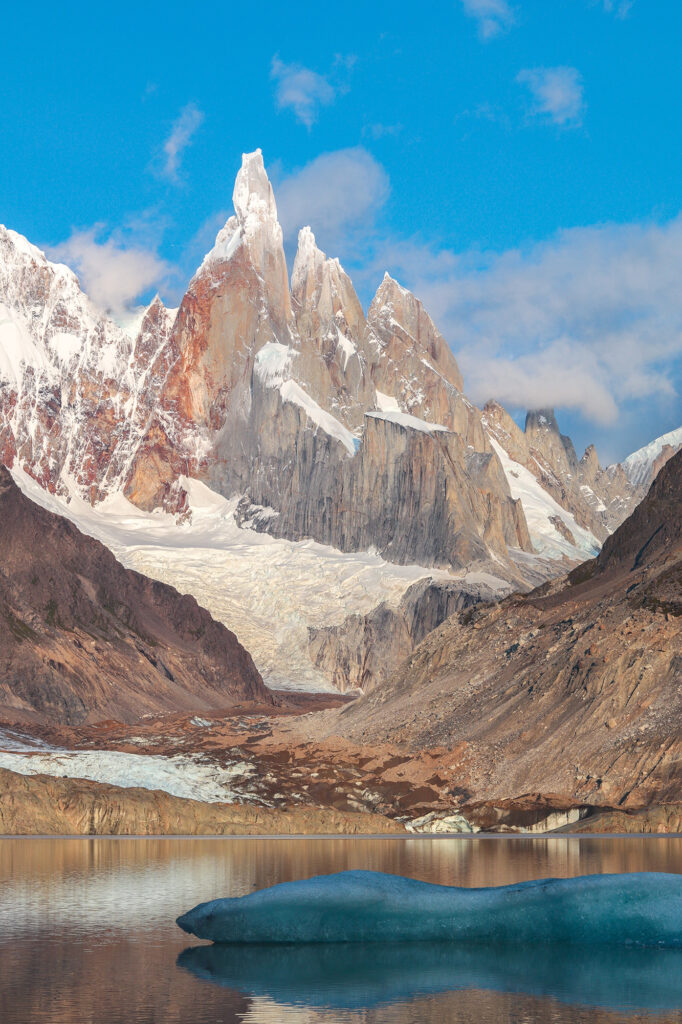
The Huemul Circuit
- Time Required: 4 days
- Distance: 63km
- Difficulty: Difficult, for advanced hikers
- Highlights: Panoramic views of Southern Patagonia, including Laguna Toro, Paso del Viento, Paso Huemul and Lake Viedma
The Huemul Circuit is not for the faint of heart, but it rewards intrepid hikers with a unique Patagonian experience. This trek takes you through breathtaking landscapes, including the majestic Mount Huemul and the Southern Patagonian Ice Field. It is known for its challenging terrain, river crossings, and rugged paths.
It’s a trek for those seeking adventure, and the relative isolation of the route ensures a sense of solitude and connection with the wilderness.
While hiking the Huemul Circuit, you may encounter a variety of wildlife, including guanacos, condors, foxes, and numerous bird species. The trek also takes you through diverse ecosystems, from lush forests to alpine meadows.
Be prepared for a difficult hike, but the views are worth every effort. Hiring a local guide is advisable for this demanding trek.
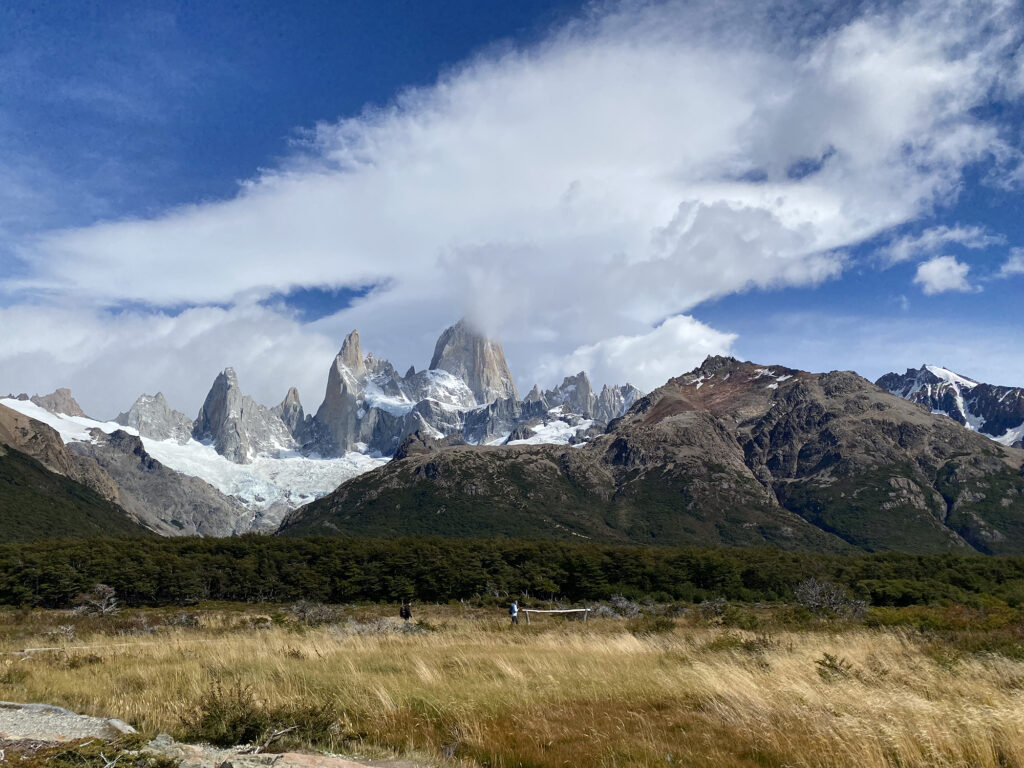
Best Hikes in Ushuaia
Located at the southernmost tip of Argentina, Ushuaia is known as ‘the end of the world’. It is the furthest of your options when hiking in Patagonia, but the views are totally worth it. Besides being a gateway to Antarctica, it offers some fantastic treks.
Laguna Esmeralda
- Distance: 9km
- Start / Finish Points: Refugio Valle Los Lobos
- Highlights: The stunning emerald-colored lake and surrounding landscapes
For a short but sweet hike, Laguna Esmeralda is a striking turquoise lake nestled amidst snow-capped peaks. This 9-kilometer trail leads to the base of Glaciar Del Albino, with an option to continue onto the glacier if you’re up for it. The refugio near the lake allows you to soak in the stunning views.
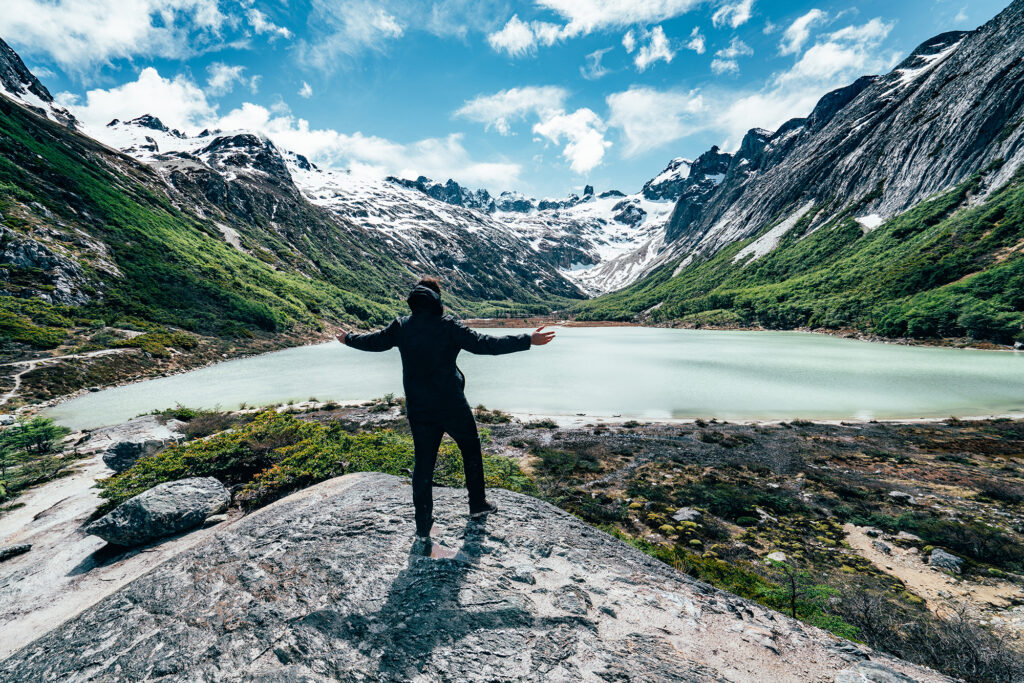
Glaciar Vinciguerra
- Time Required: 5 to 6 hours
- Distance: 13km
- Start / Finish Points: Tubera Valle Andorra
- Highlights: Close encounter with a glacier and pristine alpine scenery
The Glaciar Vinciguerra trek takes you to a series of glacial lakes with steep ascents, making it a satisfying challenge for a day hike. You’ll encounter Laguna Encatada, surrounded by lush meadows and rugged peaks. If you’re feeling adventurous, climb Cerro Esfinge for even better views.
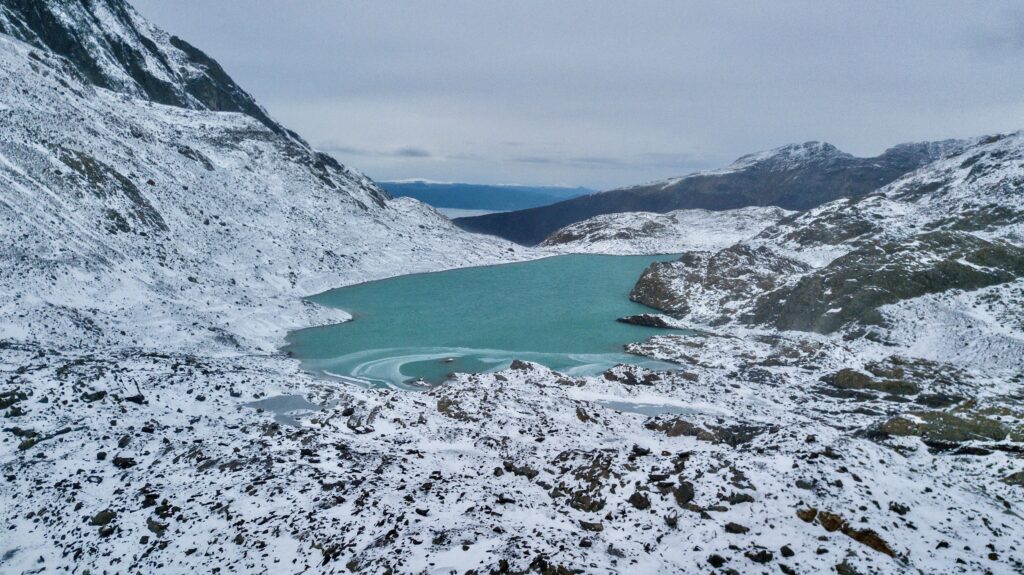
Sierra Valdivieso Circuit
- Distance: 48.5km
- Difficulty: Demanding
- Start / Finish Points: Ruta Nacional 3 or Posada del Peregrine
- Highlights: A multi-day trek encapsulating all the highlights of Ushuaia
Deep within the Fuegian Andes lies the Sierra Valdivieso Circuit, one of the most challenging treks in Argentina. This trek takes you through snowy peaks, glaciers, and crystal-clear lakes. The trail is less traveled, so good navigation skills are essential. Due to unpredictable weather, carry extra supplies.
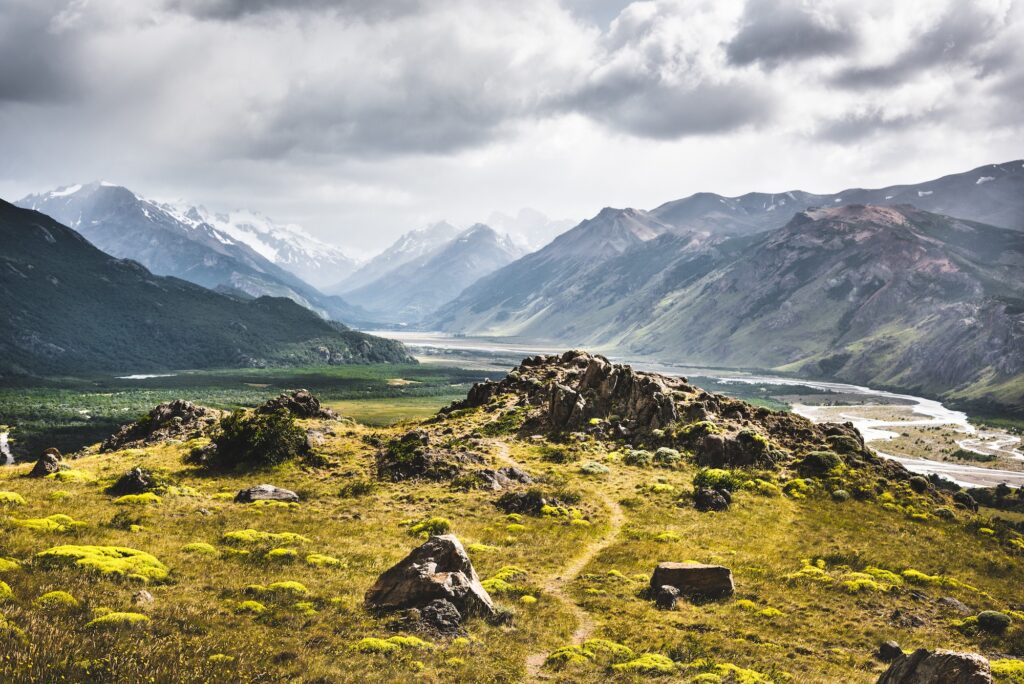
Best Hikes Along the Carretera Austral
While Patagonia’s most famous hiking destinations are often found in the well-known national parks and reserves, the Carretera Austral offers a unique opportunity to explore some of the region’s less-traveled trails. This remote highway stretches over 1,240 kilometers, running through the heart of Chilean Patagonia. Along the way, you’ll encounter a variety of off-the-beaten-path hiking experiences.
Laguna Tigre Sur
- Time Required: About 4 to 5 hours
- Distance: 8km
- Start / Finish Points: Villa O’Higgins
- Highlights: Remote and pristine landscape with the chance to spot wildlife
Located in the pristine Pumalin Park, the hike to Laguna Tigre Sur is a hidden gem. This relatively short trail takes you through lush temperate rainforests, offering glimpses of Patagonia’s diverse flora and fauna. The reward at the end is the serene Laguna Tigre Sur, a tranquil lake surrounded by ancient forests. The area’s remoteness ensures a peaceful and immersive experience.
Valle Rio Moscu
- Time Required: About 5 to 7 hours
- Highlights: Lush valleys and beautiful river views
Deep within the Aysen region, Valle Rio Moscu offers an enchanting trek through pristine wilderness. This valley is known for its stunning scenery, including dramatic waterfalls, lush forests, and crystal-clear rivers. The trail takes you along the Moscu River, surrounded by towering peaks and glaciers. Be prepared for challenging river crossings, but the breathtaking views make it all worthwhile.
Cerro Castillo
- Time Required: 3 to 5 days, depending on the route
- Distance: 62km
- Difficulty: Moderate to challenging
- Start / Finish Points: Las Horquetas Grandes to Villa Cerro Castillo
- Highlights: Stunning mountain scenery and pristine wilderness
While Cerro Castillo is often associated with its well-known reserve, you can also explore its lesser-known and equally spectacular trails. The Cerro Castillo trek takes you through lush forests, across pristine rivers, and up to high alpine meadows. The reward is the stunning view of Cerro Castillo’s jagged peaks and glaciers. This trek is a fantastic alternative for those looking to avoid the crowds while still enjoying the beauty of the region.
Pumalin Park – Cascadas Waterfalls Hike (Escondidas)
- Time Required: 1 to 2 hours
- Distance: 3.5km
- Start / Finish Points: Caleta Gonzalo
- Highlights: Remarkable nature reserve with cascading waterfalls
Pumalin Park is a true wilderness paradise, and the Cascadas Waterfalls Hike is a prime example of its natural beauty. This trail leads you through dense forests, alongside pristine rivers, and to a series of cascading waterfalls. The lush vegetation, combined with the sounds of rushing water, creates a magical atmosphere. While the hike itself is not particularly long or strenuous, it offers a peaceful escape into the heart of Patagonia.
Planning Your Hike in Patagonia
Can you hike patagonia on your own.
Choosing between independent or guided trekking depends on your experience and personal preferences. If you’re an experienced backpacker tackling a well-traveled route like the W Trek or hikes around Fitz Roy, independent hiking is entirely feasible. These trails are well-marked, and with proper planning, you can have a successful journey. However, meticulous preparation is essential, including booking campsites in advance.
For those seeking a more guided experience or exploring less-traveled routes, organized tours provide valuable support and expertise. Guided tours handle logistics, navigation, and safety measures, allowing you to focus on enjoying the scenery and adventure. Let’s explore the pros and cons of both options.
Hiking in Patagonia Independently (incl. Solo Hiking)
- Freedom: Hiking independently allows you to set your own pace and explore as you wish.
- Cost: It’s generally more budget-friendly than guided tours.
- Self-Discovery: You’ll gain valuable wilderness skills and self-sufficiency.
- Navigational Challenges: Patagonia’s trails can be challenging to navigate, and weather conditions can change rapidly.
- Safety: In remote areas, getting help in emergencies can be difficult.
- Logistics: Planning routes, permits, and accommodations can be time-consuming.
Hiring a Guide for Patagonia (incl. Group Tours)
- Expertise: Guides offer in-depth knowledge of the terrain, flora, fauna, and local culture.
- Safety: They are trained in wilderness first aid and can respond to emergencies.
- Logistical Support: Guides handle permits, accommodations, and meal planning.
- Cost: Guided tours are more expensive due to the added services.
- Less Freedom: You’ll follow a predefined itinerary.
Ultimately, the decision comes down to your experience, comfort level, and objectives. Experienced hikers with wilderness navigation skills may relish the freedom of independent trekking. However, if you’re new to Patagonia or prefer a structured experience, hiring a guide can enhance your adventure and safety.
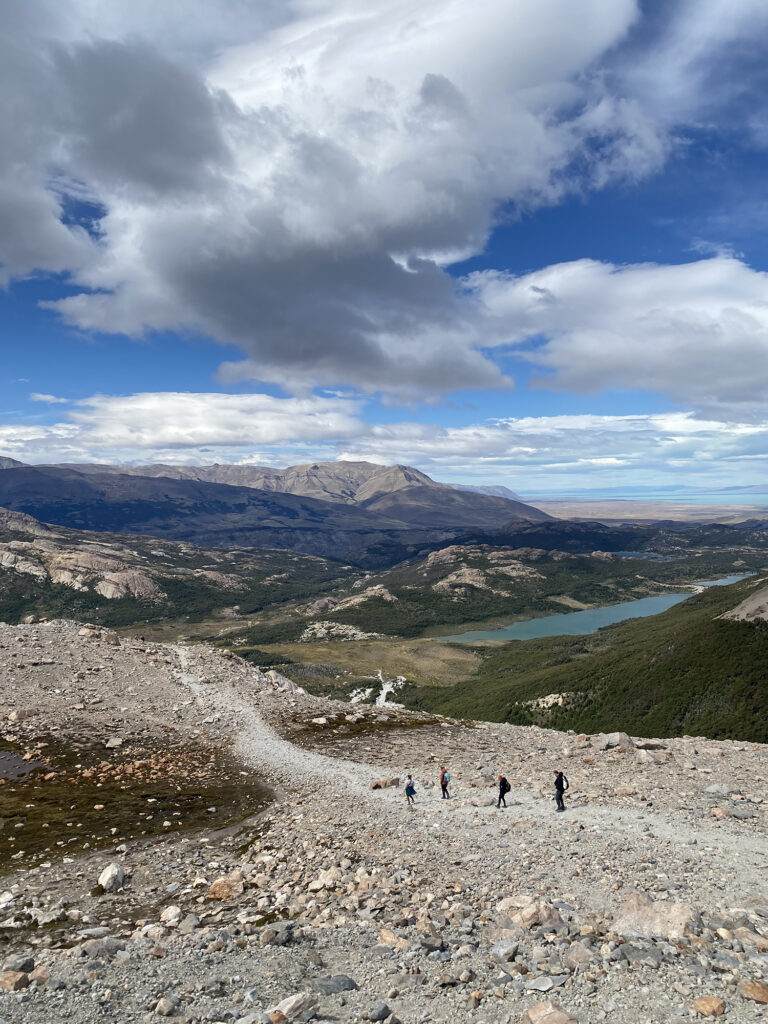
Is Hiking in Patagonia Difficult?
Patagonia’s hiking trails offer varying levels of difficulty, from relatively easy day hikes to challenging multi-day treks. The difficulty of your hike depends on factors such as trail conditions, terrain, and weather. Here’s a breakdown:
- Easy Hikes: Short, well-marked trails with minimal elevation gain, suitable for beginners and families. Examples include Laguna Esmeralda and Condor Lookout.
- Moderate Hikes: Longer day hikes or multi-day treks with moderate elevation gain and varied terrain. Trails like the W Trek and Cerro Torre fall into this category.
- Challenging Hikes: Multi-day treks with significant elevation changes, steep ascents or descents, and unpredictable weather. The O Circuit and Huemul Circuit are more challenging options.
- Technical Hikes: Some routes may involve technical climbing or glacier travel, requiring specialized skills and equipment. Seek guidance from experts for these adventures.
It’s crucial to choose hikes that match your fitness level and experience. Beginners can enjoy many fantastic trails in Patagonia with the right preparation and gear.
Can Beginners Go Hiking in Patagonia?
Yes, beginners can certainly enjoy hiking in Patagonia, but it’s essential to plan appropriately and choose suitable trails. Here are some tips for novice hikers:
- Select Easy to Moderate Trails: Start with shorter and less challenging hikes that match your fitness level. Laguna Esmeralda, Condor Lookout, and the short hikes in Torres del Paine are excellent options.
- Prepare Physically: Begin a fitness routine that includes cardiovascular and leg-strengthening exercises to build endurance for hiking.
- Acclimate: If possible, spend a day or two in a nearby town like Puerto Natales or El Calafate to acclimate to the altitude and climate.
- Gear Up: Invest in proper hiking gear, including waterproof and insulated clothing, sturdy hiking boots, and trekking poles for stability.
- Travel Light: Keep your backpack as light as possible to reduce the strain on your body.
- Plan Adequate Time: Allocate extra time for rests and adjustments to the pace, especially if you’re not accustomed to hiking.
- Stay Informed: Check trail conditions, weather forecasts, and park regulations before embarking on your hike.
- Travel with a Group: If you’re uncertain about your hiking abilities, consider joining a guided tour or traveling with experienced hikers.
Remember that safety should be a priority, and it’s better to start with easier hikes and gradually progress to more challenging trails as you gain confidence and experience.
Cost of Hiking in Patagonia
It’s important to note that Patagonia is not a budget-friendly destination compared to other South American locations. Expect higher costs for lodging, food, and various amenities. However, there are options to save money. Some factors influencing the cost of your trip include duration, accommodation preferences, and whether you hire a guide. Here’s a breakdown of potential expenses:
- Flights: International and domestic flights to Patagonia can be a significant expense, so booking in advance and searching for deals is advisable.
- Accommodation: Options range from camping (cheapest) to hostels, cabins, and luxury lodges (more expensive). Prices increase during peak seasons.
- Park Fees: Most national parks in Patagonia charge entrance fees. The costs vary, so check with each park for updated prices.
- Food: Dining out in Patagonia can be pricey, especially in remote areas. Consider bringing some of your own food for longer treks to save money.
- Gear and Equipment: Investing in quality hiking gear, clothing, and camping equipment can be expensive upfront but pays off in comfort and safety.
- Guides: Hiring a guide or joining a guided tour adds to the cost but provides expertise and logistical support.
- Transportation: Transportation within Patagonia, such as buses or boats, will contribute to your expenses.
- Miscellaneous: Budget for additional expenses like permits, travel insurance, and souvenirs.
It’s possible to go hiking in Patagonia on a tight budget by camping, preparing your own meals, and choosing less expensive accommodations. Conversely, those seeking more comfort and convenience can opt for guided tours and upscale lodging. Careful planning and budgeting will help you make the most of your Patagonian adventure within your financial means.
How Safe is Hiking in Patagonia?
Hiking in Patagonia offers incredible experiences, but it’s essential to prioritise safety due to its remote and challenging nature. Here are some safety considerations:
- Weather: Be prepared for rapidly changing weather conditions. Carry adequate clothing, rain gear, and layers to stay warm and dry.
- Navigation: Trails can be poorly marked, and getting lost is a risk. Carry maps, a compass, and a GPS device, and know how to use them.
- Wildlife: Patagonia is home to various wildlife, including pumas. Understand how to react if you encounter animals and store food securely.
- Altitude: Some hikes reach high altitudes. Acclimatize gradually and be aware of symptoms of altitude sickness.
- Water: Water sources can be contaminated. Use water treatment methods to ensure safe drinking water.
- Emergency Contact: Inform someone of your itinerary and expected return time. Cell phone coverage can be limited.
- Health: Ensure you have any necessary medications and a basic first aid kit. Be prepared for minor injuries and know basic first aid.
- Group Travel: Traveling with others or hiring a guide can enhance safety, especially for beginners.
- Local Advice: Seek advice from local rangers and experts who can provide up-to-date information on trail conditions and safety concerns.
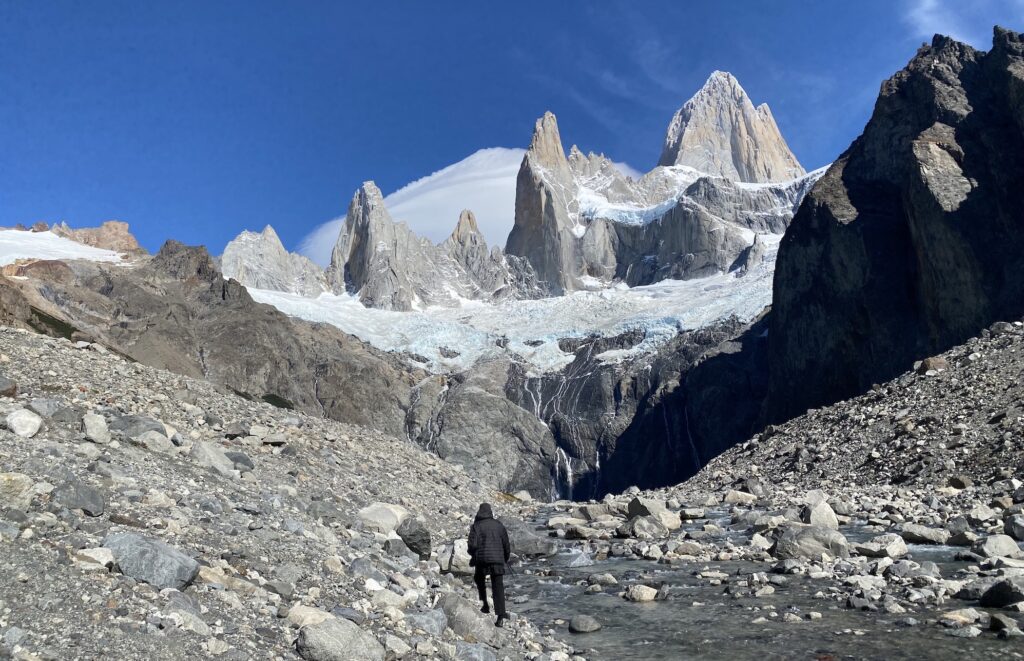
Hiking in Patagonia Packing List
Before you embark on your Patagonian adventure, it’s essential to have the right gear and supplies to ensure a safe and enjoyable journey. Here’s a comprehensive packing list to help you prepare for trekking in Patagonia:
- Moisture-wicking base layers (top and bottom)
- Insulating mid-layers (fleece or down jacket)
- Waterproof and windproof outer layer (jacket and pants)
- Quick-drying hiking pants
- Sturdy and comfortable hiking boots
- Warm gloves
- Wool hat or beanie
- Moisture-wicking socks and sock liners
- Gaiters (for keeping debris out of your boots)
- Sun hat and sunglasses
- Bandana or buff (for sun protection)
- Swimsuit (for swimming in thermal pools or lakes)
Backpacking Gear
- Hiking backpack with rain cover (40-70 liters, depending on your trip)
- Tent or lightweight shelter (if camping)
- Sleeping bag suitable for cold weather
- Sleeping pad or mattress
- Cooking stov e and cookware (if camping)
- Lightweight utensils, cup, and bowl
- Headlam p or flashlight with extra batteries
- Multi-tool or camping knife
- Lighter or waterproof matches
- Trekking poles (optional but recommended)
- Dry bags or stuff sacks (for organising gear)
- Navigation tools (maps, compass, GPS)
Personal Items
- Passport and any necessary visas
- Travel insurance information
- Cash in local currency (ATMs may be scarce)
- First-aid kit with essential medications
- Toiletries (toothbrush, toothpaste, soap, etc.)
- Microfiber towel
- Insect repellent
- Sunscreen and lip balm with SPF
- Personal identification (ID or driver’s license)
- Camera and accessories
- Charging cables and portable power bank
Food and Water
- High-energy snacks (nuts, energy bars, dried fruit, etc.)
- Dehydrated or freeze-dried meals (if camping)
- Reusable water bottle or hydration reservoir (3+ liters)
- Water purification filter or water purification tablets
Miscellaneous
- Travel itinerary and emergency contact information
- Travel adapters and chargers
- Travel-sized sewing kit
- Ziplock bags (for organizing and waterproofing)
- Trash bags (for packing out waste)
- Local guidebooks or trail maps
- Notepad and pen
- Entertainment (book, playing cards, etc.)
- Solar charger for electronics
- Binoculars for wildlife viewing
- Travel pillow
- Camp shoes (lightweight sandals or camp slippers)
- Down booties for keeping feet warm in camp
Leave No Trace Principles
When hiking in Patagonia, it’s crucial to adhere to Leave No Trace principles to minimize your impact on the environment. These principles include:
- Plan ahead and prepare: Research your route, obtain necessary permits, and pack appropriately to minimize waste and resource use.
- Travel and camp on durable surfaces: Stick to established trails and campsites to prevent soil erosion and damage to fragile ecosystems.
- Dispose of waste properly: Pack out all trash and waste, including biodegradable items like food scraps and toilet paper.
- Leave what you find: Preserve the natural environment by not picking plants, disturbing wildlife, or removing rocks and historical or cultural artifacts.
- Minimize campfire impact: Use a camp stove for cooking instead of making fires, as fires can scar the landscape and deplete limited wood resources.
- Respect wildlife: Observe animals from a distance, avoid feeding them, and keep a safe distance to prevent stress and harm.
- Be considerate of other visitors: Keep noise levels down, yield the trail to others, and maintain a friendly and respectful attitude towards fellow hikers.
By following these principles, you can help protect the fragile ecosystems of Patagonia and ensure that this pristine wilderness remains a natural wonder for generations to come.
Hiking in Patagonia is a journey into the heart of one of Earth’s most awe-inspiring landscapes. From the towering peaks of Torres del Paine to the hidden treasures of the Carretera Austral, this region offers a diverse range of trails for adventurers of all levels. Whether you choose to hike independently or join a guided tour, careful preparation, respect for the environment, and a sense of wonder are essential companions on your Patagonian trek.
As you embark on your adventure, take the time to savour the beauty of Patagonia, listen to the whispers of the wind, and marvel at the sheer majesty of nature. In this remote corner of the world, you’ll discover not only breathtaking landscapes but also a profound connection to the wild and untamed spirit of Patagonia. So lace up your boots, shoulder your pack, and set out to explore this magnificent land – Patagonia awaits your footprints, and the adventure of a lifetime awaits your spirit.
Hiking in Patagonia offers a range of difficulty levels. Some trails are suitable for beginners with minimal elevation gain, while others are more challenging, requiring experience and endurance. Choose trails that match your fitness level and goals.
Yes, beginners can hike in Patagonia. Many trails are beginner-friendly, such as short day hikes and well-marked paths. However, it’s essential to prepare physically, choose appropriate trails, and be equipped with proper gear for varying weather conditions.
The duration of your hike in Patagonia varies greatly depending on the trail and your itinerary. You can enjoy short day hikes or embark on multi-day treks that last from a few days to several weeks. It’s flexible and depends on your preferences.
Yes, you can hike in Patagonia independently. Many trails are well-marked, and with proper preparation, navigation tools, and safety precautions, solo hiking is possible. However, some remote and technical routes may require guides or group travel.
Hiking in Patagonia can be safe if you prioritize safety precautions. Weather conditions can change rapidly, and wildlife is present. With proper gear, navigation tools, and knowledge, you can minimize risks. Traveling with others or hiring guides can enhance safety, especially for beginners.
The cost of hiking in Patagonia varies depending on factors like accommodation, transportation, gear, and whether you choose guided tours. Budget-conscious travelers can camp and cook their meals to save money, while those seeking more comfort might spend more on lodging and services.
The best time to visit Patagonia depends on your interests. For milder weather and more accessible trails, consider the spring and summer months from November to March. However, each season offers unique experiences, so plan based on your preferences.
Both Chilean and Argentine Patagonia both offer breathtaking landscapes and hiking opportunities. Argentina offers similar views at a much lower budget: you can even camp for free. Chile has more developed infrastructure, which comes with bigger crowds and higher cost. But it is also arguably (ever so slightly) more beautiful than Argentina. Your choice may depend on specific destinations, visa requirements, or the type of experiences you seek.
Determining the most beautiful part of Patagonia is subjective, as it offers diverse landscapes. Torres del Paine National Park in Chile and Los Glaciares National Park in Argentina are often considered among the most stunning areas. Each region has its own unique charm.
Patagonia is rich in wildlife, including guanacos, foxes, condors, red-headed woodpeckers, and if you’re fortunate, elusive creatures like pumas, huemuls, or pygmy owls. The marine life is abundant, with whales, seals, and penguins along the coast. Patagonia’s biodiversity is a highlight for nature enthusiasts.

Lucas is a travel writer with deep experience exploring South America. He enjoys hiking through mountain ranges, cycling across deserts and paddling down rivers.
Best Food in Puerto Natales: 17 Top Restaurants & Cafes
Get our best tips direct to your inbox.

- Best Hikes In The World
- Appalachian Trail
- European Hikes
- Nepal Hikes
- Patagonia Hikes
- See All Hikes
- Mount Kenya
- Mount Kilimanjaro
- Mount Toubkal
- See All Mountains
- South Africa
- New Zealand
- Switzerland
- United Kingdom
- Packing Lists
Trekking In Patagonia- Essential Info For Hiking Patagonia
Argentina , Chile , Hikes , Patagonia , South & Central America
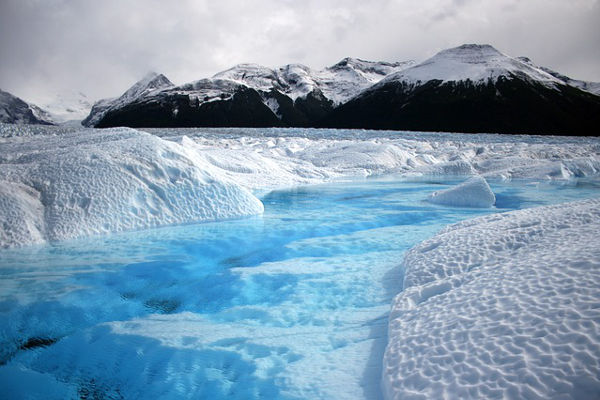
Patagonia is an incredibly varied trekking destination. This is a true natural wonderland where condors soar and volcanos smoke. Patagonia hiking trails offer, in my opinion, some of the best treks in South America !
In 2022 I was lucky enough to spend a few months in Patagonia hiking and exploring.
Below I've provided an overview of useful information that will help you choose and plan your Patagonia hike. Where appropriate, you will find links to in-depth guidance articles on popular hikes like the Fitz Roy , W trek and O Circuit .
But before I jump in, let's briefly look at why I love Patagonia.
Why Go Hiking In Patagonia?
Patagonia is one of the leading trekking destinations in the world, and it’s easy to see why! If you need any further motivation, read on. These are a few reasons why travelers rate Patagonia trekking so highly.
Patagonia Hiking Landscapes
Lying on South America’s southern frontier and covering some 400,000 square miles, Patagonia is a wild landscape that is both barren and beautiful.
If you chose to trek in Patagonia, you will find wide open spaces, places with beautiful mountains , towering granite spires, and pristine rivers.
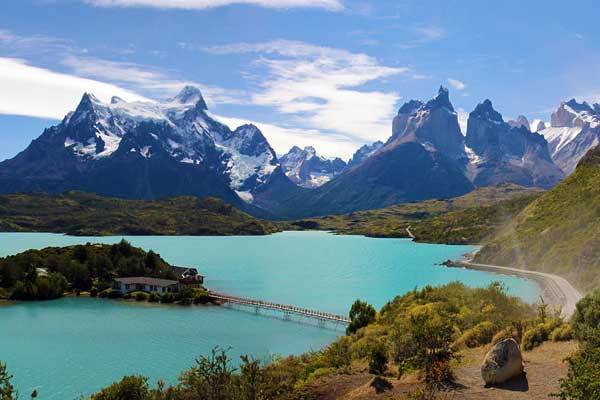
Patagonia is without a doubt a land of extremes. In the west, the land is home to some of the most beautiful temperate rainforests on the planet whilst the east experiences some of the most ferocious winds in the Americas. Patagonia is also home – quite surprisingly – to the world’s seventh-largest desert.
Patagonia Wildlife
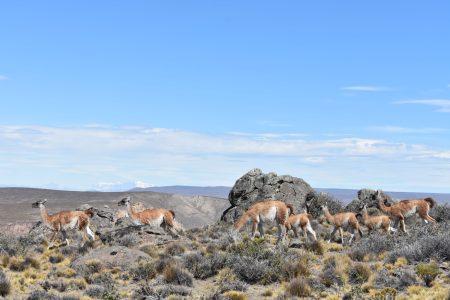
Guanacos in Patagonia National Park
Nature enthusiasts are no doubt wondering what animals you will see along the trails of Patagonia. The answer is a lot.
No matter where you hike in Patagonia, you are sure to see an abundance of birdlife. Look out for different woodpecker species in the forests and an abundance of waterbirds around the rivers and Lagunas. Massive condors are often spotted soaring above the desert.
The seemingly barren lands alongside the roads of southern Argentina are home to a surprising array of creatures. You can’t miss the thousands of shaggy guanacos. If you pay attention, you will probably also spot some foxes and even skunks.
I lucked out on my Patagonia backpacking trip. Not only did I get to see a Huemel (an endangered Chilean deer), but also had a face-to-face encounter with a Puma!
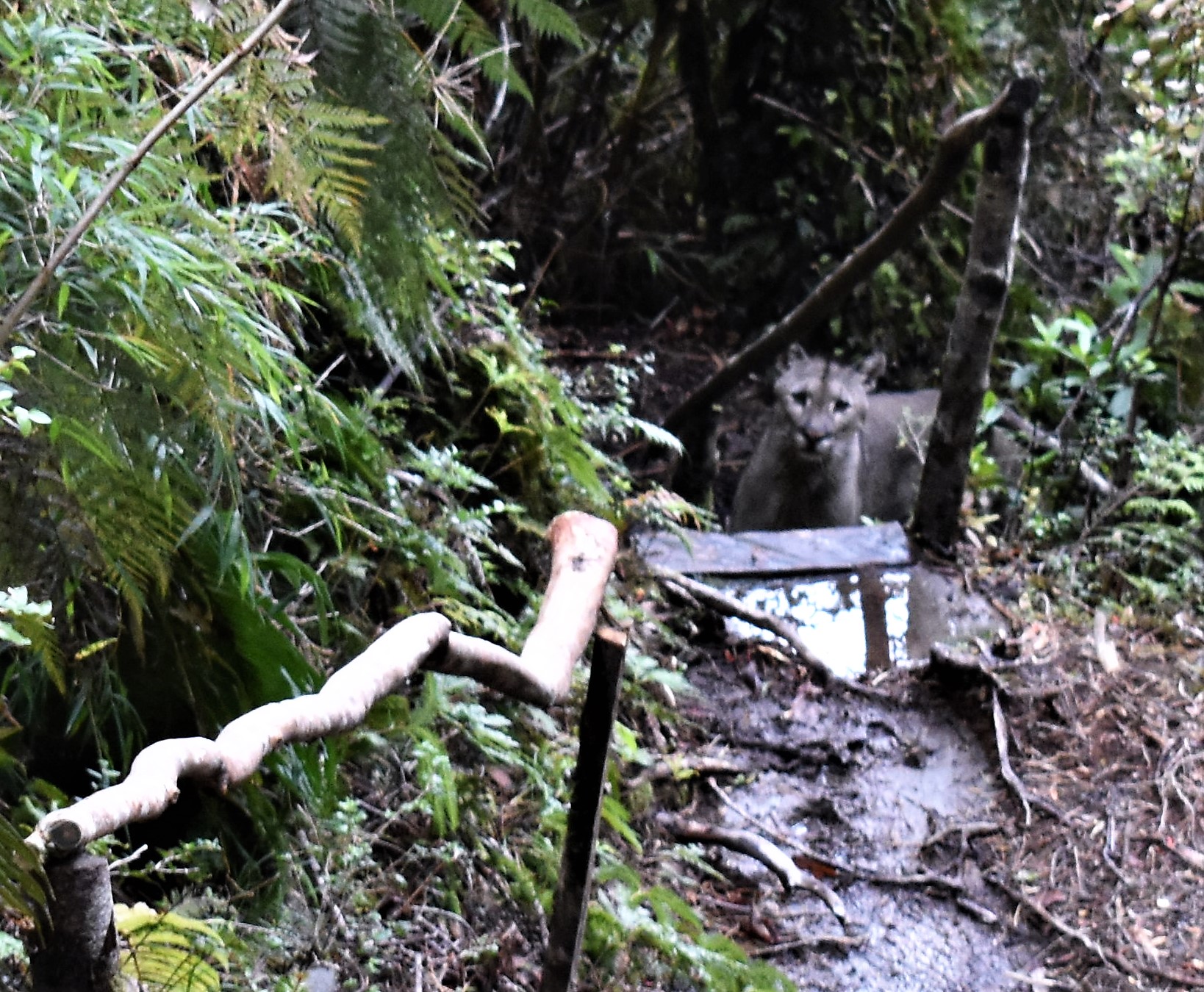
I managed to take a -not very good- pic of the curious cat
You can increase your chances of animal sightings by getting out early and always paying attention to your surroundings. However, luck plays a big role!
Patagonia Hiking Trails Are Easy To Follow
Almost all major treks in Patagonia are on well-worn trails. There is very little chance of getting lost. Even the lesser-known routes had some of the clearest markings I’ve seen anywhere.
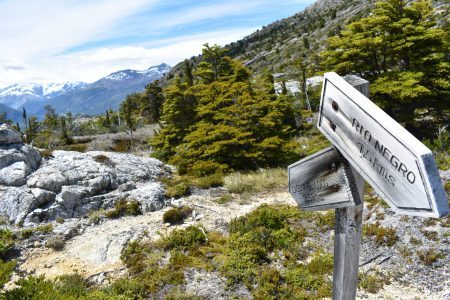
A trail marker along one of Chile's many hiking routes
Ranger huts are dotted along the bigger trails. The park authorities put a lot of effort into keeping the trails clear and taking care of the infrastructure. This is why you shouldn’t complain about paying the entrance fee required for most reserves.
Popular Hiking Routes in Patagonia
Being such a wild and beautiful landscape, Patagonia is packed with literally hundreds of trekking routes. There are hundreds of options for day hikes and multi-day treks.
The three most popular trekking routes in Patagonia are the Torres Del Paine Full Circuit Trek, the Torres W Trek, and the Fitz Roy Trek. All three treks offer something very different in terms of landscapes and difficulty.
Below is a brief description of each route.
Torres Del Paine Full Circuit Trek
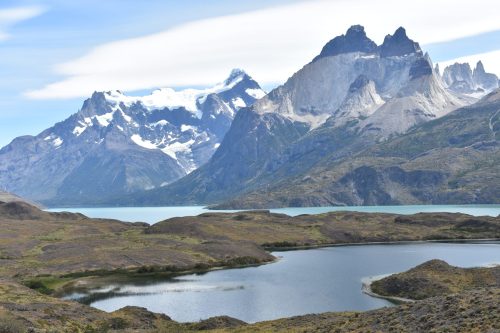
Torres Del Paine National Park
One of the greatest and undiscovered treks on earth, the Torres Del Paine Full Circuit is a brilliant mix of stunning landscapes and unrivalled panoramic views.
The trail is 130km long and trekkers generally take 7 to 9 days to complete it, although often more experienced trekkers do it in less than 5 days!
Torres del Paine National Park was designated a World Biosphere Reserve by UNESCO in 1978 and is home to some of the most diverse flora and fauna in South America.
The Full Circuit leads trekkers on the standard W Trek before continuing around the back end of the park to Refugio Dickson. Hikers then climb up and over John Gardner Pass before descending back down to Campamento Grey.
See my complete guide to the Torres del Paine O trek.
Torres Del Paine W Trek
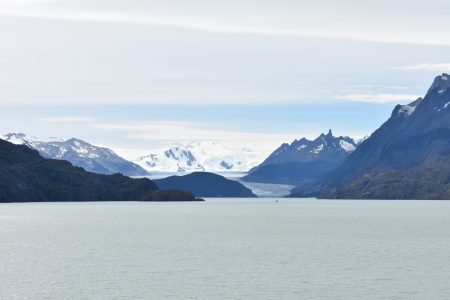
Grey Lake with Grey Glacier in the background, the start of the W Trek
Probably the most popular trek in Patagonia, the Torres Del Paine W Trek is fast becoming one of the most well-respected short hikes in the world due to the trail’s incredible scenery.
The trek generally takes in the region of 5 days to complete (depending on fitness) and leads visitors into the very heart of the national park through vibrant forests, soaring granite peaks, and colossal glaciers.
The trail is 100km long and begins with an excellent boat ride near the Grey Glacier and finishes with a beautiful sunrise at the famous Torres on the last morning.
Fitz Roy Trek
One of the most well-known mountains in South America , Mount Fitz Roy has been an emblem of Patagonia for many years.
At 3,375m, the jagged granite spines as you enter the small village of El Chaltén. Also known as Cerro Chaltén, Mount Fitz Roy is located on the border between Argentina and Chile on the Southern Patagonian Ice Field.
The Fitz Roy hike is generally around 30km in length and takes 3-4 days to complete depending on how much walking you wish to do each day.
Best Short Hikes in Patagonia
Although Patagonia is home to some incredible multi-day hikes, there are actually countless shorter hikes available for visitors with a little less time on their hands.
Day hikes to Mount Fitz Roy are extremely popular as you can get the classic peak photo to take home!
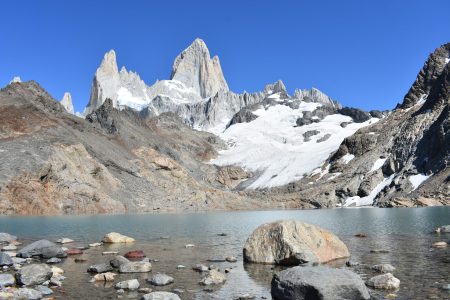
Mount Fitzroy view from Laguna Los Tres. One of Patagonia's most famous sights!
There are also some fantastic short hikes if you want to visit a glacier, such as the Cerro Castillo Glacier walk and the El Morado Glacier Trek.
See our guide to Patagonia day hikes .
Planning Your Patagonia Trek
Here are some of the key considerations when hiking Patagonia.
Chilean Patagonia Vs Argentinian Patagonia
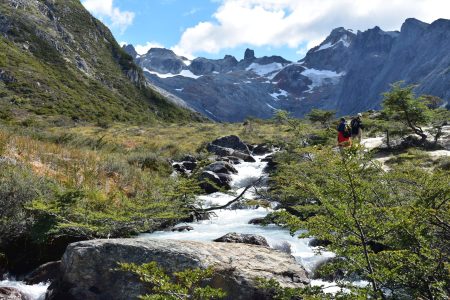
A short and popular trail to Laguna Esmeralda outside Ushuaia
Patagonia overlaps the border into the southernmost parts of Chile and Argentina. Despite being close to each other, the two sides are pretty distinct. Luckily, it is easy to cross the border and spend time in both countries. Patagonia Argentina is the more popular region for tourists. As a result, the trails get very busy over peak season (November-March). Between mountains, the landscape is surprisingly flat, dry, and rocky. Route 40 is a popular road for motorcyclists. Argentina is home to some of the most famous places for hiking in Patagonia. These include El Chalten (Fitz Roy) and Ushuaia. By contrast, Chilean Patagonia is much greener and more mountainous. The Caraterra Austral is the only main road through this region. It runs from Puerto Montt and ends in O’ Higgens. Along this route, you will find gushing waterfalls, fjords, thriving forests, and even volcanos. To be honest, I fell in love with the Chilean side of Patagonia. The trails are uncrowded and there are a ton of hidden gems to discover. The Caraterra Austral is probably also the safest and easiest road in the world for hitchhiking. This is a great way to meet people and practice your Spanish.
Torres Del Paine, probably the most famous Patagonian park, is on the Chilean side.
Do I Need To Book In Advance When Hiking In Patagonia?
The more popular routes often limit the number of trekkers and you’ll need to book early to avoid disappointment. Campsites also book up early and you’ll often need to prove you have a booking to obtain a permit – this is only necessary on certain treks, particularly in the Torres Del Paine region.
A good rule of thumb is to always assume you will need an advance booking. For small reserves, you can get these on the same day but often need to reserve online.
Where To Sleep When Hiking In Patagonia
If you have booked a multi-day trek in Patagonia, chances are your only accommodation options are in tents. Campsites along famous routes like the W and O Treks in Torres Del Paine need to be booked well in advance online.
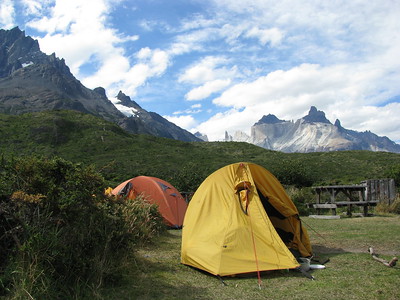
Camping is the cheapest form of accommodation in Patagonia - photo credit: Inacio Gueberoff
If you are on a tight budget, camping is the most affordable option to stay in towns close to the trails. Most official campsites cost around $10 a night and include bathrooms.
Some campsites have a small kitchen. However, I would recommend traveling with your own camp cooking equipment .
You can find a fair amount of free campsites throughout the region. If you download Maps Me app , you will see these free sites are marked. This is generally a great app to have while backpacking Patagonia. It shows many of the trails, even those which are not marked well.
Hostels, Hospedajes and Refugios
Hostels are always a great option for budget travelers. Most towns have some sort of hostel accommodation where you can spend the night before or after a hike. On hikes in Patagonia, you will be able to find refugios. These small, locally run accommodations are particularly common on the Argentina side. As well as being warmer and more comfortable than a tent, Refugio owners usually cook delicious local meals. This ‘luxury’ comes with a much higher price tag than a hostel. I’d recommend staying in a nice refugio at least once for the experience. If you are visiting Chilean Patagonia, you are bound to see hospedajes. Hostels are not so common in these parts. Hospedajes offer small and simple private rooms with access to a kitchen and bathroom. You can also usually buy meals at an extra cost. Chilean hospedajes were some of my favorite places to stay on my travels. The owners are welcoming and there is always a wood stove burning! These help a lot if you need to dry your soaked hiking gear.
When is the Best Time to Trek In Patagonia?
The brilliant thing about trekking in Patagonia is that all of the treks never reach high altitudes, therefore the region is made accessible all year round.
To give you a sense of the seasons, we have written an overview of each below. See more detailed information on the best time to hike Patagonia .
Spring - September to November
If you want warm, clear weather but without crowds, this is the perfect time of year to visit the park.
Although it’s certainly not as warm as the high summer months, the skies during Spring are still clear and you’ll get incredible views across the wild landscapes.
Spring is also the best season to see flowering flora in the region as well as wildlife breeding season.
Summer - December to March
This is the high season for both temperatures and tourists. The trails are at their capacity during this period and the parks often feel quite busy.
However, the trade-off is fantastic weather to travel in. The summer months are also the time in which alternative activities such as horse riding, mountain biking, and kayaking are possible. Probably the best period for the active type or for inexperienced trekkers.
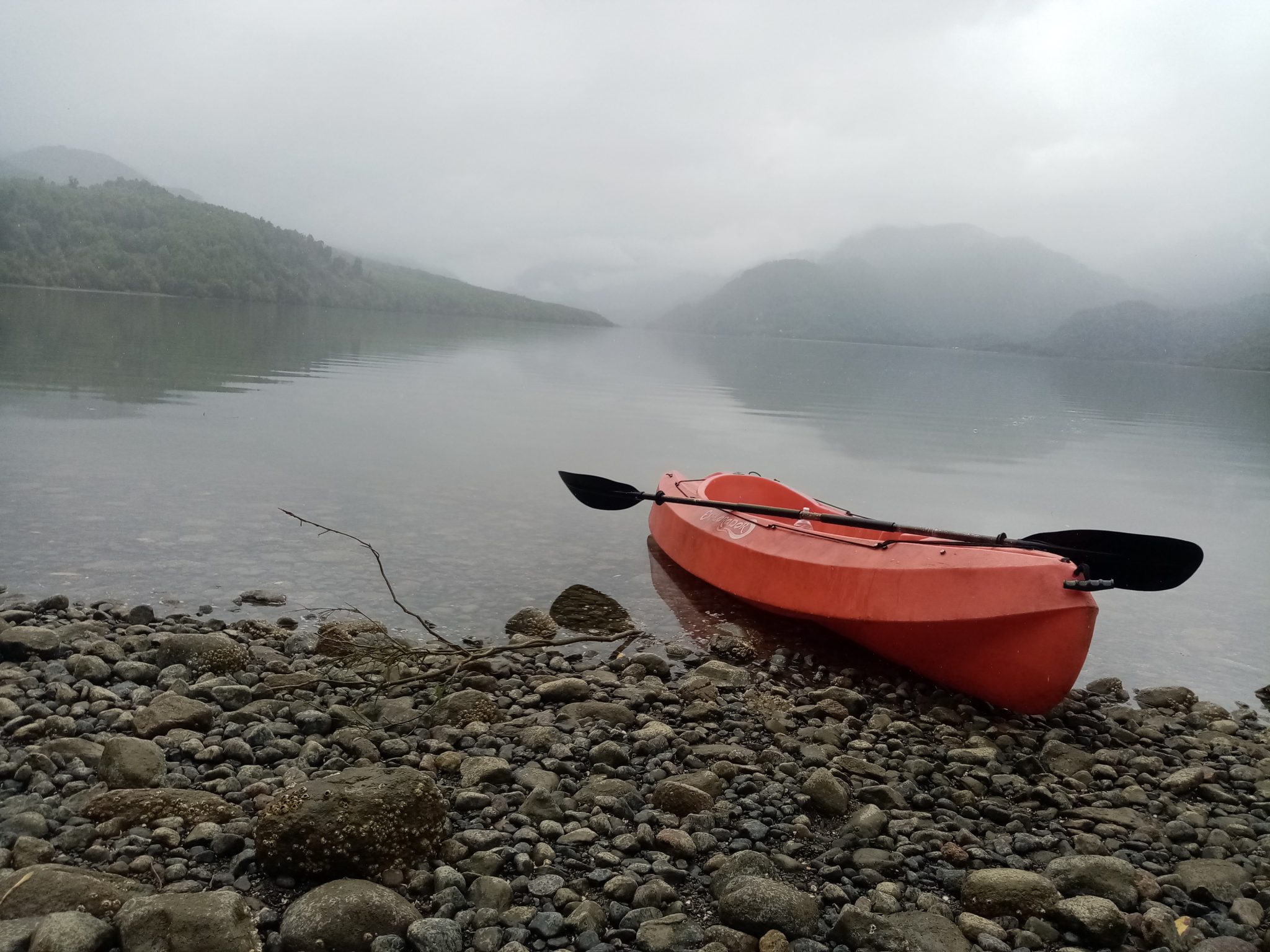
You can rent kayaks or book kayaking tours in some places in Patagonia - This was on a misty morning kayaking the fjord in Puyuhuapi, Chile
Fall - March to June
Probably my favourite season. The landscape simply comes alive with blazing colours as the trees and grasses begin their journey into winter.
The trails also begin to empty out during the Fall and the clear landscape views are still common. Be wary though, ferocious winds are frequent during this period and you’ll need to bring the appropriate gear.
Winter - June to August
Although the majority of refugios are closed during this period, this season is certainly the quietest and you’ll often have the trails to yourself.
This is also the coldest period with strong winds, frequent storms, and wintery nights. Most suitable for hardy trekkers who are looking for a quiet experience in the wilds of Patagonia.
Packing List: What Gear Do I need to Trek in Patagonia?
The trekking gear you choose to take with you to Patagonia will very much depend on what route you intend to take and what season you intend to trek in.
To help you prepare we have provided a comprehensive multi-day trek packing list .
The packing list provided includes a number of essential trekking items. The gear we recommend has been tried and tested by countless trekkers and will serve you well on any multi-day trekking experience.
If you plan to trek in Patagonia independently then you’ll need to keep your backpack weight down. Many of these items such as sleeping bags, tents, trekking poles, etc. can be rented at park entrances across Patagonia. However, I strongly recommend bringing the the important pieces of kit
What Does Patagonia Trek Cost? What Permits Do I Need?
Tourists entering Chile and Argentina from America and the UK do NOT need a visa if the intended trip is under 90 days. If you plan to stay longer than three months then you will need to consult with your local embassy as to the policies regarding this.
Honestly, the easiest thing to do is make a quick border crossing to the other country and return for a renewed 90 days. The authorities are well aware that tourists do this and are not too bothered. However, things change quickly in these parts so best to double-check. Depending on where you plan to trek, a trekking or park permit may be needed. For instance, trekkers looking to hike in Torres Del Paine National Park are required to have a permit which needs to be booked and paid for online. You will also need to produce proof of campsite bookings. If trekking with an operator this should all be taken care of by them prior to your trip – always check though. For the Fitz Roy trekking region there is no permit required.
Recommended Patgonia Guidebook
The Lonely Planet Trekking in the Patagonian Andes (Travel Guide) is one of the most detailed, yet an easy-to-digest guide to the Patagonian Andes. It has most of the treks and routes in it.
About the author
Alison Macallister
With a degree in Nature Conservation and experience working with wildlife including the Big 5, Alison used to work as a guide for a 5-star safari reserve in South Africa. Today she is a full time traveller and editor for Mountain IQ. She has travelled and hiked extensively in South America, including many solo hikes in Patagonia, the Cusco region of Peru, Ecuador and Chile.
Leave a Reply
Your email address will not be published. Required fields are marked
simple and clear blog and the easiest I found yet after searching blogs and sites for nearly a month I am an experienced solo traveller with flexibility approach so the blog is perfect for me
Hi Ghada, glad that you have found this useful!
We work with local guides to offer great value adventures at unbeatable prices
- Privacy Policy
- Puerto Rico
- Travel Guides
Hiking the W Trek in Patagonia Self-Guided: The Complete Details

When you think of Patagonia, it’s hard not to imagine the picture of its most famous pristine peaks. Many avid hikers and outdoor enthusiasts dream of one day visiting Chile and Argentina to explore the Patagonia region. One of the most famous hikes in Patagonia is the W Trek.
This is the smaller version of the O-trek, but even though it’s shorter, it still offers the adventure of a lifetime. These hikes are located in the Torres del Paine National Park in Chile.
My dream finally came true in December 2024 when I visited Patagonia for the first time. There were beautiful landscapes everywhere, and I couldn’t stop staring at them.
In this guide, I’ll go over everything you need to know (and there’s a lot) about hiking the W Trek in Patagonia self-guided.

Table of Contents
What is the W Trek in Patagonia and Why You Should Hike it
What makes this hike unique is how well the trails are maintained, the excellent refugios, the people, and, of course, the views.
When traveling throughout Patagonia, it’s funny and cool to notice the same people repeatedly. Most people stick to a very similar itinerary.
There are options for individuals who want to camp and have gear, don’t have gear, or want to go all out and sleep in beds.
Where is the W Trek in Patagonia?
The W Trek is a four- to five-day hike in Torres del Paine National Park. Patagonia is located in Chile and Argentina , offering something different.
Most people who plan to visit Torres del Paine National Park stay in Puerto Natales . This town is easily accessible by bus if you’re coming from Calafate, where the famous Minitrekking on Perito Moreno Glacier is done.
We stopped by here shortly on our way south, where we decided to see Penguins in Punta Arenas before returning for the trek!

How to Get to Torres del Paines National Park
Getting to Torres del Paines National Park is relatively easy. We were one group of the many individuals who got to this park to do the W Trek alone, self-guided.
What does this mean? It means there’s a lot of bus options. I liked using Busbud to find bus times while traveling in Chile and Argentina.
This website didn’t have all the buses possible for every town, but it gave me a good idea of the times.
Bus From Puerto Natales to Torres del Paine National Park
Depending on your path, either East to West or West to East, will determine which bus ticket you need to buy.
No matter what, you’ll stop and get off the bus at Laguna Amarga . This is the Entrance to the park and you’ll have to show your entrance ticket. More on that later.
After finding the bus ticket on Busbud, I always visit the bus company’s website. In this case, it’s Bus Sur .
If you’re starting from West to East like us, you’ll first need a bus ticket from Puerto Natales to Puedeto . When we got to the entrance, we showed our tickets, grabbed our bags, and switched buses.
Our bus driver took a break before taking us another 25 minutes up the road to the Pudeto dock. Keep asking the drivers as everyone seemed confused about what was happening.
If you’re going from East to West, the first ticket you’ll need is one to Laguna Amarga . To find these tickets, go to Bus Sur’s website and type in the destination of Torres del Paine.
In the description will be either Laguna Amarga or Pudeto. You’ll need one of each, but you will determine which you need first and last, depending on where you start.
A side note : YOU MUST PRINT OR SCREENSHOT YOUR TICKETS
Wi-fi is scarce or non-existent inside the park.
Bus Schedule
This might be confusing at first but it’ll all become clear soon. I suggest starting a notes page on your phone with your itinerary and all the needed documents in there.
Below is the bus schedule for Torres del Paine National Park in Patagonia.
Puerto Natales to Laguna Amarga & Pudeto
Current Prices (one-way): ~12,000 Chilean Pesos
Laguna Amarga to Puerto Natales
Pudeto to puerto natales.
I get it if you don’t want to take a bus and would rather drive yourself! I suggest renting a car outside of Puerto Natales as the prices will be more expensive there.
I’m unsure about driving inside the park and to which miradors are possible, but there’s a parking lot behind the Welcome Center. This is next to Refugio Torre Norte.

Things to Know When Planning the W Trek in Patagonia
The W Trek in Patagonia is a long hike and Torres del Paine doesn’t make the information easy to find.
Below will be a plethora of extra details you need to complete the self-guided hike of the W Trek!
Overview: My Itinerary (West to East)
- Take the bus from Puerto Natales to the Park Entrance (Laguna Amarga)
- Switch buses to go to Puedeto
- Take the ferry to Paine Grande ($25,000)
- Hike to Grey (11km) and hike back to Paine Grande (11km)
- Hike from Paine Grande to Mirador Britanico (13km)
- From Mirador Britanico, hike to Cuernos (10km)
- Hike from Cuernos to Chileno
- Wake up early hike from Chileno to Mirador Torres del Paine
- After spending time at the mirador, hike down to Torres Central and the Welcome Center
- Purchase a ticket back to the park entrance ($5,000)
- Take the bus back to Puerto Natales

Things to Bring
Patagonia is known for its huge mood swings of weather, and I wouldn’t change that for the world. It’s what makes this area unique. But it’s a good idea to come prepared.
During the peak season, between December and February, there will be warm, cold, and rainy weather. Here are some things I suggest bringing.
- Hiking Boots
- Grayl Water Filter
- Insect Rep ellent
- Patagonia Down Sweater
Do I have to Purchase a Camping Spot in Torres Del Paine?
Unfortunately, you can’t simply show up in Torres del Paine and expect to camp for free if you have your own gear. I’ve heard many stories of other travelers not doing their research and showing up with no purchased camping spot.
A few companies own these camping spots on the W Trek in Patagonia.
- For tents/camping spots/beds at Paine Grande, you must book a spot through Vertice Travel .
- If you’re looking to stay the night at Cuernos, Torres Central/Norte, or Chileno, you must book through Las Torres .
How Far in Advance to Book?
Hiking in Torres del Paine National Park is one of Chile’s most popular activities. This might seem obvious to some but what isn’t so obvious is how early you must book your reservation.
From experience, my girlfriend and I tried booking in early October for late November. There were spots, but many were limited, and not everything was available in three straight days.
We ended up booking our reservations for the park for the middle of December. I’d suggest booking your reservations for Torres del Paine at least two months in advance, if not further.
You don’t need to purchase the ferry ticket in advance as this can only be bought in person with cash.

Entrance Fee
Unlike when doing hikes like Laguna de los Tres in El Chalten , there is an entrance fee for Torres del Paine National Park.
You can purchase the entrance tickets here . They are currently $12,000 for a 3-day or more pass.
You must download the QR code before getting on the bus, as there will be no signal once you get to the park.
How Many Days Does it Take to Hike the W Trek in Patagonia?
The days it takes to hike the W Trek in Patagonia will depend on your fitness level and if you want to take your time.
We did this trek in 3 nights and 4 days. This is the shortest time I’d ever suggest, even if you’re a fantastic hiker.
My suggestion would be to do 4 nights and 5 days. This will give you ample time to relax at the beautiful refugios and take it all in without feeling rushed.

Camping vs. Refugios
The amazing thing about this trek is that you have multiple options for your sleeping arrangements, depending on your budget.
We rented a tent and slept in the Refugio. On night one, we rented a tent with a mat, and it was honestly more comfortable than I thought it’d be!
For night two, we slept in a dorm room at the Refugio. This wasn’t too bad, but the price was almost triple that of renting a tent the previous night.
We were exhausted and wanted a good night’s sleep. We got that.
For the third night, we slept in another tent but it was large and elevated. I loved these! These were at Chileno Refuge next to Mirador Torres.
The main pros & cons for renting a tent or sleeping in the Refugio are money and if you can’t sleep well in a tent.
I’ll go over the prices of everything next.

How Much Does the W Trek Cost?
Hiking the W Trek in Torres del Paine is expensive. Especially when compared to other places in Patagonia like Bariloche and El Chalten .
But there’s ways to make this experience cheaper like bringing our own food and camping gear.
Overview (per person) : Our Costs
- This price includes mats & sleeping pads for both nights we camped.
- This price is mainly from buying dinner on nights 2 & 3. We packed our food for every breakfast and lunch.
- Tickets (Bus + Ferry + Entrance) : 61,000 Chilean Pesos or $62 USD
- Total Cost Per Person : $537 USD
Food Costs :
- Breakfast = $25
- Lunch/Box Lunch = $25
- Dinner = $40
- Full Board = $80
- Breakfast = $28
- Box Lunch = $30
- Lunch = $50
- Dinner = $50
- Full Board (Breakfast/Box Lunch/Dinner) = $100
- Half Board (Breakfast & Dinner) = $70
- Same price as Cuernos because they are the same company.
Campsite/Refugio
- Campsite (with own equipment) = $13
- Simple Bed = $65
- Bed w/ Bedding = $100
- Premium Campsite w/ Everything = $190 single/$220 double
- Single Bed = $144
- Premium Tent = $200 single/$288 double

Which Direction is the Best for the W Trek?
This is one of the most asked questions about the W Trek in Patagonia. For me, it was quite simple.
I wanted to end this amazing adventure at the best view in the park, Mirador Torres.
Going from East to West might make more sense if you want to explore Lago Grey and do activities such as kayaking and ice trekking.
I personally loved going from West to East, and I’ll tell everyone to do this same route every time.
W Trek Patagonia Map

Credit goes to the Torres del Paine Website . There’s a lot of maps out there if you want something better.
How to Make Campsite/Refugio Bookings in Torres del Paine
I mentioned this earlier, but there are two separate websites you must book your accommodation through before arriving.
If you plan on taking the same route we did and going from West to East, you’ll stay at Paine Grande, Cuernos, and finally, Chileno.
Below are the websites to book each night’s stay.
- Paine Gr a nde
W Trek vs O-Trek in Patagonia
You will hear many people humbly bragging about completing the O-trek, and as they should. It’s definitely difficult, even compared to the W Trek!
The O-trek is much longer and less commercialized in the upper sections. You create a strong bond with everyone who completes it with you.
We did the W Trek because we were short on time and didn’t have our own gear. This meant the trip would be more expensive than we could budget.

Is the W Trek Difficult?
Some might not agree, but the W Trek is difficult. You should only attempt it if you’re in decent hiking shape.
If you’re flying into Santiago first before completing this, there’s a hike called Cerro Manquehue . It’s one of the best views in all of Santiago!
W Trek in Patagonia Hiking Details
- Distance: This hike is a 45.5-mile point-to-point.
- Duration: On average, it will take people 4 days to go up and back down. This depends on your fitness level and which route you take.
- Difficulty: I’d rank this hike as hard because of the amount of time it takes and the elevation gain.
- Incline : The elevation for this hike is around 9,917 feet or 3022 meters.
- Hiking Guide: A guide is not needed for this hike and is easily accessible by the public
Best Places to Stay in Puerto Natales
- Yogan House : This is the hostel we stayed at but it felt more like a really nice B&B. The rooms were amazing and it was by far the best breakfast I’ve ever had in South America.
- Vinnhaus : If you’re looking for a stunning, centrally located hotel, this is it. There’s nothing bad I can say about this place. It honestly should cost more.
- Hostal Boutique Factoria Patagonia : Looking for a cabin like experience in Puerto Natales? Then look no further than this spectacular Boutique hotel!

My Experience Hiking the W Trek in Patagonia
Hiking the W Trek was unlike anything I’ve ever experienced. I met new people and made new friends, all while taking in some of the most beautiful scenery in the world. It was priceless.
The first day was honestly one of the longest, if not the longest. We started by waking up at 6 a.m. and getting a ride to the bus station.
We took the earliest bus because we knew the day would be long. It was quite relaxing, actually, and most of the people on the bus slept.
Things started getting confusing when we arrived at the entrance two hours later. We were told to switch buses but different people kept telling us different buses.
Eventually, we found the right bus, and we were headed another 30 minutes to Pudeto.
We arrived at the dock, bought a cafe late, and waited for the ferry to arrive. You’ll pay the ferry in cash (25,000 CLP).
Once we arrived at Paine Grande, we unpacked, ate lunch and headed to see Lago Grey! We should have stayed the night here and then hiked in the morning because it was already late and we’ve been moving for quite some time now.
You can stop in different spots; you don’t have to go the entire way.
When we finally returned to Paine Grande, we cooked our dinner and immediately went to sleep.

The next day was another long one. All of these days were going to be quite long but the first two were the longest.
We woke up, ate breakfast and hit the trail. Our first goal was to reach Mirador Britanico and then end at Cuernos.
The hike up to this mirador is steep and adds on a lot of mileage. I don’t think going all the way to the top is worth it. Instead, you can go halfway where the views are better and go back down. It’s stunning.
There’s a refugio here, and you can leave your bags at the bottom to hike up since you’ll be coming back down.
From here, we headed to Cuernos, where we then enjoyed a nice salmon meal and a couple of beers and relaxed.
Along this trail to Cuernos, you’ll go along a beach with black and white pebbles. It was raining and the feeling was surreal.

This was the shorter day and I was excited for that. We woke up, ate breakfast, and once again got on the trail early.
The trail was relatively flat for the early section until you met back up with the trail to Chileno from Torres Central.
This part became very steep but once we reached the top, you could see the refugio. We arrived early enough to have a couple beers, take a nap, shower, all before dinner.
After dinner, we washed up and went to bed early because the next day was going to be the best of them all.

Day 4: The Final Day
This was it. This is what we’ve been waiting for. We woke up around 6am, ate a quick breakfast, and got on the trail.
We were actually late to the party as a lot of people who stay at Chileno end up going there for sunrise. I think there was more people there for sunrise then when we arrived around 9am.
The trail was easy at first but became steep and sometimes hard to follow. But once you make it, you’ll know.
I couldn’t stop staring at her. Torres was something from a storytale, and I didn’t want to leave.
We spent around an hour here taking photos and eating snacks before we headed down. As we started to descend, large groups were going up.
After resting at Chileno, we headed back towards Torres Central and the Welcome Center. We bought a shuttle ticket back to the entrance and that was it.
Just like that, it was over.

Final Thoughts
I’ll be back. I told myself I needed to complete the O-trek, and I will. This hike wasn’t only about reaching Torres but everything in between, from making new friends to exploring a totally different part of the world. Patagonia is magical, and everyone should be able to explore this area one day.
Previous post

Minitrekking on Perito Moreno Glacier Review: Complete Guide

How Many Days in El Chalten: My Complete Itinerary
Related posts.

Cerro Manquehue Hike: The Best Viewpoint in Santiago, Chile
Leave a reply cancel reply.
Save my name, email, and website in this browser for the next time I comment.

Recent Posts
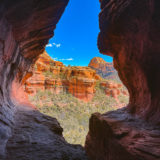
The Subway Cave Hike in Sedona: Everything You Need to Know
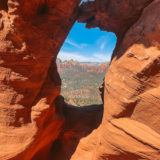
The Schnebly Hill Windows Hike in Sedona: The Complete Guide
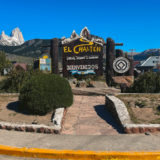
24 Things to Know Before You Trek in Patagonia
07/13/2021 by Kristin Addis 66 Comments
For a few years running now, I’ve explored Patagonia slowly, switching between Chile and Argentina and making hiking my main activity.
It was mind-blowing. I’ve never seen so many glaciers, waterfalls, and rainbows all in one place. It’s rugged and tough landscape that tested my limits but was so easy to fall in love with at the same time.
I did several treks, some were just one day and others spanned several days or even more than a week. With the right gear and knowledge, Patagonia can be enjoyable despite the elements and without many mishaps.
Here’s what I learned about trekking and camping in Patagonia:
Table of Contents
How to Prepare for Trekking in Patagonia
1. you seriously do need hiking boots.
I’ve trekked in Nepal , China , and all over the States in running shoes and thought they were great. The biggest difference is in Patagonia the trail is often super muddy, very rocky, or totally wet. Sometimes there isn’t really even a trail and you have to go by GPS.
There were SO many times when I was really glad to have waterproof shoes that I could just trek through the mud with and not care. They were one of the most important things to bring along. Here are the ones I recommend .
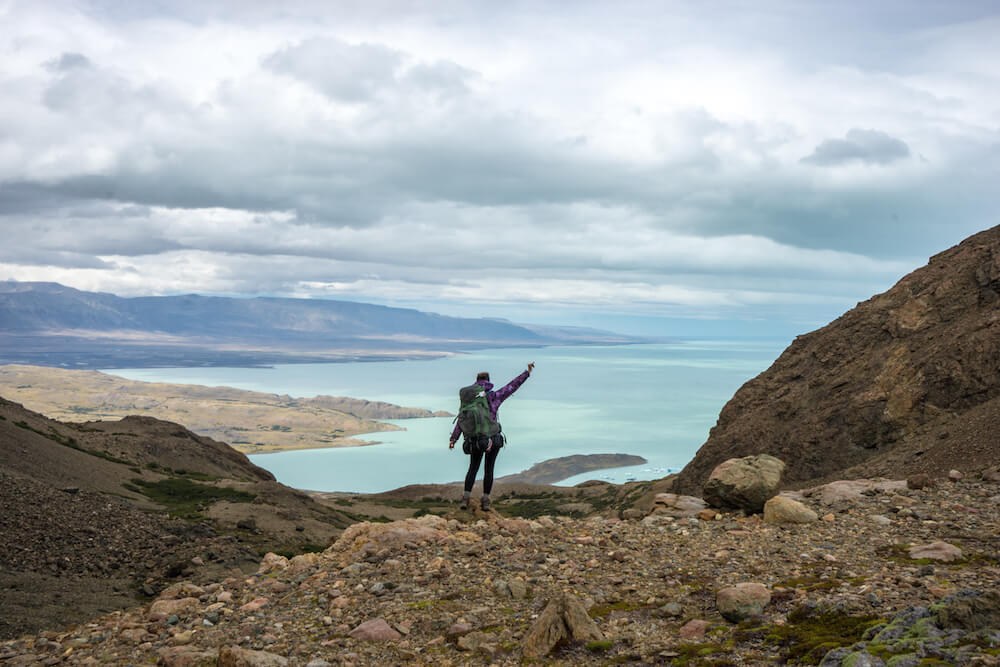
2. … and thick socks
The easiest way to avoid blisters is to reduce friction. That meant wearing thick socks and tying my boots very snugly when I trekked. When I did develop blisters, it really helped to keep my shoes tight and my socks thick to keep them from getting bigger or worse, tearing.
3. Bring Compeed
Compeed is so much better than Band Aids! These blister bandages are the best I’ve found, and they stay on for several days as well. You can get them at your local pharmacy, or a similar product at REI . Bring them with you as they may not be possible to replace everywhere in Patagonia (I actually never found them when I looked for them there).
4. Bring the right clothing with you
You can experience all kinds of different weather within the span of a few hours in Patagonia. I trekked through tons of rain, very heavy winds, and even snow over the two months that I was there. It can feel quite extreme at first, but in time you do get used to it and it even becomes part of the enjoyment of Patagonia.
However, it’s only fun if you have warm, waterproof clothing. Here’s my packing list for Patagonia to help !
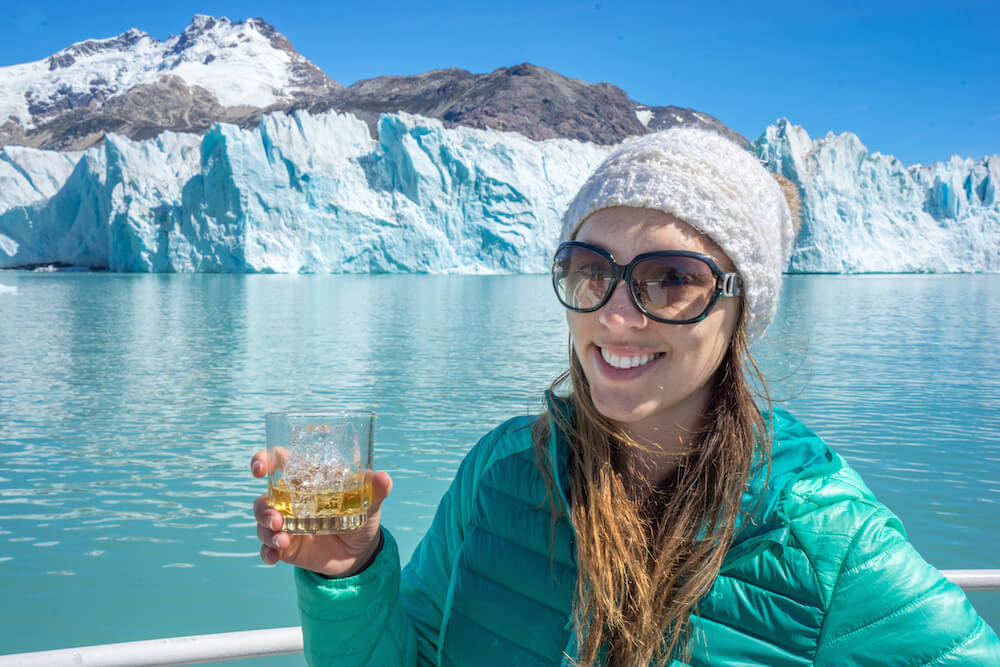
5. Get a tent suited for Patagonian weather
A normal tent isn’t going to be a good choice in Patagonia, where winds can reach upwards of 100km/hour. That is some serious wind and the shape of the tent, plus strength of the tent poles, both matter a lot so that nothing breaks while you’re midway through a trek.
I used an MSR tent that was resilient and super light to carry at the same time. The shape is designed for wind and the rain jacket kept us dry, except for one occasion when the rain was so heavy that everyone woke up wet (it does happen).
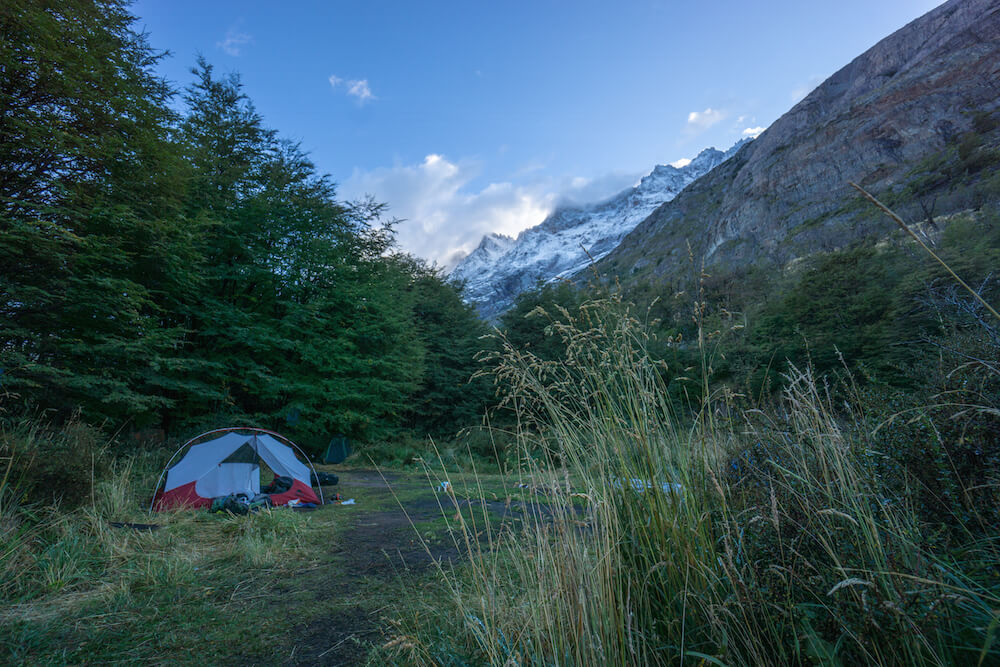
6. For the love of God, do NOT buy your camping gear in Argentina
In the past I’ve bought a bunch of my camping equipment in the local country before the trek. It saved me a lot of money and the trouble of carrying the equipment around. This is not true at all in Argentina. Seriously do not buy any of your gear there!
I saw a North Face bag on sale for $300 that would have been $50 back home. Absolutely everything was overpriced in every single store I checked. This is likely even more exuberant now that the country’s economy has plummeted. Just bring it from home, seriously.

7. But honestly, Chile isn’t that much better
There were a few things that I had to buy in Chile, like my sleeping bag and hiking poles. The price was closer to what I would pay back home, but I think I could have saved more by ordering stuff on REI and just bringing it with me.
8. Get lightweight cooking gear
Trekking with pots and pans is not a possibility for me. It’s just way too much weight and when you have to carry a week’s worth of food on your back, it’s already heavy so why make it worse?
I found this foldable pot that doubles as a pasta strainer and thought it was great. It’s super light and the quality is good. I used it for cooking everything I ate.
9. Hiking sticks are here to help you
Some people think hiking poles make them look dorky. I don’t care. I like the idea of protecting my knees and redistributing the weight. Plus, hiking poles saved me from face-planting into rocks more than once when wind gusts caught me by surprise.
It’s also good to have poles that aren’t super heavy, and as they get lighter, the cost usually goes up. Here’s a post to help you pick which trekking poles are best.
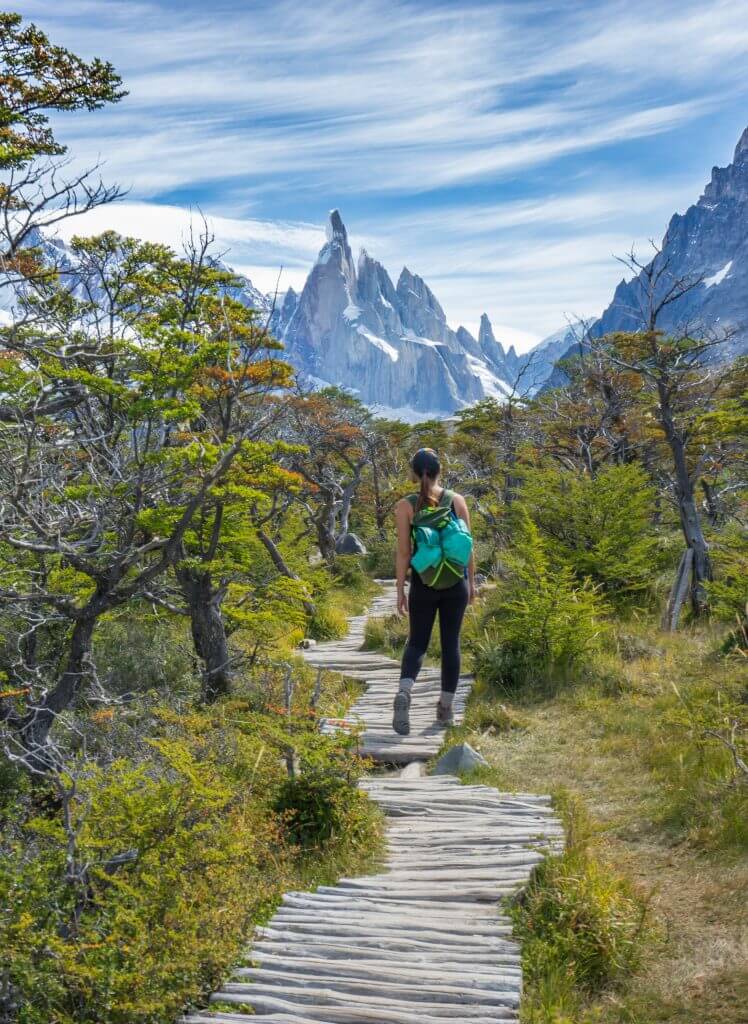
10. Avoid those dumb sporks
When you’re looking at stuff to buy for your trek, you’ll see these half-fork, half-spoon with a knife at the end of one of the fork blades. It looks like a great idea. You can slice your food then pick it up with the fork to eat it!
False – it’s really hard not to cut your face on the knife part. Why was it designed that way, and how did I fall for it?
11. Life will be so much better with powder, not cans
It’s hard to resist easy things like canned tuna (btw, not for me, ew) and sauces. You have to pack those cans up and back out, though. That’s a lot of extra weight for not much gain.
My milk was powdered, as was all of the sauce and soup that I used for cooking. Some people even bring entire meals made out of powder that you just add water to. When water is as easy to get as it is in Patagonia, why not get things that are light until you add water?
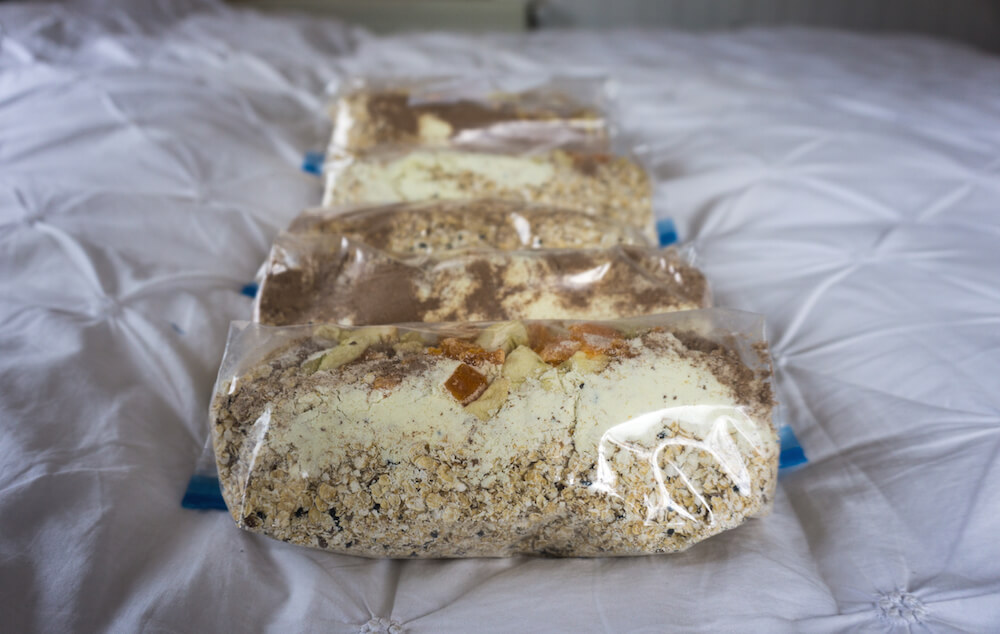
12. Rain-proof your stuff
Rain covers tend to blow off or just be incredibly annoying when the wind catches them, making tons of noise right in your ear.
I didn’t bring a rain cover. I lined my bag with a bin liner and put my clothes, food, and electronics all in their own plastic bags as well. The backpack could get wet – no problem, and the stuff inside stayed dry.
13. Get a hat that won’t blow away easily
Go for a hat that keeps your head warm, your face covered from the sun, and your ears warm in the wind. This hat ticks all the boxes.
I kind of felt like a dweeb wearing it but then again, my face was protected and my ears were covered. Two birds, one stone, really.
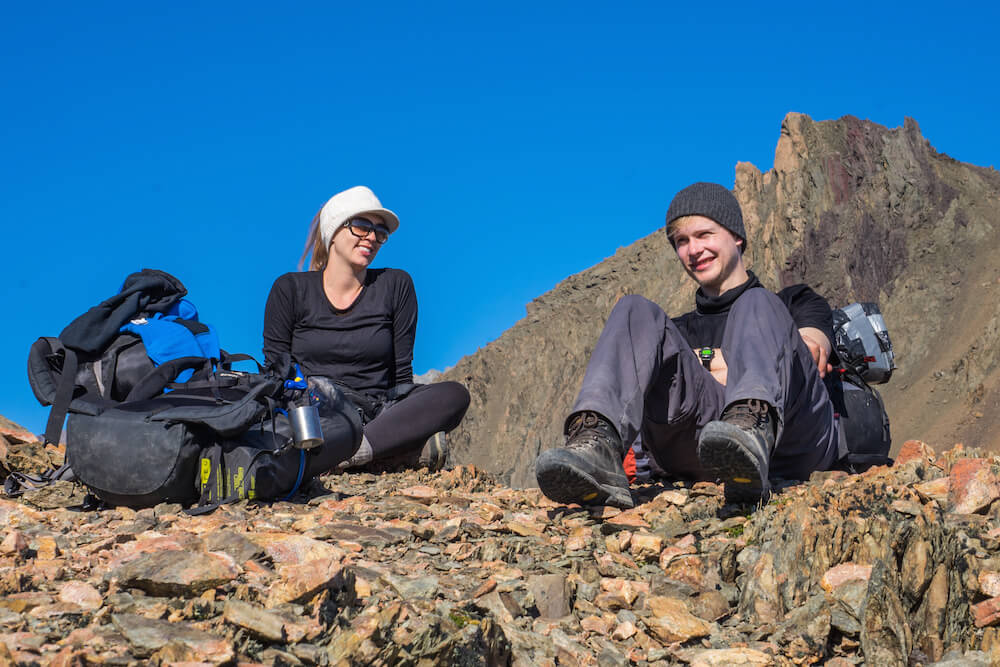
14. It’s pretty nice to have a lightweight, warm sleeping bag
It gets seriously cold when you’re sleeping next to a glacier. I got snowed on as well in Torres del Paine, so having a warm sleeping bag that was also super lightweight was a life-saver. This is a non-negotiable item, along with a good tent, in order to enjoy the camping part of trekking in Patagonia. You’ll want it to be at least comfort level of 0-degrees Celsius .
15. It’s worth it to get a thick sleeping mat
I spent around $20 on a mat that was lightweight but also pretty useless on bad ground. I encountered a lot of roots and rock and think things would have been a lot better if I’d brought a thicker mattress. They do weigh more but only slightly and that’s something I would probably have been willing to carry.
I would probably use something like this in the future.
16. Most water on the trails is clean, but when it’s not, sterilize it with this
Most of the water is glacier water in Patagonia and it’s some of the cleanest on earth. However, especially in Torres del Paine, some campgrounds have had trouble with the increase in tourism and due to some campers doing things like washing in the streams or worse, some of the water has been making people sick.
I bring a steripen along on long treks. I never want to worry about the water or be without it, so I just sterilize it with a Steripen .
PLEASE: It’s up to everyone who hikes in Patagonia to work together to keep the water safe. Too often I saw idiots jumping into the glacial lakes, swimming in streams, or washing their bowls directly in the water. This water trickles down and effectively makes campers drink your bathing or dirty dish water. That’s not cool. Take water into a clean bowl and walk at least 100 paces away before washing, same goes for using the bush toilet. Please think twice before getting that swimming selfie – it’s incredibly selfish.
17. You can eat the Calafate berries
They have thorns and are not to be confused with the little red berries also growing on the ground, but Calfate berries, as long as you know what they look like , are nice snacks to have along the trails, especially on the Huemul Circuit .
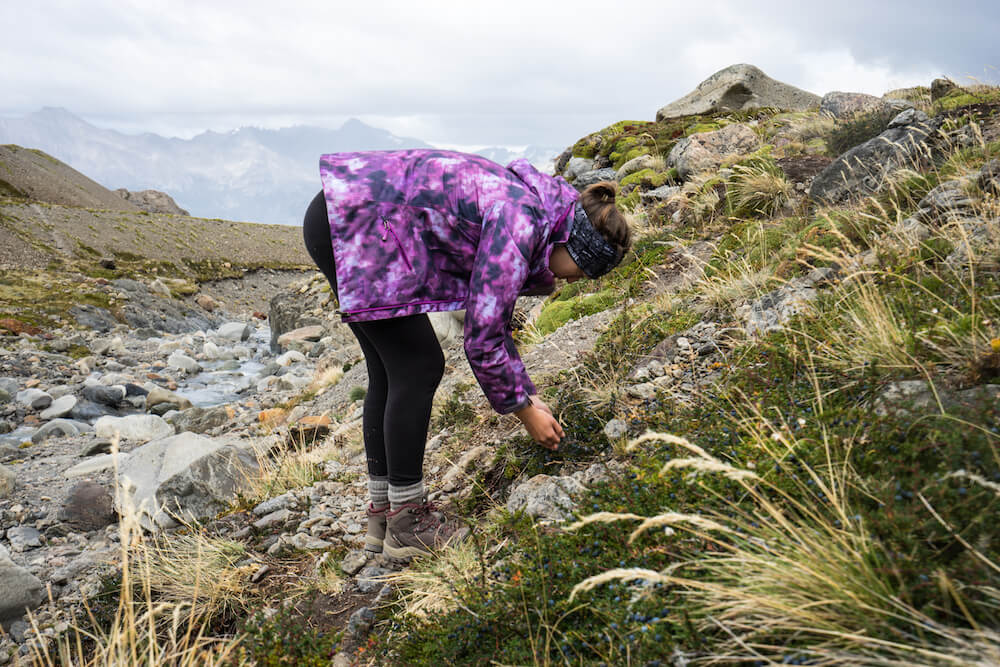
18. Here’s a useful camping food list:
Powder, carbs, nuts, oatmeal, chocolate, and fruits. Those are always in my trekking pack because they weigh the least and give me the most energy.
A day’s packing list:
- one portion oatmeal with milk powder and chocolate powder to taste
- 100 grams of dried fruit and dried nuts
- 1 small chocolate bar
- one portion pasta and powdered sauce plus slices of salami and/or cheese for dinner
For lunch, I pretty much always ate nuts and dried fruit. That way I could just keep going without having to stop. Dinners always had a treat in them of salami or a cheesy sauce (yes, a rare moment when I was willing to eat cheese) just to keep it nice and interesting. I also experimented with cous cous and powdered potatoes and think they’re both great options for hot dinners as well.
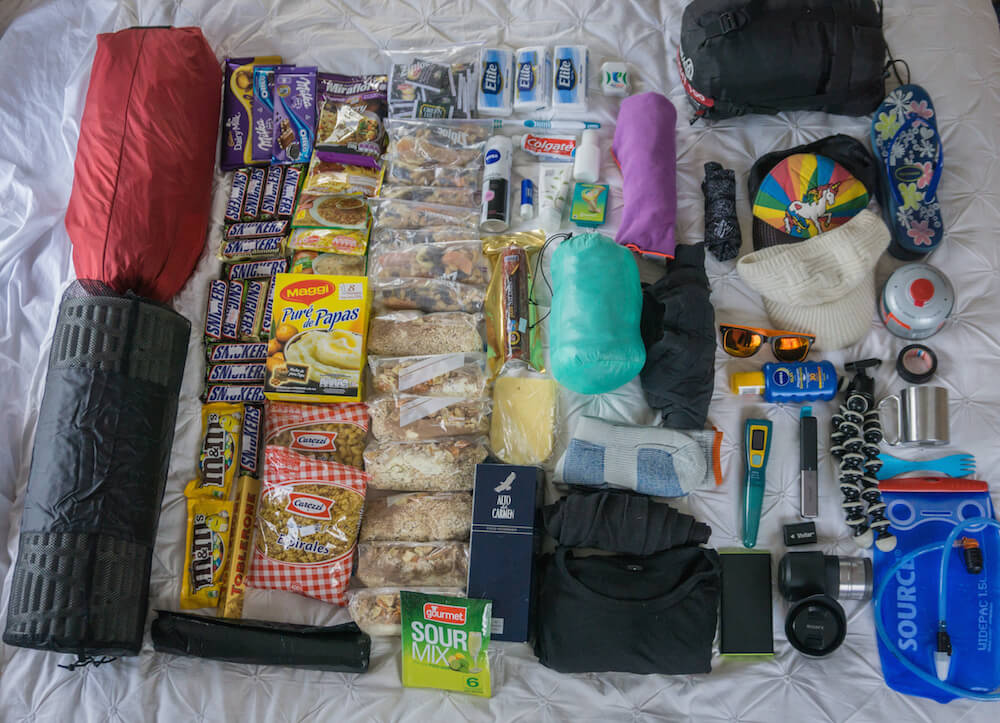
Since I was going to Patagonia with my friend Steve who has been there before and already knew that powder was the way to go, I was able to lighten my food load significantly by not bringing cans or liquid sauces. I’m so glad that we didn’t make the mistake of bringing all that weight!
Also, Steve has a pretty helpful guide specifically for Torres del Paine hiking here , with park entrance prices and campground info, that I’d suggest in conjunction with this post!
19. You’ll need this kind of cooking grill
It’s forbidden to have open fire in just about every national park in Patagonia, at least that I’m aware of.
A little camping stove that you attach to gas cans, available in the sporting goods stores in Patagonia, is best for trekking.
20. Bring a headlamp!
Because using your phone as a flashlight is going to get annoying really quickly. I like this waterproof one .
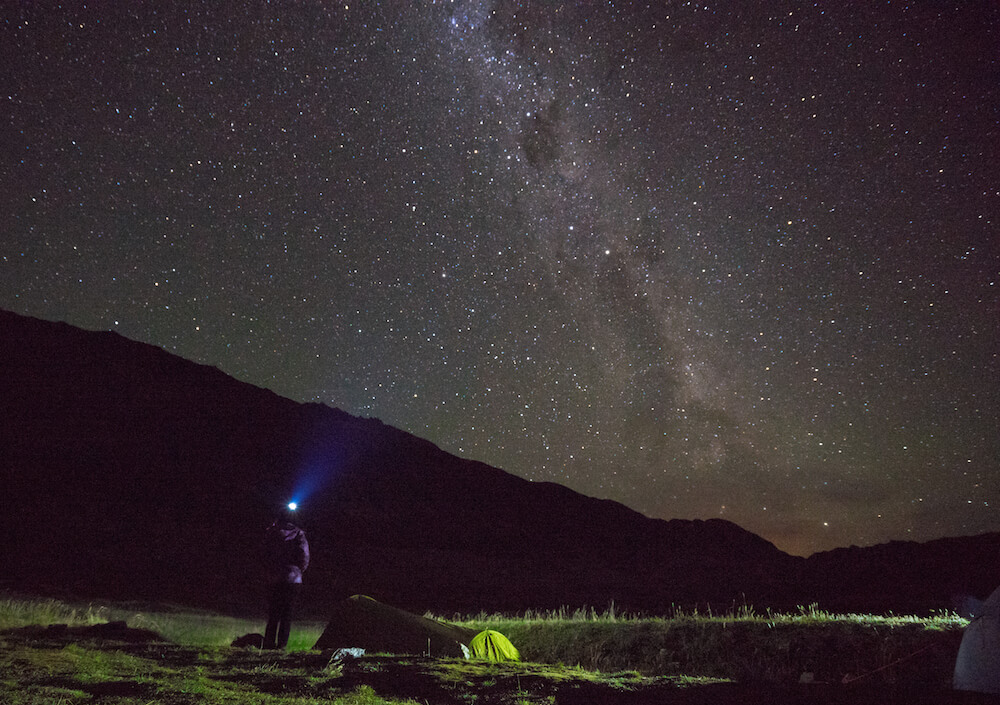
21. …and a portable charger
So that you can recharge your phone and cameras. This is the one that I use. (click here for more info on my camera gear ).
22. Don’t forget mosquito repellant
Yep, they do exist sometimes in Patagonia.
23. …and sunscreen!
Make sure to always lather up when trekking in Patagonia, or anywhere for that matter. A sunburn when trekking is the worst! I like Sun Bum best.
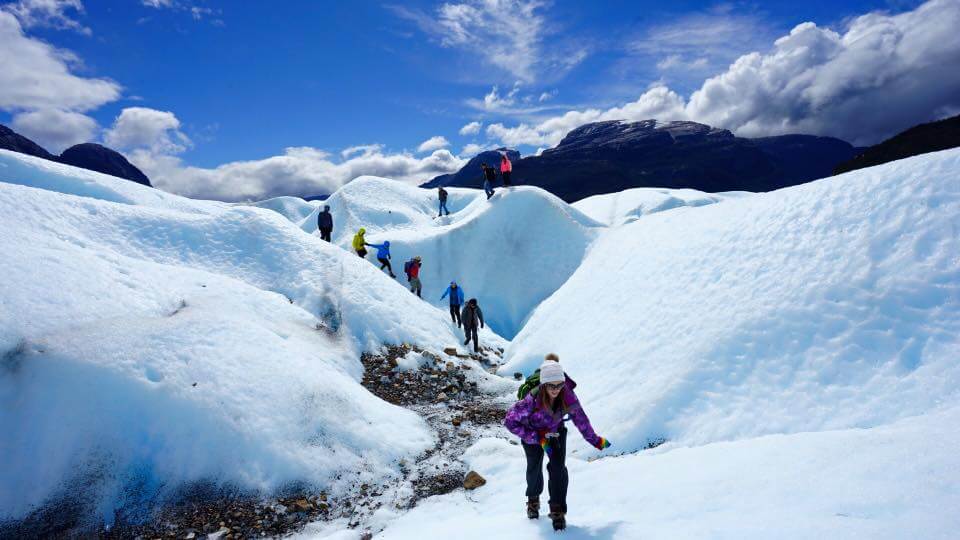
24. Get ready for the best trip ever
Patagonia is seriously awesome to trek through. The landscape keeps getting more and more dramatic as you go through, providing constant surprises and little challenges. It’s one of the most rugged and lovely places I’ve traveled through, and if you’re planning to do the same, get ready for one of the best trips, ever, period.
About Kristin Addis
Kristin Addis is the founder and CEO of Be My Travel Muse, a resource for female travelers all around the world since 2012. She's traveled solo to over 65 countries and has brought over 150 women on her all-female adventure tours from Botswana to the Alaskan tundra.
Leave a Reply Cancel reply
Your email address will not be published. Required fields are marked *
Save my name, email, and website in this browser for the next time I comment.
subscribe to our newsletter
This site uses Akismet to reduce spam. Learn how your comment data is processed .
07/13/2016 at 6:56 pm
I’ve been waiting for this..great post! I’m heading to Patagonia around Christmas (after I backpack Central America and the rest of South America) so wouldn’t buy a lot of things at home. Hopefully I can find some cheap gear in Peru or somewhere. Awesome tips, thanks again!
Kristin says
07/14/2016 at 1:49 am
And if you can’t in Peru, opt for buying in Chile rather than Argentina. Have fun!
Patricia says
07/15/2016 at 2:41 am
Hi Kristin, thank you so much for your post, it’s gonna be very useful on our trip to Patagonia in January. We are very excited, can’t wait for this!!!!
07/15/2016 at 7:24 am
Yay glad to have been helpful! You’re going to love it
John @ Pretravels says
07/15/2016 at 2:58 am
Great images and fantastic tips! If you’re not used with this type of terrains you might end up with the wrong gear and nothing spoils hike more than this.
07/15/2016 at 5:32 am
This is precious – perfect timing, it will help me in my preparations immensely. Thank you for this post and wonderful photos 🙂
07/16/2016 at 12:00 am
For me Patagonia seems so far away … But who knows, maybe someday! 🙂
Mishelle says
07/16/2016 at 9:38 am
Great post! I have this destination on my bucket list. Hope I go there one time.
Nicole says
08/03/2016 at 4:21 pm
I am so happy that I friend of mine ran across this article!!! I am gearing up for a 5 week trek the middle of Oct. and although I have read literally everything, it’s nice to have a first hand account!!! How easy is it to find the powered foods/dehydrated things in towns? This is hands down my biggest concern! I am an avid hiker and love to do ziplock cooking but I for the life of me can not find any info on actual food purchases while I am there!!! Thank you so much!!!
08/03/2016 at 4:28 pm
You won’t easily find those whole dehydrated meals that some people bring. I don’t find that they taste all that great and I prefer just having real food like pasta with a powdered sauce. I had no problems getting powdered milk, dried fruit, powdered chocolate milk (essential), and soups. I went into more detail on my trekking food in this article: https://www.bemytravelmuse.com/torres-del-paine-circuit/
Crystal says
09/30/2016 at 12:55 pm
I’ve heard from a few people that it’s best to rent gear outside of TDP rather than buying at home – honestly not sure I’ll use it again (outside hiking boots). Do you know anyone who has used rented gear – tents, sleeping bag, mats, stove – and if they found it adequate for the conditions?
Marijke says
10/11/2016 at 5:58 am
Hi Kristin, Thanks for the useful post. I’ll be backpacking through South-America from March until June and Patagonia is definitely on my list! What was your itineray in & how did you travelled to Patagonia? thanks! Marijke
10/13/2016 at 11:54 am
This should help: https://www.bemytravelmuse.com/patagonia-itinerary/
You can also check out these two guides with interactive maps. I started in the north and moved south, switching regularly between Chile and Argentina https://www.bemytravelmuse.com/argentina-guide/ and https://www.bemytravelmuse.com/chile-guide/
Georgia Tucker says
11/01/2016 at 9:54 am
Hi, this is really helpful. Roughly how much did you spend? How much were camp sites per night for a 2 man tent roughly?
11/01/2016 at 2:25 pm
Budget anywhere from $5-$20, as it can really vary depending on the campsite’s location and popularity
Genevieve says
01/08/2017 at 10:02 pm
Hi Kristin this is really beautiful!! How did you guys keep up with the good path when Steve say there was no trail? And how did you get the gps on the phone if there is no good SIM card? Thank you! this looks incredible! Genevieve
01/09/2017 at 12:15 pm
We downloaded maps.me for offline maps and plotted the points ahead of time. That’s how we figured out the trail 🙂
kimberly says
01/10/2017 at 6:50 am
hello Kristin, thank you so much for this info.. I see in one pic you are wearing a tank top.. what time of year was this.. I’m going back and forth on clothing for some pieces.. we will be going from santiago , hiking through panes del torres , end of february into early march for 2 weeks. Ive got a couple questions … did you get rocks in your shoes.. did you need small gators, did you wear darn tough socks? and were they to the calve but not over? which boots did you go with, were they gortex? did you need shake and warms, did you bring extra hike shoe what did you wear in the refugio? we won’t be camping some males have a different vision of what to bring.. i need a womens perspective.. what type of sport bra did you feel worked what type of long johns did you wear.. and what did you wear on your feet in the refugio if you stayed in any..
01/10/2017 at 9:08 am
Hey Kimberly – I was there February to late March. I suggest layers (more here about what to pack: https://www.bemytravelmuse.com/womens-patagonia-packing-list/ ) – No but I had boots on that were well-sealed and waterproof so that kept them out. They’re made for trekking in those conditions – Sorry, what are small gators? ¯\_(ツ)_/¯ – Yes wear thick socks and mine were mid-calf – Boots are linked in the packing list – It’s not cold enough to need hand warmers – No just brought one pair – You can wear what you wear hiking in the refugio. It’ll be cold! – you can bring flip flops for the refugio and wear them with socks. Give your feet a break from the hiking boots. Sports bra-wise just wear what you’d wear to the gym!
04/25/2018 at 6:57 am
Gators are actually gaiters and are best described as: “Adjustable elastic band for convenient and firm bundling, front opening Velcro design for easier putting on and taking off, firm hook fasten to shoelace and durable strap to keep the gaiters from coming loose FUNCTION: To protect your boots and trousers from rain, water and mud. Pair there gaiters with hiking boots or ski boots to keep rocks, dirt and snow from getting into your footwear OCCASION :This gaiters good for skiing, backpacking, hiking, camping, fishing, and other outdoor adventures” So essentially when wearing boots these are fabric covers that further protect any water, dirt or snow to get into your boots. They look a little like shin protection when you play hockey or other similar sports.
Aria Srinivasan says
01/15/2017 at 1:10 pm
I’m only going for a week to Patagonia.. would you still recommend the hiking boots?
01/15/2017 at 4:15 pm
If you want to hike, they’d be incredibly helpful. It’s super rocky and often wet terrain.
Taylor says
02/07/2017 at 7:38 am
Where can I find your “dorky” hat; I’ve been searching everywhere! It seems so practical!
02/08/2017 at 11:03 pm
I can’t find it either! I bought it in a rural area of China years ago.
Connie says
02/13/2017 at 5:17 am
Hi! Sorry to ask something trip-specific, but I’m having trouble finding this anywhere. I’m going to do the W trek next week and was originally planning on checking my backpack with the tent.
But I’m paranoid about it getting lost with 3 transfers, so I figure if I bring everything except the stakes, I can take everything as a carry-on. But are there places to purchase decent stakes in Puerto Natales upon arrival? I see there are a lot of places to rent equipment, but I wasn’t sure if I would be able to only purchase stakes.
Thanks in advance!
02/13/2017 at 7:22 am
Hey Connie, to be honest I have no idea. I’d email erratic rock and ask what they suggest!
03/07/2017 at 2:38 am
Hiya, we booked our tickets to arrive in Chile in January, thinking this would give us plenty of time to book campsites for Torres Del Paine but they all seem to be booked up already?! A year ahead? Does this mean we can’t visit the park..? Any advice so welcome, this is quite shocking… 🙁
Joanna says
04/04/2017 at 4:37 pm
I love your blog!! I was wondering about the photos you take..how do you take the photos of yourself since you’re a solo traveler?
04/05/2017 at 12:22 am
Selfies! I’ve written about how here: https://www.bemytravelmuse.com/how-to-take-travel-selfies/
vikram says
04/05/2017 at 4:14 am
rofl at the comment on snickers ! but these are pretty awesome tips. How much Spanish would i need to know though ? also i love climbing, so any recommendations on decent bouldering not too far off the hiking trails ? any pointers would be like manna from the heavens .. all the best for your future adventures
04/05/2017 at 4:52 am
My Spanish is no bueno. I only know what I picked up growing up in California, which is restaurant Spanish. It would really help to know some as you won’t encounter a lot of locals in Patagonia who speak English, but I survived.
I did some bouldering in Bariloche in the north of Patagonia: https://www.bemytravelmuse.com/things-to-do-in-bariloche/
Jyotsna says
08/20/2017 at 9:58 pm
Amazing post! The hat you mentioned which serves as a beanie as well as a sun protector looks great, where did you get that from? Searched all over but could not find it.
08/21/2017 at 12:52 am
China like soooo long ago but putting a beanie over a baseball cap works similarly well
Teresa says
09/07/2017 at 10:34 am
I’ve just started planning a trip to Patagonia for around a month, what are your thoughts on doing a month long trekking trip solo as a female? Some say go for it and some say its a big no no. I’m aware common sense goes a long way if you’re travelling solo but is it something you’d recommend on a trekking tip in Patagonia? Love the blog by the way – so much seriously helpful info!
09/07/2017 at 2:08 pm
I think you’ll meet lots of people. You’ll meet people in town who will want to go with you, you’ll meet people on the trail, and you’ll meet locals too. I love solo traveling so that’s my feelings towards it!
09/19/2017 at 4:30 pm
Looks so exciting! I am planning a trip for March 2018. I love your “dorky hat,” the white one that is a headband with a visor. What brand is it? I want one!!!!
09/20/2017 at 3:53 am
So many people have asked and I wish I could find one online! I bought it in a tiny town in China. However now I put a thin neckwarmer over my rainbow had and it works similarly well 🙂
09/28/2017 at 6:13 pm
Thank you so much for posting! I’m hoping to plan my trip to Patagonia for a departure in the next 6 months – I’m very active and an avid hiker, but will be likely going solo. Do you have a guide you’d recommend? Thank you,
09/29/2017 at 5:19 am
I didn’t use any guides, but for most of these hikes you can find people to hike with in town, or even along the trail.
P. Sanchez says
11/07/2017 at 5:19 am
I recently came across your article on trekking in Patagonia. I enjoyed reading your guide and found it quite helpful, up to where you condemned people and called them idiots for wanting to swim in the lakes/rivers. Discarding dirty/soapy water into a river is one thing (I’m a marine biologist/coastal ecologist so I understand and respect nature), but jumping in for a swim? No, I would not jump into a 2 metre wide stream for a swim at a campsite where people will be collecting water further down, but no amount of dirty stares and silent (or even verbal) judgement will stop me from having a swim in a lake/larger river. Maybe you should consider editing that part out of your guide. It’s definitely on my mind to take a swim there, and the only thing that would stop me is if CONAF or a carabinero told me its forbidden to do so (haven’t found anything of the sort). If someone is a germophobe, then that’s on them to decide if they want to drink the water with or without disinfecting it, but don’t ruin other peoples experience just because you don’t agree with their idea of fun.
There’s a saying that goes “dilution is the solution to pollution”, and I can guarantee you dirtier things have been in your mouth (with or without you being aware of it) than a mouthful of water collected from a lake where someone has bathed in.
11/07/2017 at 6:13 am
Thanks for weighing in. The water in Patagonia is the cleanest on earth. That glacial water is 10k years old and when you jump in right at the source, it makes everyone also at that lake need to drink that water too. I just didn’t think it was cool to wash off 8-days of sweat into water people are drinking. It was also freezing cold and a hypothermia risk, so I wasn’t tempted.
If everyone takes the attitude that it’s going to get diluted, then nobody can drink the water without filtering it first. It already happened in Torres del Paine at one of the more popular trails, and it’s the water coming right down very close to the source. Sad.
It’s just about respecting what we have so that everyone can enjoy it. When we all take the attitude of one little thing that I do will not affect the rest, or it’ll just get diluted, it adds up, and this is why we can’t have nice things.
It’s important to let people know, who may not have realized, the importance of treating the water as sacred and clean. This post has potentially informed people who might not have known what is OK and what isn’t when camping. My writing addresses keeping all of the water clean and respecting it everywhere without splitting hairs about where is OK and where isn’t, and also it’s my site, so I’ll write what I want 🙂
04/25/2018 at 7:12 am
“Dilution is a solution to pollution” is an illusion, this is a mistaken notion on all counts, please don’t use that :). A drinkable water body can be tainted by pollution hundreds of miles away. If it is a pristine area, the only considerate thing to do is leave it that way. There are SO many places in the world where you can dive in and have a blast, under waterfalls, in deep blue pools etc. There are SO few places that are pristine. As a scientist who works in the environmental field, I think it is awesome that Kristin provides these guides that challenge yourself when traveling while using common sense, preparation, and consideration of the places you visit. Preparation is the key. You never know what you might encounter so at least be prepared for the expected so you have that down to concentrate on anything else and enjoy yourself to the fullest. Being a good guest in the countries your visit is paramount in so many ways. I think it is great that Kristin mentions safety including sunscreen, repellent (if there’s water, there’s mosquitoes), proper footwear/gear and so on. I trust her more than most and when traveling will bring these guides with me to make sure I enjoy myself, am safe, and respect the places I go. Before her I wouldn’t visit many places in the world out of fear of exploiting them. She taught me you can enjoy the world and if you visit a place, you give back (to the locals) as much as you take. Thanks BTW for this post, it is very thorough with great advice and every link works even 2 years later.
11/08/2017 at 11:24 pm
Ok a few things I agree with. I personally wouldn’t wash my 8-days clothes directly in the water, but I wouldn’t lose my shit if I saw someone else doing it (unless they were adding products to it). As for 10k year old water and hypothermia… I think we’re picturing different lakes. The water at Torres del Paine doesn’t seem like it has good drainage (at least in front of Los Cuernos) so I can see how contaminants might build up there with bad flow (especially with the increasing number of visitors). As for the hyporthermia, so long as you have dry clothes to warm you up once you get out (and it isn’t too windy) it isn’t really that dangerous. Just don’t stay in too long…
Sure, the mentality of “it’s only me, it wont make a difference” is usually wrong and common among people that justify littering, since it adds up, but in the scenario I’m picturing, the lakes/rivers will have good water flow and and oil/skin/fecal matter that comes off your body will just wash away and be broken down. Lotion, insect repellant etc. wont, so yes, one should rinse before jumping in. We CAN have nice things if we are smart about it. It isn’t necessarily about splitting hairs, but being informed and unbiased. Let people know that if they absolutely must jump in, to take these precautions (rinse before as you would before jumping into a swimming pool, do not stay in too long, do not jump in if the stream is small and people nearby e.g. at camping grounds use it for drinking water). That being said, I appreciate tourists respecting the land, and it goes without saying; if I see a sign saying “no swimming” I will listen to it. Especially if it is by CONAF.
11/09/2017 at 2:10 am
Where are you supposed to rinse off the lotion and insect repellant? There aren’t showers nearby, or signs, or a bunch of rangers. Except for the really popular hikes, these are not like the national parks in North America. This is usually raw, unadulterated nature 🙂
I think once you get there you might understand where I’m coming from. I’m done arguing about this now 🙂
11/29/2017 at 5:22 pm
You just got me super excited planning my trip to Patagonia! So many useful info on here!!!
Thanks for sharing!
Melissa says
12/05/2017 at 8:19 pm
Hey Kristin! Thanks for the tips. I was curious if I need hiking pants for the trip (hiking the W in December) but saw that you wore tights which I prefer. How thick should they be – any suggestions where I could get some hard wearing ones? Thanks!
12/06/2017 at 12:57 am
I like LuLulemon. I always wear leggings when I hike. I just like them better! If you’re cold wear two – just make sure they’re roomy or you’ll constantly have to be pulling them up. I’ve had that happen before, it’s annoying!
Jennifer Duke says
12/07/2017 at 11:22 am
Thanks for the tips. I’m going on a Patagonia tour and there are some hikes planned. I sincerely thought my regular tennis shoes would cut it. Glad I read this first. Also, even though I’m not camping, I might pack some of those suggested food items to keep with me so I don’t separate from my group. Great article!
12/07/2017 at 2:09 pm
I would get boots! And yes snacks are always good to have along 🙂
01/05/2018 at 4:53 am
Thanks for this great post! What would you recommend for a coat/jacket and gloves? Going in March to the Chile side for a few days, but not camping.
01/05/2018 at 8:11 pm
I’ve got a packing list here, should help 🙂 https://www.bemytravelmuse.com/womens-patagonia-packing-list/
Sabrina says
06/02/2018 at 12:57 am
Where did you get that hat? Seems warm and functional and at the same time looks nice!
06/02/2018 at 1:46 am
China in a tiny little town. I have tried in vain to find it online since you’re about the 40th person to ask on here but haven’t been successful 🙁
Brianna says
08/14/2018 at 2:51 pm
Band-Aid Hydro Seal Blister are amazing!!! They don’t sell Compeed in the US anymore 🙁
08/16/2018 at 9:24 pm
Bummer! Not even on amazon?
Rob Pinckard says
03/11/2019 at 8:48 am
Great article. I’ve found that your comment about boots is spot-on; heavy packs need heavy boots. Running shoes or even mocassins are incredibly comfortable at camp, at the end of the day, and on a long trip, I’ll make room for them in my pack. But on an extended back country route of rocks and mud, water and ice? High quality, well designed boots are like a sports car in an urban environment. I’m older school than you, but wouldn’t backpack without moleskin for blisters…especially if the boots you’re wearing have less than several trips of wear on them. Carry a small pair of scissors to custom fit the bandage to the site, and the moleskin will remain in place for several days. I’ve found nothing, over the years, that works nearly as well.
03/13/2019 at 11:48 am
I love compeed personally but my goal Is just not to get blisters!
08/21/2018 at 3:43 am
Hi Kristen.
Great post, super helpful!
I’m in the start of planning my trip for the O. Firstly booking the campsites but do I need to pre book a permit to gain entry to the park? So if I was starting say on the 10th and finishing on the 18th would I pre book this permit for this amount of time? Just a little concerned with fitting the camp sites within selected dates and then wondering if I need the permit to cover the trip?
08/21/2018 at 9:43 pm
You will need a permit for the park but I think you can apply for that in person.
Pauline says
01/09/2019 at 4:51 pm
Hi Kristin! I’m very grateful for your guide as I’ve never done any multi day hike, especially not in the kind of harsh weather that can be encountered in Patagonia! With what kind of backpack did you travel (especially for the treks at e.g. Torres del Paine)? Is a 50L enough or will I need to upgrade to a bigger one? Thank you in advance! Pauline
01/09/2019 at 5:04 pm
I had a 75L and used every inch of it for the O. You could make a 50 work for more like a 5-day or shorter, though!
02/15/2019 at 5:54 am
Thanks for the nice detailed guide. I have a couple of questions, because I am planing in the beginning of 2020 to travel around the world with just a carry on. Since Patagonia is my 1st stop, is there an outfit that I can rent the camping gear? Also do you book your accommodation in advance? Thanks
02/16/2019 at 2:55 pm
Yes you can rent and for Torres del Paine yes book ahead, the other hikes don’t have campsites in the same sense. I just showed up personally.
02/04/2024 at 6:18 pm
Thanks for the article. I’m 60 and will be hiking with my 29 year old son in 9 months (Nov 2024). I’m in good health and have reasonable endurance and good balance. He is in exceptional physical condition. How strenuous and challenging is trekking in Patagonia? I’m starting to up my exercise for strength, endurance, and balance but I certainly don’t want to be surprised! Thanks, Mary
Kristin Addis says
02/10/2024 at 3:38 am
really depends on the trail you choose! But it can be steep and weather unpredictable.
CELL COVERAGE LAYER
See where you can dial 911 and scope out data for (really) remote work with Gaia GPS.
BEST WEEK EVER
Try out unlimited access with 7 days of Outside+ for free.
Start Your Free Trial
Powered by Outside
The 7 Wildest Hiking Trails in Patagonia
Dayhikes, backpacking trips, popular routes, remote backcountry trails, and more. no matter what you're looking for, patagonia has it all..

- Share on Facebook
- Share on Reddit
Heading out the door? Read this article on the new Outside+ app available now on iOS devices for members! >","name":"in-content-cta","type":"link"}}'>Download the app .
Straddling two countries and serving as home to rugged and imposing mountains, giant calving glaciers, and some of the world’s most adventurous spirits , Patagonia has etched itself into the fabric of my heart. After spending three months chasing horizons and navigating the unpredictable dance of the southern winds, I’ve whittled my time there down to eight can’t-miss trails that I still dream of today. If heading there is on your bucket list, you can’t go wrong with any of these trips.
Keep in mind that in Patagonia, adventure and challenge go hand-in-hand. I’ve learned that being prepared to experience all four seasons in one day is imperative. So is strapping down that backpack rain cover as if your life depends on it, because in some conditions, it does. Strong winds and rain can delay hikers on the trail, so be sure to bring enough food for a few extra days, and pack a waterproof shelter even if you’re just heading on a dayhike. (Thankfully, clean water is ever-abundant in the area thanks to the wealth of glacial melt .)

The O Circuit, Torres del Paine National Park, Chile
Length: Approximately 80 miles (130 kilometers) over 7 to 9 days Difficulty: Moderate to challenging Access: The trailhead is accessible from Puerto Natales, and you’ll have to pay a fee to enter the park. Due to its popularity, booking campsites or refugios, which are small huts that often have showers and bunk bed space available for rent, in advance is essential.
Trekkers in the know often consider the O Circuit in Torres del Paine National Park in Chile Patagonia’s crown jewel. It’s one of the most magical hikes I’ve ever experienced . If you only have time for one hike in Patagonia, make it this one: Each day offers a completely different experience and view. It’s also one of only four trails in Patagonia where you can witness the majesty of the Southern Patagonian Ice Field, the world’s second largest contiguous extrapolar expanse of ice. Though you won’t need to don crampons and cross it, you’ll be hiking right across from it for almost the entire fourth day of the trip.
Many choose to just hike the W, which is a 4 to 5 day section within the O Circuit that avoids the highest point on the trail, the John Gardner pass. But doing the whole thing is totally worth it: The three additional days that make it the O are less crowded, and some of the most beautiful out of the entire trip. This is also one of the only hikes in Patagonia where you can reserve refugio space, meals, and even pre-pitched tents ahead of time, which significantly lightens your load. It’s also one of the most popular hikes in Patagonia, so book your trip up to a year ahead.

Fitz Roy, El Chaltén, Argentina
Length: Variable; shortest route is 16 miles (26 kilometers) Difficulty: Moderate to challenging Access: El Chaltén serves as the starting point for Fitz Roy hikes. The town is easily reachable from El Calafate by bus.
One of the most legendary views in Patagonia, Fitz Roy is a famous and popular trek for good reason. Though you’ll be sharing it with plenty of other hikers, it is still so worth doing for a glimpse the legendarily rugged mountain and lake view at the top. Most of the trail is flat and lovely, with the exception of the last hour of steep, rocky terrain. It’s also possible to camp at the base and climb to the top to see the sunrise illuminate the jagged mountains.
Not looking for a long dayhike or a backpacking trip? If you’d rather stay in town but still see the mountains, the easier and more accessible 1.25-mile (2-kilometer) Condor Lookout trail is a great option.

Cerro Torre, El Chaltén, Argentina
Length: Variable, shortest route is 15 miles (24 kilometers) Difficulty: Easy Access: El Chaltén serves as the starting point.
Like Fitz Roy, Cerro Torre in El Chaltén is a do-not-miss. This is also a mostly flat hike without the climb to the top that Fitz Roy has. Most of it is through lovely landscape with scrubby bushes and some boardwalks, and although the hike is long, its lake and jagged peak view at the end is worth it. Bring a zoom lens to peep climbers on the face of the rock. It’s also possible to combine this and the Fitz Roy hike for one long but beautiful day.
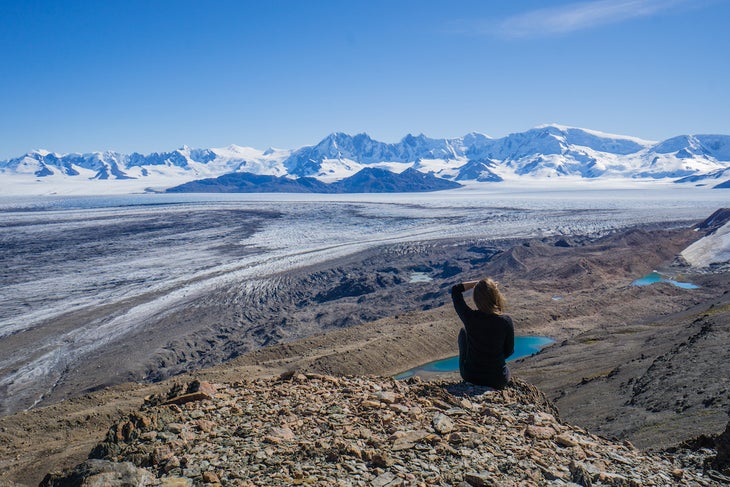
Huemul Circuit, El Chaltén, Argentina
Length: Approximately 39 miles (63 kilometers) over four days Difficulty: Challenging Access: The trail starts near El Chaltén.
The Huemul (pronounced wey-mool) Circuit is a grueling, a four-day symphony of endurance that will test any hiker’s mettle. I will always remember navigating the worst downhill of my life on this trail: It’s steep and on loose dirt with very little to brace on, and is not for the faint of heart. But, oh, the scenery: Smaller crowds, panoramic vistas, and the wildness of it all make it one of the most beautiful treks I can remember doing.
You’ll need to be totally self-sufficient on this trail. You’ll also need to bring or rent a harness and pulley from one of the shops in El Chaltén to pull yourself across not one, but two rivers on Tyrolean traverses, metal lines strung across the water. It’s another opportunity to see the Southern Patagonian Ice Field, but the difficulty makes it less popular than the O Circuit, so you won’t have to share it with many people. The views of the ice field, glacial lagoons, and mountain peaks just don’t stop, and you’ll remember the breathtaking glacial lakes long after your knees and quads stop whining.
Villa O’Higgins, Chile, to El Chaltén, Argentina
Length: Approximately 22 miles (37 kilometers) Difficulty: Challenging Access: Villa O’Higgins and El Chaltén are the start and endpoint, respectively. This trail involves a boat crossing and requires thorough planning.
Although an atypical suggestion for hikes in Patagonia, this is one of the more unique and quiet trails out there, where most of the day you’ll be walking through no-man’s land. Thankfully the path is well established, so you won’t need much in the way of routefinding skills.
Villa O’Higgins lies at the end of the Carretera Austral, the mostly-gravel road on the Chilean side of Patagonia. Most tourists don’t make it all the way to the end, because if they do, they’ll either have to turn around or take a boat then hoof it all the way into Argentina. Still, it’s a true adventure, gliding through a glacier lake followed by an evening at the farm on the other side, then a long, peaceful, sometimes muddy walk into Argentina’s El Chaltén.
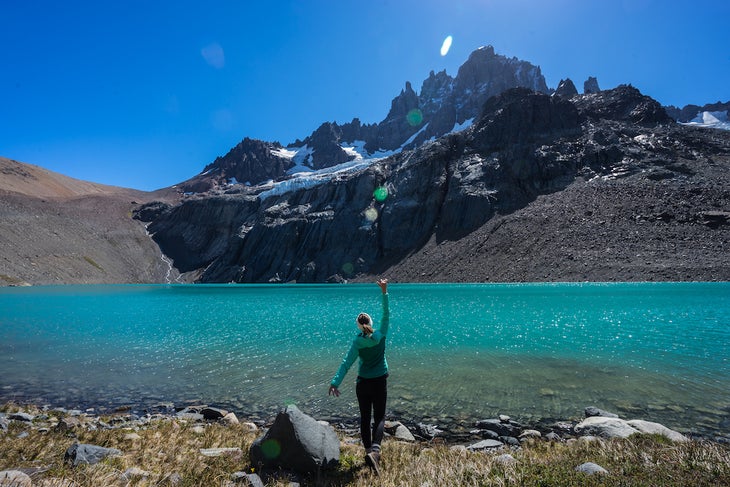
Cerro Castillo, Villa Cerro Castillo, Chile
Length: Approximately 30 miles (48 kilometers) Difficulty: Moderate to Challenging Access: The trail begins in Villa Cerro Castillo, accessible by bus or thumb from Coyhaique.
One of the more remote suggestions on this list, Cerro Castillo is an aquamarine lake at the base of a crown of jagged mountains. Although there are many such lakes and views in Patagonia, this is one of just a few that you can get all to yourself. The tiny, rural town along the Carretera Austral only has a few homestays, but it’s one of the more authentic places to lay your head in all of Patagonia, and few other tourists ever visit.
Want to cut this hike a little short? The “emergency route” is a steep one-day hike from the lake to town, and despite the name is accessible for general, non-emergency travel too. Cut your backpacking trip short by taking this route as an early bailout point, or use it as a steep dayhike to see the lakeside views . Either way, you can tote a tent and overnight at the lake (leaving no trace, of course), or spend the night in Villa Cerro Castillo near the trailhead.
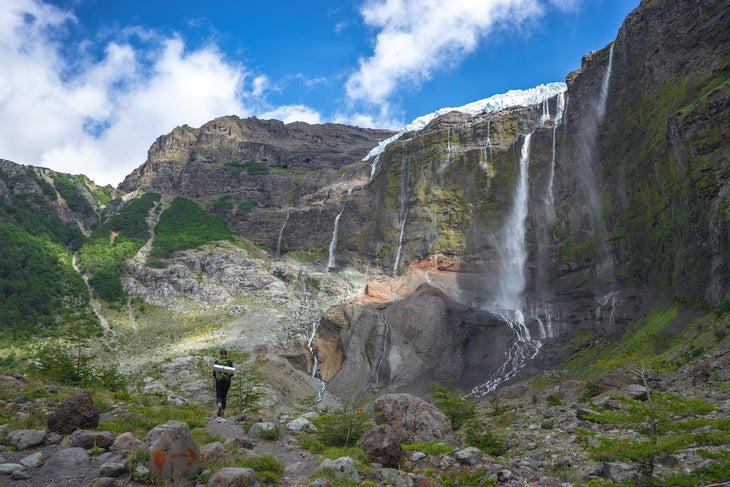
Tronador, Bariloche, Argentina
Length: Typical route is 8.7 miles (14 kilometers) Difficulty: Moderate to challenging Access: Bariloche is a common starting point for Tronador hikes, with buses connecting from nearby towns.
Widely considered the gateway to Patagonia, Bariloche is a town of lakes, mountain peaks, and ski lifts in the winter. Though there are many gorgeous hikes in the area, the Tronador is my favorite for the cascading waterfalls and the chance to set up camp on the mountain peak. The mountain bisects the borders between Argentina and Chile, but the easiest access point is on the Argentine side.
The path to Tronador weaves through ancient forests and alpine meadows, leading to a glacier-clad summit with next-level stargazing . There’s a small refugio, but most visitors tote a tent and spend the night tucked into the rocky landscape.
Popular on Backpacker
The 30-mile thru-hike was the ideal trip for putting our backpacking and hiking candidates through the wringer.
Related content from the Outside Network
Navigation – desert, what’s it like to go on a 200-person hike better than you think., how to pack for backcountry skiing, the original yosemite firefall.

9 Top-Rated Hiking Trails in Patagonia
Written by Mark Johanson Updated Jul 26, 2021
Few places on planet Earth are as remote and untouched as Patagonia. This sparsely populated region, which spans the southernmost tips of both Argentina and Chile , is rightfully famous for its soaring Andean peaks, windswept steppes, crackling glaciers, and distinct gaucho culture. It's also a mecca for adventure enthusiasts, with incredible hiking and multi-day trekking routes through some of the world's most rugged and unforgiving landscapes.
In general, the Patagonia trekking season runs from October to April . Some trails can get downright overcrowded in the height of summer (January and February), when the weather is at its most ideal, and local Chileans and Argentineans take their holidays. If you're planning to travel during this time, it may be a good idea to book campgrounds and lodgings in advance.
Your Patagonia hiking experience can be as tough or as luxurious as you choose. Over the past number of years, an excellent assortment of quality accommodation has emerged on the scene. These range from mid-range hotel options to lodges in spectacular locations right through to luxury eco-yurts complete with Jacuzzis and world-class dining.
Find the right route for you with our list of the best hiking trails in Patagonia.
The O Circuit
The lago del desierto border crossing, the laguna torre trek, the huemul circuit, the hut-to-hut hike through nahuel huapi, the cerro castillo circuit, the ice hike on perito moreno, the cabo froward trek, map of hiking trails in patagonia.
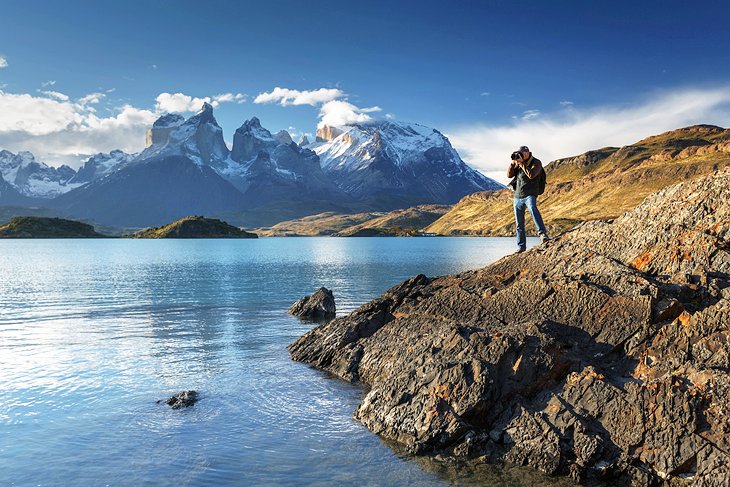
Looking for a hike that will offer you the highlights reel of Patagonia? The five-day W Trek through Torres Del Paine National Park is, perhaps, the most quintessential experience in the south of South America and a rite of passage for any avid hiker. It's also the best trail in Patagonia for solo travelers (or female hikers) as you're guaranteed to meet others along the way to share the journey.
Most visitors enter Torres Del Paine on a bus from the regional hub of Puerto Natales and begin the 71-kilometer W Trek at Refugio Las Torres. Head north from there to hike to the base of Las Torres before swinging back around and heading into the French Valley . Continue onward into the second U of the W and over to the massive Grey Glacier , part of the Patagonian Ice Field.
Once you finish the five-day, four-night trek, you can catch a boat out at either Refugio Paine Grande or Refugio Grey. Keep in mind that, in Torres Del Paine, it's not uncommon to experience four seasons in one day. In fact, plan on it!
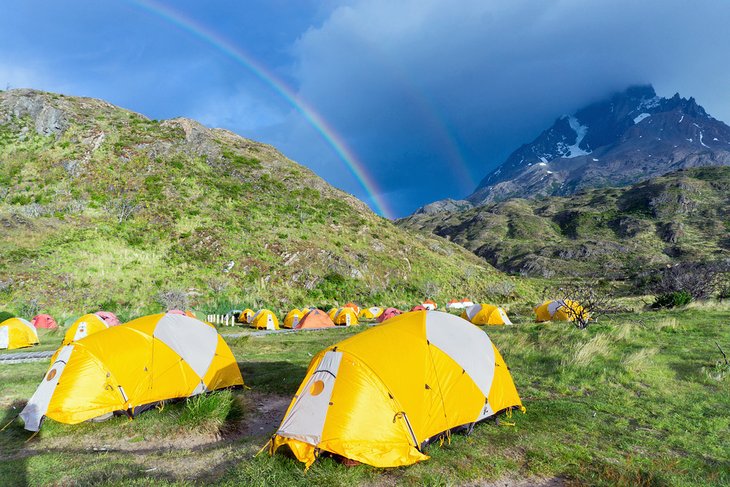
You can make this once-in-a-lifetime experience as rustic or luxurious as you like by carting all of your own camping gear on your back and sleeping at the campgrounds or bunking-up in Refugio's, where bedding is provided and cooks can set you up with three meals a day.
The luxurious option is to take a lodge-based guided tour, where you'll still see all the highlights of the W Circuit but at the same time enjoy comfortable beds, hot showers, first-class dining, shuttles, and kayaking excursions. As an added bonus, you only need to carry a day pack, not a heavy backpack with all your gear. If that's outside your budget, it is also possible to make your own trip and combine all the options by camping, staying in a refugio, and living it up at a lodge for a night or two.
Instead of carrying all your camping gear on your back, consider renting equipment that will be all set up for you when you arrive at each location. The gear is good quality, clean, and more than adequate. Make your gear booking through the same companies that operate the refugios.
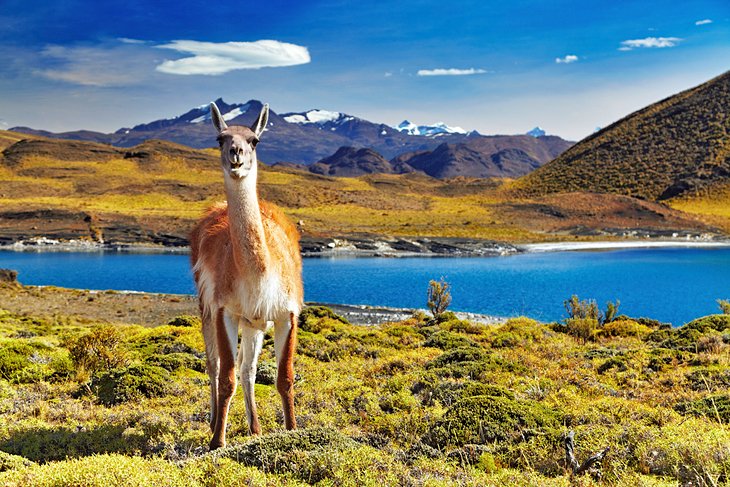
If you want the full-on Patagonian experience that includes the best of the W Trek, and layers on the best of the true backcountry of the region, consider the O Circuit.
This will add an additional 50 kilometers to your hike for a grand total of 136 kilometers. Hikers are limited to 80 per day, and with the incredible vastness of this area, solitude is almost guaranteed.
The trail runs counter clockwise only and starts in Laguna Armarga , where it ascends along the Rio Paine through the Patagonian steppes, and passes beautiful Dickson Lake and the panoramic view of the Perros Glacier near Campamento Los Perrosand. It's at this point, you'll begin the ascent up and over Paso John Gardner . You'll then descend into the far side of the park and begin the classic W Trek.
Accommodation on the remote parts of this trail (i.e. the part that is not included in the W Trek) is in rustic refugios and campgrounds.
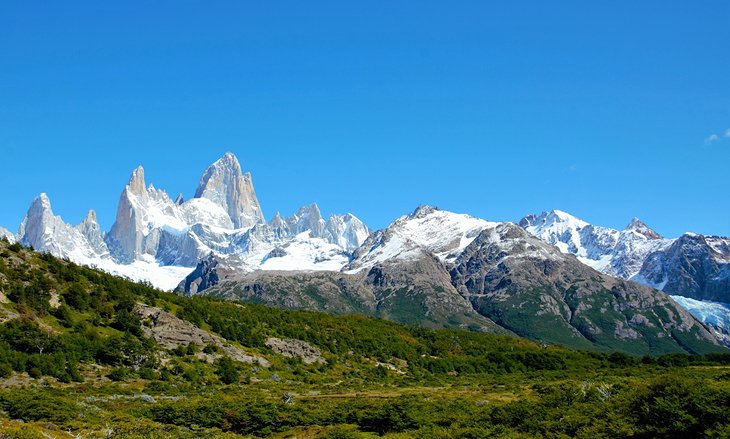
The Carretera Austral is the only artery through Northern Patagonia on the Chilean side of the Andes, but this infamous highway (popular with road-trippers and cyclists alike) peters out in the remote gaucho town of Villa O'Higgins . Not far away as the condor flies is the popular Argentinean resort town of El Chaltén .
So how do you get between the two? First, you'll need to catch a four-hour ferry across the turquoise Lago O'Higgins, stopping to see the impressive O'Higgins Glacier before continuing to the remote Chilean outpost of Candelario Mansilla (home to a police station, campground, and little else). Get your passport stamped out of Chile and continue onward by foot 20 kilometers to the next border post at Lago del Desierto, where you can get an entry stamp for Argentina and camp for the evening. Continue along the edge of Lago del Desierto the following day for 15 kilometers until you reach the southern shores of the lake, where regular buses shuttle tourists to El Chaltén 37 kilometers away.
The entire journey works more or less the same in reverse. You should also keep in mind that it's not uncommon for boats across Lago O'Higgins to be delayed for days due to strong winds that make the crossing unsafe.
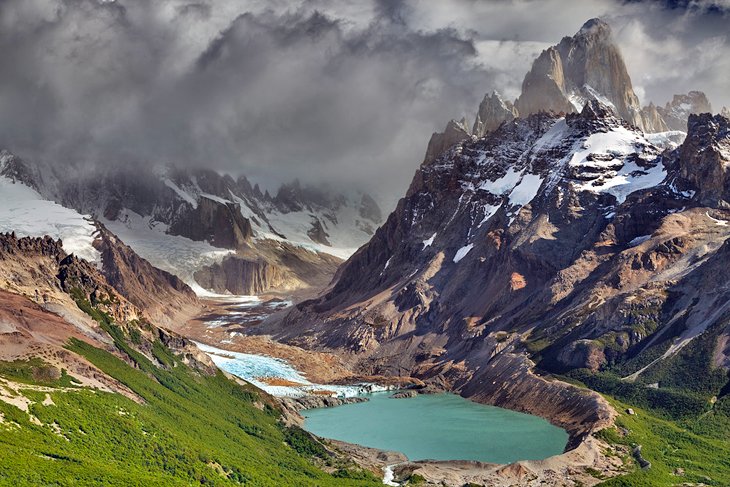
The wind-whipped village of El Chaltén is Argentina's premier trekking capital, with some of the most scenic hikes in South America. The most popular day hike from town, which can be extended into a multi-day hike for more adventurous travelers, is Laguna Torre also known as the Fitz Roy Trek . This 20-kilometer, in-and-out route takes you to several miradores (lookouts) with views of the icy spires of Cerro Torre (3,128 meters).
Much of the path follows the edge of Rio Fitz Roy until you reach the glacial lake of Laguna Torre, where you'll find a small campground. You'll then traverse the edge of the lake to the most stunning lookout of them all, Mirador Maestri, where the icy folds of Glacier Torre fade into the horizon.
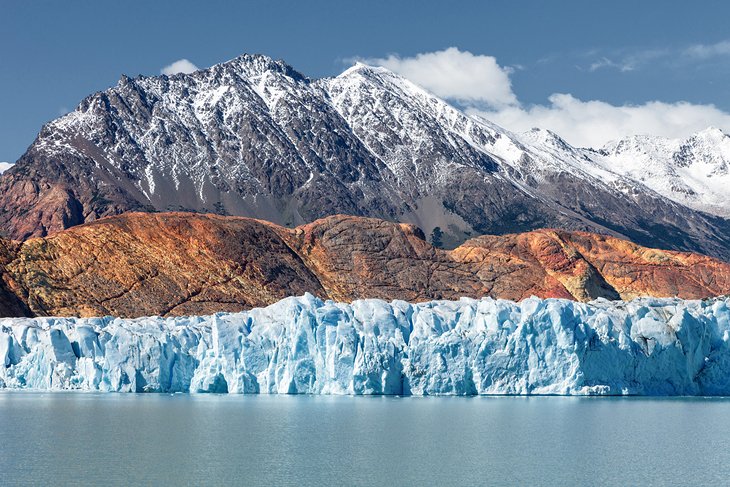
This four-day circuit trek into the heart of Argentina's Los Glaciares National Park takes in native beech forests, high-altitude meadows, and the frozen wonders of the Patagonian Ice Field . Begin in El Chaltén for a 15-kilometer hike to Laguna Toro to camp on day one, before wading across Túnel River and skirting the edge of a sweeping glacier field on day two to camp at Refugio Paso del Viento 12 kilometers later.
Continue circling the jagged peaks of Cerro Huemul on day three for 18 kilometers to camp at Bahía Cabo de Hornos on Lago Viedma, a massive lake formed from the melting ice of Argentina's largest glacier . The final push on day four is a relatively flat 18 kilometers through the Patagonian steppe.
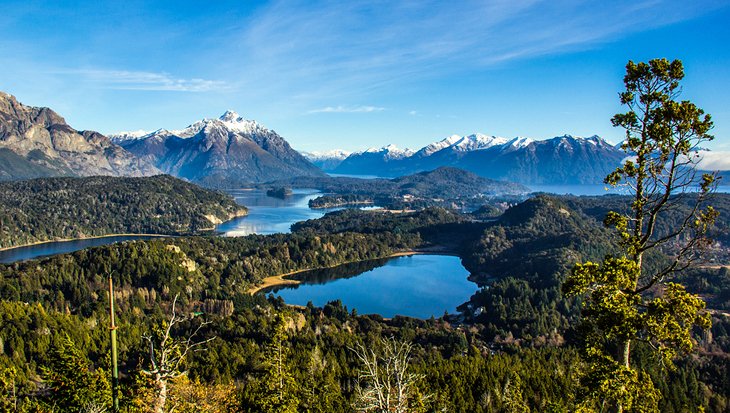
One of the most stunning and well-planned paths through northern Patagonia lies in Argentina's Nahuel Huapi National Park , which surrounds the four-seasons resort town of Bariloche . This four-day hike traverses a number of mountain ridges and lake-carved valleys along the Andean frontier with Chile, and includes overnight stays in shared rooms (with mattresses) at three well-equipped mountain huts. Though they don't have showers, they do have simple bathrooms, and you can take a dip in the cool waters of the lagoons along the way.
Start trekking from the foot of the Cerro Catedral ski area up to Refugio Frey (12 kilometers) for night one. The next morning, you'll walk between the granite towers known as Los Catedrales and on to Refugio Jakob at the edge of Laguna San Martin (9.5 kilometers). Spend night three in Refugio Laguna Negra, 10 kilometers away, before wrapping up the hike 16 kilometers later on day four in Colonia Suiza , a town on the outskirts of Bariloche with chalets that recall the area's early Swiss colonists.
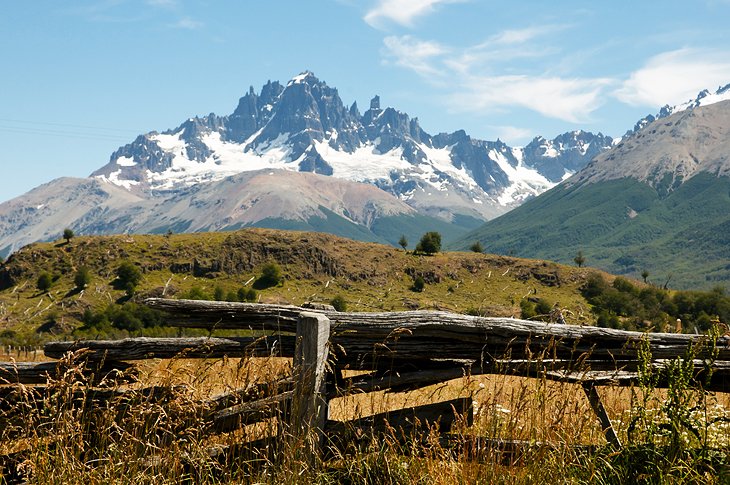
Looking for a lesser-known multi-day hike through Chilean Patagonia? The 43-kilometer Cerro Castillo Circuit offers the same wow factor of the W Trek (above) without the crowds. In four arduous days, you'll circumnavigate the castle-like spires of Cerro Castillo, passing glistening glaciers, turquoise lagoons, and endangered huemul deer along the way.
This circuit trail doesn't see a whole lot of traffic throughout the year and is best appreciated on a guided tour for inexperienced backpackers due to some tricky stream crossings and technical mountain passes. Find guides in the service village of Villa Cerro Castillo or the regional capital of Coyhaique 1.5 hours away. Experienced hikers with prior backcountry experience should be fine on their own with a good map.
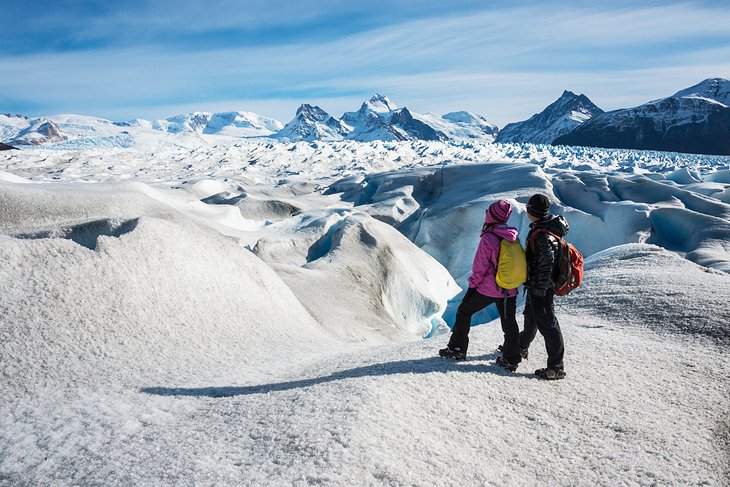
Though not the biggest glacier in Patagonia, Perito Moreno is easily the most famous as it creeps forward up to two meters per day, resulting in thundering roars of cascading ice as it calves truck-sized icebergs into Canal de los Tempanos. This 30-kilometer-long, five-kilometer-wide glacier is the photogenic star of many a postcard and one of Argentina's top attractions luring visitors from near and far.
One of the best ways to experience it is on an ice hike through its frozen contours. Four-hour guided treks onto the ice can be arranged in nearby El Calafate , the main hub for lodgings and tourist services in the southern sector of Los Glaciares National Park . Most tours involve a boat ride from Puerto Bajo de las Sombras and a walk through a lenga forest before you strap on some crampons and take to the ice.
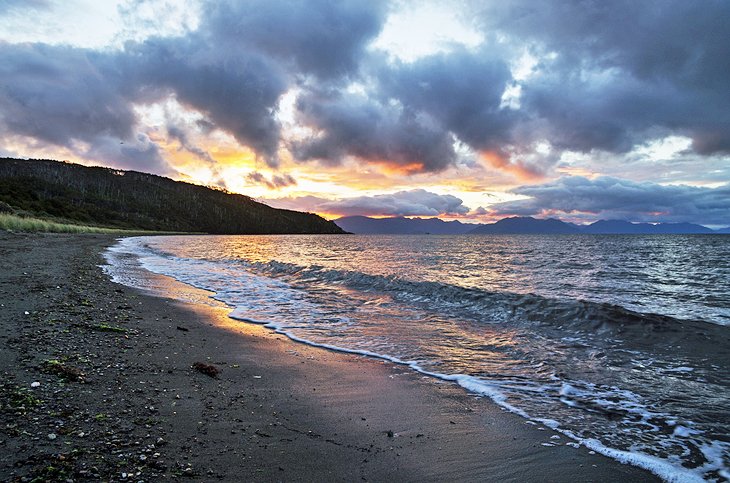
Known as "the trek to the end of the world," this 45-kilometer route skirts the edge of the Strait of Magellan and will take you to the southernmost tip of continental South America . The four-day journey traverses an uninhabited stretch of Chile's Brunswick Peninsula, with incredible views of Tierra del Fuego and Isla Dawson along the way. There's also a high probability that you'll stumble across penguins or see dolphins swimming along the shore, offering an intimate connection to the Patagonian countryside.
You can reach the trailhead in Rio Santa Maria by bus from the regional capital of Punta Arenas , but the hike is extremely challenging, not well-marked, and best done with a proper guide. Try the team at Erratic Rock Expeditions , who helped pioneer this route.

More on Argentina
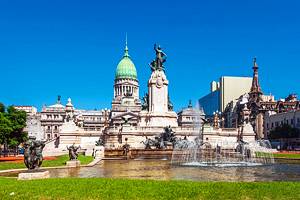

Hiking The W Trek In Patagonia: A Self-Guided Itinerary [2024-25]
09 jul 2024 11 nov 2023 | danielle.
You can choose your own adventure when it comes to trekking in Chile, but if you like to plan ahead, here’s our tried-and-tested 5 day/4 night, east-to-west, self-guided itinerary for hiking the W Trek Patagonia .
Last updated on 9 July 2024 by Dan
Torres del Paine National Park is a place so epic and otherworldly, its name is often spoken with a kind of hushed reverence. This vast and dramatic stretch of Chilean Patagonia is home to some of the most mind-blowingly beautiful scenery on Earth, and hiking the W trek is one of the greatest ways to immerse in it.
This is Patagonian hiking at its very best, but how you trek the W trail is entirely up to you .
You can go with a guide, or do the W trek self guided (in the warmer months anyway). You can stay in lodges and enjoy a cooked meal and a warm bed. You can carry your own gear and pitch your tent in one of the designated campsites along the way, or carry no gear and book a tent at each site. You can carry all your food, or add a half or full board meal package to your booking, or do a bit of both.
We opted to camp but rather than carry all the gear, we arranged for a pitched tent to be waiting for us each day. We packed food for most of the trek and booked a full board meal package (dinner, breakfast and packed lunch) at one of our overnight camping stays.
The direction you hike and the time you take to do the trek is also your call. As occasional hikers with temperamental knees, we opted for the typical self guided W trek itinerary of 5 days and 4 nights .
Many argue that hiking west to east, and saving the striking granite peaks of Las Torres for the last day is a fitting finale to this incredible hike. We took the opposite view though, starting with the awe-inspiring torres and hiking the W trek east to west so that we could tackle the toughest legs of the trail in the first couple of days, while we still had plenty of energy.
At the end of the day, no matter how you take on the W hike, you’re still trekking one of the most spectacular trails on the planet. And you’ll still get to enjoy the jaw-dropping vista of Las Torres. Twice even, if you’re keen.
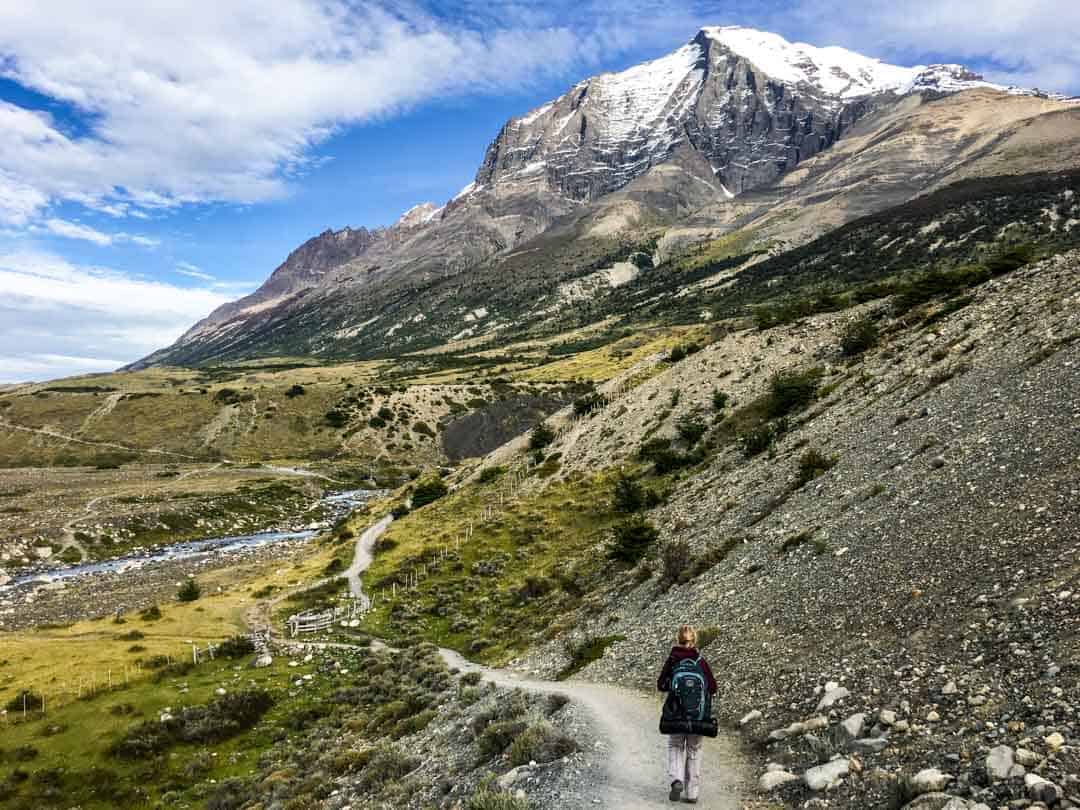
Hiking the W Trek Snapshot Location: Torres del Paine National Park, Chile Nearest town: Puerto Natales, Chile Getting to and from the park: Torres del Paine is easily accessible by bus from Puerto Natales. Park entry: Park entry tickets and overnight stays in the park (campsites and lodges) must be arranged before visiting the park. Start and finish: The W Trek traverses a roughly w-shaped route through Torres del Paine National Park between Refugio Las Torres in the east and Refugio Paine Grande in the west. For this itinerary, we start in the east and hike west. Distance: appx. 74 kilometres (46 miles) one-way Time: This itinerary is 5 days and 4 nights Difficulty: Moderately difficult, with some challenging stretches and steep climbs, plus highly changeable weather. We’re occasional hikers but with some preparation and a reasonable level of fitness, we found the W Trek very do-able (even if all our muscles were screaming for days afterwards!).
What’s in this post?
Preparing for hiking the W Trek Patagonia What time of year is best for hiking the W? Where to stay before and after the trek Entry to Torres del Paine National Park Booking Camping and Accommodation on the W Trail Bus tickets to and from Torres del Paine Packing for the W Trek Our Self-guided itinerary for hiking the W Trail Day 1 – Puerto Natales to Chileno via Las Torres Day 2 – Chileno to Francés Day 3 – Francés to Paine Grande via Francés Valley Day 4 – Paine Grande to Grey Day 5 – Grey to Paine Grande (and return to Puerto Natales)
This post contains affiliate links. If you choose to purchase through these links we may receive a small commission, at no extra cost to you, which helps us to keep this website running. Thanks for your support!
Preparing for hiking the W Trek Patagonia
We aim to fully check and refresh this post for each trekking high season (October to April). Things can change without notice though, so we recommend also visiting the links below for information while you’re planning and before you go:
- For the latest updates on requirements for travel to Chile, visit the official Chile tourism website .
- The W Trek is in Torres del Paine National Park, which is managed by the park agency CONAF. Visit the official national park website for park reports, park entry information and more.
- When you arrive at Torres del Pine National Park and register for your trek, you’ll receive an information guide with a map showing the park’s trails, services and accommodations. The current brochure can be found here .
What time of year is best for hiking the W?
Patagonian weather will keep you on your toes no matter when you visit Torres del Paine National Park. Be ready for everything. However, there are two distinct periods to be aware of when planning your trip.
High Season – October to April
These are the warmer months in the southern hemisphere, and December to March is the busiest time of year to trek in the park, with visitation peaking over January and February. During this period, you can choose to do a self-guided hike or go with a guide .
If you’re travelling in high season, and particularly if you’re planning to visit during the peak months, be sure to reserve your place in the lodges or campgrounds as far in advance as possible . Torres del Paine is now one of the most popular places to trek in Chile and overnight places book up very quickly.
We hiked the W trail towards the end of March, and while sections were busy, like the path to Las Torres, there were stretches where we wouldn’t see more than a handful of people in hours.
That said, despite making our campsite reservations months prior to our visit, we initially struggled to find availability and had to change our trekking dates to suit what we were able to book.
Low Season – May to September
Many people say winter is even more magical in Torres del Paine.
The park entry fee drops during the low season and you’ll find far fewer people in the park. But temps will also be lower, daylight hours are shorter, rain is frequent and there can be snow and ice. Many of the mountain trails are closed, as are a number of the mountain lodges and services. Trails that are open can close suddenly due to weather (though that can happen at any time of the year). Transport services pause over this period as well.
Most importantly, to do the W Trek or hike to the base of Las Torres during the winter season, you must have a qualified guide . This is for visitor safety and the period typically runs from May until August/September. The O circuit remains closed until October. Check the official Torres del Paine website for more information if you’re planning to visit over this time.
The bottom line: No matter what time of year you visit Torres del Paine, given the changeability of the weather there, you should check in with park agency CONAF for latest updates and closures.
Where to stay before and after the trek
The nearest major population centre, and the main jump-off point for a Torres del Paine trek is Puerto Natales , a low-key Patagonian town hugging the shores of the picturesque Última Esperanza Sound.
The drawcard of Torres del Paine’s trails has seen Puerto Natales develop a buzzing trekker scene.
We suggest giving yourself a couple of days in Puerto Natales before your trek to get organised, shop, hire any gear you need, and sort out transport to and from Torres del Paine if you haven’t already (see our section on sorting out bus tickets further on).
Just about everyone staying in Puerto Natales is out and about doing the same thing, so having extra time in town means you can stress less if you don’t find what you’re looking for in the first place you visit.
Spending a couple of days here after your trek is also worthwhile – you can rest your weary bones and enjoy this charming little town.
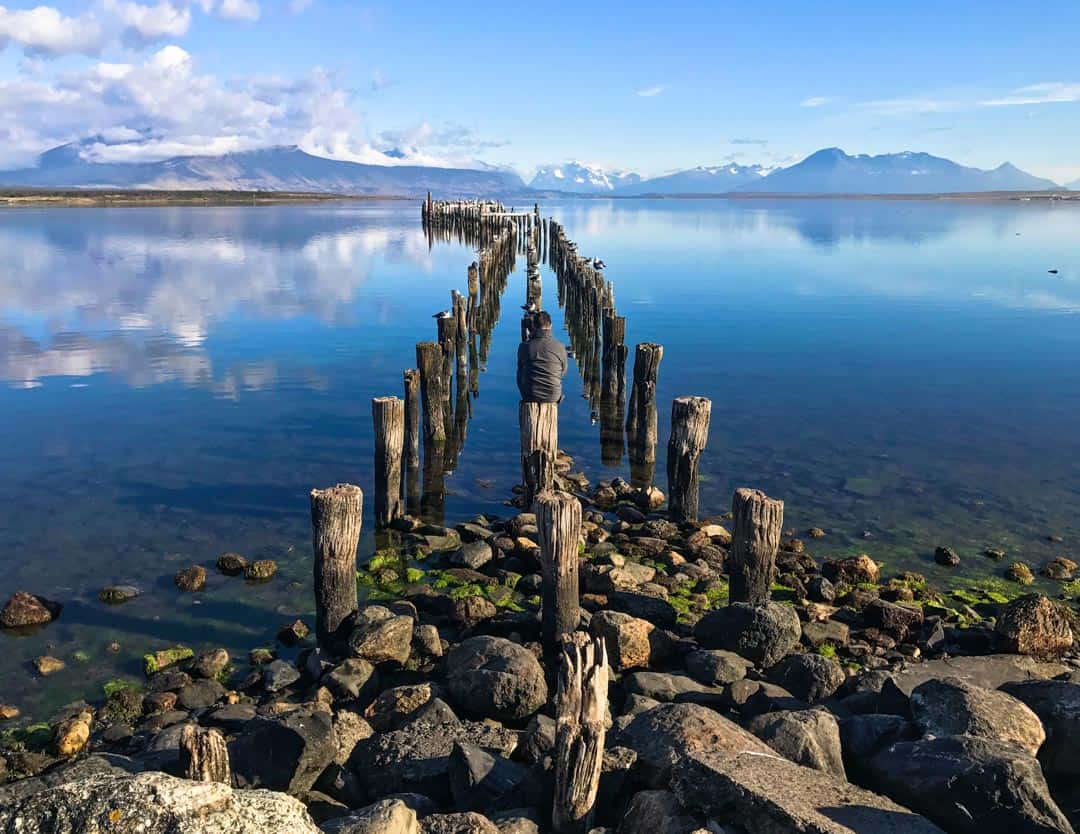
Accommodation in Puerto Natales
Puerto Natales isn’t a big place, but you’ll find everything from budget hostels through to five-star luxury in and around the town.
We stayed at the charming, centrally-located Hotel Aquaterra both before and after our trek. This is a great mid-range option and we really enjoyed our time here. They also stored our luggage for us while we were on the trail.
For more accommodation options like this in Puerto Natales, take a look at Booking.com . Or, if you’re after something more in the budget range, you’ll find various hostel options here .
For a lovely upmarket stay right in the centre of town before or after your trek, check out this place .
We’ve also got our eye on this unique domed apartment for a future trip. It’s about eight kilometres (five miles) out of town, but with the views it serves up, we wouldn’t be moving from the window seats anyway. Perfect for a post-trek, legs-up retreat!
Entry to Torres del Paine National Park
Entry to Torres del Paine National Park is ticketed and there are capacity limits in the mountain lodges and campgrounds. This is for the long-term care and protection of this wild and remote place, and for the safety of visitors to the park. So whether you’re planning to hike the W, trek the O circuit or visit for the day, you will need a ticket to get into the park.
You must buy your entrance ticket for Torres del Paine National Park in advance of your visit to the park. Visit the CONAF website to buy your park entry ticket .
Entry fees vary depending on whether you are Chilean or international, as well as your age, and whether you intend to stay in the park up to, or more than, three days. At last check, international adults 18 and over will pay CLP$31,200 (CLP is Chilean pesos) for up to three days in the park, and CLP$44,500 for more than three days.
Download your ticket to your phone before you head to the park (there’s very limited internet access once you’re there) and carry a printed copy just in case. Bring ID as well to present along with your ticket when you check in at the park.
Booking Camping and Accommodation on the W Trail
There are various ways to stay overnight on the W trek in Torres del Paine National Park, but whether you’re planning a lodge stay, hiring camping equipment, or camping with all your own gear, you’ll need advance reservations to do so.
Overnight reservations are mandatory for Torres del Paine and, like park entry tickets, need to be made in advance . You cannot book camping or accommodation once you’re at the park, or camp outside the designated bookable camping zones.
You’ll also need to carry evidence of your overnight reservations as you may be asked to show proof at any time by a park ranger or when passing through checkpoints. We printed our reservation confirmations and carried these with us.
With Torres del Paine trekking becoming ever more popular, limited accommodation spots and advance booking necessary, sorting out campsites or lodge accommodation is – in our experience – probably the trickiest part of planning a self guided W trek itinerary.
For this reason, we recommend booking your overnight stays as far in advance as possible , preferably as soon as bookings open for the season.
It also pays to be flexible about where you stay, as you may find you need to rework your trekking dates and approach based on what’s available.
Our final W trail hiking itinerary was the direct result of where and when we could get an overnight booking.
How to book your overnight stays in the park
There are a number of mountain lodges (refuges) and campsites in Torres del Paine, and you can only stay overnight in these designated zones.
Broadly speaking, the zones in the east are managed by Las Torres Patagonia (formerly Fantástico Sur) and those in the west are managed by Vertice Travel .
There also used to be a couple of free campgrounds in the park managed by the Chilean park agency, CONAF. However, these campgrounds have been closed for several years now. Visit the CONAF website for updates.
You can book campsites and refugio beds direct via the Las Torres Patagonia and Vertice Travel websites, however we know from experience that trying to align availability and book spots for a workable W circuit itinerary across different websites can be complicated and time-consuming. Another reason to plan well ahead.
We’re also aware of a website called Booking Patagonia, which offers an integrated booking system for travel, tickets and accommodation for Torres del Paine.
If you’re keen to go self-guided on the W, but you’d like to have someone else sort out the logistics of your trek, including transport, accommodation, meals and camping gear, check out these two options offered by Flashpacker Connect: 5-day W Trek self-guided camping trip and this 5-day W Trek self-guided refugios (lodges) trip .

Bus tickets to and from Torres del Paine National Park
We based ourselves in Puerto Natales, the nearest town to Torres del Paine, before and after our trek and most travellers do the same. From Puerto Natales, it’s an easy bus trip to and from the park.
If you’re travelling by bus, we recommend organising your bus tickets to and from Torres del Paine well in advance . Don’t leave this until the day you head to the park or you may find the buses already full.
If you plan to buy your tickets when you arrive in Puerto Natales, aim to do so as soon as you arrive in town. You can buy bus tickets at the main bus station (Terminal Rodoviario), or through your hotel or hostel. We travelled to Puerto Natales by bus so we bought our tickets to Torres del Paine at the bus station the day we arrived. You can also search bus services and buy tickets online here .
It’s important to note that your bus drop-off/pick-up points at the park may vary depending on your final W trail itinerary, so keep this in mind when booking your bus ticket.
If you follow this itinerary and trek from east to west, you’ll start with the bus from Puerto Natales to Laguna Armaga . After your trek, you will board the bus at Pudeto for the return journey to Puerto Natales (this follows a catamaran ride across Lake Pehoe to Pudeto from Paine Grande). Vice versa if you’re hiking the W from west to east.
To ensure you’re on the trail in good time (and in line with this itinerary), we recommend booking one of the earliest buses out of Puerto Natales on Day 1.
Packing for the W Trek
Any hike, but especially a multi-day hike, can quickly lose its appeal if you’re carrying too much weight in your pack; something we can personally attest to. So we strongly recommend packing light and only carrying the clothes, gear and food you need for the trek.
If you’re travelling longer term and have more stuff with you – which was our situation – leave it in storage at your hotel. Your back will thank you for it.
You can find most of what you need to buy or rent in Puerto Natales for hiking into the surrounding landscapes, from sleeping bags, camping stoves and hiking poles to dried fruit and nuts for your trail mix.
That said, this is a small and relatively remote town and the local prices reflect it. We’re told there’s more choice and better prices at the supermarkets and shops in Punta Arenas, so if you’re coming from or via Punta Arenas, you might consider doing your trek shopping while in that town.
We’ve also read reports that it hasn’t been so easy to find dehydrated meals in Puerto Natales. If you’re planning your menu around these, you might think about sourcing them elsewhere.
It’s important to know that Chile has stringent rules around what foods you can and can’t bring into the country (fresh foods, fruits, honey, etc are a no-no). Be sure to declare any foodstuffs you do bring in and plan on buying most of what you need for trek meals and snacks once you’re in the country.
We had a tight meal plan for our spin on the W, but with hindsight, we would swap out some of the bulkier food stuffs we packed for lighter, more compact foods. Next visit, we’ll be looking to pack some dehydrated camping meals and light-weight but filling carbs like cous cous and oats.
The night before the trek, organise any food you’re carrying into daily packages of brekkie, lunch and dinner. Pre-bundling your meals saves scrabbling around in your pack for particular items on the trail). Then pack all the gear you’ll be taking with you in waterproof bags inside your backpack.
Cash, pesos or credit card? One question we get asked is whether to carry US dollars or Chilean pesos into the park, and whether the refuges accept credit cards. We carried all three. We paid for some things in pesos, like snacks and the shuttle to the trail head, and other things in USD, like the catamaran from Paine Grande to Pudeto. We also used our credit card at one of the refuges to buy drinks. It’s our understanding that all of the refuges accept credit cards.
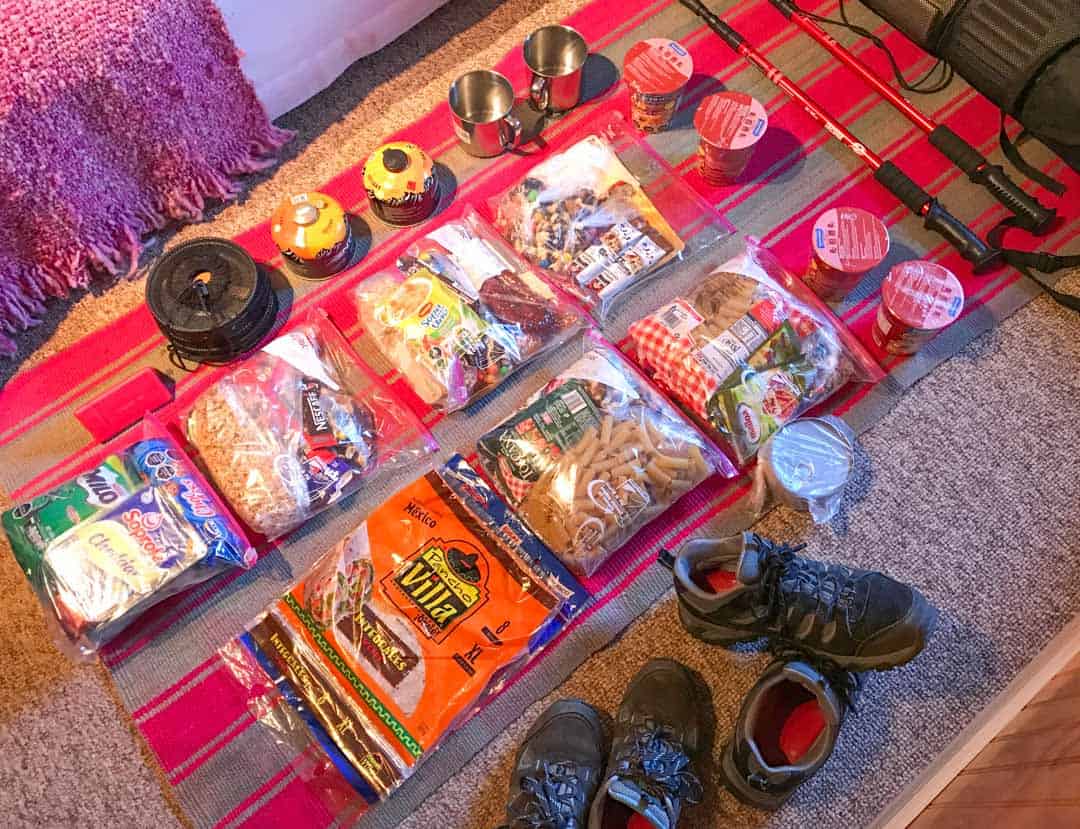
Our self-guided itinerary for hiking the W Trail
Day 1 – puerto natales to chileno via las torres, total distance: appx. 13.8 km (8.5 miles) total time: appx. 8 hours overnight: camping chileno.
Let’s get trekking! Hopefully you’ve secured your seat on one of the earliest buses out of Puerto Natales this morning (see above regarding buying your bus tickets in advance).
Buses making the run to Torres del Paine National Park generally depart from Terminal Rodoviario in town. Find your bus and load your pack, then kick back until it’s time to go. It’s around two hours to Laguna Amarga, the gateway to Torres del Paine National Park, so settle in, this is a perfect excuse to grab some extra sleep before starting the hike.
When you arrive at the Laguna Amarga Ranger Station, have your pre-purchased park entry ticket ready on your mobile phone or bring a printout. Here, you’ll check in and receive information about visiting the park, and its rules and regulations.
Don’t forget to buy your entrance ticket for Torres del Paine before you head to the park . Head to the CONAF website for more information .
At Laguna Amarga, hikers split into two groups: those starting their journey here at the eastern end of the park, and those heading to the western starting point at Paine Grande, which involves a further bus trip to Pudeto and a catamaran ride across Lake Pehoé (even if you’re hiking west to east, you’ll get off the bus here to check in before reboarding the bus for Pudeto).
If, like us, you’re hiking the W from east to west , your next step after check in is to jump aboard the Hotel Las Torres public shuttle bus from Laguna Amarga to the Welcome Centre and the eastern starting point of the trek. This costs around US$5 per person and is paid in cash as you board (we paid this in pesos).
Alternatively, you can start your hike here from Laguna Amarga. The shuttle will just spare you a dusty seven kilometre walk along the gravel road.
There’s a toilet at Laguna Amarga, and another at the Welcome Centre. This is a good chance to go before setting off into the mountains.
Trekking tip: We booked our first night’s accommodation at Camping Chileno, which is en route to today’s main destination – the towering granite peaks of Las Torres. We’ll be checking in at Chileno on the way and dropping off our packs ahead of the steep and challenging climb to the Las Torres mirador. If, however, you’ve booked your first night at Hotel Las Torres or Central Refuge and Camping, then we’d suggest dropping off your packs there first, and setting out on today’s hike to Las Torres with a lighter load.
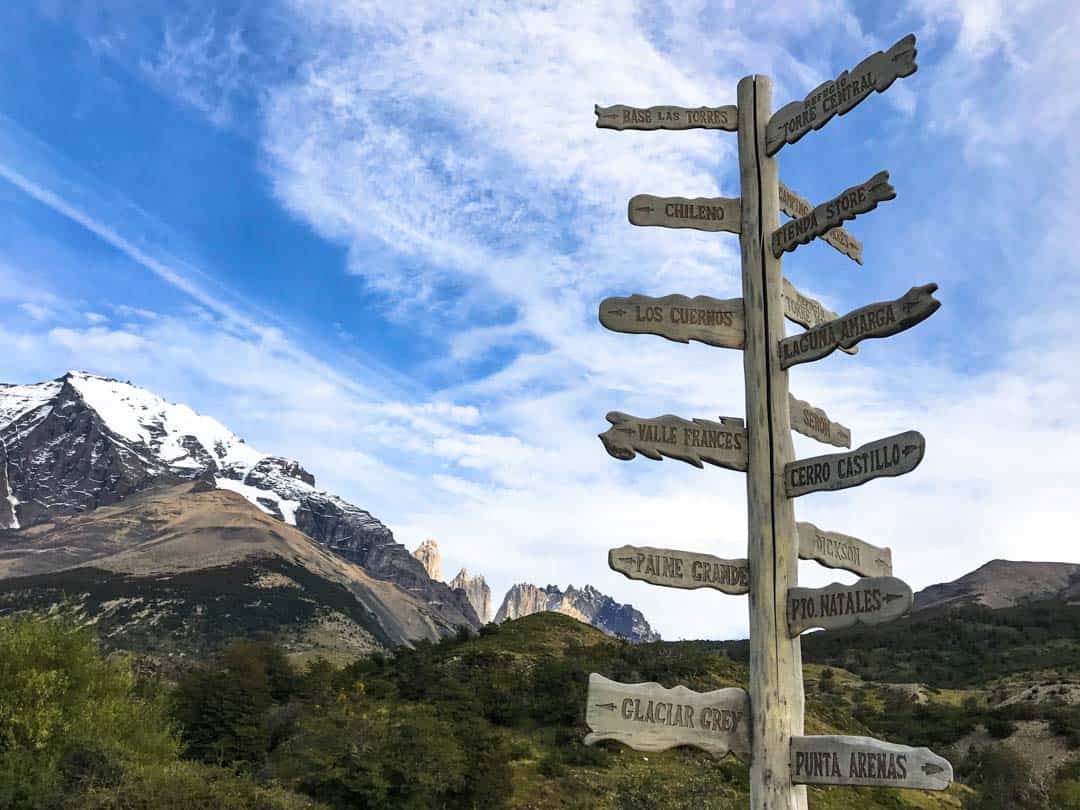
1st Leg: Hotel Las Torres to Chileno ( appx. 5 km / 3.1 miles, around 2 hours)
We’re officially underway on the W trail around 10.30am and from the word go, the views are eye-popping. After a flat kilometre or so, the path starts to climb: get used to it, it’s pretty much uphill from here.
The hike is moderately steep in some spots, until about a kilometre (0.6 miles) or so from Camping Chileno, where the trail flattens out a little before descending into the campground.
Despite feeling like our hearts might explode for much of this first stretch, we cover the distance in around two muscle-busting hours, with frequent stops to take in the views, rehydrate, and give our racing pulses a break.
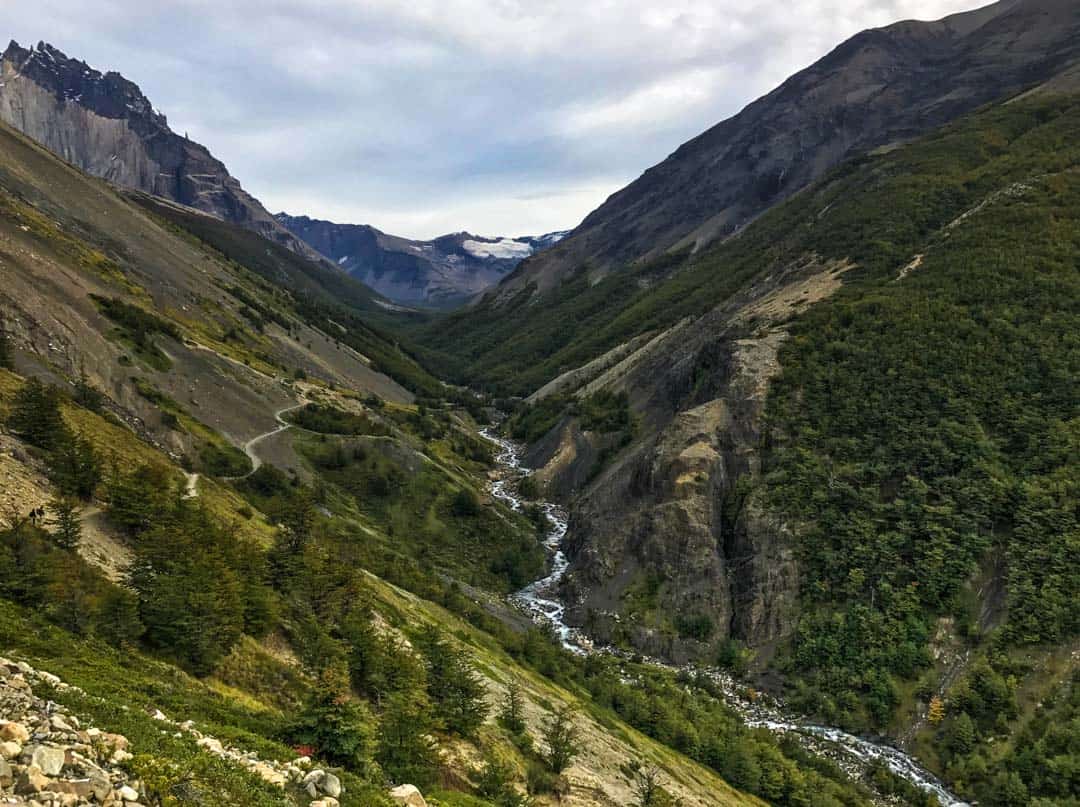
Drinking water There’s no need to lug extra water with you on the Torres del Paine circuit. You’ll pass pristine mountain streams regularly throughout your journey. Bring a water bottle, fill up at nature’s tap and enjoy some of the purest water you’ll ever drink. Just remember to top up well away from the camps and upstream of the trails.
We haul our packs into Chileno around 12.30pm . This campground is operated by Las Torres Patagonia (formerly Fantástico Sur), and is the closest camp you can stay at to the famous Las Torres hike and mirador (the CONAF-managed campground near the base of the Las Torres climb has been closed for some time).
The riverside setting at Chileno is truly stunning and the sheer peaks of the three granite towers – our ultimate goal today – rise tantalisingly above the forested mountains ahead.
The campground itself is a nice set-up of tiered camping platforms among the trees. There are shared bathrooms with hot showers, and a restaurant and bar with big windows, plus an outdoor terrace for soaking up the epic views.
Our tent is ready for us when we arrive at Chileno, so we check in, drop our bags in our tent, grab a smaller pack with snacks, water bottles and cameras, eat the lunch we prepared last night, and set out for Las Torres around 1.30pm . Timings here may vary depending on your check-in.
2nd Leg: Chileno to Las Torres (appx. 4.4 km / 2.7 miles, around 2 hours)
This is without doubt today’s toughest leg, so there’s a huge bonus in not having to tote your full pack up the mountain.
From Chileno, you’ll hike for around 3 kilometres (1.9 miles) or so along a meandering path through pretty woodland, across rushing rivers, and through a wonderfully moody stretch of fallen forest that we dub the ‘tree cemetery’. It’s a lovely, moderate walk, and we have no sense of what’s ahead when we reach the sign that tells us ’45 minutes to Mirador Las Torres’.
My notes from this point in our trek simply state: ‘hiking hell starteth here’. A touch dramatic maybe, but as irregular hikers, this was probably the hardest section of the entire W for us. Maybe you’ll breeze through it, just be ready for it.
Shortly after the sign, the climb to Las Torres begins in earnest. It’s a gritty, rocky terrain of steep, gravelly inclines and large boulders. The panoramas as you climb are absolutely breathtaking, but so is the hike itself. There are moments while we’re in the throes of it, looking up and spotting the tiny trekkers far above, that this stretch feels like it will never end.
It does end though, about an hour later, and the scene that awaits as we round a final boulder and face the towering granite pillars of Las Torres makes every single breath-wrenching step worth it.
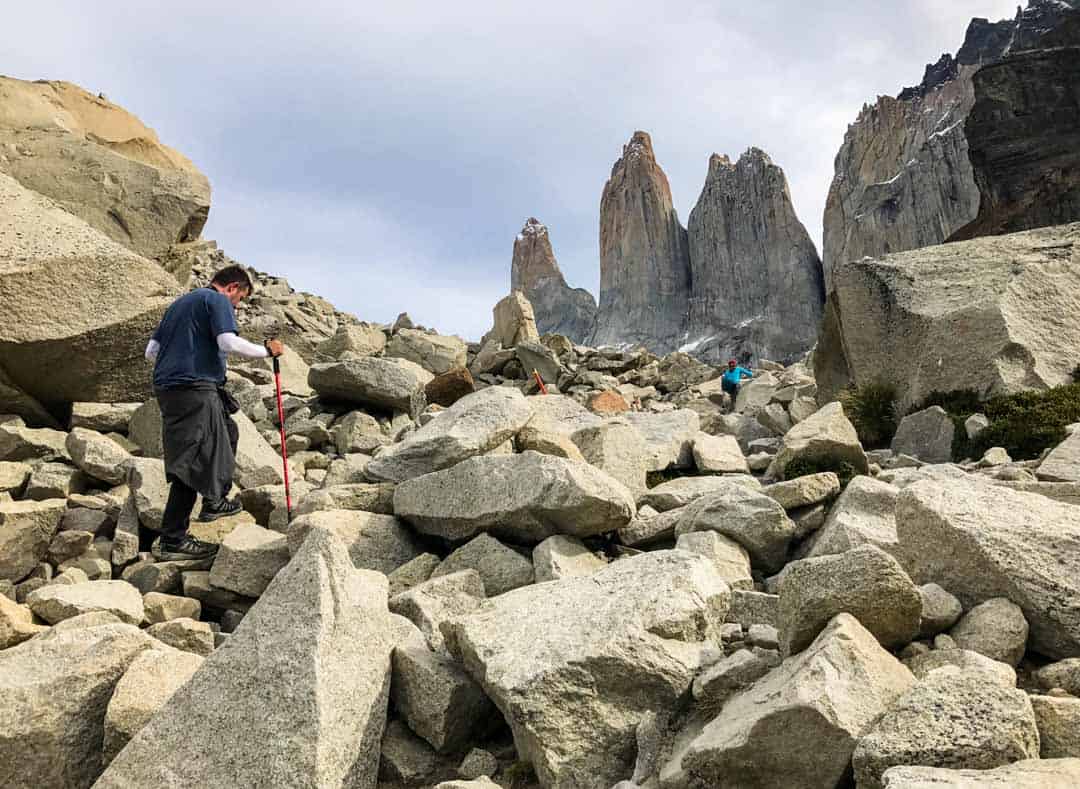
It’s buzzing at the top: hikers drape the rocks surrounding the glacier lake; a bushy-tailed Patagonian fox weaves its way between the boulders; there’s even a guy getting his hair cut at the water’s edge (one hairdresser’s quirky approach to memorialising his travels while promoting his business).
We spend some time taking pics before settling onto a boulder of our own to simply take in this awe-inspiring scene. Aim to spend around an hour at Las Torres .
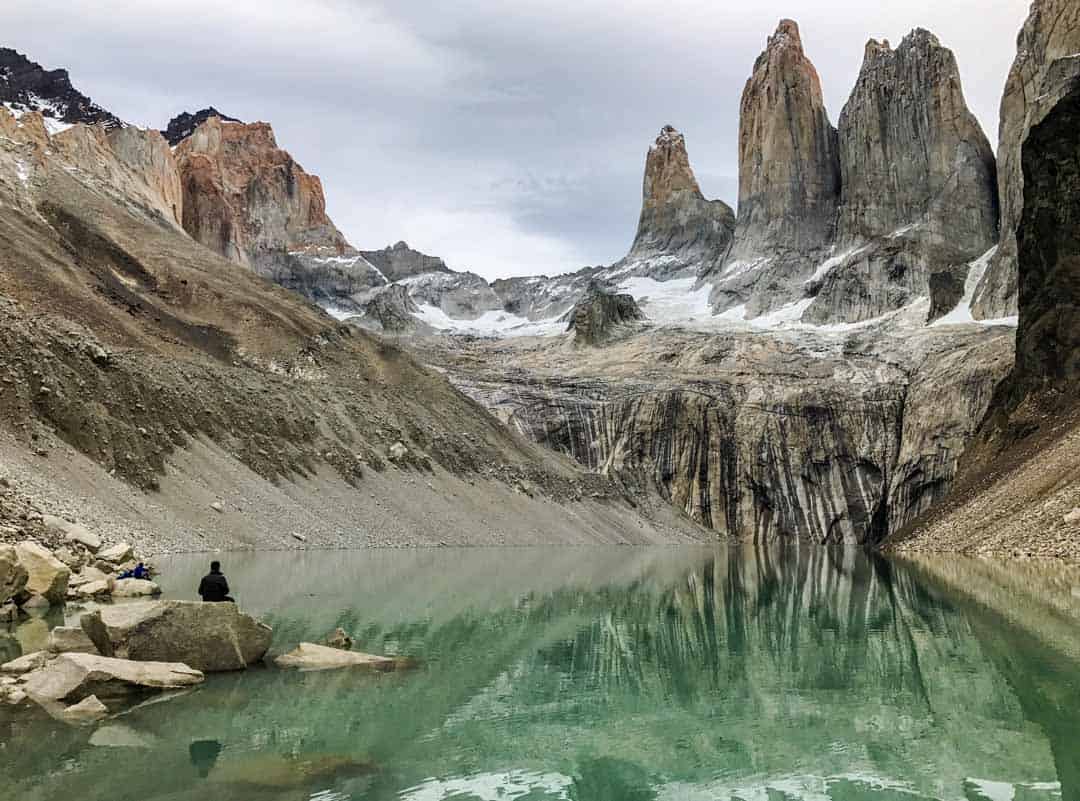
3rd Leg: Las Torres to Chileno (appx. 4.4 km /2.7 miles, around 2 hours)
The journey back down from Las Torres is in some respects even more challenging than the climb up. The constant down is tough on knees and the gravel makes the going slippery. We’re beyond grateful for our hiking poles, though we both still manage to pull off some memorable butt slides.
Trekking tip: Hiking poles made all the difference for us when we were trekking in Patagonia. We carried one each, which was ideal as it left us both with a hand free to grab branches and rocks, haul each other up and down, and catch our fall when we slipped. Which was often.
It takes us around two hours to get back to Chileno; we have time to shower, buy a couple of well-earned beers and watch the sunset burn the tips of Las Torres molten gold.
It was cloudy the entire time we were up at the base of the towers, so watching them all beautifully backlit now is a bit of a kicker, but if there’s one thing you’ll learn quickly hiking the W Patagonia, it’s that the weather doesn’t give a rats what you think.
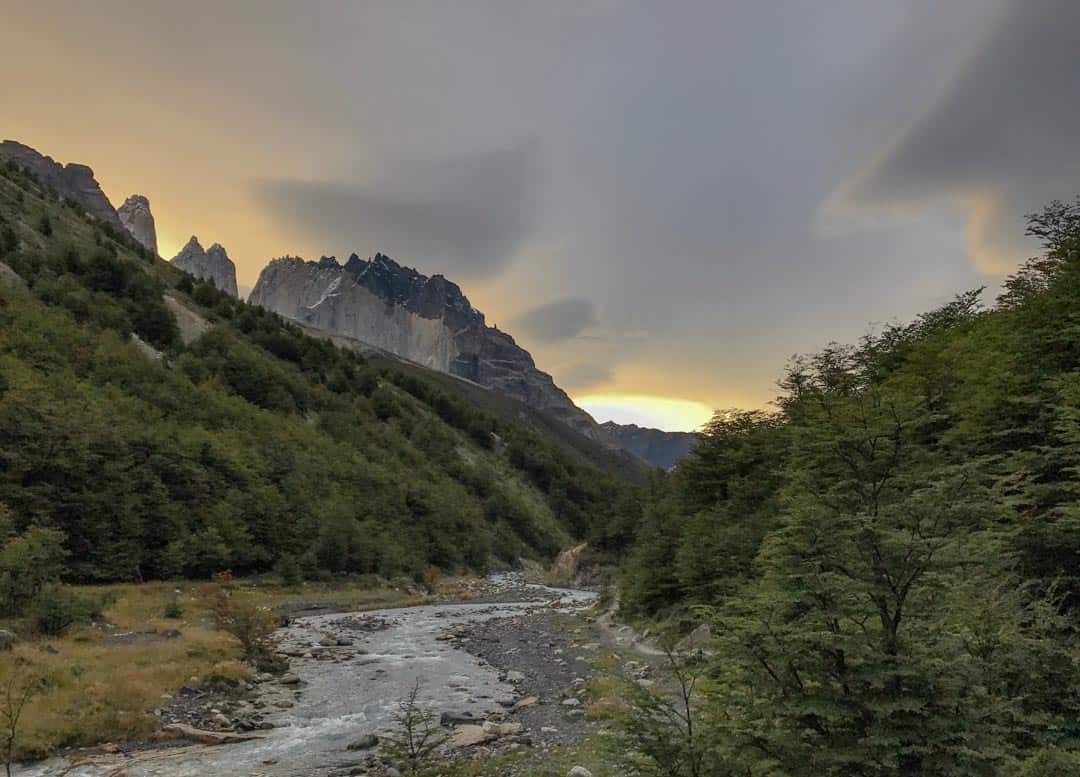
Preparing for Patagonian weather If there’s one constant about the weather in Patagonia, it’s that there’s nothing constant about it. We were particularly lucky on our five days in Torres del Paine, but you should be ready for four seasons in a day. Layer up, have a rain jacket handy, and wear quick-dry clothes. Skip a rain cover for your bag though. While we never experienced the legendary winds that tear through the park from time to time, we heard plenty of stories of pack covers being whipped off suddenly and disappearing into the wilds. Expect to get rained on, and pack your gear in bag liners or waterproof bags inside your backpack instead.
Cooking stoves are not allowed to be used in the Chileno zone, so we opted for the full board food package here, which includes dinner tonight, breakfast tomorrow and a packed lunch to take with us.
Later in the evening, we join a host of other hikers in the restaurant for a surprisingly tasty and filling three-course meal full of protein and carbs.
We’re absolutely wrecked by the end of dinner, and we’re tucked up in our sleeping bags by 9.30pm.
Sunrise at Las Torres When we originally planned our itinerary for hiking the W, we had every intention of doing a second trek to Las Torres for sunrise on Day 2. In late March, this would have entailed getting back on the track up the mountain by 5.30am . As we climbed into our sleeping bags that first night though, we decided to pull the pin: we were just too tired, and we were also a little wary of making the tricky climb in the low dawn light.* It was a tough call at the time, and it didn’t help when we poked our heads out of our tent the next morning to see the stone towers erupting with golden light above the silhouetted foreground. As we watched though, the clouds rolled in and soon enough the peaks were shrouded in mist. There’s no accounting for Patagonian weather, or how your body may feel after a long day of hiking. The best you can do is plan, and be flexible on the day. *PS. For safety reasons, hiking in the dark isn’t actually allowed in Torres del Paine. Trail sections have opening and closing times, check the park brochure for more info.
Day 2 – Chileno to Francés
Total distance: appx. 18 km / 11.2 miles total time: appx. 6 hours 45 minutes overnight: camping francés.
Sunrise is around 8am when we do the W trek in late March, and as we haven’t made the dawn hike to Las Torres, we enjoy a more leisurely start to the morning on Day 2.
If you do decide to do the dawn hike up to Las Torres for sunrise, factor in around five hours this morning and adjust the following timings for today’s next legs accordingly.
As breakfast is part of our full board package at Camping Chileno, we pack up our gear and head to the dining room at 8.30am for a hearty kickstart to the day.
1st Leg: Chileno to Los Cuernos (appx. 15 km / 9.3 miles, around 4.5 hours)
We’re on the trail by 9.15am , heading back towards Hotel Las Torres. We won’t be going all the way to the hotel though as there’s a shortcut off to the right around half-an-hour after leaving Chileno. The shortcut is signposted and takes you along a mostly downward sloping path surrounded by undulating hills and lake views.
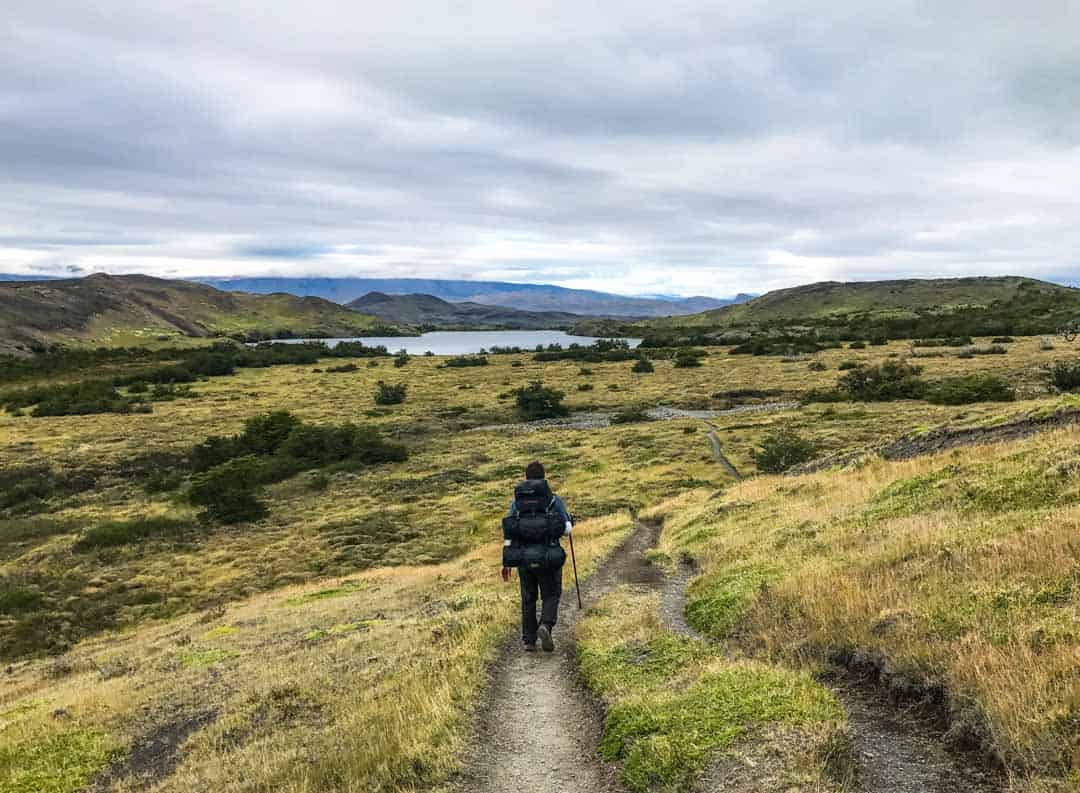
We reach the end of the shortcut and rejoin the main W route around 11am . At some point after this though, we suddenly find ourselves in what can only be described as the Patagonian Swamps of Mordor and we start to wonder whether we’ve veered off on to a secondary trail by mistake.
We can still glimpse the Nordernskjöld Lake off to left, and we know the official trail travels alongside it. To this day, we’re unsure if we did actually go off piste (though the number of bootprints in the mud suggests not).
Eventually, we seem to be back on track according to the map, just a little muddier for the experience (and even more grateful for our depth guage hiking poles).
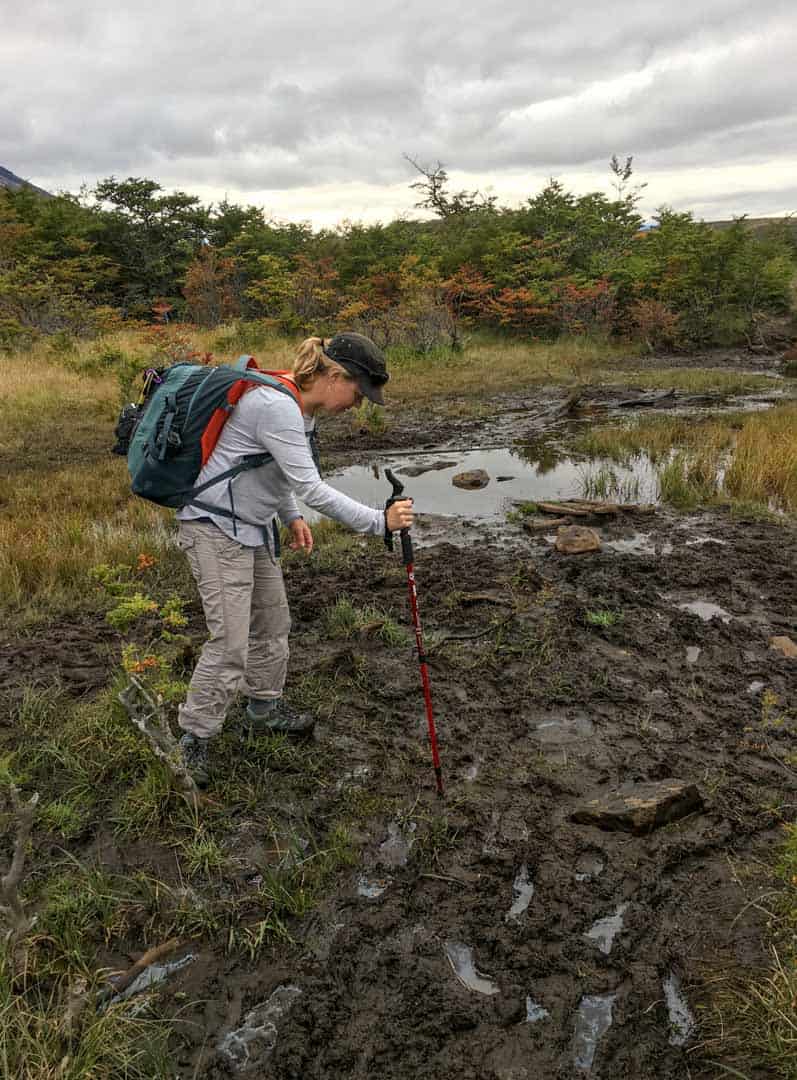
The next stretch travels up and down through very pretty lakeside country, with the occasional steep section, before passing down into the valley at Los Cuernos. We arrive at the Los Cuernos shelter and camping area around 1.45pm .
You could stop at any point along the stretch to Los Cuernos for a lunch break; we stop just past the shelter and find a nice rock with a view. We opted for the full board meal package with Camping Chileno so we’ve been provided with a packed lunch today as part of this.
We chill for around 45 minutes and then set off around 2.30pm for Camping Francés , where we’ll be staying tonight.
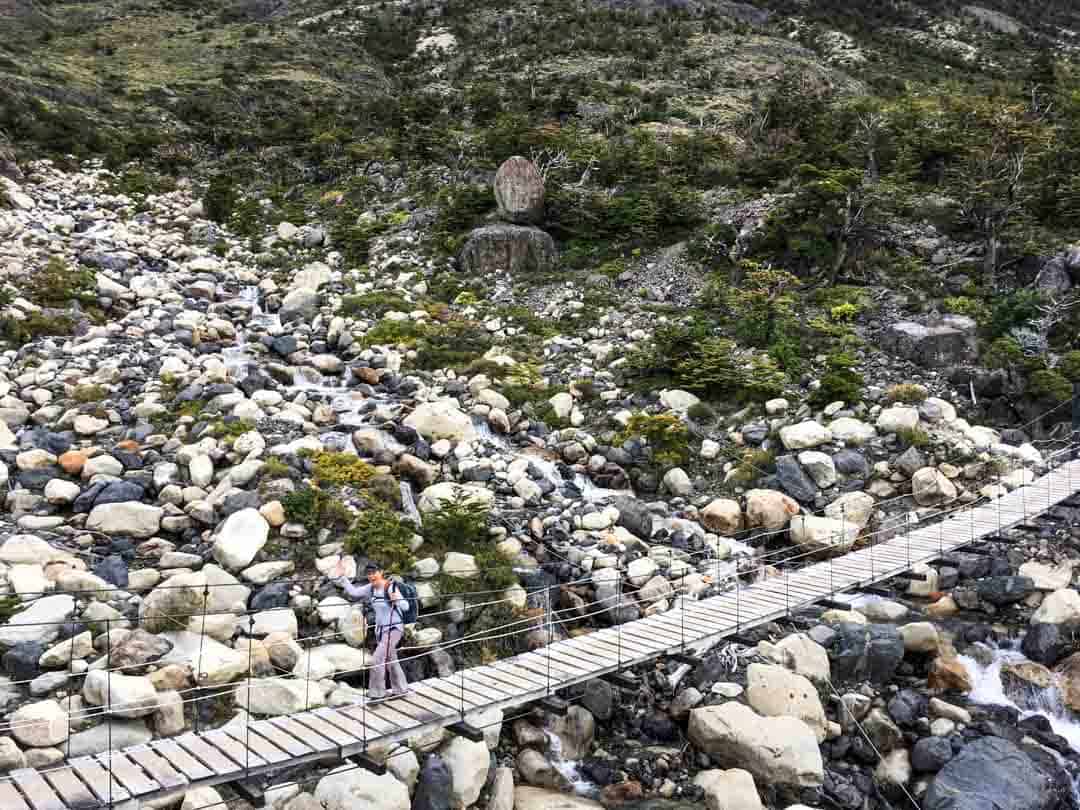
2nd Leg: Los Cuernos to Francés (appx. 3 km / 1.9 miles, around 1.5 hours)
The trail to the Francés campground is up and down and rubbly, with some steep sections, and a pretty pebbly beach crossing. Today’s walk has been positively sedate compared to yesterday’s heart-starter climbs, but never fear, a leg-burning rise awaits just before the descent into the camp.
We arrive at Camping Francés around 4.00pm . The campground here is run by Las Torres Patagonia (formerly Fantástico Sur).
The tent platforms are clustered between the trees and there’s a good shower and toilet block a short walk from the campsite. There’s also a small shop with basic amenities.
By 5.15pm we’re checked in and set up on our platform. We’ve arranged for a tent at Camping Frances but we’re cooking our own food tonight.
Sunset is close to 8pm in late March, and having made it through our second day on the W trail, we’re zipped up in our sleeping bags soon after.
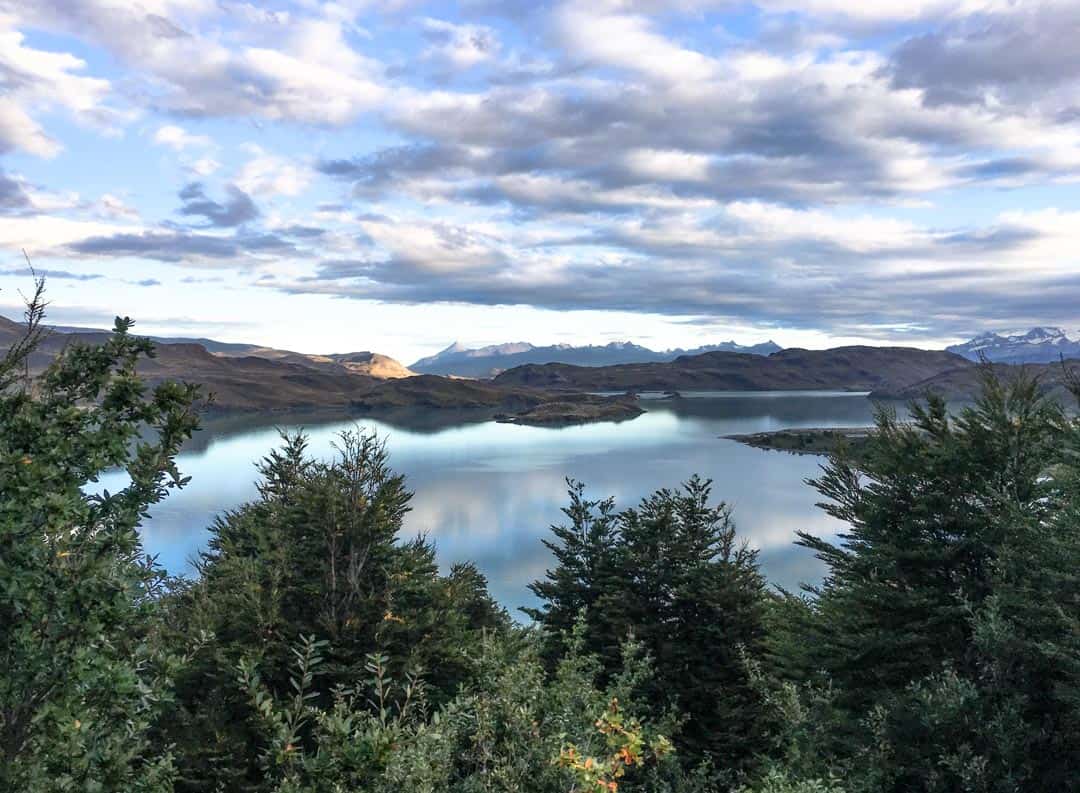
Day 3: Francés to Paine Grande via Francés Valley
Total distance: appx. 20.3 km / 12.6 miles t otal time: appx. 9 hours overnight: camping paine grande.
Despite our fatigue, neither of us sleeps particularly well on our second night and we’re both groggy when the alarm goes off at 7am.
Our restlessness is partly due to the strange soundtrack that has accompanied us throughout the night: sharp cracking sounds like distant shot gun blasts and deep, thunderous rumbles. It’s not until we set out on the trail through the Francés Valley today though, that the source of the unnerving noises becomes obvious.
On this itinerary, today is the longest day hiking the W, and based on our experience, we recommend getting on the trail by 8am at the latest to maximise your time in the Frances Valley. We departed later when we trekked, so we’ve adjusted the timings below to suit an earlier start.
1st Leg: Francés to Italiano Ranger Station (appx. 2 km / 1.2 miles, around 30 minutes)
The first leg this morning is a rejuvenating, 30-minute leg-stretcher to Italiano Ranger Station. Aim to pack up and set out from camp by 8am.
There’s a ranger at the Italiano Ranger Station when we arrive. He points to some racks opposite the office building; this is where we opt to leave our backpacks ahead of the challenging hike into Francés Valley.
We sort our valuables and lunch into a smaller daypack, lock up the big packs, and get going again. Look to be back on the trail by 8.45am .
2nd Leg: Italiano Ranger Station to Británico Lookout (appx. 5.4 km / 3.4 miles, around 3 hours)
The first kilometre (0.6 miles) out of Italiano is a flat trail through pleasant forest, after which the track starts to climb steeply through a rocky, rubbly stretch.
The scenery is seriously beautiful, serving up views of the ironically named Paine Grande Hill – 3,050 metres above sea level – and the Francés glacier that clings to it. This is the source of the crackshots and grumbles we’ve been hearing as the hanging ice shifts, melts and avalanches down the mountain.
Soon enough, you’ll reach the Francés mirador, a lookout offering spectacular panoramas over the ‘hill’ and its glacier; this is the perfect spot for a short break and a snack, as the next stretch is tough.
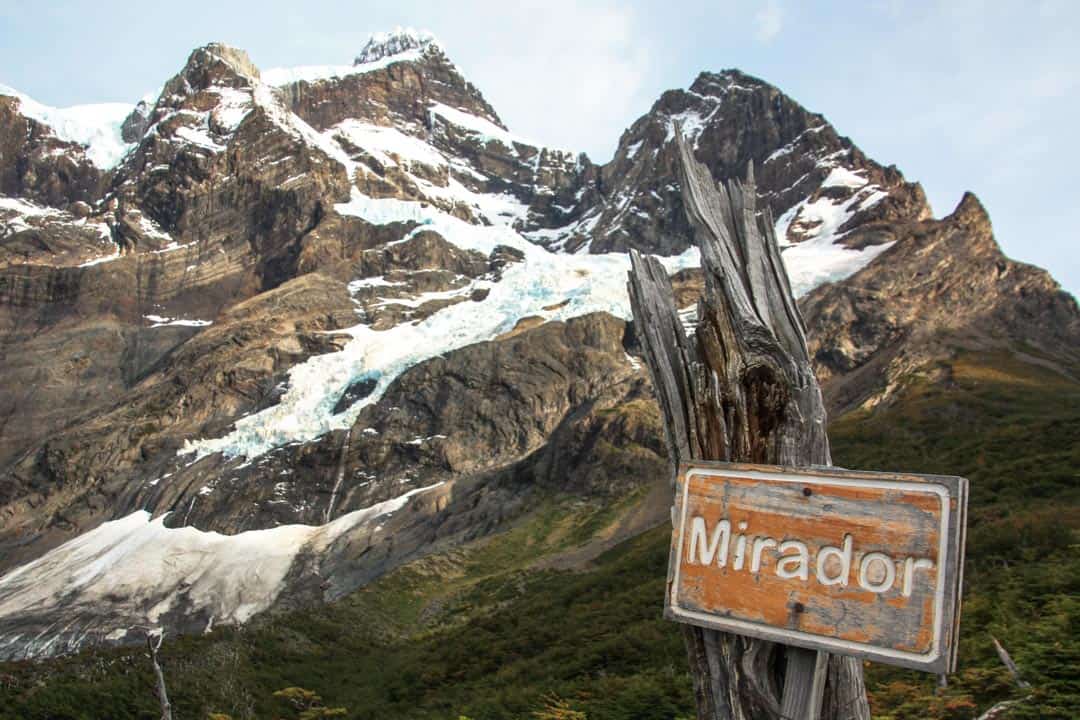
From here, the trail to Británico Lookout is a challenging, rubble-strewn boulder dash with lots of climbing.
A flat, rocky clearance scattered with the parched white trunks of dead trees and overshadowed by the jaw-dropping Cuernos massif, marks the final stretch before a steep, 10-minute climb to the mirador itself.
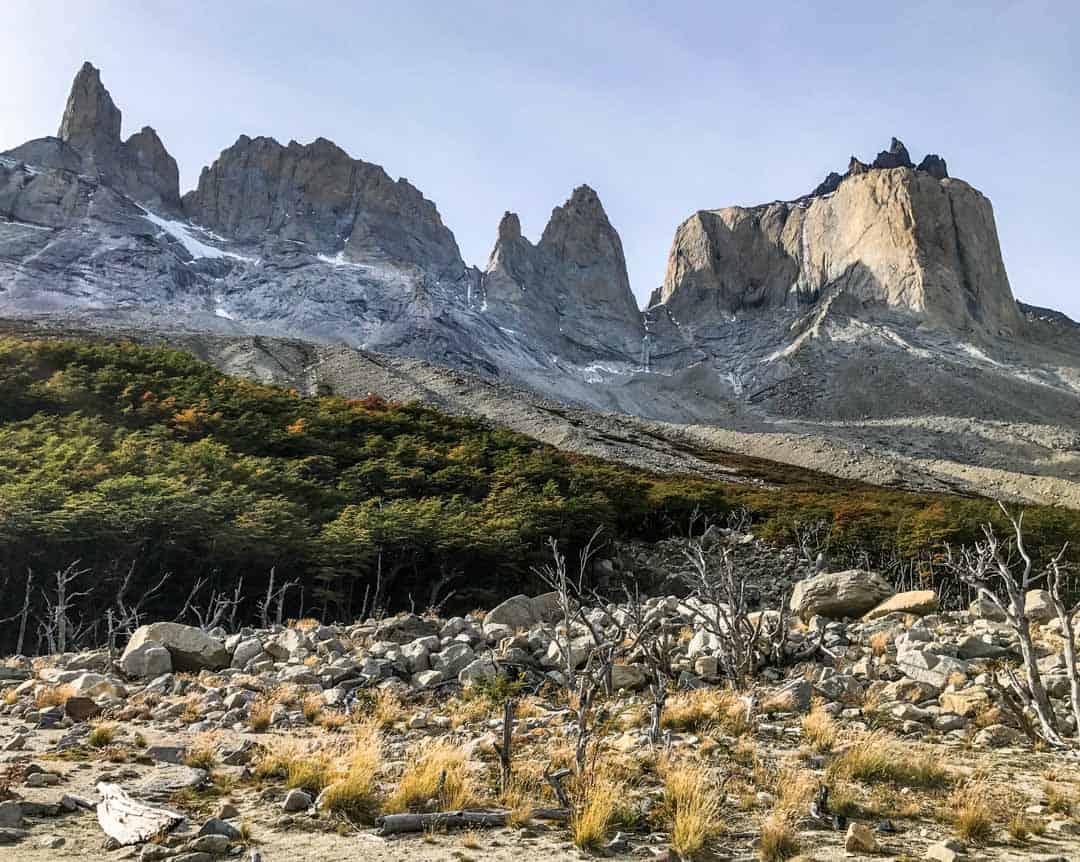
Summitting the boulders of the Británico Lookout around three hours after setting out , we cast our eyes over what will become our favourite panorama of this epic journey: the vast and spectacular Francés Valley. Find a rock to perch on and settle in for lunch with this glorious scene at your feet.
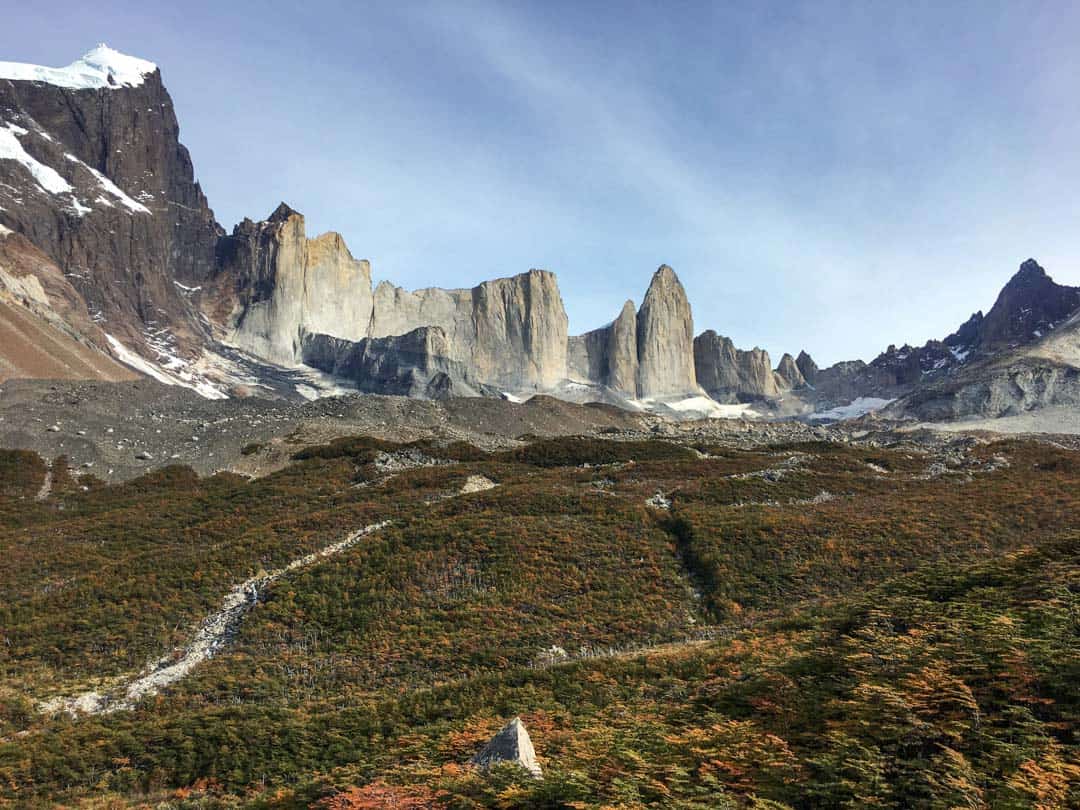
We’ve come a long way, but there’s still a huge day of hiking the W ahead. To our eternal regret, we were only able to linger here for half an hour as we left camp too late on this morning. That’s why we recommend getting on the trail no later than 8am today – trust us, you’ll want as much time at Britanico as possible and by arriving around 11.45am, you’ll have close to an hour here.
We’ve promised ourselves that next time, we’ll spend an extra day or two in this valley so we can take in this view at our leisure. For us, this remains one of the most magnificent vistas we’ve come across in all our world travels.
Trekking tip: Get on the trail by 8am at latest this morning so you can hang out for at least an hour at Britanico, or better yet, stay an extra day in the Francés Valley.
3rd Leg: Británico Lookout to Italiano Ranger Station (appx. 5.4 km / 3.4 miles, around 2 hours)
Aim to set off back down the trail to Italiano around 12.45pm . We find this a knee-buckling downward journey and our legs are screaming by the time we reach our packs back at the Italiano Ranger Station just over two hours later.
Once we’ve retrieved our packs (now four-deep in a giant bag pile), re-sorted them, and stopped for a quick breather, we set out for the Paine Grande refuge and camping area, starting with a bridge crossing out of Italiano. It’s around 3pm by this stage .
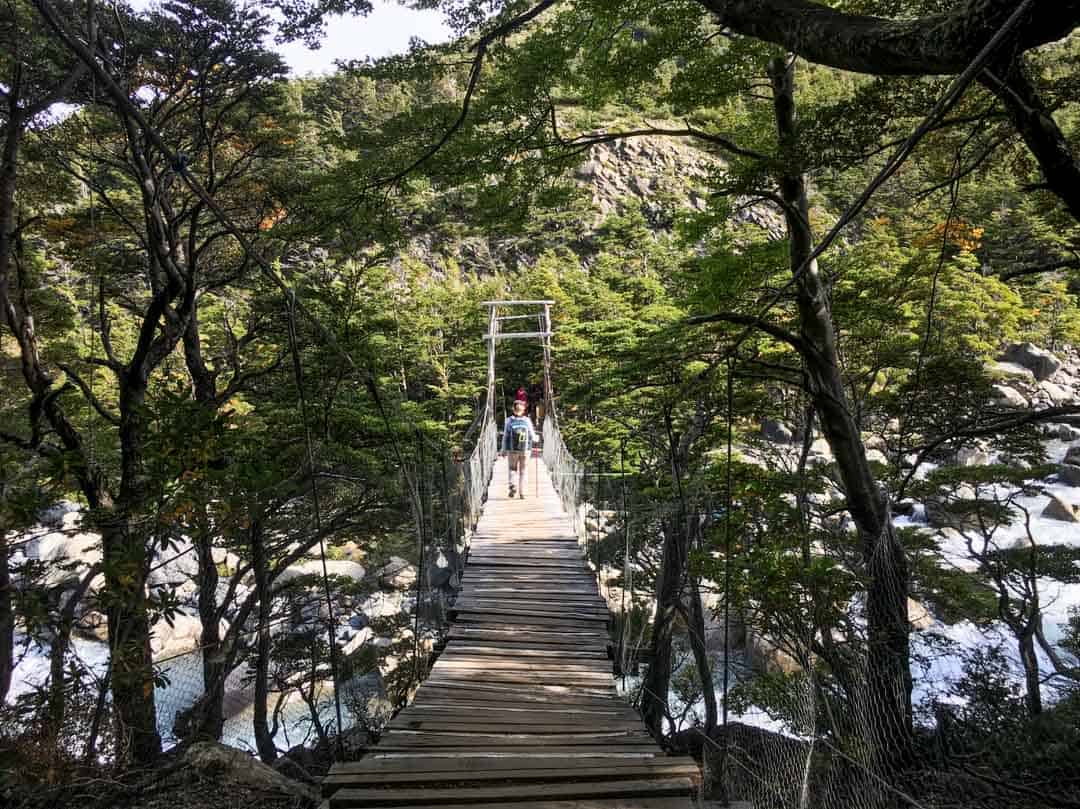
4th Leg: Italiano Ranger Station to Paine Grande (appx. 7.5 km / 4.6 miles, around 2.5 hours)
The final stretch of the W trail today is a journey of around 7.5 kilometres (4.6 miles) and it’s mostly flat with some sloping ups and downs.
Travelling out of the valley and along the raised walkway as you head towards Sköttsberg Lake, remember to turn around and take in the mountain scene back the other way: it is immense.
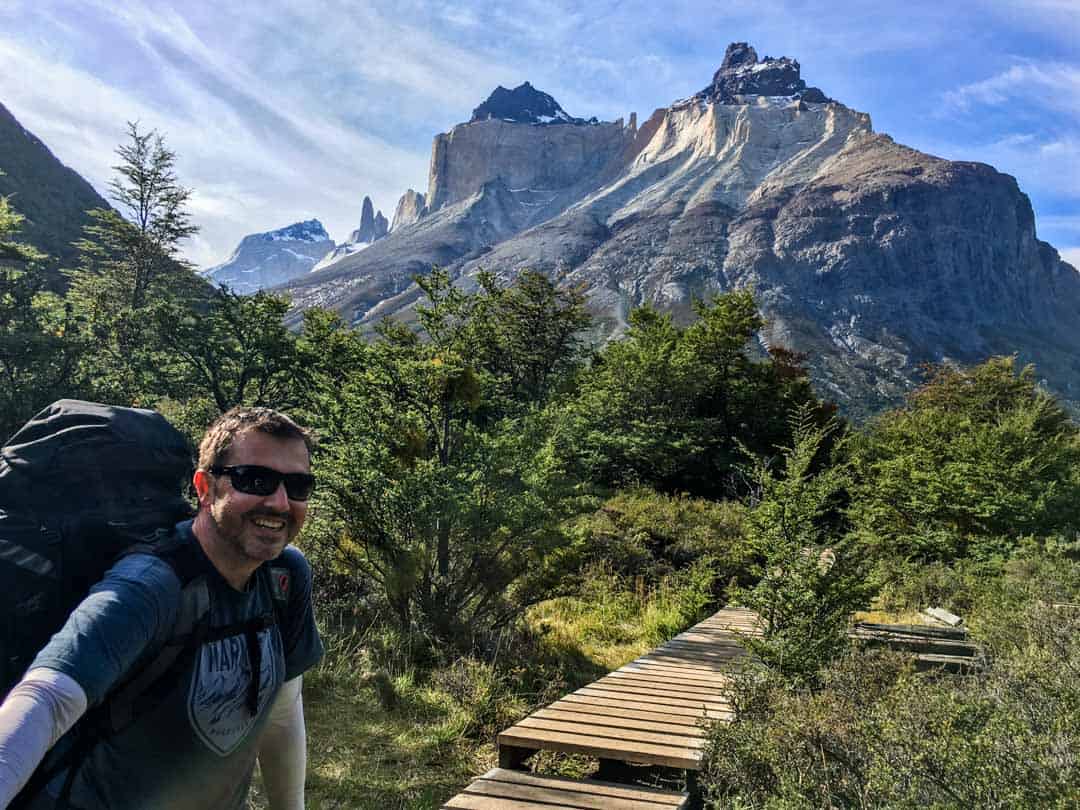
After some more steady rises, we make our final descent into Paine Grande Refuge and Camping around 5.30pm . By this stage, we’re seriously sore and tired and very ready for a beer from the lodge bar, which is the first thing we do once we’ve checked in and dropped our packs at our tent.
The campground at Paine Grande, which is managed by Vertice Travel, is large and separated into sections for campers carrying their own gear, and those like us who have booked a tent. A wooden walkway links the campgrounds with the lodge, the campers’ kitchen and bathrooms.
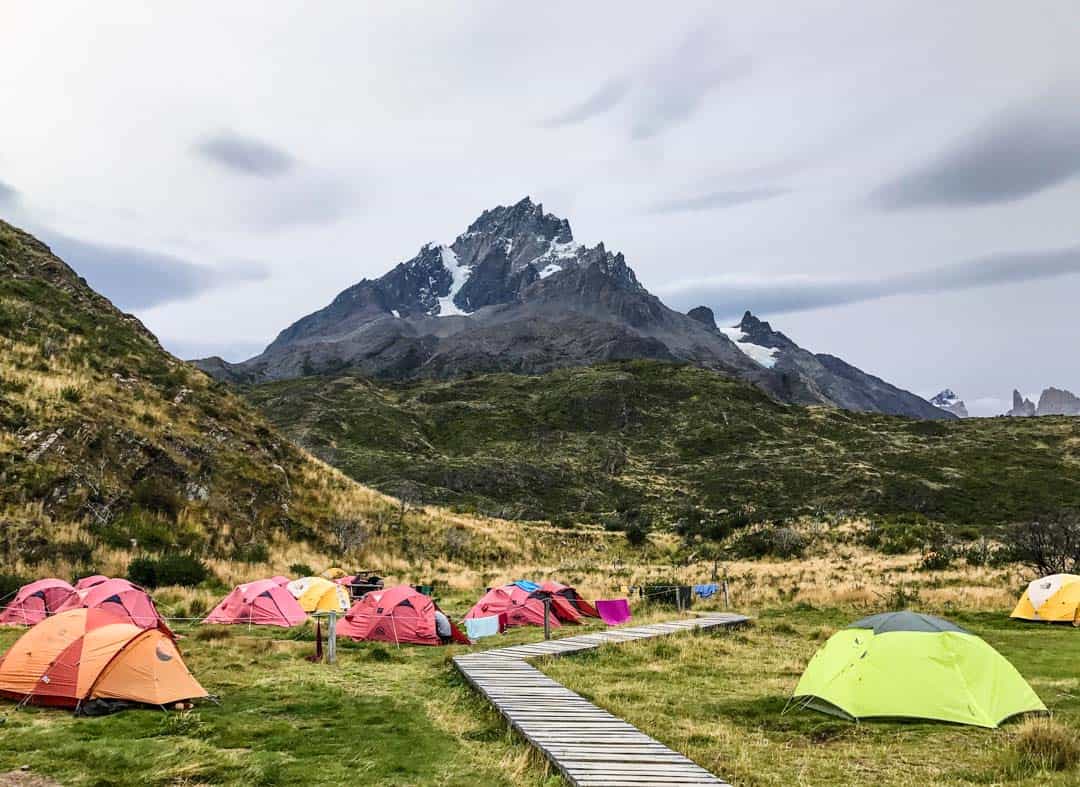
As Paine Grande is the western starting point for hiking the W and a transit point for O circuit trekkers, as well as for day trippers and short stay visitors, this is the largest and busiest lodge and campground in the park.
There’s a good-sized kitchen building, which is heaving with trekkers when we make our way in there to cook dinner around 7pm.
The camp shower and toilet facilities here are basic. We recommend getting your ablutions out of the way while everyone else is cooking dinner and before the post-meal rush. Paine Grande also has dorms, a restaurant and bar, and a mini-market.
We’re tucked up in our tent just as a light rain begins to fall around 8.30pm.
Day 4 – Paine Grande to Grey
Total distance: appx. 11 km / 6.8 miles total time: appx. 3 hours 45 minutes overnight: camping grey.
Today is our shortest day so far on the W trail, so we decide to set out a little later as we’re definitely starting to feel the past three days’ hiking, and a strange kind of exhilarated fatigue.
We’re up at 8am with plans to be on the trail by 9am. However the banshee-like screeches of a fox followed by the thrilling appearance of a large, tawny-coloured puma on the hill behind the camp has us – and everyone else – lingering for a while in hushed awe, until the sleek big cat disappears around a bend into the next valley. Which happens to be the same valley we’re about to trek into.
After checking in at the ranger station for advice on what to do if we see the puma again, we set off through the narrow, pretty dell at around 10am . We’re both relieved (and maybe a touch disappointed) to find no further sign of our feline friend.
The big cats of Patagonia Don’t let the thought of pumas roaming the forests of Torres del Paine put you off trekking there. The fact is, these magnificent creatures are extremely shy and actively avoid humans. Encountering a puma is incredibly rare. Spotting one near camp as we did is apparently almost unheard of. However, it’s important to be across what to do and how to act if you do come across a puma. You’ll find advice on this in the guide that you receive when you check in for your Torres del Paine trek. (If seeing a puma in the Patagonian wilds is on your bucket list though, check out this one-of-a-kind puma tracking day trip out of Puerto Natales.)
The valley walk is flat at first but soon begins to climb, and continues to serve up steady inclines followed by some steep descents into the Grey refuge and camping area.
The scenery on this leg is still epic, but maybe a touch more serene than the high drama mountainscapes of the last couple of days. Grey Lake is flat and still on the day we hike the trail, and dotted with blueish lumps of ice from the vast Grey Glacier at its head.
About halfway along the trail, a rocky lookout reveals the first glimpses of this immense glacier, a sea of ice six kilometres (3.7 miles) wide and 30 metres (98 feet) high in places.
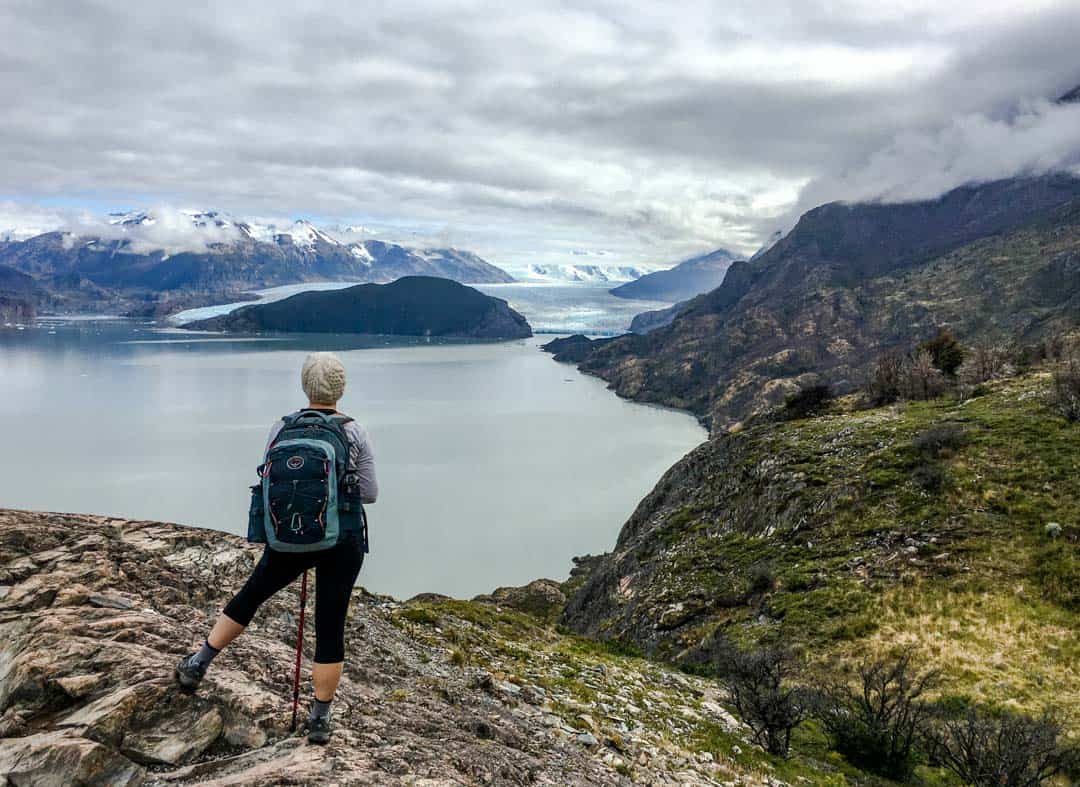
We arrive at the Grey Camping area around 1.45pm , a journey of 3 hours and 45 minutes, with plenty of photo and snack stops along the way.
Grey Refuge and Camping is also operated by Vertice Travel. The lodge has a lovely bar and lounge area in addition to its dorms, and the campground out front is overlooked by the stunning peaks of the Cordon Olguín. By the time we arrive, the clouds have cleared and the mountains burn golden as the sun drops.
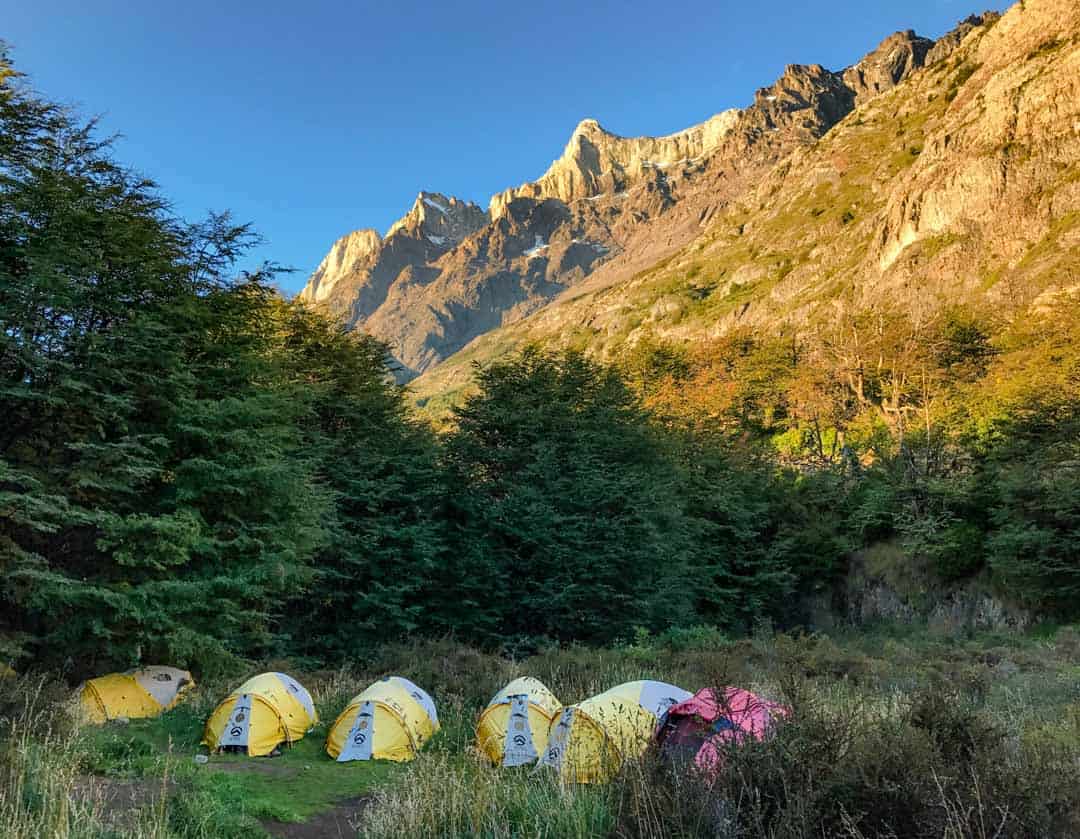
If you’ve got the energy, check in (or leave your pack with the office if check-in hasn’t opened yet), and then head back out to hike past the western tip of the W trail and on to the first leg of the O circuit towards Paso Ranger Station. This will bring you much closer to the glacier, but bear in mind, it’s a five hour, one-way hike to Paso itself.
Trekking tip: Leaving Paine Grande at 10am worked well for us, but if you do want to hike a stretch of the trail from Grey towards Paso and back to Grey today, consider starting out from Paine Grande earlier in the morning so you have more time to do this.
We opt to stop and enjoy our lunch with mountain views, then roll out our mats and nap in the sun until check-in opens.
After getting our tent sorted, we hike to a rocky outcrop on the lake just 15 minutes from camp. The views from here towards the glacier’s terminus are gorgeous and we spend time here just soaking up the scene.
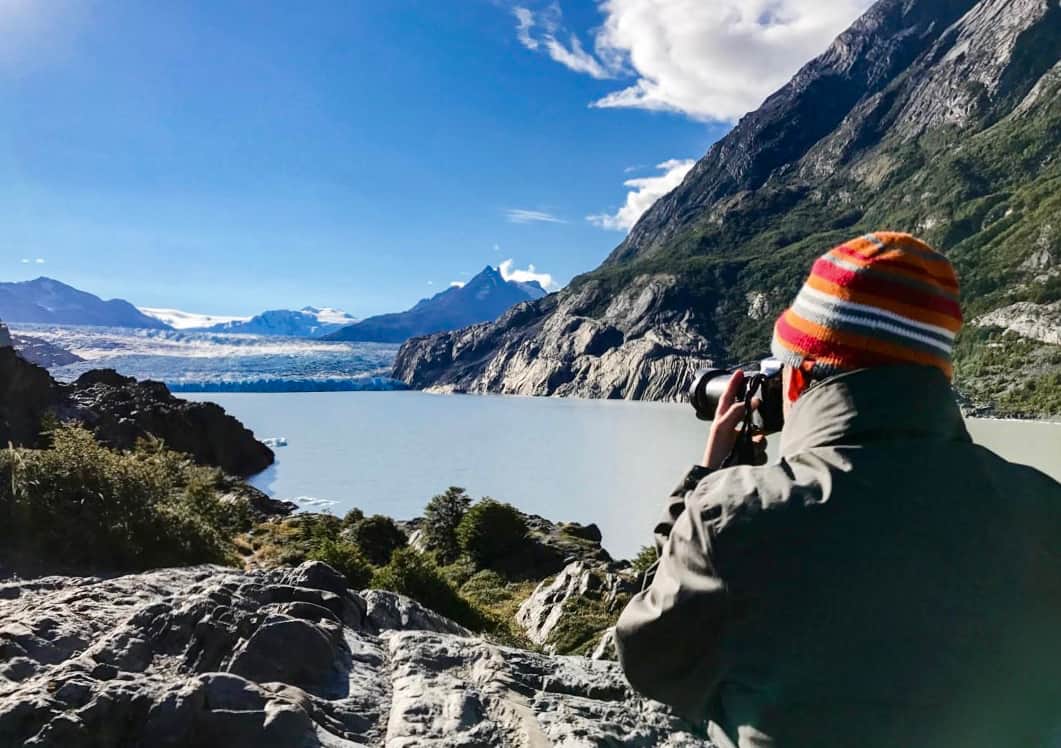
On our return to camp, we head to the lodge for a drink at the bar before making dinner on one of the picnic benches outside the buzzing campers’ cooking area.
In addition to the bar, there’s a restaurant at Grey, and a small shop selling grocery basics. There’s an equally small toilet and shower block for campers (the showers only have certain hours of operation but the water is hot).
We’re in bed by 9pm and prepped for a very early departure in the morning.
Day 5 – Grey to Paine Grande (and return to Puerto Natales)
Total distance: appx. 11 km / 6.8 miles total time: 3 hours 15 minutes.
It’s our last day on the W hike! We’re on the trail early so we can get back to Paine Grande in time for the late morning catamaran across Lake Pehoe to Pudeto, where we’ll pick up the bus back to Puerto Natales.
It shouldn’t take more than four hours to get back to Paine Grande from the Grey campground, but we’re feeling pretty exhausted by this stage and John has nurtured some nasty blisters, so we’re up and on the trail before sunrise .
It’s freezing when we set out at dawn but as the day lightens, we’re treated to a stunning peach-tinted sky reflecting off the lake, and we stop often to snap pics.
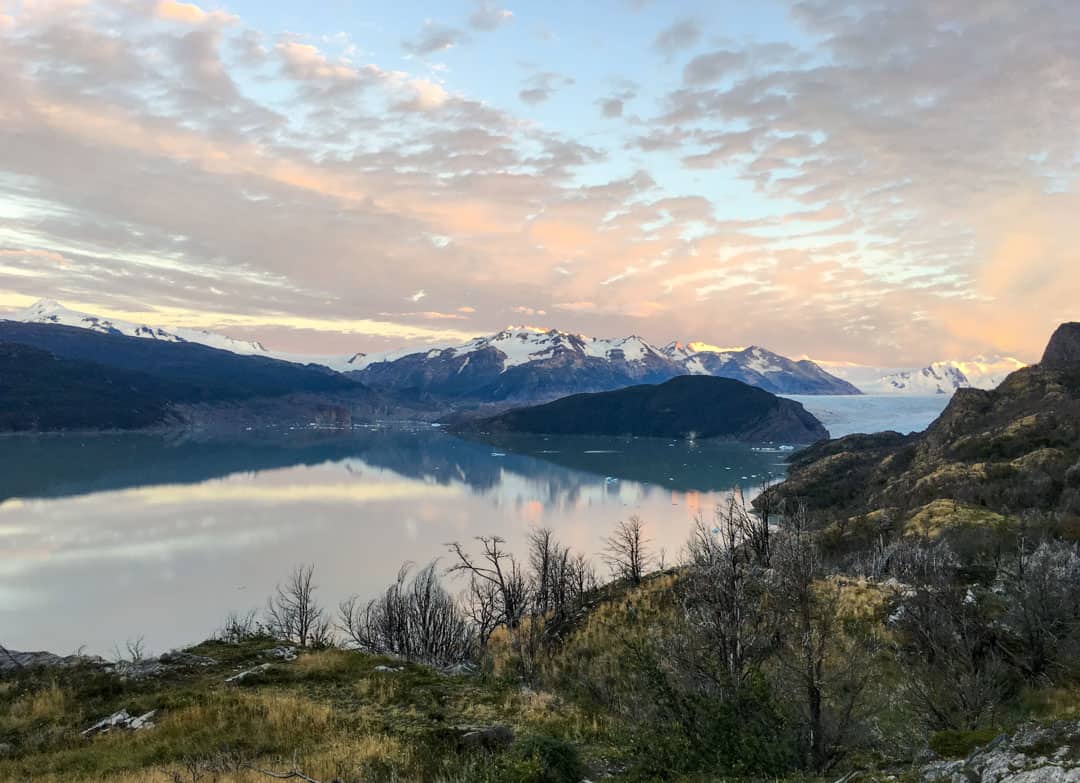
Despite John’s sore feet, we make good time on the return journey and while we’re climbing for much of the first half, it feels easier than the trek up from Paine Grande yesterday. Maybe it’s because we’re on the home run, even though the thought makes us sad.
Our journey back to Paine Grande takes us 3 hours and 15 minutes , 30 minutes less than yesterday’s hike in the opposite direction.
We haven’t eaten breakfast and we’re starving by the time we arrive. We were planning to grab something to eat at the restaurant at Paine Grande, but we discover it’s closed between breakfast and lunch.
We make do with our leftover trail mix instead, which is a bigger deal than you might think: we packed way too much of the bitty hiker’s snack and after five days we have a serious love/hate relationship with it.
Fortunately, there’s now a mini market at Paine Grande, which is apparently open from 7am. But if you’re setting out really early like us, perhaps have something you can eat on the go for this final morning.
Tickets and times for the Lake Pehoe ferry between Paine Grande and Pudeto The catamaran that crosses Lake Pehoe between Paine Grande and Pudeto operates from September to April. Departure times change from month to month so be s ure to check the boat schedule when you’re planning your W trek itinerary, and adjust your final day hiking start time to ensure you arrive back at Paine Grande at least 15 minutes before the boat departs. You can now book your ticket for the catamaran online ahead of time at the above website. We’re currently checking whether pre-purchase is a requirement or whether it’s still possible to turn up and buy a ticket onboard. The cost for the 2024-2025 season is 26,000 CLP or US$30 (each way) and the journey takes around 30 minutes.
We board the late morning catamaran for our return to the eastern side of the park. The boat trip across Lake Pehoé offers spectacular views of the entire mountainscape we’ve spent the last five days traversing. It’s an epic perspective of the W panorama and a mesmerising finale to our W trek itinerary.
If the weather is nice, we totally recommend taking a seat outside on the catamaran so you can properly admire the breathtaking scenery.
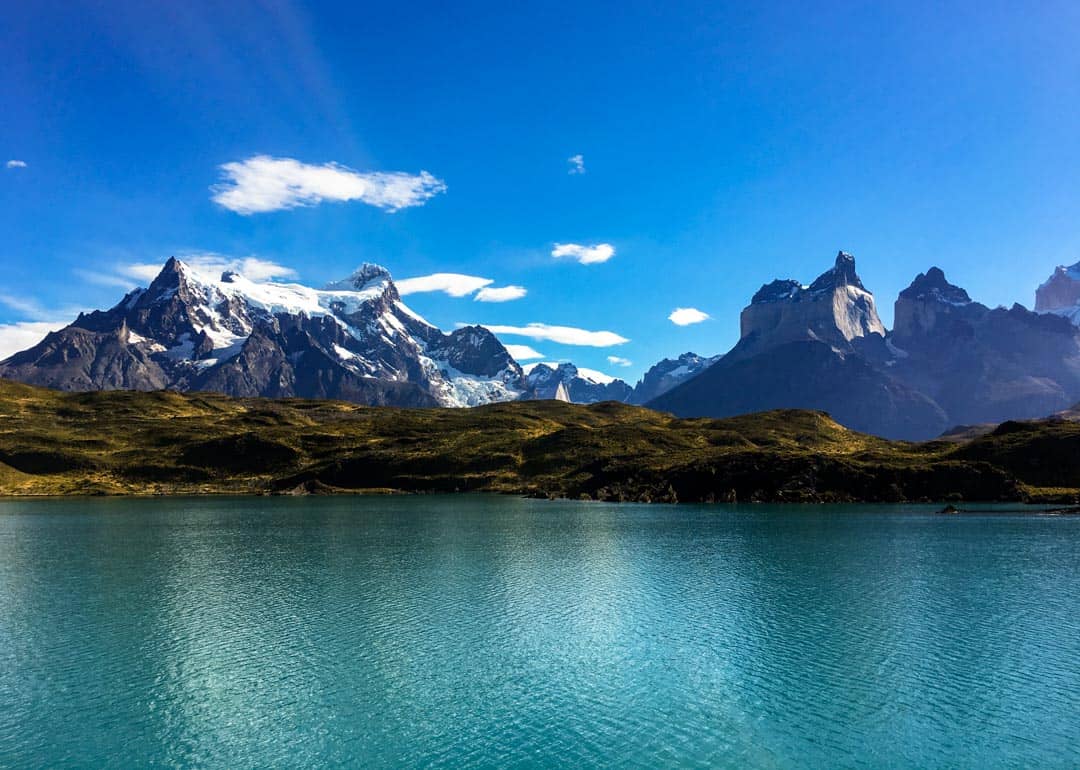
Disembarking the ferry at Pudeto, we grab a coffee from the lakeside café (open from October throughout the trekking season), take a seat in the sun, and enjoy our last moments in Torres del Paine while we wait for our bus.
Travel tip: In addition to checking ferry times for the catamaran between Paine Grande and Pudeto when you’re organising your trek, it’s also worth checking the bus connections to and from Pudeto, so you can work out the best approach for your final day on the trail.
From Pudeto, the bus makes its way back to the Laguna Amarga Ranger Station to collect hikers finishing their trek at the eastern end of the park. From there, we settle in for the return two hour bus journey to Puerto Natales .
Tonight, back in Puerto Natales, after a good hot shower and a lamentation on the ridiculous amount of trail mix we’ve got left over, we head out for a celebratory drink.
Our legs might be seizing, our knees protesting and we’re beyond exhausted, but we’re buzzing with the sheer thrill of having completed this epic trek. We’re already talking about when we might come back and hike the W trail again, or better yet, take on the longer O circuit.
However we do it, trekking in Torres del Paine is one nature experience we’re keeping firmly on our bucket list.
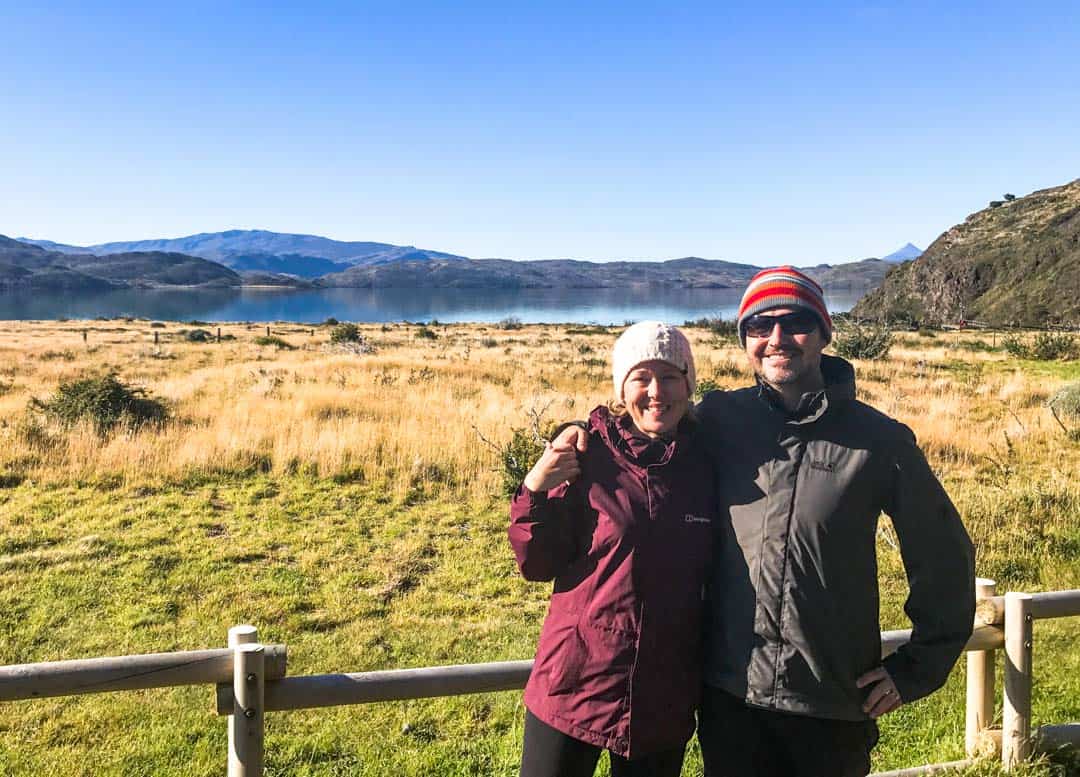
Got any questions? Have you trekked in Torres del Paine recently? We’d love to hear from you, drop us a message below.
For more exciting experiences and things to do in this incomparable part of the world, head to our Chile page or our South America section.
57 thoughts on “Hiking The W Trek In Patagonia: A Self-Guided Itinerary [2024-25]”
What a exciting blog to read with so many helpful insights! We are currently planning a “half a W-Trek’ focusing on the Western portion for 3 day/2night stay, one in Britanico and one in Refugio Los Cuernos before returning to Pehoe Lake.
Hi Reinier, thanks for your message and kind words! Your trip sounds great, we hope you have a magical time exploring the western half of the W! All the best, Danielle & John
Thank you so much for this rundown – working on booking for this winter now. Would love your opinion about 2 things: 1. On the day we’re hiking into Grey, I was thinking about trying to add the glacier kayak excursion on that afternoon – do you think that would all be doable in 1 day? Were you aware of folks who did it? 2. On the last day, I was thinking we’d hike out, take the catamaran, bus back to Puerto Natales, and catch the 5:00pm bus to Punta Arenas. Based on your experience, do you think that would be doable?
Hey Mark, Thanks for your message – great to hear you’re planning a W trip!
The kayaking sounds awesome. It certainly sounds possible to hike to Grey and do the kayak tour on the same day, assuming there are tours running later in the day? As an indication, it took us around 3 hours 45 mins to hike the 11km from Paine Grande to Grey at an average pace. You may do it quicker or slower depending on your own pace, but if you aim to set out from Paine Grande early morning, you should reach Grey campground/lodge by late morning/early afternoon, which would potentially give you time to check in to the campsite/lodge and then join a late afternoon kayak tour? I’d personally make sure there was a good amount of time between my estimated arrival and the tour departure just in case, that way you can enjoy the hike to Grey without rushing.
We usually err on the side of caution when it comes to transport as well, as while most of our bus travel in Chile/Argentina was issue-free, we did experience occasional bus delays and lastminute cancellations. Bearing in mind the bus from Pudeto to Puerto Natales takes a couple of hours, we’d be looking to put in a decent buffer between that and the Punta Arenas service, just in case you’re held up at any point along the way. Less stressful!
All the best with your planning and have a wonderful time in Torres del Paine! Let us know if you do end up hiking and kayaking on the same day!
I been to Asia a couple times but never to enjoy much of the nature. Your destinations and experiences have me wanting to explore more of the hiking trails abroad. Thanks for sharing!
Cheers Bryan, happy travels!
Thanks for your info, it helps a lot. I’m planning to do W trek in coming January. If I book the camp, can I also use the facilities in the shelter (like shower and toilet)?
Hi Karen, all of the campsites along the W have dedicated facilities for campers, including showers and toilets. Some have cooking areas for campers as well. Happy planning and have a wonderful trek in January! Cheers, Danielle
Great website! We’re hoping to do this February/March 2025, and are wondering how best to spend our time on either side of this hike. Did you travel to El Calafate and El Chalten while you were in the area? Or do you recommend other areas down there? Any advice greatly appreciated!
Hi Lisa, thanks for your message! Fantastic to hear you’re planning a trip to Patagonia! Besides the W Trek, there are various activities you can do in and around Puerto Natales and Torres del Paine, like boat trips on Grey Lake to Grey Glacier or horseback riding.
We most definitely did travel to El Calafate and El Chalten after our trek and absolutely recommend, especially if you’re keen to get out on some further hikes. We bussed from Puerto Natales to El Calafate and the next day did a day trip to the Perito Moreno Glacier, which is an absolute must. From El Calafate, we travelled by bus to El Chalten (the panoramas on the bus ride in are wow – try and get the front seats!) and spent a good couple of days exploring this gorgeous area and just hanging out. There are a range of hikes you can do out of El Chalten – the day hikes to Laguna de Los Tres and Cerro Torre are epic.
If you head south from Puerto Natales to Punta Arenas, you can do day trips to see King penguins, Magellan penguins, whales and dolphins, so that’s another option.
Have a wonderful time and happy trip planning! Cheers, Danielle
Thank you for sharing your Patagonia insights! I found it very thorough and incredibly helpful. I we are planning our trip for October 2024. I have a question. How did you book your meal plan? Thanks! Kim
Hi Kim, thanks for your feedback, we’re glad you’ve found our post helpful! When you go through the booking process for each accommodation (including camping) along the trail, you’ll have the opportunity to add meals as part of those bookings. Links to the accommodation providers are in the post. Good luck with your planning and happy trekking in October! Cheers, Danielle & John
Hi thank you so much for this detailed blog. It appears that one would have to stay at Frances camp if going east to west in order to shave hiking time on day 3. Is there a bus company through which we have to pre-book a bus ticket from Pudeto ferry to Las Amargo? Or is it a shuttle service? Do you have any idea if booking a guided tour via Las Torres means that they carry your heavy rucksacks?? Is the last day at Grey really worth it ? Or would you rather end the trek on day 4? Thank you!
Hi SK, thanks for your message. Until the CONAF Italiano camp reopens, Frances camp is the closest camp to the Frances Valley so yes, it is the best bet timing-wise for getting in and out of the Frances Valley and on to Paine Grande on Day 3 if travelling from east to west. You could also stay at Los Cuernos, but that would add around 1.5 hours to Day 3.
The buses running from Puerto Natales to Torres del Paine drop off and pick-up from Laguna Amarga and Pudeto. When you buy your bus ticket to Torres del Paine, you’ll note where you’ll be getting off and on again (it will depend on your itinerary, but for us, travelling from east to west, we got off at Laguna Amarga and boarded at Pudeto on our return. Check out the section in our post on bus tickets to and from the park for more info. There’s a shuttle that runs between the Laguna Amarga ranger station and Hotel Las Torres for a fee.
We would suggest contacting the tour company you’re interested in for advice about whether porter services are available on their guided tours. We left most of our luggage in one of our backpacks at our hotel in Puerto Natales and carried only what we needed for the trek to keep the weight down.
We personally feel that every leg of the W is absolutely worth it – the scenery is superb throughout. Five days gave us just the right amount of time to enjoy the whole trail without pushing too hard. To do the trek in four days, you’d likely need to compromise on either the full hike into Frances Valley or the Grey leg in order to reach camps before dark, and we wouldn’t want to skip either. But that’s us. If four days was all we had to trek, we would possibly leave Grey but we’d have to make sure we did a boat tour out to the glacier instead! 🙂
All the best with your planning! Cheers, Danielle & John
This is seriously one of the best breakdowns I’ve read. Patagonia is one of three “Someday” treks I have on my list to head off on once my son is a little bigger and can carry more of his own gear. We’re building up now with longer and longer trips around Central/Eastern Europe
Love this site!
Thanks for your message Brian, we really appreciate your feedback. So cool that you and your son are already hiking together, and what an awesome bucket list adventure to look forward to with him! Happy trekking and thanks again! Danielle & John
Do you have a map with the accommodations you booked or where you rented out tents/gears? Planning on doing this solo in June!
Hi Erika, thanks for your message! There’s a trail map available at the official Torres del Paine website: https://parquetorresdelpaine.cl/mapa-2023-2024/ – it shows all the accommodations/campsites along the trail. You can also find links in our post to the accommodation providers we booked our campsites and camping gear through.
As you’re considering a June trip, we’d also encourage you to check out the official Torres del Paine website for information about winter hiking regulations – https://parquetorresdelpaine.cl/permisos-especiales/ . Many of the accommodations and trails close over winter and while you can visit the park, we understand it’s mandatory to have a guide for the W Trek and the trek to the base of Las Torres between 1 May and 30 August (though the timeframes can change depending on weather). All the best with your planning! ~ Danielle
Hello Dan, What a great find this was. Thank you so much for writing it. I’m looking to mimic your trek with some modifications. I will very likely have a car rental when I arrive into Punta Arenas. My plan is to drive myself and 2 others into the park and leave the vehicle parked at the welcome center or hotel (unsure if this is allowed). At the end you mention that you ferry to Pudeto- then catch a bus that swings by Laguna Amarga into Puerto Natales. Is there a bus that goes directly back to the welcome center or hotel from Pudeto so we can get back in my rental? It looks like the Laguna Amarga ranger station is about 8.5 km from the welcome center. Or is it best to just shuttle from Puerto Natales for the whole thing and leave the rental somewhere in town?
Hi Bruce, thanks so much for your message and feedback! Very good question re. parking – based on our limited research into this, our understanding is that you can leave your car at Hotel Las Torres while you trek if you’re a guest there, otherwise, cars can be parked at the nearby Welcome Centre. We’ve also seen reference online to a small car parking area at Pudeto, so in theory you could arrange bus tickets from Pudeto to Laguna Amarga, and from there get the hotel shuttle to Hotel Las Torres/the Welcome Centre. I would suggest posting your question on Tripadvisor and hopefully someone has done something similar recently and can provide latest info. It might also be worth contacting Hotel Las Torres and asking their advice; no doubt they get questions like this frequently. All the very best for your trip planning and the trek itself – it’s an unforgettable experience! Cheers, Danielle & John
Thank you so much for the great information. I’m a long term planner and we’re looking to book for our family of four, Christmas 2024. I found this blog really really helpful in hiking cost effectively. Thanks Again!
Hi Melissa, thank you so much for your message, we’re really happy you’ve found our post helpful in your planning. Also very excited for you and your family – what a fantastic Christmas experience! We hope you have a really wonderful time hiking the W, it’s just such an incredible place! All the best and happy hiking! Danielle & John
Thanks for the article, I find it very useful. I have just booked the circuit trail for this April. About that: I looked into using Booking Patagonia for the reservations, and it works really well. Though, there is a downside: they charge an extra $90. You’ll notice this at the very and of the booking process, which I found quite frustrating. For me that was a reason to book directly at Vertice and Las Torres Patagonia, which works fine.
Hi Valentijn, thanks so much for this update, that’s really helpful to know! Thanks also for your feedback on our post, we’re pleased you’ve found it useful. All the best for your upcoming trip in April, have a sensational time and happy hiking! Cheers, Danielle & John
Thanks for the great write up. The details are useful and your descriptions are inspiring. I’m leaving for Chile in a couple days and your post just added to my excitement.
Hey Mike, thanks so much for your feedback, we hope you have a really fantastic trip. Chile is an incredible country, one of our faves!
Cheers, Danielle & John
Thank you for that informativ Blog! I have a question: are there any possibilities to heat up some water in the Refugiés without a stove?
All the best Sophie
Hi Sophie, thanks for your message!
As we had a cooking stove (and booked meals at Chileno where stoves can’t be used), we can’t personally say for sure whether hot water is currently available at all of the stops on the route. That said, we did find a trekker’s report online from late 2023 noting that they were able to access hot water (not boiling) through the coffee/tea dispensers at each of the refugios they stayed at, which they used for their dehydrated meals. Would suggest seeing if there are other trip reports from this season, or posting on a forum for latest updates. Or perhaps hire a stove in Puerto Natales and buy a gas canister just to be on the safe side! We’d love to know what you find out!
Have a magic time trekking the W!
Cheers, Dan & John
Hi guys. Thanks for all the detailed info. Just wondering if you could give an estimate of how much it cost for the W trek. I am being quoted $1180 per person for 4 nights and five days starting 12th February with this included:
• camping accommodation with all the equipment • all the meals • transportation from/to natales-park • park entrance • catamaran • welcome kit
Not sure if this price is really high or if it would work out as that much if I book everything myself separately anyway.
Many thanks
Thanks for your message and feedback – we’re really excited for your trek in Torres del Paine.
We were travelling long-term when we did the W Trek so we went out of our way to keep costs down by booking the campsites directly, carrying some of our own camping gear and bringing most of our own food. Travelling as a pair also helped as the single supplements can add quite a bit. We’d also note that, like everything, prices have hiked post-Covid.
We’ve included some costings in our post but not many as we’re conscious things can change quickly (plus there are so many potential cost combos for accommodation/food, it’s tricky to provide a general estimate). As the bulk of your costs will be in the camping, gear and food components, you might consider checking out the latest price lists for camping and food package options on the Vertice and Las Torres Patagonia websites; that would give you a sense of costs in the context of your quote. Given how quickly accomm/campsites book up for the season and the challenge of trying to coordinate an itinerary across multiple websites, having a third party making the arrangements, while costing more, would take the hassle out of that.
All the best with your planning and we hope you have a sensational time trekking!
Cheers Danielle & John
Your hikes sounded amazing. We are going in Feb and I wasn’t sure what to expect. Sounds like I should do some training! Do you recommend stiff hiking boots to navigate the big rocks or are light hikers enough support?
Thanks for sharing, Karen. Canada
Hi Karen, many thanks for your feedback! To be honest, if you’re a regular walker/hiker, you may find the W Trek a breeze – we met plenty of people who barely cracked a sweat, lol. As irregular hikers, we found some of the steeper sections a little more ‘breath-taking’ but still very do-able. We both wore regular lightweight hiking shoes and they were fine (apart from John developing blisters towards the end), but we also saw people in solid boots. I guess it depends on your preference. We did find having a hiking pole each was useful on some of the more uneven terrain like the rocky climb to Las Torres. We’d love to hear about your trek when you get back – have a fantastic time! Danielle
Going in February, cant wait. Did you know how anyone who did the kayak at Grey and talked about there experience?
Hi Efren, that’s so exciting! We don’t personally know anyone who has kayaked at Grey but we wish we’d had time for it – what an amazing experience! The lake is beautiful and the glacier is epic! If you do kayak, we’d love to hear about it! Have a fantastic time, Cheers, Danielle & John
Awesome Post!
I’m looking at doing this the same direction as you guys did around the same time in 2025.
You mentioned availibilty determined your campgrounds; that being said would you change any of your stays if you could in retrospect? Maybe saw some better campgrounds/lodges along the way that you wish you could have booked had there been availibilty?
Hi Chris, thanks for your message and good question! We were on a long travel stint when we did the W Trek so we opted for camping to keep our costs down, plus the campsites we ended up with proved to be very well located for a five-day itinerary. That said, all of the lodges and refuges looked quite nice so if we were to do it again (and we hope to!), we would consider adding some lodge/refuge stays, following the same itinerary. Location-wise, the Cuernos and French refuges would be good alternatives to camping (though these are beds in dorms, which is less appealing to us). We would definitely consider the Cuernos Cabins (2-3 people per cabin), especially if we were planning a longer stay in the French Valley! We’d also consider staying at the lodge at Grey next time as, of all the campgrounds, this was probably our least favourite (plus we were very ready for a bed by that stage!). Overall, the quality of the campgrounds/refuges throughout the park is very good and we were really happy with our camping experience and itinerary. Best of luck with your planning and we’d love to know how you go! Happy travels!
Wonderful description. We are going in Jan 2024! Looking forward to it.
Hi Kishore Joshi, thank you so much for your feedback, we hope you’ve found it helpful! Wishing you a fantastic W Trek, it really is the most incredible place! Happy travels!
Hi! How much cash would we need, knowing that the bus and entrance are paid for and also full board meal plan at the refugios is booked? So for snacks, water or other costs etc? Do they accept USD or should we have it exchanged? Thanks!
PS, did you also really use ‘poop bags’ for your used toilet paper along the way? 😅
Thanks for your message. We carried both USD and Chilean pesos with us just in case, and we were able to use credit cards at the refuges. We paid for the shuttle from Laguna Amarga and the catamaran from Paine Grande in pesos, though we have read that the catamaran operators may take USD in high season. It’s handy to have pesos for smaller purchases like snacks. We carried a refillable bottle and filled up in streams and at the refugios, so we didn’t purchase water.
We have packed degradable doggy bags for carrying out toilet paper on past hikes! 🙂 On the W Trek though, we carried a loo roll and some trusty Ziploc bags, but we mostly just made strategic use of the campground facilities!
Happy trekking!
Hi John and Dan Thanks for such good info. Is it safe doing it self guided ? Thanks
Hey Iris, thanks so much for your message, we hope you found the post helpful. We found going self-guided very easy – the trails are well trodden and during the peak season, there are plenty of other people hiking too (guides are mandatory in winter). Plus all trekkers have to stay in the designated camping and accomm areas so there are others around and you can stay in dorms if you’re not keen on camping. Conditions can vary dramatically though and it is the great outdoors, so having appropriate gear is essential and hiking with friends is good idea though we hear lots of people do it solo. Everyone we met en route were friendly, encouraging and helpful too. We absolutely loved the hiking the W and hope you get to experience it too! Happy travels! Dan & John
This is really helpful thank you so much. Did you have much hiking experience before you took this on? Would you recommend any training prior to going? What size backpack would you recommend taking?
Thank you so much
Hi Jo, thanks for your kind words, we’re glad you found the post useful! We’re casual hikers and while we’d done a bit of hiking before the W, it was certainly one of the ‘biggest’ hikes we’d done. We definitely tried to up our walking/hiking game before the W in preparation and glad we did as we personally found some of the steeper, sustained-climbing parts of the trek relatively tough – we just took our time and had lots of breaks; necessary anyway to take in the gorgeous views! I carried a 30L daypack and John carried a 50L backpack – between us we carried everything we needed for the five day hike, but I would note that we didn’t have to carry tents, sleeping bags or mats as we hired these. We hope you have the chance to hike the W trek, it remains at the very top of our hiking list! Happy travels!
Thank you all for this awesome breakdown and information! We followed it exactly to book our accommodations and plan to do the trek end of March. Thanks again!
Hi Kristen, thanks so much for your feedback! We’re stoked you found our post helpful and we’re very excited for your upcoming trip. Torres del Paine is sooooo spectacular, wishing you a fantastic trek – let us know how you go! ~ Danielle & John
Thanks Dan for the great details and info.
Hi Kristen. I am doing the trek around of march with a friend. We are travelling from Perth, Australia. Would be great to collaborate in planning.
Thanks Bikash
Hello! This page is fantastic, thank you so much. We are looking at November and can be flexible in terms of dates. Did you book your accommodation first? Are there any other considerations i.e. tickets or entry to the park? Or should we just arrange accommodation and go from there? Do you mind sharing how much you paid approximately for your camping accommodation? No worries if not. Thanks 🙂 Amie
Hi Amie, many thanks! We booked our accommodation first and a couple of months in advance. Site availability ended up driving our approach to the trek – so it’s good that you have flexibility! Would definitely get in as early as possible to book. Tickets for the park itself are arranged at the park entry office, but you will need to have the accomm bookings in place (and evidence of them) when you get to that point. So it’s important to book the accommodation and bus tickets to the park in advance. Bus tix you can buy when you get to Puerto Natales, but try and do that as soon as you arrive rather than on the day you intend to travel to the park. Prices for camping and cabins may have changed since we trekked, but if you head to the accomm links in our post, you’ll be able to find out the current prices as it’s all bookable online. Hope that helps and have a fantastic trek! Cheers, Dan & John
Thank you for the detailed information. We are trekking this exact route this March 2020!
Hi Jackie, thanks for your message, we’re really happy you’ve found it helpful for planning. Hope you have a sensational trek!
Thank you so much for the detailed guide! This is really helpful 🙂
Hi Katherine, thanks for getting in touch! We’re really pleased you found the guide useful – happy hiking!
How did you book the campsite ? I unable to locate the source to book just the campsite
Hey Rajesh, thanks for the message.
The Camping areas are run by three different operators in the park, and you can find links to all three operators in our post.
All three operators’ websites have information about their camp sites, and how to book.
Hope this helps.
John & Dan
Exactly what I’m looking for, thanks! Chileno and Los Torres always been there on my bucket list, now I know where and how to start.
Awesome, thanks Rika, we’re really pleased you’ve found it helpful. It is the most spectacular walk – even if you just did the one leg to Las Torres, you’d have photography opps galore! Happy travels!
Leave a comment Cancel reply
Save my name, email, and website in this browser for the next time I comment.
- Skip to primary navigation
- Skip to main content
- Skip to primary sidebar
- Skip to footer

The Opinionated Travelogue of a Photo Maniac
- Middle East
- North America
- South America
- Pacific Islands
- FOOD & WINE
- TRAVEL GUIDES
- TRAVEL RESOURCES
- Rants & Raves
- Travel Blogger Interviews
- Contact Form
- Privacy Policy
- Featured Elsewhere
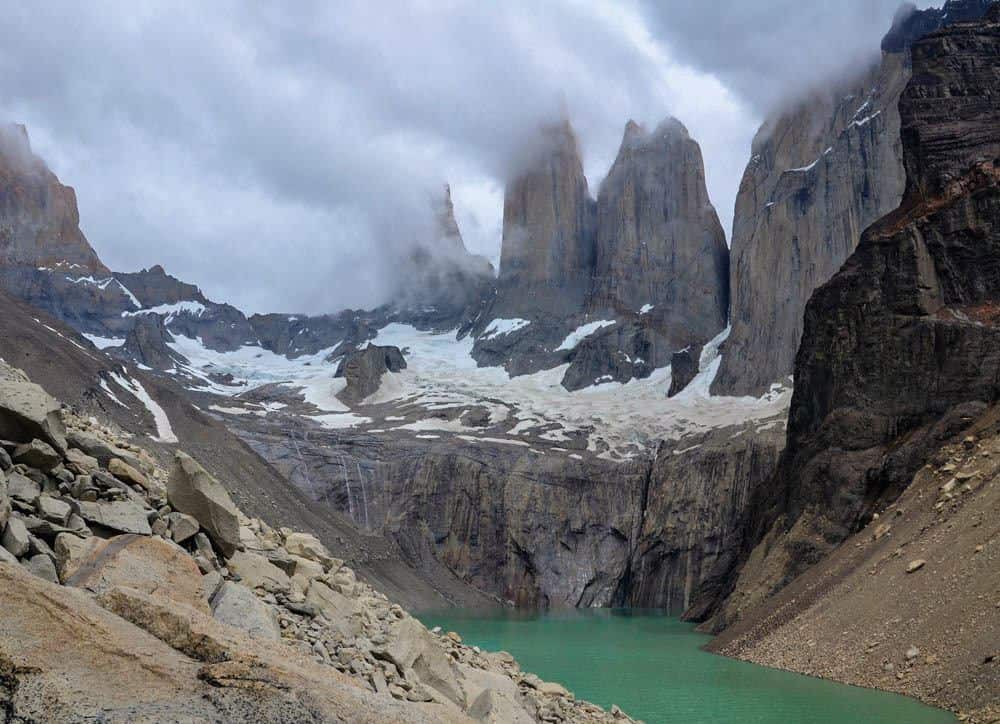
Essential Guide for Planning a Hiking Trip in Patagonia
Last Modified: June 18, 2024 // by Anda // 58 Comments
Hiking in Patagonia is breathtakingly beautiful and exciting! This vast, wild region at the tip of South America is a place like no other, and once you see it you’ll understand why. Massive glaciers, jagged granite peaks, azure lakes, roaring waterfalls, and sublime flower fields. Tall mountain peaks and huge swatches of scrubland, dotted with roaming guanacos, lamas and ñandús.
There are not many places in the world where you will fill a deeper connection with nature and witness its tremendous power. There is a reason why hikers from all around the world consider hiking in Patagonia an experience of a lifetime. But the land of massive glaciers and azure lake is as wild as it is beautiful. Therefore, in order to have a great time here, there are a few things that you should know BEFORE planning your hiking trip to Patagonia.
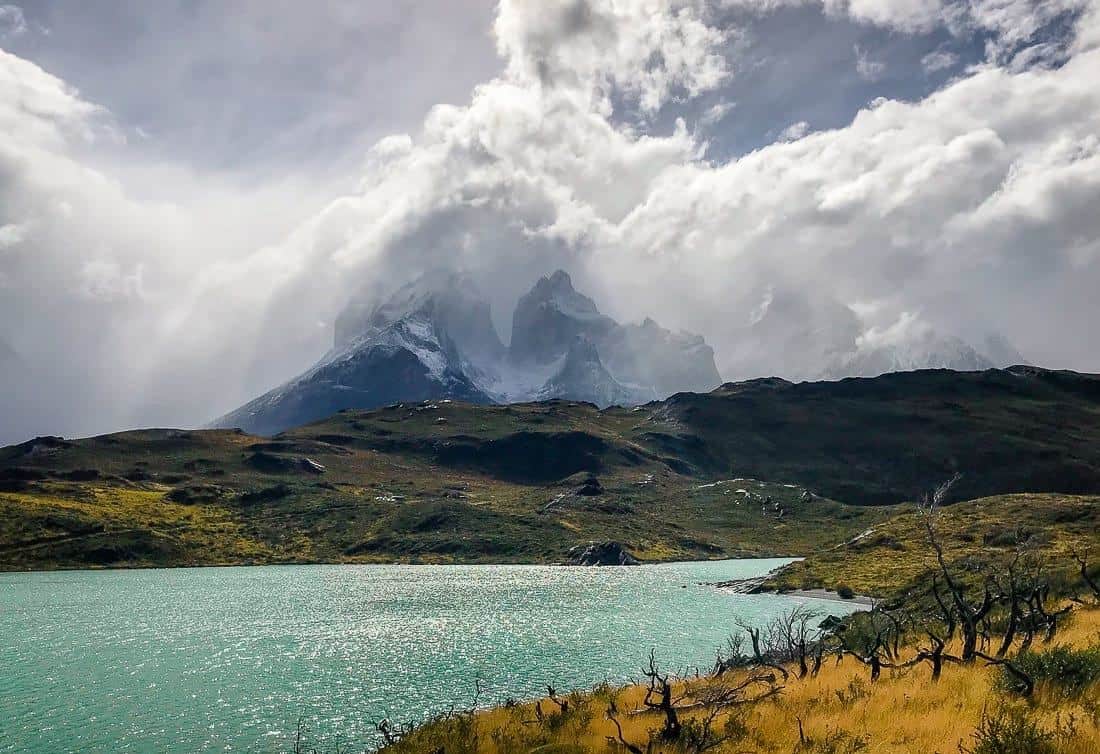
Table of Contents
Hiking the Chillian Patagonia
Hiking the argentinean patagonia, best time to hike in patagonia, multi-day treks vs. day hikes in patagonia, how difficult are the hikes in patagonia, tips for hiking in patagonia, the bottom line, where to hike in patagonia.
Patagonia straddles two countries, divided by the Andes Mountains: Chile and Argentina. The Chilean side of Patagonia brags about the famous Torres del Paine National Park , while the Argentinean side boasts the stunning Mount Fitz Roy and Perito Moreno Glacier.
Some of the best hikes in Patagonia are in Chille’s Torres del Paine National Park , which is acknowledged as one the most spectacular places to see in South America, home to fantastic trails and treks, like the epic Torres del Paine W Trek.
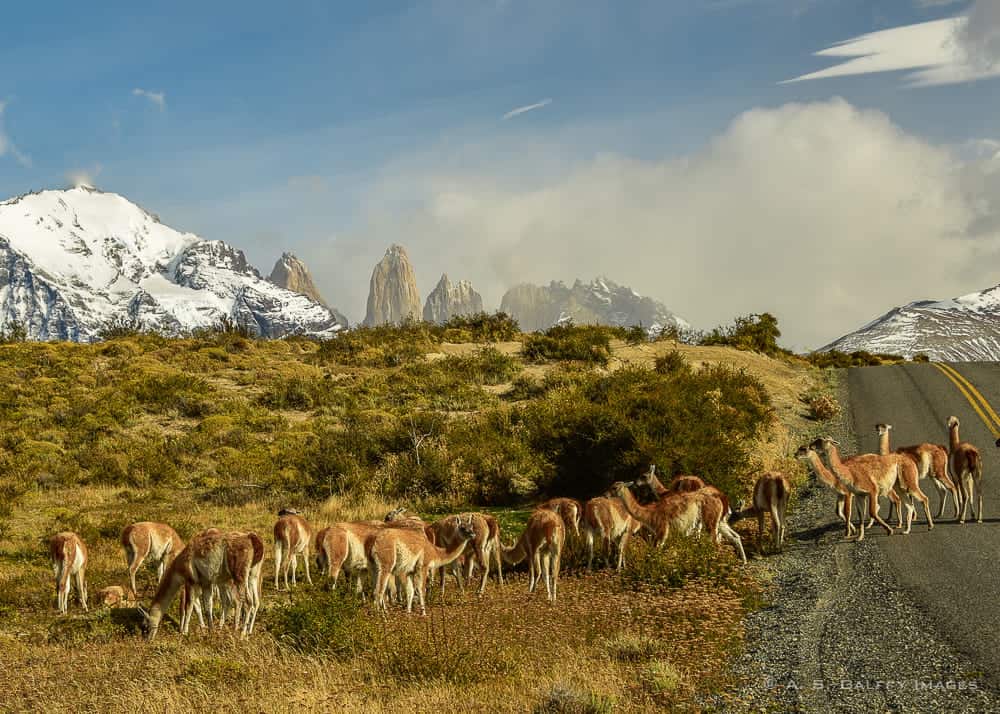
But Argentinean Patagonia is also home to unbelievably beautiful trails and tracks, like the hike to Laguna de Los Tres and Mount Fitz Roy . There are several world famous treks that start in El Chalten. Some of these hikes are quite easy and can be attempted even by families with small children. Others are longer and more difficult and present a challenge even for the more seasoned hikers.
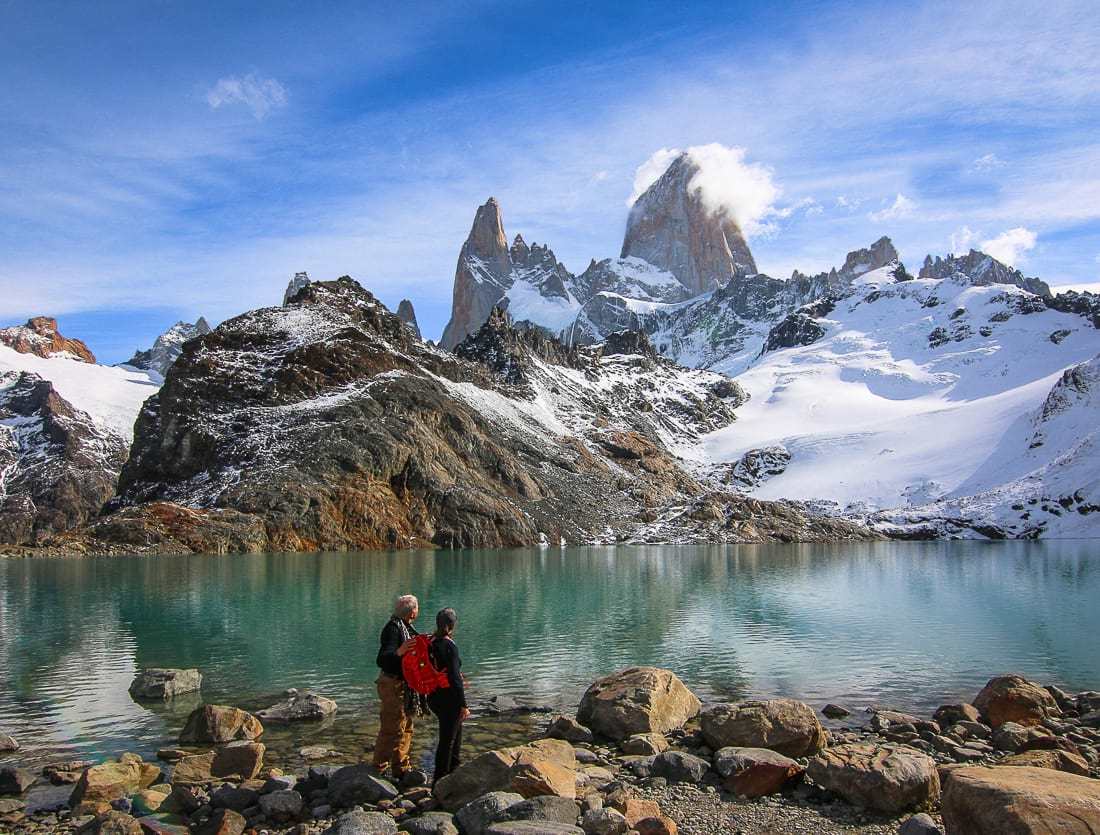
Climate in Patagonia is pretty strange. The weather may go from one extreme to the other in less than a couple of hours. You can pretty much count on very strong winds, rain, mud, and sometimes snow at any time of year. Deciding what would be the best time for you depends on your preferences, expectations and budget.
The weather is not as stable as in summer, but it’s still nice and the park is not yet full. This is one of the two shoulder seasons when you may get better prices and still have a pretty good chance for good weather.
The best tie for hiking in Patagonia. Warmer weather and less less rain, but very strong winds. Temperatures are in the mid 50s F to low 60s F. Summer the busiest season of the year and most places in Patagonia are full to capacity.
Temperatures are cooler than in summer, but there is generally less wind. The weather is still great for hiking. You may experience more rain and possibly snow. Best time for hiking because the great fall colors. Less crowds and lower prices.
The weather is cold and very unstable. Trails are closed because of the harsh conditions. Refugios and campgrounds are closed and so are most hotels in Torres del Paine and El Chalten. Great time for seeing the Southern Lights.
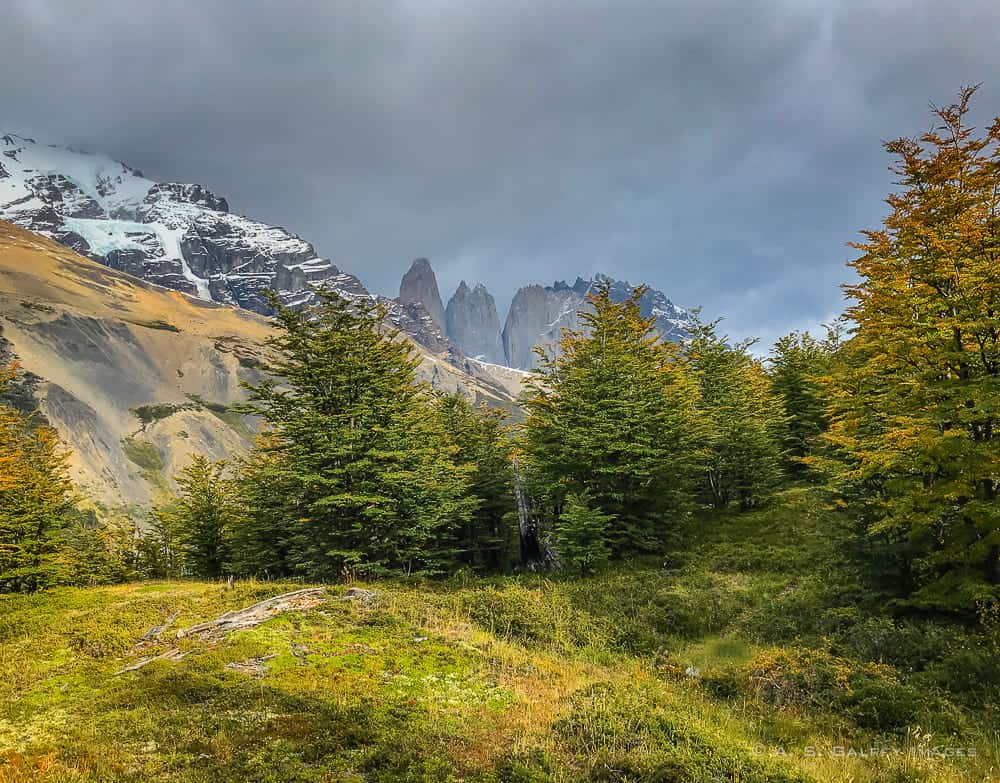
Trekking in Patagonia requires athleticism, endurance and a spirit of adventure. Doing one of the circuits in Torres del Paine can take anywhere from 4 to 8 days and is physically very challenging. You hike a lot of miles each day (mostly uphill) on very rocky trails.
At night you sleep in a tent that is exposed to the elements. So whatever weather is out there you will feel it all: wind, rain, snow or sun. Leave alone the horrible food, the bed bugs, and the horrific sewage odor in campsites and refugios.
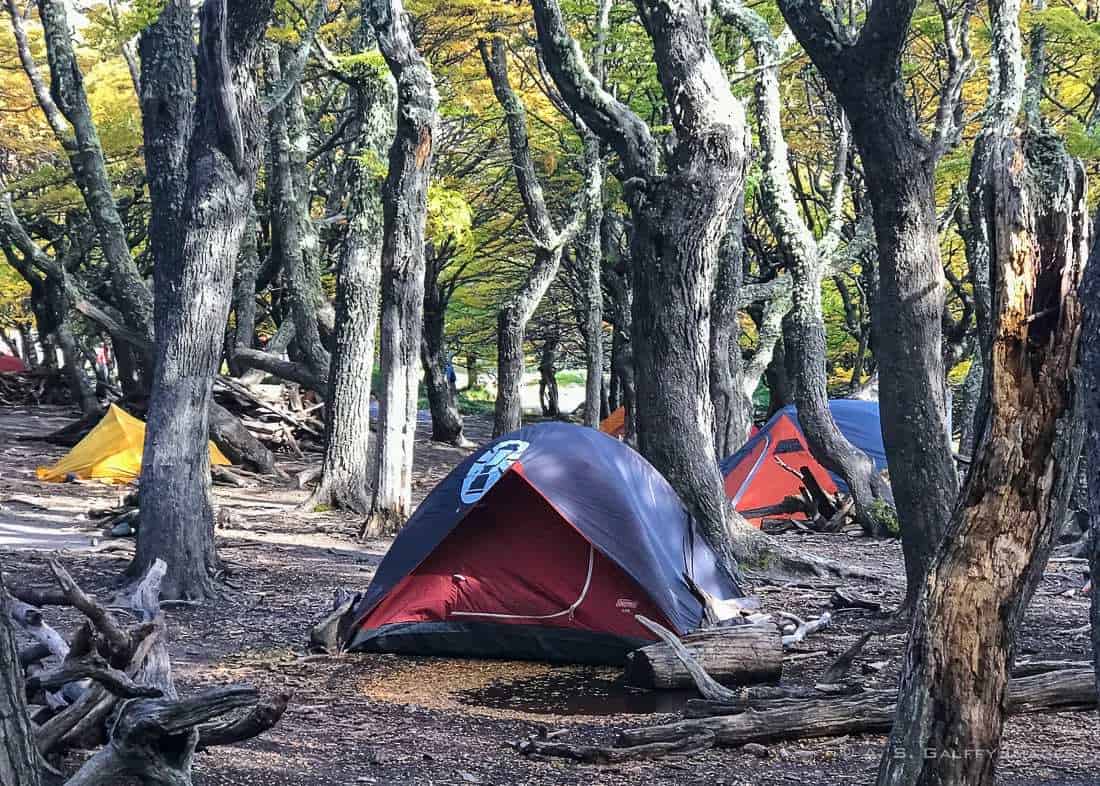
On the other hand, day hikes can be just as beautiful and rewarding. Patagonia is a maze of hiking trails varying from easy, to moderate and more difficult.
If you have no interest in carrying a huge backpack and setting up a tent in the Patagonian wind, you have the option of staying in a nice hotel room and doing day trips. I just need to mention however that this option is more costly.
Trekking or hiking in Patagonia is no walk in the park. Especially if you want to do one of the circuits in Torres del Paine. It’s not the technical difficulty of the hike or the altitude that makes it seem strenuous. It’s the length of the trails, the moodiness of the Patagonian weather, and the weight of your rucksack that will drain your strength.
That doesn’t mean that hiking in Patagonia is only for the pros or the extreme adventure seekers. In fact, thousands entry level backpackers and trackers hike every year in Chilean and Argentinian Patagonia. But it certainly helps to have some hiking experience under your belt before you venture here.
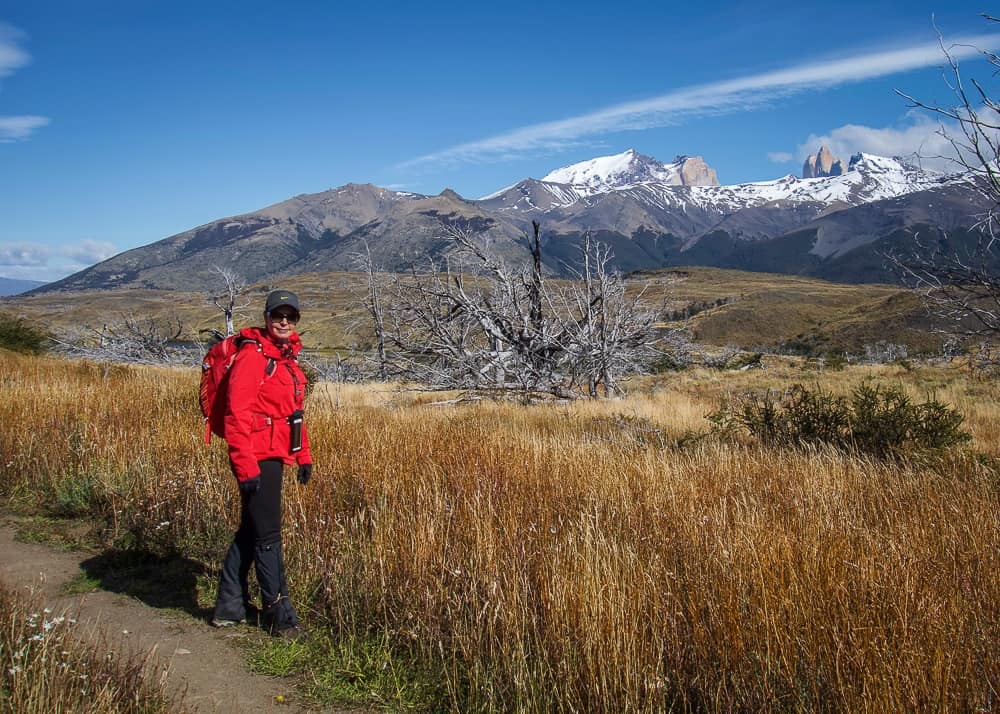
Hiking in Patagonia is doable even for people with an average level of fitness. Depending on the trails you choose, you may need more or less experience. We had a more difficult time hiking the Kalalau Trail , in Kauai, that hiking most of the trails in Patagonia. Trails in Patagonia vary from easy to moderate and more difficult.
You can choose from guided to self-guided tours, but you don’t really need a guide for hiking in Patagonia. Also, unlike the Everest Base Camp where you’ll need a permit for trekking, you won’t need any license or permit for hiking in Patagonia.
Trails are marked and well maintained, so and it’s practically impossible to get lost. In Torres del Paine there are also ranger stations or campgrounds every few hiking hours.
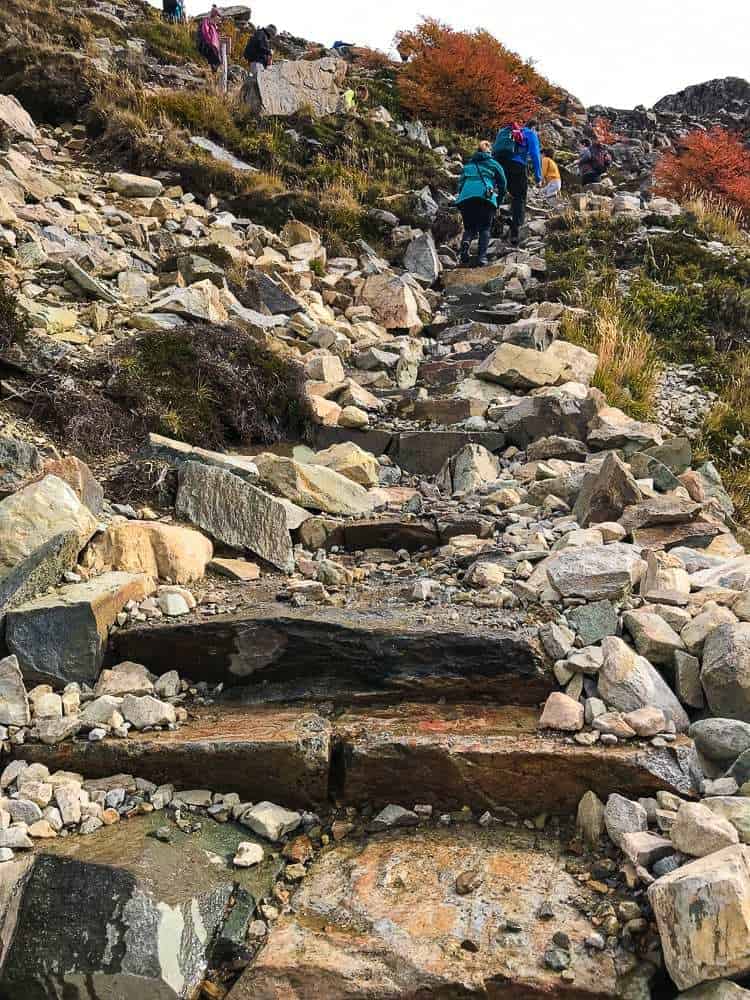
One thing to keep in mind when hiking in Patagonia is the weather. While it’s true that Patagonian weather may change in the blink of an eye, there are still good short term predictions that may help you decide whether to start on an easier or more difficult hike.
Always dress in layers, no matter how the weather looks like. You will constantly be taking off and putting on clothes. I promise you that!
Carry a light backpack if you plan to do day hikes. Some tracks may be quite challenging and the weight of your backpack may drain your strength.
There is plenty of clean water all around in Patagonia, so you can fill your bottle from any stream. Just make sure you bring a refillable bottle with you on the trek.
There is no set way to hiking in Patagonia. Some choose the rough and spartan trekking experience of the circuits and have no problem of sleeping in tents or Refugios. Others, like me, prefer to do day trips and sleep in the comfort of a hotel room at night.
Each route is unique and beautiful, which makes hiking in Patagonia a great experience for everyone attempting it. And this couldn’t be more obvious then when you see the wide diversity of tourists in the region.
READ NEXT: Patagonia packing guide for lots of useful information on what to pack for your trip to Patagonia
Did you find this information useful? Pin it to help other travelers to Patagonia
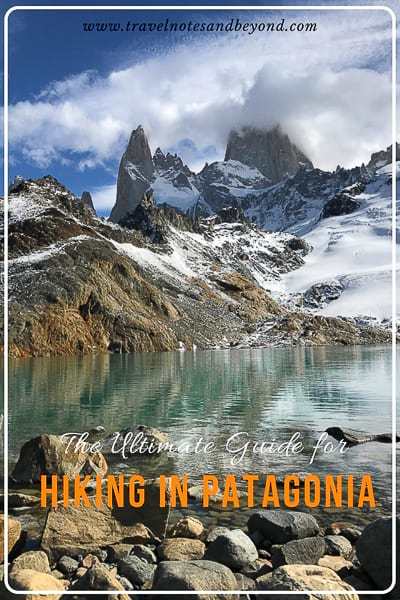
Anda is an award winning travel writer, avid globetrotter and passionate photographer. She is the voice behind "Travel Notes & Beyond," a collection of stories and travel impressions from her wanderings around the world. When she is not busy writing, traveling, or editing photographs, you can find her hiking in the foothills behind her house together with her husband and their dog.
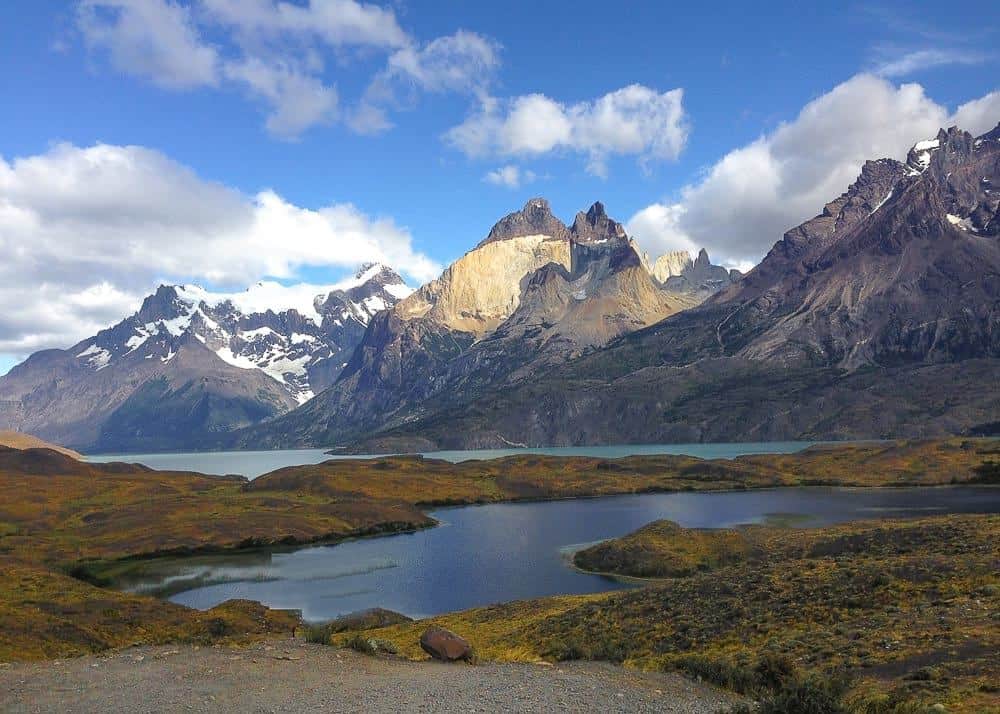
Reader Interactions
March 23, 2019 at 11:21 am
I love the photo of the alpacas crossing the road! This is a great comprehensive guide to Patagonia. I appreciate that you are blunt and educate your readers that the trails are not for everyone. It’s definitely not a beginner’s hike. This is definitely on my bucket list!
March 23, 2019 at 10:08 am
I’m planning a Patagonia trip for early 2020, so your post came at the perfect time! I’ve done some bigger hikes like Mt Kilimanjaro but always with porters and guides, so I’m looking forward to doing a completely self-sufficient hike where I carry all my gear, tents, sleeping bags, etc. Patagonia has been on my list for a while, so I am super excited that I’m finally getting to do this!
March 23, 2019 at 5:53 am
The landscapes in Patagonia are truly spectacular. I love to hike, and although I cannot do anything strenuous due to health reasons now, it is an activity that is very close to my heart. I’m also very much like you and would prefer the day trips and sleep in comfortable hotel rooms. Just reached that age when I need a good clean bathroom and a nice soft bed at the end of a tiring day.
Stuti Shrimali
March 22, 2019 at 8:56 am
Anda, that’s a Wonderful post You have written. Patagonia is so mystique. I am sure you had a lovely time. I would love to do day trek as well for that will give me the opportunity to enjoy the view as well. But if there’s a chance to sleep under the sky, I would happily camp (if there is a possibility).
Anda Galffy
March 22, 2019 at 9:36 am
Patagonia is a Paradise for camping. In fact there are more camp sites and refugios in the National Parks of Patagonia than there are hotels. However, with the weather being very unpredictable and extreme, camping is not an easy task.
March 22, 2019 at 1:10 am
I must say I have not visited this part of the world and have it on my list quite high. With the kids getting older I’m ready to venture out to the South American wilderness and the Hiking in Patagonia is without a doubt topping it. The natural beauty of the area and the wildlife you come across is unparalleled. Live the shot of those deers you have captured. A bit of planning required but the reward are great. Thanks for sharing.
Angelica Kajiwara
March 21, 2019 at 6:42 pm
You are giving me so many dreams for the future. My Littles are 3, 3, and 1, so I think we’d have to do this kid-free and put it on our list for when they’re older. I’m amazed at how much they love hiking already. Can’t wait to experience Patagonia with them.
Jane Dempster-Smith
March 19, 2019 at 1:03 pm
Excellent tips here Anda. We were in Patagonia last year and was astounded by its beauty. We are not experienced hikers but we enjoyed many of the smaller day hikes. The beauty of Mount Fitz Roy is well worth the hike to view it. The towns of El Chalten and El Calafate are great places to stay and to use as a base for the hikes. Thanks for sharing your tips.
March 19, 2019 at 4:55 am
We are a family hiker based in Switzerland so yes yes yes Patagonia, eapecially in Torrea del paine is on our hiking list! What an incredible experience! Although the weather changing situation scares me a bit! I wonder also how the area looks like now after the big fire in 2011!
March 19, 2019 at 10:26 am
Patagonia is really beautiful. As for the fire damages, you’ll be surprised how quickly nature regenerates itself. Of course, you can still see the fire traces, but the devastation didn’t take away Torres del Paine’s charm.
Blair villanueva
March 19, 2019 at 1:05 am
I admire those gorgeous landscapes and slopes, your ohotos are like paintings 🙂 I understand how expensive the hotel is, they are so lucky to have this beauty. Where will be you next destination?
June 21, 2018 at 5:17 am
So much natural beauty. Your pictures are like those gorgeous desktops that we have. And the fact that you can explore them all with hikes makes this place even more amazing. Rightly said about the long hikes being tough owing to the unending trails. It takes a lot of patience to keep going in places like this.
Kirstie Saldo
June 20, 2018 at 6:56 pm
Beautiful landscape! Even a person who doesnt enjoy hiking would love to go here! I hope it is okay for a beginner like me!
Anneklien Meanne
June 19, 2018 at 8:52 am
Wow Patagonia has been on my hiking list for a while now and reading your post makes me book my trip very soon! Torres del Paine looks so stunningly beautiful, thats ice capped mountains are so picturesque!
June 19, 2018 at 7:43 am
Personally, I’d love to try a multi-day trek in Torres del Paine for those views! Good to know about the best season to visit as it plays such a big role for experiences like this although it sounds like you need a lot of preparation to endure it.
Personally, I’d love to try a multi-day trek in Torres del Paine for those views! Good to know about the best season to visit as it plays such a big role for experiences like this although it sounds like you need a lot of preparation to endure it. Great photos btw! <3
Sandy N Vyjay
June 19, 2018 at 7:28 am
Trekking Torres del Paineindeed sounds like an experience of a lifetime. The landscapes really look out of the world. Your pictures bring alive the terrain in vivid colour and tempts one to head over there. It is nice to know that though the trek has its challenges it can be done by amateurs as well. Hope to get there someday and experience first-hand the thrill of trekking there. Till then thoroughly enjoyed reading about it here.
Punita Malhotra
June 18, 2018 at 9:09 pm
This post comes at the right time for us, as we are planning a trip to South America this October. That means ‘spring’, as you mention here. Do you have any recommendations for day trip planning? Should we go with a tour operator?
June 18, 2018 at 11:56 pm
You don’t need a tour guide in order to explore Torres del Paine. If you are interested in day trips in this national park, you should read my other posts about Torres del Paine. I have a long list of recommendations regarding how to get to the park as well.
June 17, 2018 at 11:03 pm
Stunning pictures, looks like a great place with good hiking options. The map you added gave a clearer picture of the possible hikes. Long since I stayed in a tent for the night, looks enticing from that point.
Catherine Salvador Mendoza
June 17, 2018 at 10:25 pm
Yep! So useful! I was actually waiting to read that even tho this kind of hike at Torres del Paine is not a walk in the park, could also be friendly for beginners like me. I’ve done mountain climbing, not so high ones, and trekking, you are right that it needs at least a warm up before trekking here. The landscape is extra rewarding but most fav part is sleeping in a tent! Not to mention that different types of elements going to participate such as bugs, etc!lol
June 17, 2018 at 9:38 pm
Actually I was just chatting to my best friend about his trekking experience there because he stayed in the park and dud day treks but found so many people doing the longer ones. He also concurred with the weather and though he was there in December the winds were indeed very strong
Sam (The Scratch Map)
May 13, 2018 at 2:40 pm
Wow, your photos are absolutely stunning! Patagonia has been on our list for a while, in fact after reading this and looking at your pictures it may have jumped a couple of places up the list! I feel I may need to get in better shape to get the best out of a trip here though, but I’m guessing the altitude isn’t much of an issue if it’s mostly sub 3000m?
May 13, 2018 at 6:32 pm
You are right Sam, the altitude is not an issue in Patagonia.
May 9, 2018 at 9:50 pm
Thank you, Anda! I’ve really wanted to visit this part of the world, but always thought there weren’t many day hike options – time to start planning my trip now that I know I don’t have to trek for more than a day! And your pictures are absolutely gorgeous.
May 9, 2018 at 11:55 pm
Thanks for dropping by, Cindy. Always good to hear from you. Yes, Torres del Paine is a wonderful place to visit and you don’t really need to be an experienced hiker in order to have fun there.
Jessica Norah
April 22, 2018 at 9:45 am
Hi Anda, Some great information for those thinking of hiking here! We’ve heard lots of good things about this area. Did you do a circuit or day hikes here? Jessica
April 22, 2018 at 3:42 pm
Just day hikes, Jess. The circuit is brutal. It implies sleeping in a tent or a refugio (just slightly better than a tent) and facing the dreadful Patagonian weather.
April 21, 2018 at 9:21 am
I’m speechless after reading this post. Torres del Paine has gone straight to the top of my travel wish list. I’m a total new person to hiking, but appreciate the information on these routes. I think I’d like to travel there in spring or summer. I know the heat would get to most people, but I’m a sunshine person, and would also love to capture these scenes in the sunlight.
Rhonda Albom
April 21, 2018 at 4:00 am
Those multi-day circuits look quite brutal for a softie like me. I like the idea of day treks and heading back to a comfortable hotel at night. Roughing it in a tent or even a refugio would have been fine 30 years ago. Driving in and back to comfort after a day trek works for me.
April 20, 2018 at 10:57 pm
That really does look like the trip of a lifetime! You captured such stunning photos, I can only imagine how wonderful it must be to see those views with your own eyes. It’s great that you included info on how the different seasons will affect a trek and the very informative trek routes!
April 20, 2018 at 5:46 pm
Wow! I wish I had the courage and endurance to trek Torres del Paine. The views are absolutely stunning and I’m sure very well worth it in the end. It’s crazy how the weather can change within hours and the altitude is another challenge in itself.
April 20, 2018 at 12:53 pm
Such a great post! Ps. I have tried adding the code for the badge to my post three different times (ways) and it’s not working. Is it wordpress compatable? I’ve linked to you just via your website since i couldn’t make the badge work! Lee
April 20, 2018 at 12:31 pm
This is such a great guide. I love when bloggers include the best time to visit. That is so important to me. I haven’t been to Torres del Paine yet but would love to go. I am sure I would have to exercise a little bit before the hike. I am used to high altitude so that wouldn’t be a problem, but still not fit to do large hikes like this. Thank you for sharing, such a good read 🙂
April 20, 2018 at 3:43 pm
Surprisingly enough, altitude is not a problem in Torres del Paine. The length of the trails and the moody weather is, however.
LaiAriel Samangka
April 20, 2018 at 4:20 am
Wow, I’m innately into trekking and camping, and reading this makes me grinning from to ear. I truly love the unassuming beauty of Torres Del Paine. The scenery along the way is breathtakingly stunning. If this would only be just so close to where I am now, I will surely get here by tomorrow. Thank you for providing all the useful tips and guide for this will be a great help for those that are planning to climb Torres Del Paine.
April 18, 2018 at 12:53 pm
Patagonia looks absolutely breathtaking! Thank you for such a detailed post, I would love to go on a hike there.
Stephanie (1AdventureTraveler)
April 17, 2018 at 9:35 am
With beautiful landscapes there, this looks like the ultimate place to hike. The Torres del Paine Southern Patagonia. Your information is spot on and would give me a hiker some choices to make. Seems like one of the many difficulties is the altitude. I would love to hike the circuit. Great information plus a link on what to pack in your bag. Thanks for sharing!
April 17, 2018 at 10:18 am
I think you misunderstood, Stephanie. Altitude is NOT an issue in Torres del Paine. The moody weather on the other had is. Hope you’ll get to hike in Patagonia someday.
Lyn aka The Travelling Lindfields
April 16, 2018 at 4:48 am
I love the idea of multi-day hikes but realistically I think my age, fitness level and health is far more suited to day trekking. This is definitely one for the bucket list.
April 17, 2018 at 10:19 am
I’m with you on that, Lyn. I am no longer at the age of sleeping in tents and enduring rough conditions, hahaha!
Paul and Carole
April 16, 2018 at 1:56 am
Wow what a stunning landscape Patagonia has. This is a really useful post, great detail. Have pinned.
April 14, 2018 at 8:47 pm
Anda, it is great to have insight into this beautiful part of the world. We have Chilean friends and they have invited us many times to their country. The idea is to spend some days in the capital and then move to the southern part of the country. We will love to do that one day. Right now, I am kind of hooked in Europe.
April 14, 2018 at 11:35 pm
I know what you are saying, Ruth. I love Europe too. However, Europe is easy to visit at any age, while Patagonia is a place that will test your endurance. Better go there while you are still young and energetic, lol!
April 14, 2018 at 1:00 pm
Stunning photos as always, Anda – you’ve really inspired me to attempt this one day although I’m so bad with cold weather! I’m a bit confused as to how you did your trip – the trekking routes you mentioned seem to be multi-day treks, so you carry everything with you as you hike from one place to another? But then you also had a car? (Sorry if I’m being a bit thick!)
April 14, 2018 at 3:49 pm
Hi Michelle, sorry for the confusion. We did not camp or stayed in refugios. We just did the day hikes, which means we did parts of the trekking circuits. Staying in a tend in these dreadful weather conditions is way too hard for me. Maybe I would have attempted this if I were 20 years younger, hahaha!
April 14, 2018 at 12:42 am
Beautiful place! I have been dreaming of going to Patagonia forever. I think it is a destination on every hikers bucket list.
April 14, 2018 at 3:50 pm
Patagonia is truly beautiful, but I don’t think I would like to live there. It’s way too remote for me, but some people like it precisely because it is remote.
April 13, 2018 at 1:16 pm
I love you photos! Its a bit hard to read these articles as Torres del Paine is on my bucket list for a long time 🙂 Pinned for later.
April 13, 2018 at 3:03 pm
Thank you, Thomas. I hope you’ll get to see torres del Paine someday. It’s really worth the trouble getting there.
April 13, 2018 at 10:24 am
The mountains — snowy and with jagged peaks behind that — got my attention. Then there’s the lake. And then, best of all — wildlife! It would be a dream to hike here.
April 13, 2018 at 3:05 pm
Indeed, there is a lot of wildlife in Torres del Paine. Those guanacos were as cute as they can be!
April 12, 2018 at 1:58 pm
Yes, apparently the campsites and hostels have limited space, so if you plan to travel during their high season I would recommend booking at least 4-5 months in advance.
April 11, 2018 at 12:20 pm
Amazing detail in your post. The pictures really jump off the page at you. O know want to go here for sure. Looks like one would need to do some fitness training before taking this on
April 11, 2018 at 4:36 pm
Not necessarily, Mark. You can take very easy walks in the park or just do as much as you want. There hikes for all level of fitness. Hope you’ll make it to Patagonia someday. It’s a really beautiful corner of the world.
April 11, 2018 at 4:46 am
This is such a beautiful and incredible place, and one country I’d like to see one day. This hike is probably not for beginners like me, but regardless, I’d like to try! Great tips on the day trips! At least I have a chance to see some of these beautiful sites.
April 10, 2018 at 8:44 pm
The landscape here is extremely gorgeous. I still can’t get over how expensive the hotels are, but I’d definitely like to stay in one since I am a novice hiker.
April 11, 2018 at 4:40 pm
There are hikes for every level in Torres del Paine. Besides, you can go as far as your strength will last, so don’t worry.
Leave a Reply Cancel reply
Your email address will not be published. Required fields are marked *
Save my name, email, and website in this browser for the next time I comment.
COPYRIGHT NOTICE
All rights reserved © Travel Notes & Beyond. The material on this website is protected by copyright law. Republishing the content on this blog (including text, photography, etc.) is strictly prohibited.

AFFILIATE PROGRAM DISCLOSURE
Some of the pages and posts of this blog contain links to products and services that may be useful for my readers. When clicking on these links you will have the option to purchase or register for a service at no extra cost to you, but doing so can help me offset the costs associated with running this blog. Thank you for your support!

Ultimate W Trek Patagonia Map Guide: Tips, Routes, Distances and Essentials for Hikers

Travel Resources
- Accommodation at the best prices.
- Book activities and excursions in Spanish.
- Find cheap flights.
- Rent your Car for Patagonia
- -5% eSIM discount with unlimited data and no roaming charges
- Store your luggage for US$ 5.90 per day
- Travel and cancellation insurance with -5% discount
- I will organize your trip
Are you ready to embark on an unforgettable hiking journey in one of the most stunning landscapes on Earth? Patagonia’s Torres del Paine National Park in Chile is home to the iconic W Trek, a five-day adventure that takes you through the heart of this breathtaking region. In this ultimate guide, we’ll cover everything you need to know about the W Trek Patagonia map, from the detailed day-by-day itinerary to essential tips on weather, accommodations, food, safety, and more. Get ready to experience the adventure of a lifetime!
Key Takeaways
- Explore Patagonia’s wild beauty on the iconic W Trek with this comprehensive map overview
- Challenge yourself by grasping distances between key points and enjoy an unforgettable journey
- Prepare for your adventure with essential tips, trail distances, itinerary breakdowns & packing essentials!
W Trek Patagonia: A Comprehensive Map Overview
The W Trek in Patagonia is a thrilling multi-day hiking route that takes you through the mesmerizing Torres del Paine National Park, one of the most remarkable hiking destinations in South America. This 80 km (50 mi) trail offers an exhilarating blend of spectacular scenery, challenging terrains, and unforgettable experiences.
This section offers a thorough trek map overview of the W Trek, covering key points of interest and trail distances, assisting in your adventure planning.
Key Points of Interest
The W Trek is famous for its iconic granite towers, the awe-inspiring French Valley, and the majestic Grey Glacier. These breathtaking landmarks will leave an indelible impression on you as you traverse the challenging yet rewarding trails through the national park.
One of the most exhilarating highlights of the W Trek is the French Valley, where you’ll have the opportunity to marvel at both majestic mountains and tranquil lakes. Another must-see is Grey Glacier, an imposing wall of ice that will leave you speechless as you take in its sheer scale and beauty. And let’s not forget Paine Grande, the grandest peak in the park, standing tall and proud as a testament to the incredible power of nature.
Trail Distances
Familiarizing yourself with the trail distances between key points is critical in planning your daily routes along the W Trek. The first day of the W Trek, for example, covers an impressive 22 km (13.6 mi) from Hotel Las Torres to Refugio Los Cuernos.
Throughout the trek, you’ll encounter invigorating hikes like the one up to the towers on the final day, boasting an elevation gain of 900 meters (2,956 ft). Along the way, you’ll also have the opportunity to witness the breathtaking Glacier Grey.
Grasping the trail distances paves the way for better preparedness in tackling the W Trek, optimizing your unforgettable journey through Patagonia’s wild and untamed beauty.
W Trek Itinerary: Day by Day Breakdown
The best way to experience the awe-inspiring landscape of the Torres del Paine W Trek is by taking your time and enjoying it over 4 nights and 5 days. This section provides a detailed day-by-day itinerary for hiking the W Trek in Patagonia, inclusive of recommended stops and accommodations you’ll encounter on your journey.
Whether you’re a seasoned trekker or a first-time hiker, this itinerary will help you make the most of your adventure in one of the world’s most extraordinary landscapes.
Day 1: Hotel Las Torres to Refugio Los Cuernos
Your first day on the W Trek includes:
- Journey from Hotel Las Torres to Refugio Los Cuernos
- Distance of 22 km (13.6 mi)
- Takes around 6 hours
- Follow the Ascencio River to enter the Ascencio Valley
- Pass by the lookout point for the Towers at 900 meters
- Refugio Los Cuernos is aptly named after “The horns,” a pair of stunning granite peaks in the area.
To kick off your adventure, you’ll take the Bus Sur bus from Puerto Natales to Pudeto at 3 pm the day before, arriving in time for the last ferry of the day at 6 pm. The bus fee is CLP 12,000 (US$14), and the ferry fee is CLP 20,000 (US$25). Alternatively, you can opt for a thrilling walk from Laguna Amarga entrance to Hotel Las Torres, and the bus fee from Laguna Amarga to Hotel Las Torres is CLP 5,000 (US$6).
Day 2: Refugio Los Cuernos to Paine Grande
Day 2 of your W Trek adventure takes you from Refugio Los Cuernos to Paine Grande. This portion of the trek covers an impressive distance of 20 km (12.4 mi) and takes around 7 hours to complete. Along the way, you’ll be able to take in the majestic view of the Grey Glacier from several different vantage points.
On this day, you’ll also have the opportunity to explore the French Valley, one of the most breathtaking highlights of the W Trek. This lush, verdant valley offers stunning views of the surrounding mountains and lakes, making it a perfect spot to rest and soak in the beauty of Patagonia.
Day 3: Paine Grande to Grey Campsite
On the third day of the W Trek, you’ll cover the hike from Paine Grande to Grey Campsite. This segment of the trek is a thrilling 19 km (11.8 mi) journey that takes around 8 hours to complete. You’ll start your day at Paine Grande, then head to the Italiano campsite, followed by the Mirador Frances.
If the weather is good, you’ll have the chance to take a detour to Mirador Britanico, where you’ll be able to admire a stunning ring of toothy granite peaks, including the park’s second most famous landmark, the three-horned Cuernos del Paine. Afterward, you’ll finish off the day in the beautiful Francés Valley and campsite.
Day 4: Grey Campsite to Paine Grande
On the fourth day of the W Trek, you’ll hike from Grey Campsite back to Paine Grande. This leg of the journey covers 11 km (6.8 mi) and takes around 3-4 hours to complete. Along the way, you can enjoy the magnificent views of the Grey Glacier and its surrounding landscapes. Once you arrive at the Paine Grande campsite, you can rest and prepare for the next day’s adventure.
As you make your way back to Paine Grande, take the time to appreciate the stunning vistas of Los Cuernos and the majestic mountains that surround you. This day offers a more relaxed pace, allowing you to fully immerse yourself in the breathtaking beauty of Torres del Paine National Park.
Day 5: Paine Grande to Hotel Las Torres
The final day of the W Trek covers the hike from Paine Grande back to Hotel Las Torres. This leg of the journey includes a thrilling afternoon of kayaking, ice hiking, or a short hike to the hanging bridges. As you reflect on your incredible adventure through the wild and untamed beauty of Patagonia, take a moment to appreciate the unforgettable memories you’ve made along the way.
After completing your epic journey, you’ll return to Puerto Natales via bus and ferry. The bus fee from Laguna Amarga or Pudeto to Puerto Natales is US$14 (CLP 20,000/US$23 from Hotel Grey). With your W Trek adventure complete, you’ll head home with a heart full of memories and a newfound appreciation for the remarkable landscapes of Patagonia.
Essential Tips for Hiking the W Trek in Patagonia
Being well-prepared and well-informed is paramount for the best possible experience on the W Trek. This section shares essential tips for tackling the W Trek, covering aspects like:
- Accommodations
Whether you’re a seasoned trekker or a first-time hiker, these tips will help you make the most of your adventure in one of the world’s most extraordinary landscapes.
Weather and Clothing
Patagonia’s unpredictable weather is one of the factors that make the W Trek such an exhilarating adventure. The best time to do the W Trek is from November to early March, when the average temperatures range from 10°C (50°F) to 18°C (64°F). Although it usually rains and snows throughout the hiking season, March and April are the peak months for precipitation, so it’s advisable to bring waterproof gear.
Selecting clothing and footwear for the W Trek requires consideration of factors like the terrain type, weather conditions, and the trek’s length. Be sure to pack a moisture-wicking base layer, a fleece layer for insulation and warmth, and a waterproof jacket and pants to protect against rain and wind. This layering system will help you adjust your clothing quickly and efficiently as the weather changes on the trek.
Accommodation Booking
Accommodations along the W Trek include paid campsites with basic mountain hotels (refugios) and one free campsite. Booking your accommodations in advance is advised, as spaces may fill up quickly, especially during peak season. Websites like Patagonline can help you check availability and book accommodations directly.
When booking accommodations, be sure to consider factors like location, price, and available facilities. For example, Refugio Los Cuernos offers a stunning location nestled between granite peaks, while Paine Grande and Grey campsites provide breathtaking views of Los Cuernos and the Grey Glacier, respectively. By researching and booking your accommodations ahead of time, you’ll ensure a seamless and enjoyable W Trek experience.
Food and Water
Attending to food and water supplies during the W Trek is a significant aspect of your adventure. Most camping sites and refugios have shops and restaurants where you can stock up on supplies and enjoy a hot meal. However, cooking your own food can be a great way to save money and add an extra element of excitement to your trek.
To ensure you stay well-hydrated, remember to bring a reusable water bottle and a water filter or purification tablets. Drinking water can be found all around the park and is of excellent quality. By planning your meals and water supply, you’ll have the energy and stamina needed to conquer the challenging terrain and make the most of your W Trek adventure.
Safety and First Aid
Safety takes top priority when embarking on the W Trek. Here are some essential safety tips to keep in mind:
- Stay reachable and inform people back home about your plans.
- Carry a charged phone with emergency numbers.
- Consider carrying a satellite phone, a hiking guide, or a paper map for added peace of mind and navigation assistance.
It’s also a good idea to carry a small first aid kit, including items such as band-aids, pain relievers, and any personal medications you may need. By taking these safety precautions and being prepared for minor injuries or ailments, you’ll ensure a successful and enjoyable W Trek experience.
Alternative Hiking Routes in Torres del Paine National Park
If you’re looking for alternative hiking options in Torres del Paine National Park, you’re in luck! In addition to the famous W Trek, there are several other exciting trails for you to explore. This section introduces:
- The more challenging and longer O Circuit
- A variety of day hikes
- Shorter treks, perfect for those with time constraints or seeking a less strenuous park experience.
The O Circuit
The O Circuit is an incredible full loop around the Cordillera del Paine, covering a distance of approximately 136 kilometers (85 miles) and taking around 6-10 days to complete. This challenging trek includes the popular ‘W’ route and the more remote backside, offering a unique and rewarding experience for adventurous hikers.
While the W Trek is great for those looking for a shorter and somewhat easier trek, the O Circuit is perfect for those seeking a more rugged and remote experience. The O Circuit takes you through a diverse range of landscapes, including dense forests, vast plains, and towering peaks, offering a true immersion into the wild and untamed beauty of Patagonia.
Day Hikes and Shorter Treks
For those with limited time or seeking a less strenuous experience, Torres del Paine National Park offers a variety of day hikes and shorter treks, including the popular trek Torres del Paine. Some of the most popular day hikes in the park are:
- Mirador Las Torres
- Mirador Cuernos/Salto Grande
- Laguna Azul
- Salto Grande Waterfall
These trails provide stunning views of the park’s most famous landmarks and can be completed in just a few hours.
Whether you’re looking for a leisurely stroll to take in the breathtaking scenery or a more challenging day hike to push your limits, Torres del Paine has something for everyone. With its diverse range of trails and breathtaking landscapes, the park is a hiker’s paradise just waiting to be explored.
Day Trek: Mirador Las Torres
Mirador Las Torres is one of the most popular day hikes in Torres del Paine National Park, and it’s easy to see why. This trail takes you to the base of the park’s iconic granite towers – the Torres del Paine – providing a close-up view that’s truly awe-inspiring.
The trek is a challenging one, covering a distance of about 19 km (12 miles) round trip with a significant elevation gain. However, the effort is well worth it. As you ascend, you’ll pass through lush beech forests and across rushing rivers before finally reaching the turquoise lagoon at the base of the towers. The sight of the sun rising or setting on the towers is a spectacle not to be missed, making this trek a must-do for any visitor to the park.
Getting to Torres del Paine: Transportation Options
Reaching Torres del Paine National Park is easier than you might think, with several transportation options available. This section offers information on bus services and car rentals, assisting in your journey planning to the park.
Whether you prefer the convenience of public transport or the flexibility of driving, there’s an option to suit every traveler’s needs.
Bus Services
There are several bus services available for reaching Torres del Paine from nearby cities like Puerto Natales. We highly recommend either Bus-Sur or Buses Fernandez for your travel to Torres del Paine. The bus ride from Puerto Natales to Torres del Paine costs only $25 USD (return), and you can book your tickets online through websites such as:
When planning your bus journey, keep in mind that there are specific departure times from Punta Arenas to Puerto Natales, such as:
By planning your bus journey in advance, you’ll ensure a smooth and hassle-free trip to Torres del Paine National Park.
Buses Inside Torres del Paine National Park
Once inside Torres del Paine National Park, there are shuttle buses available to transport you between key points along the W Trek. These buses run at regular intervals throughout the day, providing a convenient way to navigate the park and rest your legs between hikes. Be sure to check the timetable and plan your hikes accordingly to make the most of this service. The bus service within the park is an excellent way to save energy for the trail and allows you to cover more ground in a shorter time, enhancing your overall experience of this stunning landscape.
Car Rentals
For those who prefer a more flexible and independent travel option, renting a car is a great choice. To rent a car in Patagonia, you must have a valid driver’s license from your country and be at least 21 years old. The general costs of renting a car in Patagonia can vary, but on average, you can expect to pay around $76 per day for a small car rental.
Top-rated car rental companies in Patagonia include:
- Discover Cars
By renting a car, you’ll have the freedom to explore Torres del Paine National Park at your own pace and take breaks along the way to fully appreciate the breathtaking scenery.
Packing Essentials for the W Trek
Packing the right gear is crucial for a successful and enjoyable W Trek experience. This section provides a comprehensive packing list for hikers embarking on the W Trek, encompassing clothing, camping gear, and electronics.
By ensuring you have all the essentials, you’ll be well-prepared to tackle the challenging terrain and make the most of your adventure in the wild and untamed beauty of Patagonia.
Clothing and Footwear
Choosing clothing and footwear for the W Trek requires consideration of terrain type, weather conditions, and the trek’s length. Here are some recommendations:
- Pack a moisture-wicking base layer
- Bring a fleece layer for insulation and warmth
- Don’t forget a waterproof jacket and pants to protect against rain and wind
This layering system will help you adjust your clothing quickly and efficiently as the weather changes on the trek.
The ideal footwear choices for the W Trek in Patagonia are waterproof all-leather boots with deep treads. Additionally, gaiters can be a great way to keep your feet dry and prevent water from slipping in over the top of the boots. By investing in the right clothing and footwear, you’ll ensure your comfort and safety on the W Trek, allowing you to fully enjoy the incredible landscape and adventure that awaits.
Camping Gear
Camping gear is essential for your W Trek adventure. Invest in:
- A good tent, such as the Big Agnes Battle Mountain 2 or the ALPS Mountaineering Highlands Tent
- A lightweight and compact sleeping bag suitable for cold temperatures
- A roll mat for sleeping
- A mess kit for cooking
Additionally, don’t forget to pack:
- Base layers
- Trekking pants
- Hiking socks
- A waterproof backpack cover
By packing the right camping gear, you’ll be well-prepared to tackle the challenging terrain and make the most of your W Trek adventure in the stunning landscapes of Patagonia.
Electronics and Navigation
Electronics and navigation tools can be invaluable during your W Trek adventure. A GPS device, such as the Garmin inReach Mini or handheld devices from Outdoor Gear Lab and Switchback Travel, can help you stay on track and navigate your way through the park. Additionally, smartphone GPS apps like Gaia GPS and AllTrails can also be useful for navigating your way on the trail.
Remember to bring a charged phone with emergency phone numbers, a satellite phone if available, and a head torch for early morning or late-night hikes. By packing the right electronics and navigation tools, you’ll ensure a safe and enjoyable W Trek experience, allowing you to fully explore the breathtaking landscapes of Torres del Paine National Park.
In conclusion, the W Trek in Patagonia’s Torres del Paine National Park offers an unforgettable adventure through some of the most breathtaking landscapes on Earth. By following our comprehensive guide, you’ll be well-prepared to tackle the challenging terrain, plan your accommodations and meals, and make the most of your time in this extraordinary region. So lace up your hiking boots, pack your bags, and get ready to embark on the adventure of a lifetime!
Frequently Asked Questions
How long is the w trail in patagonia.
The W Trek in Patagonia is a moderately difficult hike covering 46 miles (76km) and typically takes 4-5 days to complete. It includes mainly gentle terrain with some challenging climbs of up to 800m. Be sure to come prepared for varying weather conditions.
Where do you sleep on the W trek in Patagonia?
On the W Trek in Patagonia, you can sleep in shared dormitories or upgrade to a private alternative. There are five refuges/campsites available along the route: Grey, Paine Grande, Frances, Cuernos and Central – check out our post for all the details!
What is the hardest trek in Patagonia?
The El Chaltén Trek in Patagonia is one of the most difficult treks to undertake, featuring demanding nature and views of Cerro Solo. So be prepared for a full test and take advantage of stunning scenery in this lesser-known area!
What is the best time of year to hike the W Trek?
The best time of year to hike the W Trek is from November to early March, when temperatures are mild and the weather is more stable for optimal trekking conditions.
How long does it take to complete the W Trek?
You can conquer the W Trek in 4-5 days, depending on how fast you go and what route you take.
PAINE TREKK
Book Travel Consultation
Book a 30-minute consultation with a travel expert to optimize your planned trip. I will assist you in organizing your trekk in Torres del Paine, ensuring an unforgettable adventure.
Book a 30-minute consultation with a travel expert to optimize your planned trip. I will assist you in organizing your trek in Torres del Paine, ensuring an unforgettable adventure.
My organised trips to Patagonia
In the carousel below you can see already assembled itineraries for inspiration, click on the one you are interested in and ask me for a quote.
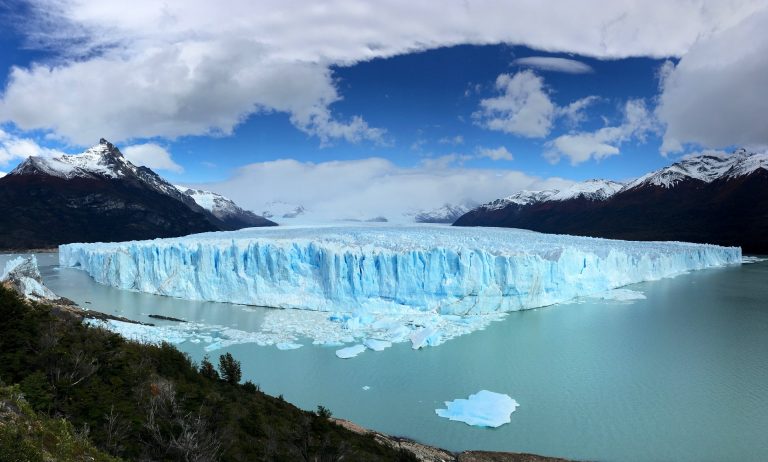
Compact trip through the southernmost Argentinean Patagonia: Ushuaia and El Calafate
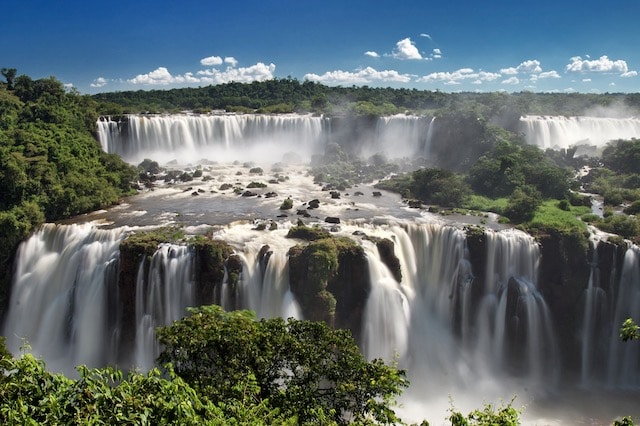
Enjoy the 3 most relevant ecosystems in Argentina: The End of the World, The Glaciers and the Iguazu Falls.
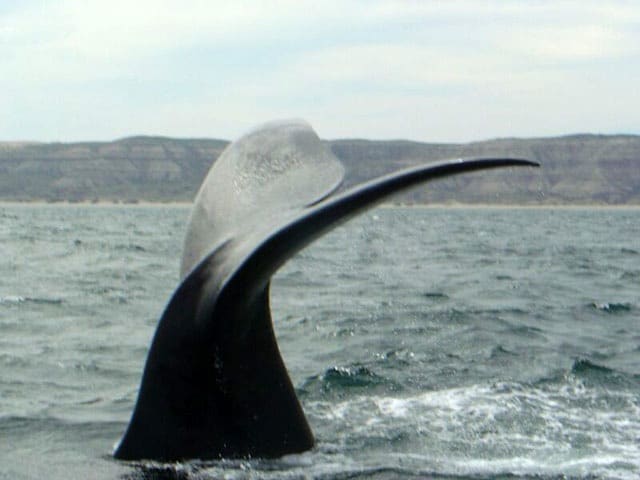
Trip to Patagonia Argentina in 7 days touring the most beautiful landscapes of Patagonia Argentina (Peninsula Valdés & El Calafate)
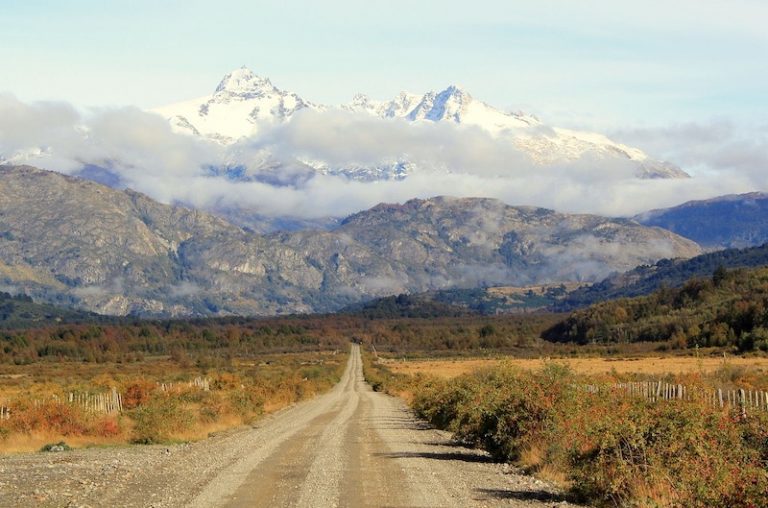
The Carretera Austral by rental car is probably one of the most spectacular routes in Patagonia, designed to be travelled with plenty of time in your rental car.
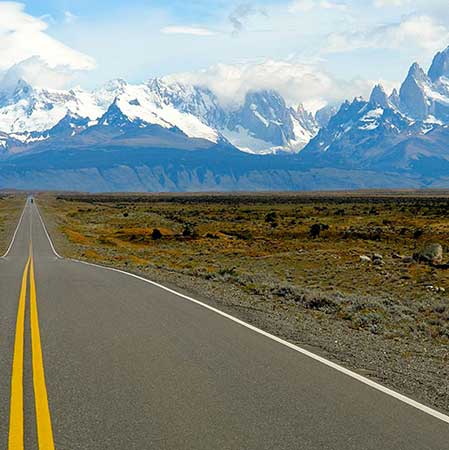
Tour along Route 40 in Patagonia, starting on Route 3 on the Atlantic coast and continuing along Route 40 until reaching the Andes Mountains and El Calafate.
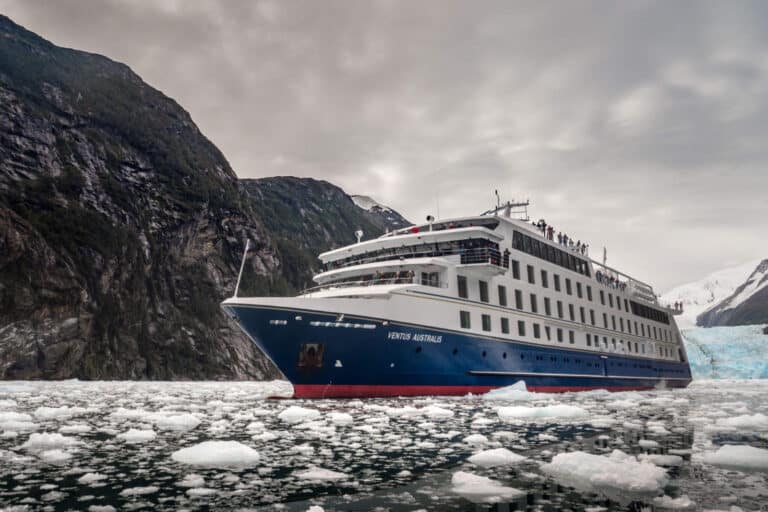
The Australis Cruises are Expedition Cruises that sail through the Strait of Magellan and the Beagle Channel, exploring one of the most beautiful and unspoiled regions of the world such as Patagonia and Tierra del Fuego.
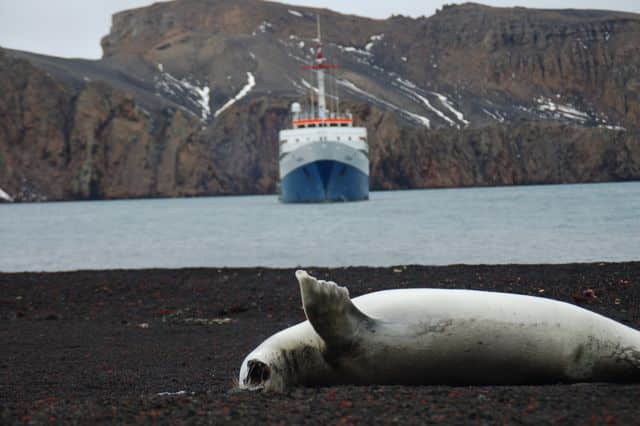
The Antarctic Cruise aboard the MV USHUAIA offers you an incredible introduction to the 'White Continent' at a reasonable price.
Book your tours
Search for your hotel, related posts.
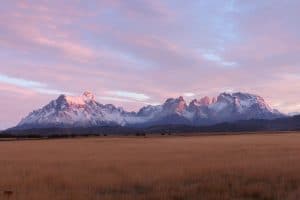
Where is Torres del Paine
Torres del Paine National Park is located in southern Chile, five hours north of Punta Arenas,

Torres del Paine how to get there
Torres del Paine National Park is remote, a characteristic that adds to its intrigue but also
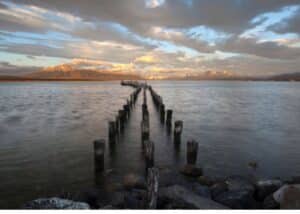
Where is Puerto Natales
In the south of Chile, Puerto Natales is one of the must-see places for those who
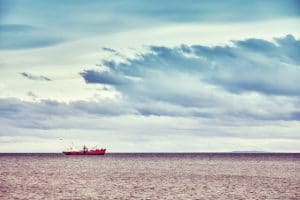
Where is Punta Arenas
Punta Arenas is located at the southern tip of South America, just north of the Strait

About the author
I am Matias, born in Patagonia, and a lover of my land.
For more than 20 years I help foreign travellers to organise their trip to Patagonia.
I also manage this exotic accommodation on the Atlantic coast.
- Torres del Paine

Latest posts
- Best Tango Show in Buenos
- Best Patagonia Travel Books
- Hop On Hop Off Buenos Aires
How much does a trip to Patagonia cost?
Excursions from el calafate – quick guide 2024, top 15 must-see argentina locations for your 2024 trip, argentina vacation guide: explore top destinations and tours, top-rated patagonia tour companies for 2024/2025 adventures, is there a train from buenos aires to patagonia, can you fly from buenos aires to patagonia, explore the majestic ice: your ultimate perito moreno glacier tour guide, destinations, save on your trip.
- Book your excursions
- Search for cheap flights
Terms & Conditions / Privacy Policy
You are using an outdated browser. Please upgrade your browser or activate Google Chrome Frame to improve your experience.

- Trip Styles
- Destinations
- Patagonia Hiking Tours

- Global Hiking Vacations
PATAGONIA HIKING & TREKKING
Enjoy a once-in-a-lifetime trip to Patagonia, one of the most incredible hiking destinations in the world!
Patagonia is, simply put, a hikers’ paradise. The region of Patagonia encompasses the southern tip of South America in both Chile and Argentina, where the weather and climate mirror that of Northern Canada and Alaska in the Northern Hemisphere. This awe-inspiring landscape is home to a stunning sliver of the Andes Mountains, as well as deserts, steppes and grasslands. Wildland’s Guided Patagonia hikes are all-inclusive opportunities to discover Patagonia’s sheer granite spires, towering mountains, glaciers, lakes, rivers, wildlife, and more!
Our Patagonia hiking tours are focused on Torres del Paine National Park, an invaluable conservation and wilderness gem in Chile; and Parque Patagonia, a vast wilderness preserved through private conservation funding and donated as a national park to the Chilean Government. We have plenty of itinerary options for those that love to hike, for all abilities and levels of comfort. Come explore one of the world’s most premier adventure travel destinations on your next unforgettable hiking vacation!
Check out our list of Guided Patagonia hiking and trekking tour options below or give us a call at 1-800-715-HIKE (4453) to request more information or reserve a spot today!
World-Class Hiking Destinations

Patagonia National Park
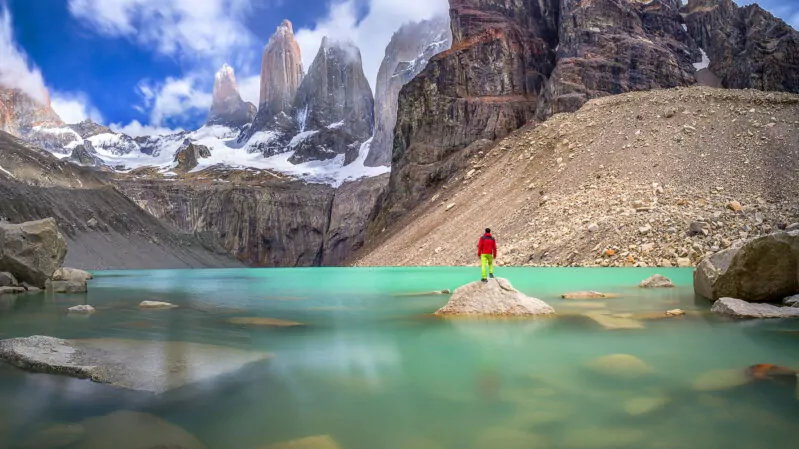
Torres del Paine Treks
All patagonia hiking tours trips ( 6 results), filter trips.
Trip Length
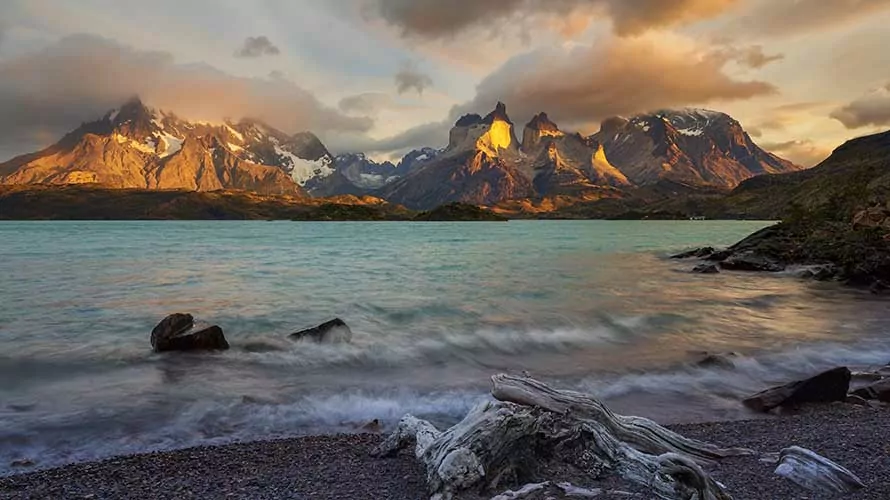
Fall Colors in Patagonia Lodge Based Trip
Wild Patagonia Explorer
Torres Del Paine W Trek
Torres Del Paine O Circuit
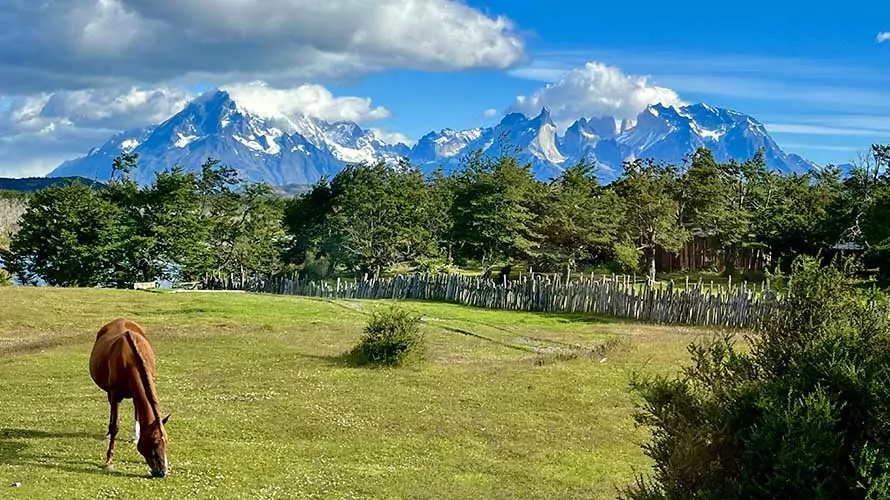
Patagonia Lodge Based Trek

Villa Serrano Add-On Package
WHY HIKE PATAGONIA WITH WILDLAND?

1. TOP RATED ADVENTURE TRAVEL COMPANY
For 15-plus years Wildland has been leading guests on hiking adventures around the USA and the world. In that time our trekking adventures have earned 4,000-plus online reviews, with more than 99% of those 5 stars. These reviews are also on third party review sites (Trip Advisor, Google, Trust Pilot, etc.) which has a much higher level of integrity than self-hosted reviews.
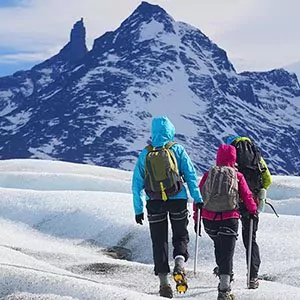
3. ALL-INCLUSIVE TRIPS
We designed our Patagonia hiking tours so you can focus all of your energy on enjoying the stunning landscapes and experiences this region offers. Our trips include local transportation (with pick-up and drop-off at the local airport), lodging for the duration of the tour, meals, top-of-the-line gear, permits and fees, and of course, expert local Wildland guides.
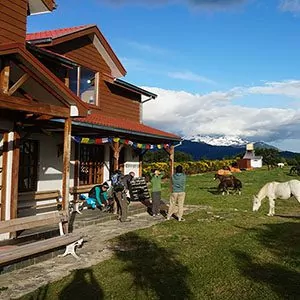
5. HAND PICKED ACCOMMODATIONS & GEAR
Our accommodations are carefully selected to provide a high quality pre-trek and post-trek lodging experience. On our treks, the lodging is in backcountry huts (“refugios”), or – on our Lodge-based Tour – at a wonderful, cozy lodge. And our gear is made by premier outdoor retail companies who specialize in outfitting hiking and camping enthusiasts.
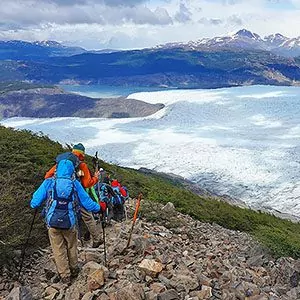
2. ALWAYS SMALL GROUP TRIPS
Our Patagonia trips, like all of our hiking and backpacking tours, are always small groups. Our Patagonia Treks specifically are capped at 12 guests with 1-3 guides. This intimate group size allows us to better customize the experience for each guest, and it also enables our guests to get a deeper and more authentic cultural experience with the local guides.
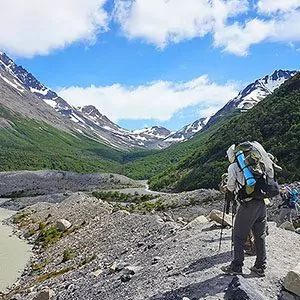
4. LOCAL, EXPERT WILDLAND GUIDES
Our Patagonia guides are some of the very best in the business. Local Chileans, they were carefully vetted, brought onto the Wildland team and trained to maintain our high standards. Our guests regularly rave about our Chilean guides, who are able to give you an immersive experience in the Patagonia culture as well as a world-class adventure travel experience.
Patagonia Introduction Video
Check out a video introduction to our Patagonia trekking program. See video footage and slideshows of our trips including the glacier hiking and sea kayaking portions. Torres del Paine is a national park everyone who loves to travel and hike should visit at least once!

MORE ABOUT PATAGONIA HIKING VACATIONS
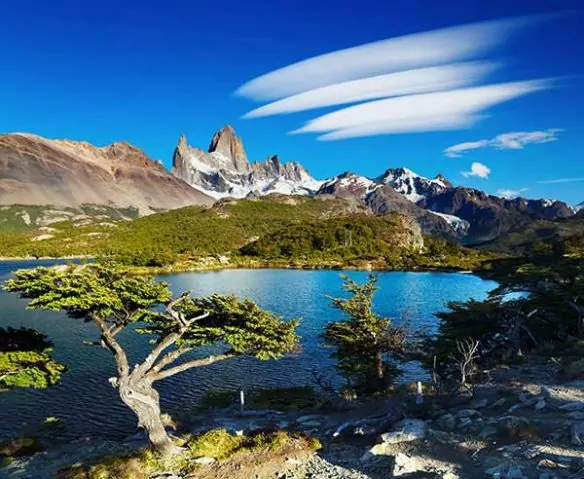
WHY A PATAGONIA HIKING TRIP?
Patagonia is in many ways the South American equivalent of Alaska – it’s a region characterized by vast wilderness; harsh winters; stunning, short summers; and breathtaking, extremely photogenic mountain scenery. Patagonia’s iconic landmarks are the soaring granite towers in Torres del Paine National Park in Chile and in Los Glaciares National Park in Argentina. Guided Patagonia hiking trips are wonderous adventures with glaciers, alpine lakes, waterfalls, unique wildlife, and cozy backcountry accommodations in the region’s “refugios.” Bottom line is if you like to hike and travel, Patagonia is a must-visit destination to add to your “Life List!”
THE WILDLAND HIKING EXPERIENCE
Our international trekking vacations are all-inclusive hiking packages that allow you to explore regions around the world without having to worry about many of the difficult logistics of international travel. We pick you up at the regional airport, provide lodging for the duration of the trek, and drop you back off at the airport on the final day. (If you’d like extra days in Patagonia before or after your trip, we’re happy to help you set that up as well.) We hand-pick unforgettable hiking routes and provide expert trekking guides with in-depth local knowledge and expertise. You can expect wonderful meals, fantastic accommodations that put you right in the action, and top-notch customer service!
TORRES DEL PAINE OR PARQUE PATAGONIA?
One question we receive relatively often from our Patagonia trekking guests is whether to hike Torres del Paine National Park or join us in Parque Patagonia . The answer is pretty straight forward – are you looking to have an iconic and relatively comfortable national park experience, or a pretty hardcore wilderness experience?
In Torres del Paine, we (for the most part) stay in Patagonia’s famous refugios, which are backcountry lodges with dorm-style sleeping, bathrooms, hot meals…etc. Trips in Torres del Paine National Park include the Torres del Paine W Trek , Torres del Paine O Circuit , Torres del Paine Basecamp Tour , and our Lodge-based Patagonia Hiking Tour (which stays in a cozy lodge outside the Park but in a perfect location).
Parque Patagonia, on the other hand, is a massive, recently-designated national park that is mostly deep wilderness and requires backpacking and camping. Not to worry though! The Wildland team has been operating guided backpacking trips since 2005 and are one of the world’s premier backpacking guide companies. We know how to make a trip comfortable, exciting and enriching. We offer one trip in Parque Patagonia right now, which is our Parque Patagonia Trek . Regardless which Patagonia trekking tour you choose, one thing’s for sure – it’s going to be an unforgettable adventure!
HIKE PATAGONIA WITH OR WITHOUT A GUIDE?
Patagonia hiking trips can be done with a guide company or on your own. Patagonia hiking companies like Wildland provide a variety of packages from very, very basic options to premier tours like Wildland’s which are all-inclusive. The value points of traveling with Wildland Trekking are many: the confidence and peace of mind that comes from traveling with a proven, premier trekking company; reservations, permits, and logistics are taken care of for you; worry-free adventure travel as you’re accompanied by expert, highly trained guides; exceptional meals and gear; in-depth knowledge of the local area, flora, fauna…etc. and more!
WHEN TO HIKE IN PATAGONIA
Being in the Southern Hemisphere, Chile has opposite seasons to North America and Europe. That makes their summer months December through February, and shoulder season months October-November and March-April. We heartily recommend trekking in Patagonia in the shoulder months if possible, as the crowds are much lighter than summertime, although the weather can certainly be a bit more spicy. Average temperatures and precipitation in Torres del Paine National Park during these months are detailed in this table:
wildland Wires
Sign up to receive our exclusive Wildland Wire emails and stay up to date with Wildland Trekking's promotions, discounts, contests, outdoor tips and tricks, trip reports and more!
two lost feet

The 7 Best Multi-day Hikes in Patagonia
- Two Lost Feet
- July 10, 2019
We spent 3 months travelling and hiking almost all of the trails in Patagonia. We did everything from the most iconic walks to ones we had never heard of before we arrived. Here’s our favourite 7 multi-day hikes in Patagonia that we suggest every avid hiker add to their bucket list. There’s something here for every ability so have a read through and find one that’s perfect for you.
Dientes de Naverino – Naverino Island
54kms – 5 days
The most Southerly trek in the world. The location of this ‘trail’ alone makes for some incredibly harsh conditions. This plus the fact that there are no facilities and a very poorly marked trail means it is one for experienced hikes only. Good quality gear with the expectations of encountering, snow, hail and strong winds is essential, even in summer.
O and W circuits – Torres Del Paine, Chile
110km – 7 to 10 days
The most iconic trail in all of Patagonia. The Torres day hike as well as the W & O treks have a lot of hype surrounding them, but in our opinion they really do live up to it all. The walk is incredibly scenic and enjoyable and easily one of the best multi-day hikes in Patagonia.
The only downside here is the amount of people that it attracts, but it is easy to see why. Make the most of the long Patagonian summer days by starting early or a little later to avoid the masses.
The other great thing about Torres del Paine is there is a walk to suit every ability. If you feel 7 – 10 days of trekking is too much, look into hiking the W section, or basing yourself near the welcome center and doing some day walks instead. Have a look here for lots more detailed information about the trek.

Laguna Cerro Castillo Circuit – Villa Cerro Castillo, Chile
53km – 4 days
It doesn’t take long for the hike to Cerro Castillo to start climbing up. The hike is quite steep in a few sections and by no means is it easy. But the views along the way are mesmerising. There are 5 designated campsites along the way so you can plan accordingly.
The best part is that most people visiting Patagonia haven’t even heard of hike. This plus the fact that is a little more difficult to reach than others on this list but that means that you will encounter few people on the trail.
Tres lagos – El Chalten, Argentina
32 kms – 2 days
This stunning circuit takes in all of the highlights of El Chalten, combing both Laguna de Los Tres and Mt Fitz Roy into a stunning circuit. It can be completed in a day but we really recommend taking your time to enjoy the beautiful scenery along the way. This was my favourite multi-day hikes in Patagonia. Read all about our hikes in El Chalten here.

Nahuel Huapi Traverse – Bariloche, Argentina
47 kms – 5 days
The classic hut to hut trek in the National Park of the same name just outside of Bariloche is usually completed in 5 days. However each hut has it’s own access track so you can make it as short or as long as you like. As you traverse through mountain ridges and valleys there are beautiful alpine lagunas that the brave can swim in. There are mountain huts along the trail, so it is better equipped than others but most will offer food and a place to camp or a bed for the night.
Lago Del Desierto Border Crossing – Chile + Argentina
34kms – 2 days
The ultimate adventure of crossing a border that can only be reached by foot or bicycle. There are a few different options to make this as challenging or easy as you like. Be sure to check up on recent ferry times and maybe even look into the option of getting transport for the first 15kms by car.
The Huemul Circuit – El Chalten, Argentina
65km – 4 days
This challenging hike is not for the faint hearted. The distances are short but the hiking is tough. There are 2 river crossing which need to be negotiated via a zip line and 2 mountain passes that can get extremely windy. Those who choose to tackle this trek will be rewarded with unparalleled scenery, isolation and one of the most picturesque campsites you can imagine. Another hike that easily makes the list as one of the premier multi-day hikes in Patagonia, especially as it doesn’t attract the same crowds some of the other hikes do. Read more here.
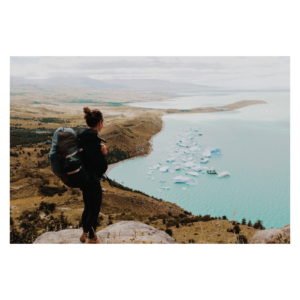
If you have any questions or are planning on tackling one of the hikes we have listed here please let us know in the comments below. Also have a read of our favourite day hikes in Patagonia .
If hiking independently isn’t for you Tour Radar offer some great deals on most of the hikes we have listed here.
Like This Article? Pin It!
Ruby & josh two lost feet, share this post with friends, leave a reply cancel reply, check out some of our other posts.
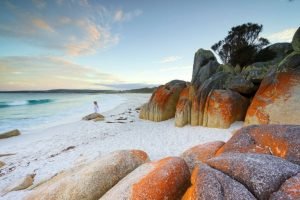
Best Beaches in Tasmania Australia
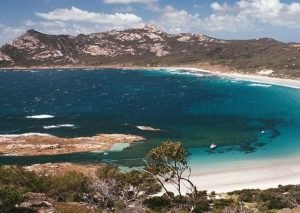
Things To Do On Flinders Island

Plan Your Self-Drive Holiday in Tasmania: A Detailed Guide

Two Lost Feet brings to you all of the insights from a life of travel.
- Travel Resources
- Work With US
Stay Connected
© 2021All rights reserved
September Sale Book now for up to 60% off!

Patagonia Trekking Companies & Trekking Season
Patagonia is a sparsely populated region of the world where travellers flock in impressive numbers to experience Mother Nature at her finest. Located along South America ’s southernmost tip, Patagonia touches both Chile and Argentina , each with their own trails and treks worth exploring. Discover essential information including the best trekking operators and companies for your next adventure.
6686 reviews on
Top 10 trekking companies in Patagonia with reviews
- I ntrepid Travel , 4 tours with 46 reviews
- OneSeed Expeditions , 2 tours with 3 reviews
- G Adventures , 3 tours with 33 reviews
- Exodus Travels , 2 tours with 47 reviews
- Peregrine Adventures , 1 tour
- PhotoFly Travel Club , 1 tour
- Say Hueque & Chile Journeys , 2 tours with 3 reviews
- Destino Montana , 1 tour with 2 reviews
- Much Better Adventures , 2 tours
- World Expeditions , 4 tours with 8 reviews
Patagonia trekking seasons
Due to the enormous size of Patagonia, it can be a bit difficult to choose one perfect time to visit, after all the area is more than one million square kilometres and two countries large. Essentially, the best time for trekking in Patagonia depends entirely on what you want to do as well as your tolerance for extreme weather conditions. If you’re mostly interested in trekking arguably, the most famous natural attraction in the entire region, Torres del Paine National Park , you’ll want to time your visit for the summer season. In Patagonia, summer lasts from November through March and this is when challenging hikes are made easier with warmer temperatures and longer days where every extra hour of daylight is welcomed. During the summer, travellers can expect the temperatures to peak at 22°C (72°F) and fall to about 5°C (41°F) in the evening. Important to note is that many of the trails in Patagonia, including their huts and lodges, are closed during the winter months due to the harsh weather conditions. Winter in Patagonia lasts between June through September.
Patagonia hut to hut hiking
Hut to hut hiking is an excellent way to explore the untamed beauty of Patagonia without sacrificing every last comfort. You can do this type of hike on your own or with a guide, but if you’re at all unsure or inexperienced we strongly recommend booking a tour and taking on the region with an expert at your side. Typically spaced kilometres apart, the huts have shared sleeping quarters and are sometimes equipped with kitchens to ensure you can prepare a hearty meal after a long day of trekking. Some may even have restaurants where you can enjoy food and beverages. Hut to hut hiking is an excellent way to enjoy a challenging trek because you’re able to leave behind the tent, sleeping bag and cooking supplies. Below you can find a few of our favourite hut-to-hut hiking experiences in Patagonia . Torres del Paine W Trek - 5 days This circuit will take travellers to the very heart of the wild Torres del Paine National Park in Chile. You’ll be zigzagging across the Cordillera del Paine where you can expect to see magnificent glaciers, sparkling blue and green lakes and thick forests. Your mountain huts will be in the midst of some truly impressive scenery. Patagonia Lodge-Based - 6 days Providing another in-depth opportunity to explore Torres del Paine, the Patagonia Lodge-Based tour by Wildland Trekking will also take you past turquoise lakes, mountain rivers, beech tree forests and more. This tour expertly combines activities like kayaking, boat-touring with lakeside treks and more. Paine & Fitz Roy Trek - 15 days This ambitious tour itinerary takes you through grasslands, glaciers, peaceful lakes and other Patagonian highlights. You’ll start your tour with day walks in Los Glaciares National Park , staying in comfortable lodges and trekking to the base of Cerro Fitz Roy and Cerro Torre before exploring the best of Torres del Paine.

Bariloche hiking tours
San Carlos de Bariloche, or simply Bariloche for short, is the gateway to quite a few of the area’s most famous peaks. Hiking alongside a professional guide is the best way to unlock the mysteries, quirks and hidden highlights of this trekking paradise. The following tours travel through Bariloche and can last more than 30 days in duration. Patagonia Expedition: Andean Crossing - 9 days This tour by Intrepid Travel begins in Bariloche and takes you through destinations like Pampa Linda, Rio Blanco Valley, La Junta, the Esperanza River and Puerto Varas. Highlights & Gems of Patagonia - 14 days This Intrepid Travel tour begins in Santiago and ends in Argentina’s lively and colourful capital, Buenos Aires. You’ll spend two days exploring in and around Bariloche with other stops that include Pucon, El Calafate, El Chalten and Perito Moreno Glacier. Backroads of Patagonia - 23 days Travel overland on tour with Dragoman and spend multiple days in Torres del Paine National Park, El Calafate and more. Not only will you enjoy a more rural exploration of Patagonia but you’ll also enjoy two days in Bariloche. Buenos Aires to Santiago - 31 days Enjoy a month of exploring Patagonia’s corners on an overland tour with Oasis Overland. Beginning in Buenos Aires and ending in Santiago, you can enjoy incredible wildlife viewing opportunities throughout. You’ll also have the chance to complete the W Trek in Torres del Paine National Park and also see the largest glacier in the world in Los Glaciares National Park! Argentina Patagonian Air-Expedition - 14 days Take two weeks to explore unique highlights of Patagonia, with boat tours, internal flights and ample opportunities to spot diverse wildlife as well as flora and fauna you can’t find anywhere else. On this tour, you can enjoy a combination of days spent hiking challenging trails to afternoons relaxing in a beautiful lakeside town.
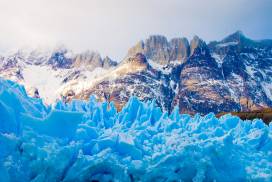
Discover Patagonia
- Best Patagonia tours
- Argentina hiking and trekking tours
- Nepal Trekking Companies
- Trekking Companies in India
- Climbing Mount Kilimanjaro
List of hiking and trekking companies in Patagonia
Discover more than 30 tour operators and trekking companies to find your next adventure quick and easy.

Unu Raymi Expeditions

Hi Travel Argentina

People Travel and Experience

OneSeed Expeditions
201 reviews

G Adventures
13,525 reviews

Signature Tours
401 reviews

Dittmar Adventures

DIAMIR Erlebnisreisen

Intrepid Travel
8,774 reviews

Receptivo Aborigen Tours
101 reviews
Patagonia trekking holidays

Patagonia: Torres Del Paine ‘W’ Trek – 5 Days
- Trek to the iconic Mirador Base Torres Explore the stunning French Valley Hike around Lake Nordenskjöld's scenic path Witness the majestic Gray Glacier Enjoy views from Paso de los Vientos
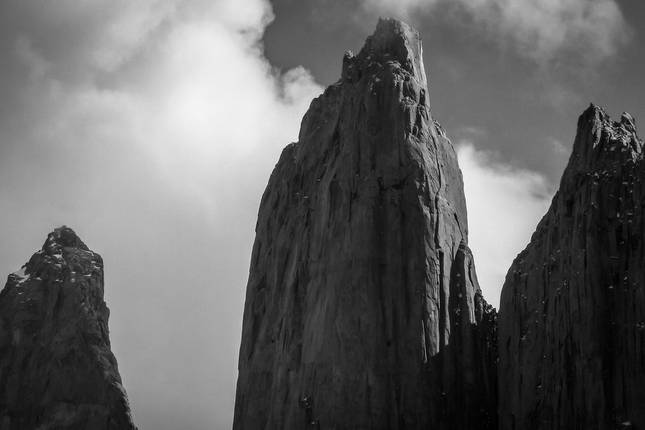
Patagonia: Torres Del Paine ‘O’ Trek – 8 Days
- Trek through Torres del Paine National Park Camp beside the serene Dickson Glacier Cross suspension bridges over Grey Glacier Witness ice falls in the Valle del Francés Climb to the iconic Mirador Base Torres
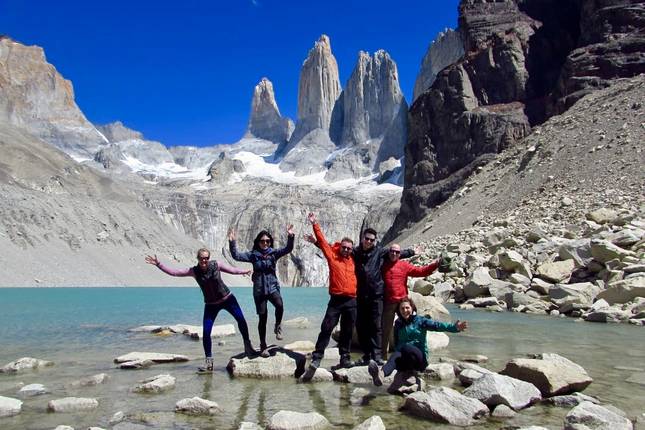
Epic Patagonia
- Trek in Patagonia's famous Torres del Paine National Park Climb through a beautiful lenga forest to the Las Torres Towers Marvel at the impressive and mesmerising Grey Glacier
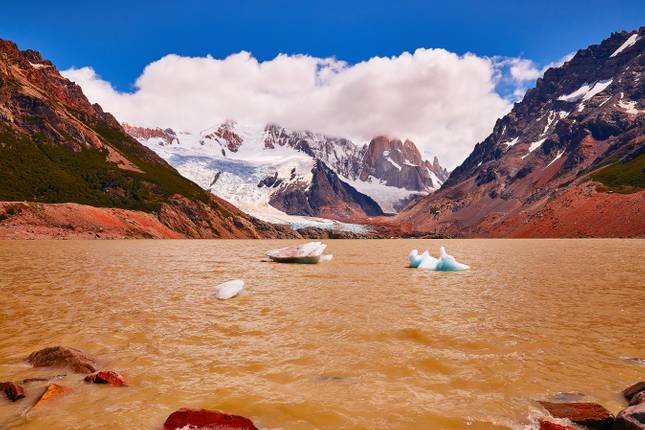
Patagonia Hiking
- Explore vibrant Buenos Aires on your own Fly to El Calafate, gateway to Patagonian peaks Kayak in Río de las Vueltas, view Fitz Roy Hike to Laguna de los Tres in Los Glaciares Tour the immense Perito Moreno Glacier

Torres del Paine - The W Trek
- Explore Puerto Natales before your trek Hike to Las Torres and see the turquoise lagoon Trek through breathtaking landscapes to Cuernos Visit the French Valley and Paine Grande mountain Conclude with a ferry ride across Lake Pehoé
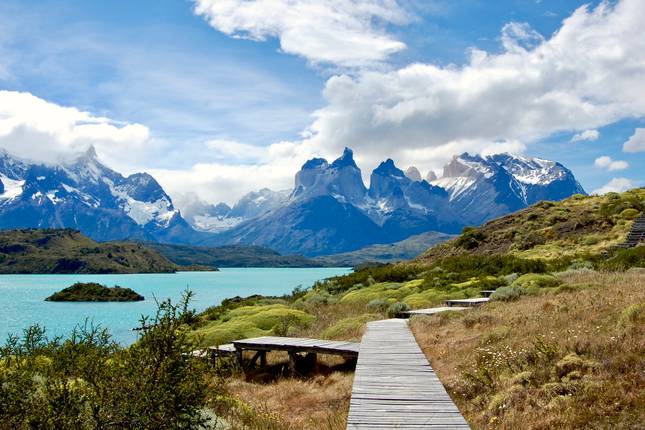
Essential Patagonia
- Trek in Patagonia's famous Torres del Paine National Park Climb through a beautiful lenga forest to the Las Torres Towers Gaze in awe at the massive and mesmerising Grey Glacier

Northern Highway (Carretera Austral) - Group Tour
- Relax in Puyuhuapi's soothing hot springs Trek through lush Queulat National Park Explore Pumalin Park's rainforest and fjords Cross Fiordo Largo by boat to Hornopirén Visit the stunning Petrohué Waterfalls

W-Trek in Torres del Paine Standard – Self Guided (5 Days / 4 Nights)
- Ride a bus through Cerro Castillo to Torres del Paine Trek to the Base Torres Lookout Explore the Macizo Paine and Los Cuernos Ascend to the Británico Lookout Hike to Grey Glacier and cruise Lake Pehoé
El Calafate tour companies
If you already know you want to trek in El Calafate, then it's time to consult our list of the best trekking companies.

Tangol Tours

Say Hueque Argentina & Chile Journeys
249 reviews

Bamba Travel
1,273 reviews

Class Adventure Travel

World Expeditions
260 reviews
Sign up for our newsletter
...and instantly receive access to exclusive deals and inspiring travel stories.
By submitting this form, I agree to the TourRadar T&Cs and Privacy policy .
Contact our Travel Experts

+1 844 311 8331
24/7 Support
Our team of experienced tour specialists have travelled to hundreds of countries around the globe and have decades of first-hand travel experience to share. Contact us now to have all of your tour-related questions answered!
More destinations for hiking & trekking
- Asia (2442)
- Nepal (2285)
- Africa (773)
- Europe (734)
- East Africa (729)
- Western Europe (657)
- Tanzania (654)
- South America (573)
- Latin America (502)
- Mediterranean (498)
- North America (295)
- Far East (270)
- Central Europe (235)
- South East Asia (218)
- Balkans (209)
- Indochina (203)
- West Africa (176)
- Vietnam (172)
- North Africa (167)
- Morocco (163)
- Italy (119)
- Spain (105)
- Austria (99)
- Bhutan (78)
- Australia (78)
- Middle East (74)
- Albania (57)
- Australia/Oceania (56)
- UK and Great Britain (55)
- Greece (54)
- 5 stans (51)
- Central Asia (51)
- Nordic / Scandinavia (51)
- Argentina (51)
- Austria and Germany (50)
- Portugal (47)
- Germany (45)
- Canada (43)
- Pakistan (38)
- France (37)
- Eastern Europe (35)
- Turkey (34)
- Ecuador (33)
- Uganda (30)
- Iceland (30)

Top Countries You Haven’t Been (Yet!)
Felipe Rosen Mosquera
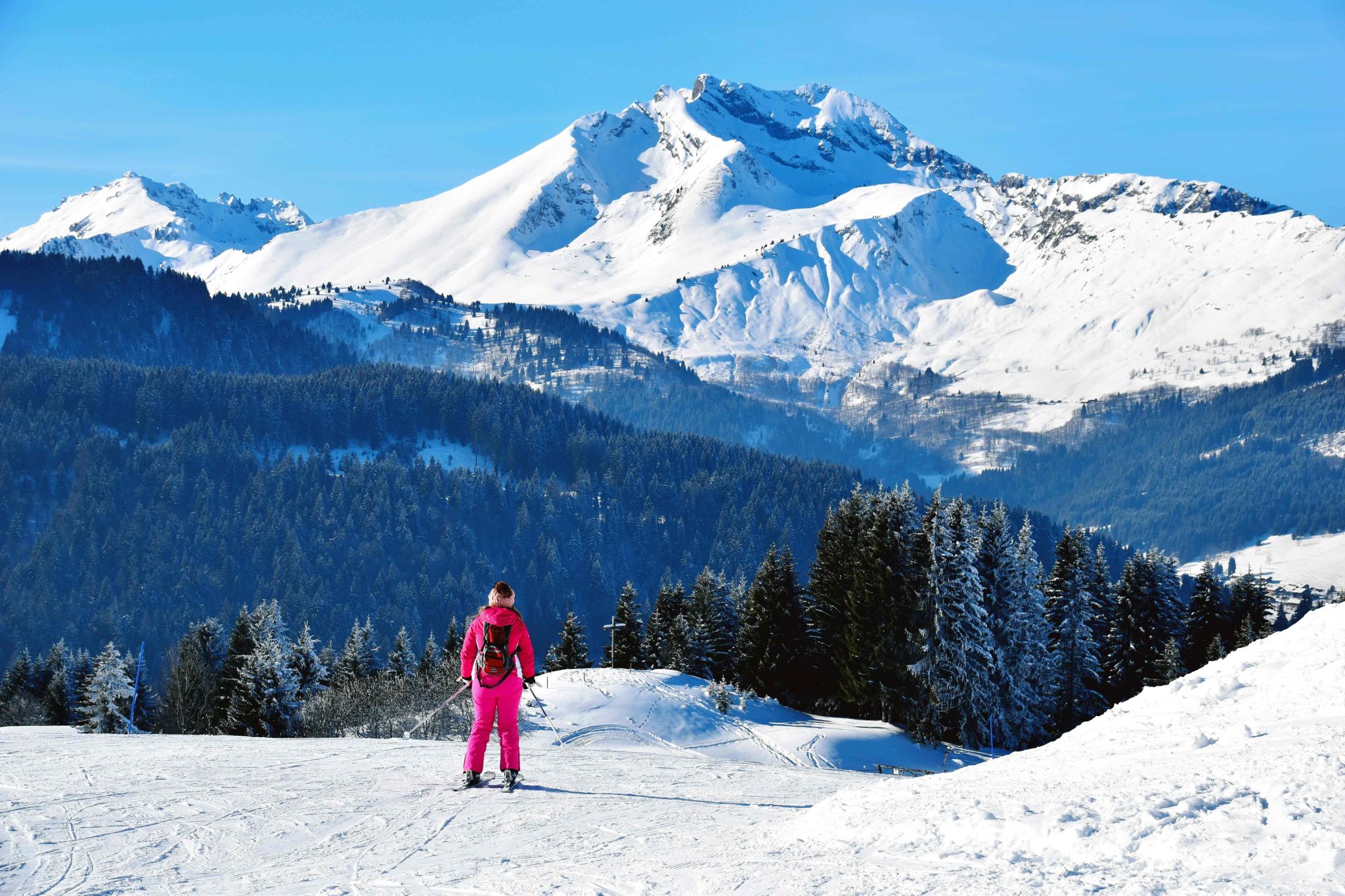
The Best Winter Activities in Europe
Mary Novakovich

Patagonia Travel Guide
Jehangir Irani

The Seven Hardest Hikes in the US, Ranked
Jesse Warner
Patagonia is a Photographer's Playground
Embark on a journey to the ends of the Earth, where the rugged beauty of Patagonia awaits.

In the southernmost reaches of the world, where the wind whispers secrets of ancient explorers, begins an epic journey through the wilderness of Patagonia. Our adventure starts in Punta Arenas, a gateway to the vast, rugged landscapes stretching beyond the horizon. There, we'll get a campervan that will be our home for this journey.
Leaving Punta Arenas up north, we traverse the Patagonian steppe, a seemingly endless expanse of golden grasses swaying under the vast sky. The road ahead unfurls like a ribbon, leading us to the first breathtaking marvel on our journey: Torres del Paine National Park.
Here, the jagged peaks of the Torres del Paine massif pierce the sky, their granite spires cloaked in swirling clouds.
Guanacos graze peacefully, unperturbed by the majesty around them, while Andean condors soar on thermals high overhead.

As we continue north, the landscape transforms into a mosaic of ancient forests, crystalline rivers, and snow-capped peaks. The journey is a symphony of sights and sounds; each notes a reminder of nature's raw, untamed power.
Crossing into Argentina, we reach El Calafate, the gateway to Patagonia's most iconic wonders: the Perito Moreno Glacier. This colossal ice river stretching over 250 square kilometers is a living, breathing entity. We stand in awe as massive chunks of ice calve from its face, crashing into the turquoise waters of Lake Argentino with a thunderous roar.

From El Calafate, we travel deeper into the heart of Patagonia, where the landscape becomes even more dramatic. The road passes through never-ending vast plains.

Our final destination is the legendary El Chaltén, a small village at the foot of the Fitz Roy massif. Known as the trekking capital of Argentina, El Chaltén is a heaven for adventurers seeking to conquer the region's rugged trails and towering peaks. The
imposing silhouette of Mount Fitz Roy dominates the skyline; its sheer granite faces glowing pink in the dawn light.

Here, you’ve got a ton of epic hiking options, with El Chaltén as your ultimate base camp. This chill spot is your gateway to some of Patagonia’s most jaw-dropping trails.
Laguna Torre
The Laguna Torre hike in El Chaltén is a stunning trek through Patagonia's rugged terrain. This 11-mile round trip trail takes you through dense forests, past roaring rivers, and offers breathtaking views of the iconic Cerro Torre. The hike culminates at the serene Laguna Torre, where you can witness icebergs floating on the glacial lake with the dramatic backdrop of towering peaks and glaciers. It's a must-do adventure for anyone looking to experience the raw beauty of Patagonia.
For this hike, we woke up at 1 AM to reach Laguna Torre by sunrise, capturing the stunning morning light on the iconic peaks. Alternatively, you can split the journey over two days by camping overnight at a site near Laguna Torre, allowing for a more relaxed pace and an unforgettable experience under the stars.

Laguna de Los Tres
The Laguna de los Tres hike is about 12 miles round trip and very tough but totally worth it.
You’ll hike through lush forests and rugged terrain, getting the best views of the Fitz Roy massif along the way. The final climb is steep and often covered in snow and ice, but the reward is epic.
We did this hike in two parts by camping overnight at the Poincenot campsite, which sits just before the final ascent. This way, you can tackle the steep, snowy climb to the laguna before sunrise, making the experience even more magical. This hike is a must for anyone wanting to soak in Patagonia's raw, wild beauty.

Laguna Capri
This scenic and relatively easy trek is perfect for all skill levels. Spanning about 4.5 miles round trip, the trail takes you through beautiful forests and offers stunning views of Mount Fitz Roy. The highlight is reaching Laguna Capri, a serene lake with crystal-clear waters, providing a perfect spot to relax and take in the majestic scenery. This hike is a great introduction to the breathtaking landscapes of Patagonia.
We hit the trail before dawn to catch the epic alpenglow lighting up Fitz Roy at sunrise.

Mirador Los Condores
This is another short but rewarding trek, spanning about 2 miles round trip. The trail climbs gently through the Patagonian steppe, leading to a breathtaking viewpoint. From the top, you'll get panoramic views of the town, the surrounding valleys, and the majestic peaks of the Fitz Roy range. Keep an eye out for condors soaring overhead, adding to the magic of this quick hike. It's a perfect way to soak the stunning scenery with minimal effort.

Road to el Chalten
The classic viewpoint on the road to see Fitz Roy is an absolute must-stop. As you drive towards El Chaltén, the jagged peaks of Fitz Roy dramatically rise against the skyline, creating an iconic and breathtaking view. This spot offers a perfect panorama of the towering mountain range, with the road leading straight towards the majestic Fitz Roy. It's an ideal place to snap some incredible photos.
This place is all about extremes, with nature’s raw beauty hitting you hard and leaving you stoked. Our trip from Punta Arenas to El Chaltén has shown us just how epic the natural world can be. It’s a solid reminder that, amidst all this grandeur, we’re just tiny specks in the Earth’s epic story.

What To Pack
Combine your clothing layers to adapt to Patagonia's ever-changing weather quickly. Start with a warm wool base layer, followed by an insulating mid-layer, and finish with a protective outer shell for maximum comfort and protection. Ensure your base layer is made of soft, warm wool to retain your body's heat.
It's crucial that both your pants and jacket are waterproof — keeping dry is essential in Patagonia's unpredictable climate! Waterproof boots with good ankle support are also necessary for any hikes you have planned. Wearing gloves and a hat is advisable, especially in colder months, so you can fully enjoy the stunning landscapes without being uncomfortable from the cold.

What Photography Gear to Bring?
This is very personal, and I tend to bring a lot of gear to split between me and my wife, who is my adventure partner. But I will tell you the basics for an adventure like this.
I'll be taking my two reliable Sony Alpha A7IV bodies. These mirrorless cameras offer incredible image quality and versatility, perfect for capturing everything from wide landscapes to detailed close-ups and shooting video in every condition. It's the ideal hybrid camera for me. I always bring a backup body with me, just in case!
Also, my wife always brings the Fujifilm X100V to capture more intimate and casual moments.
To cover a broad range of shooting scenarios, I'll pack a variety of lenses:
- Sony 16-35mm f2.8 GM Wide-Angle Lens: Essential for capturing sweeping vistas and dramatic landscapes.
- Sony 24-70mm f2.8 GM Standard Zoom Lens : This is the lens that is always in one of the bodies and the most versatile one.
- Sony 70-200mm f2.8 GMII Telephoto Lens: You will often face a huge distance between you and the mountains, this lens is perfect to take advantage of the compression.
Finding the ideal tripod can be challenging, as it often involves balancing weight with stability — the more stable it is, the heavier it tends to be. However, the Peak Design travel tripod strikes the perfect balance. It's compact enough to fit in your bag yet robust enough to provide the stability needed for your shots. Its design also makes it great for filming yourself, taking long exposures, and capturing time-lapses, ensuring you get clear, steady results in various shooting situations.
With all this gear, it's essential to have a backpack that can handle the weight and keep everything organized while also being comfortable enough for those long, demanding hikes. A well-designed backpack should accommodate your camera bodies, lenses, and accessories and distribute the load evenly to prevent fatigue. Look for features like padded shoulder straps, a supportive hip belt, and adjustable chest straps to ensure maximum comfort and stability. A durable, weather-resistant material will protect your gear from the elements so you can focus on capturing stunning shots without worrying about your equipment.
I would say at least you need a 35L backpack. These are some options:
- Strohl Mountain Light 45L Backpack
- DayChaser Travel Camera Pack - 35L
- FERNWEH 50L Backpacking Camera Backpack
- Weekender Duffel Bag - 50L
I always bring my Mavic 3 Pro drone along, as it provides a unique and expansive perspective that transforms how I capture landscapes. Its ability to soar above and capture sweeping aerial views adds a whole new dimension to my photography. Although I used it only a few times during this trip, its capabilities were invaluable. The drone’s zoom lenses allowed me to frame distant scenes with exceptional detail, making a significant difference in the quality and variety of shots I was able to capture. The flexibility to shoot from various altitudes and angles helped me to create a more comprehensive visual story of the landscape, showcasing the grandeur of Patagonia from a perspective that is often impossible to achieve with traditional camera equipment.
An absolute must-have for navigating the constantly shifting light conditions and capturing high-quality video is a reliable set of filters. In environments like Patagonia, where the lighting can change rapidly from bright sunlight to overcast skies, having filters such as ND (Neutral Density) filters is crucial. They allow you to manage exposure effectively, enabling you to achieve the desired shutter speed and depth of field, even in challenging lighting situations. These filters are indispensable for video shooting, maintaining smooth motion, and avoiding unwanted flicker or stutter. They help you achieve cinematic effects, such as motion blur, that enhance the visual appeal of your footage. Whether you're shooting dramatic landscapes or intricate details, these filters provide the flexibility needed to adapt to the dynamic lighting conditions of the region and ensure your video work remains sharp and professional.
Shop Alvaro's Picks

Variable ND Filters - 67mm / 2-5

Mavic 3 Drone - Mavic 3 w/ Fly More Combo

Strohl Mountain Light 45L Backpack - Black / Medium (17"-18.5" Torso Length)

FE 24-70mm f/2.8 GM Lens

DayChaser Travel Camera Pack - 35L - Blue

FE 70-200 mm F2.8 GM OSS Lens

Alpha a7 IV Full-Frame Mirrorless Camera - Body Only

FE 35mm F1.8 Lens

Travel Tripod - Aluminum

💌 There's More!
Enjoyed this read subscribe now and receive all the latest and greatest articles straight to your inbox. all original. community first. 100% ad-free..
SUBSCRIBE NOW

How To Document Life With Kids & Staying Present

Hotel Flash Photography with Celebrities

Five Lessons from Photographing the Markets of Jaipur

Shooting Vogue-Style Fashion Portraits with Long Weekend Bags
The Best Hiking Pants for Men of 2024
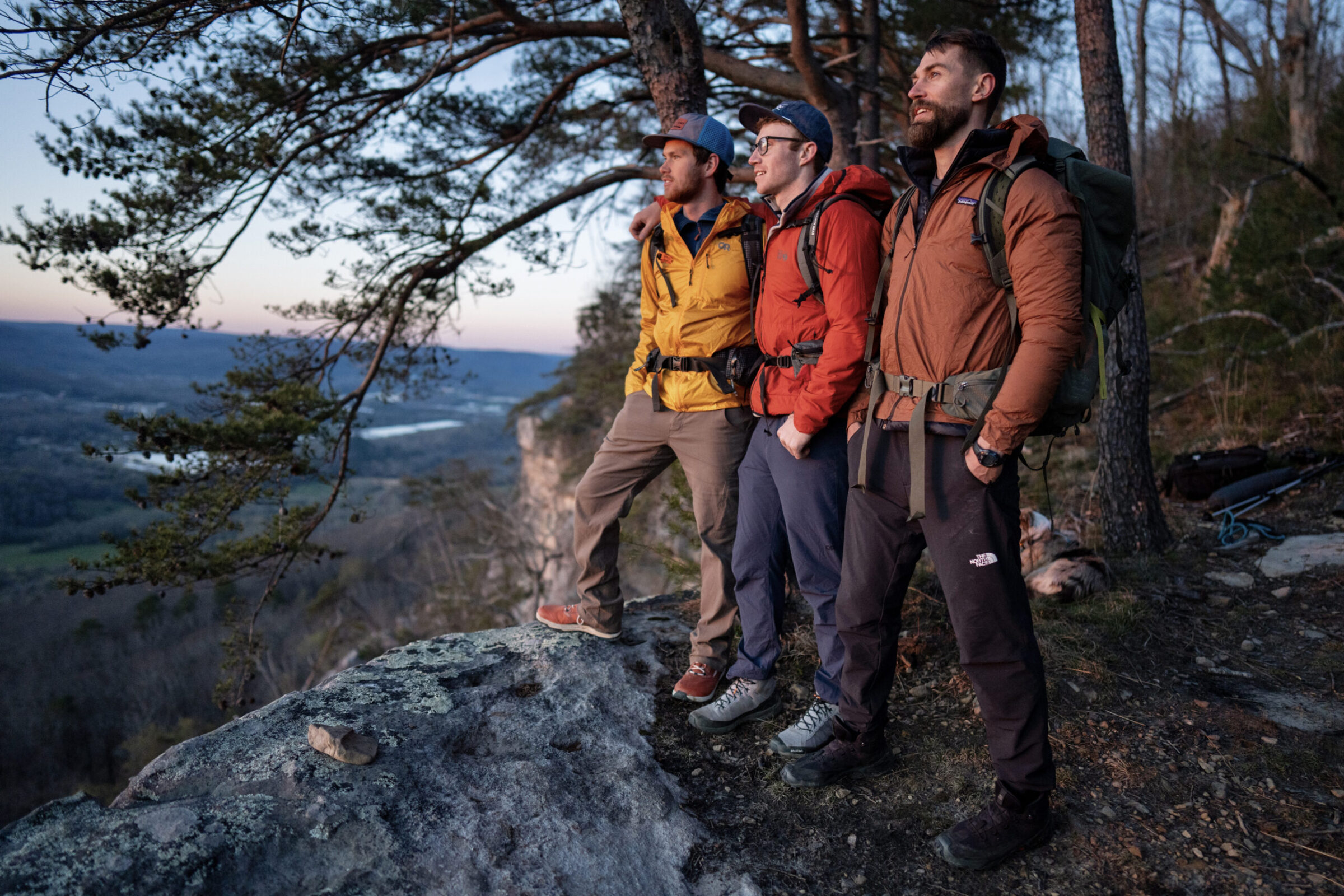
The legs are the body’s primary mode of transportation, and pants are their first line of defense. Finding the best hiking pants for your objective can keep your legs comfortable, warm (or cool), and abrasion-free, keeping your mind on the trail ahead.
We focused on comfort, durability, construction, performance, and price, relying on the experience of our field testers. These folks tested pants across the Andean cloud forests, deep desert canyons, high mountain peaks, on long-distance trails, and even in everyday use. These pants feature innovative materials, with fabrics that can shed water, block the sun, deflect sharp sticks and rocks, and still perform after years of wear and tear.
Our team collectively tested a plethora of these durable, lightweight pants for the creation of this guide, with current author Rob Simpson having put countless different models through demanding tests in the past year alone. Rob has post holed through waist-deep snow on high-altitude adventures, plodded in the blistering heat through the desert, and slogged along muddy paths in a legion of different hiking pants. He’s intimately familiar with what makes a worthy pair of trousers for any backcountry scenario and allows only the very best into this roundup.
While no single pair of pants works for everyone, we’ve tested a variety of models and broken them down into relevant categories. If you want help determining what you need in your hiking pants, jump to our buyer’s guide at the end of this article, or check out our comparison chart and FAQ .
Editor’s Note: We refreshed this article on August 26, 2024, by adding four new products, including three award winners: our new budget pick, the REI Trailmade Pants ; our most durable choice, the Fjallraven Vidda Pro Ventilated ; and our favorite convertible pants, the REI Sahara.
The Best Hiking Pants of 2024
- Best Overall Hiking Pants: Outdoor Research Men’s Ferrosi Pants
- Best Budget Hiking Pants: REI Trailmade Pants
- Most Durable Hiking Pants for Men: Fjallraven Vidda Pro Ventilated
- Best Men’s Hiking Pants for Scrambling: Black Diamond Alpine Light
- Most Stylish Hiking Pants for Men: KÜHL Radikl Pants
- Best Lightweight Hiking Pants for Men: Rab Incline Light Pants
- Best Convertible Hiking Pants for Men: REI Sahara Convertible Pants
Outdoor Research Men’s Ferrosi Pants
- Fabric 87% 90-denier stretch-woven ripstop nylon, 14% spandex
- Fit Straight, true to size
- Weight 10.7 oz.
- DWR Water resistant fabric
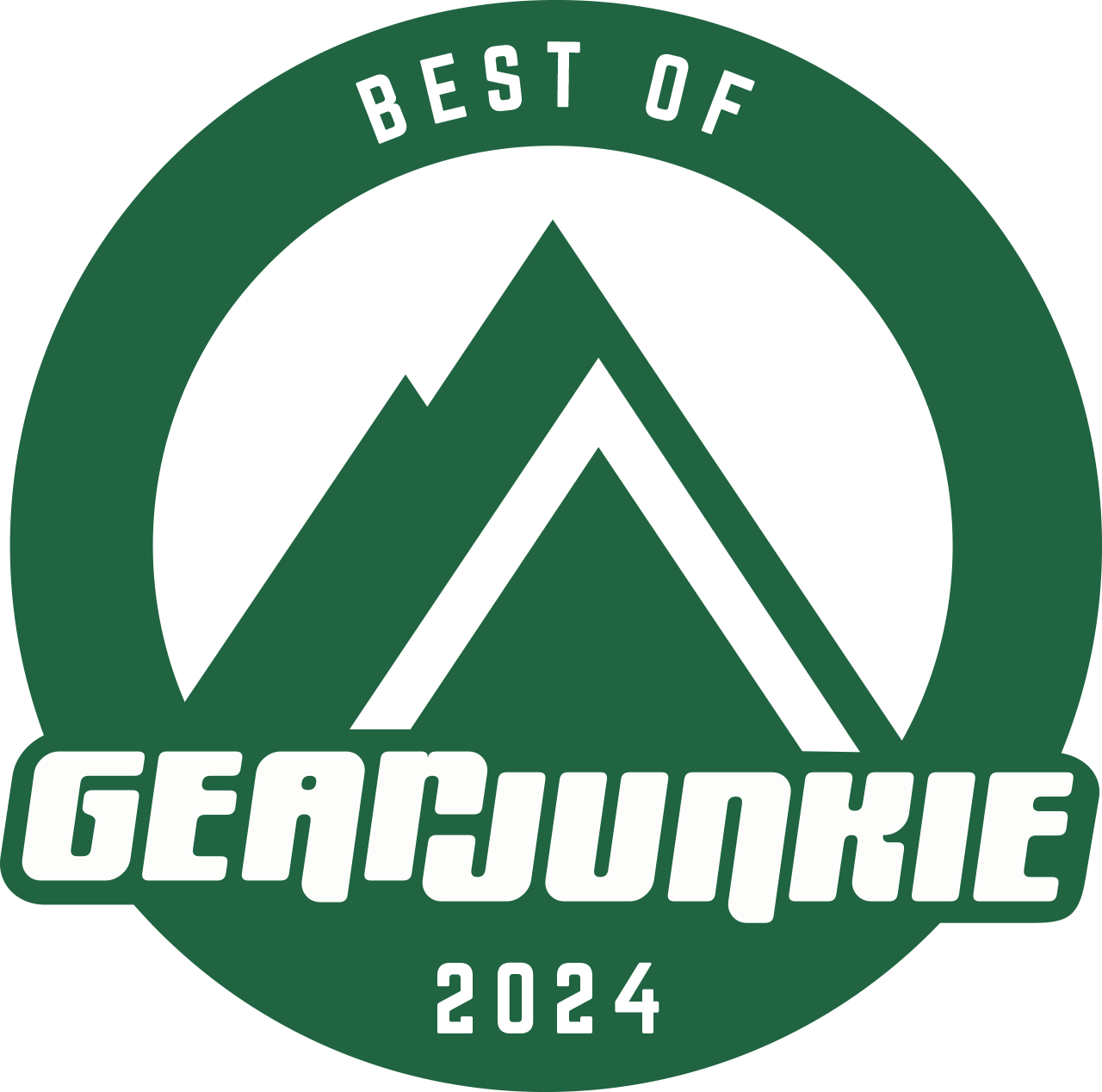
- Lightweight but durable
- Incredible, flexible fit
- Small back pockets
- Won't last as long as heavier pants
If you find yourself wearing the same pair of pants while hiking in the morning and running errands downtown in the evening, they’re probably winners. It’s rare to find clothes that hit the equilibrium of comfortable yet technical, lightweight but durable, and weather-resistant yet breathable, but the Ferrosi Pants ($99) nail it.
These barely register on you, but instill confidence through inclement weather and rough terrain. They clock in at a scant 10.7 ounces and cram down to the size of a softball, but have held up over many miles, and some significant off-trail bushwhacking.
When we say the Ferrosis are comfy, we mean we often choose these over sweatpants while curling up for a movie kind of comfy. Their movement-mirroring elasticity is truly a wonder, and they feel like extensions of your legs as you vault over downed trees or navigate boulder-strewn river beds. The articulated knees, brushed waistband, and drawcord cuff adjustments boost the pant’s versatility and comfort.
We wore these pants on a recent backpacking trip through the Grand Canyon and were greatly impressed by their ability to shed light precipitation while maintaining a high level of breathability as we slogged our way out of the great ditch. Often you’ll find that pants will excel at one or the other — but rarely both.
These are admittedly hard to criticize. If you’re looking for bomb-proof invincibility, you’d be better off with something on the tougher (but heavier) end of the spectrum. But at such a lightweight, the 90-denier stretch-woven nylon fabric holds its own on taxing adventures.
We found the back pockets to be a little on the small side, and we couldn’t close the zipper around something like an iPhone (only one is zippered). However, the front pockets and single-zippered hip pocket are plenty spacious and thoughtfully placed.
As some of the best-fitting pants we’ve had the pleasure of testing, the Outdoor Research Ferrosis secured a spot at the top of this list for their premium comfort, solid durability, and overall stellar design. If you’re looking for an ultralight, reliable option for extended backpacking excursions, don’t pass these by.
REI Trailmade Pants
- Fabric 94% nylon, 6% spandex (Bluesign approved)
- Fit True to size – slim fit
- Weight 9.8 oz.

- Great color options and accent pockets
- Fit/style – internal drawstring adjust
- Small front pockets
The REI Trailmade Pants ($69) were one of the best-fitting pants in this review. We really like the slender (not slim) fit and how the pants look and feel. They are extremely comfortable, and we were equally cozy hiking all day in them or lounging around the house in a pair of slippers.
One of the first things we noticed when these pants showed up in the mail was the sharp-looking accent pocket. The teal pocket zip on the darker blue pants gave the thigh a nice pop of color that looks great. The pocket is just the right size for a fat wallet, cellphone, or energy bar. We also appreciated the simplicity of the internal drawcord as an effective way to make micro-adjustments to the waist without having to add a belt.
We hiked high peaks in Colorado, along the beach in Mexico, through flower-filled fields in the Tetons, and along the coast in Alaska to discover that pants don’t have to cost a ton to function well, look good, and provide protection from the wind, light rain, mosquitoes, and sun.
Note that while these do have a DWR coating, if you live in a wet climate like the Pacific Northwest, where hiking in the rain is a regular part of most hikes, these might not be a great option. On a couple of hikes in Alaska and the Tetons where it was pouring, these pants soaked through pretty quickly, unlike a couple of others on the list that are more waterproof.
The Trailmades did, however, dry extremely quickly once the sun came out. So, if your main goal is to provide some sun protection along with an additional layer to protect your legs from the occasional bit of bushwhacking, then this is a solid choice.
If you hike in warmer climates and want a lightweight, simple, but well-designed pair of pants without many extra features to complicate the design, then take a look at the REI Trailmade Pants . Plus, with a price tag of only $69, you’ll be able to spend more time outside and less time working!
Fjallraven Vidda Pro Ventilated
- Fabric 65% polyester/35% cotton (organic)
- Fit True to size – great fit
- Weight 19.4 oz.
- DWR Water resistant G-1000

- Heavy duty durable pants
- Lots of features
- Fantastic look and fit
If you are looking for an incredibly durable pair of hiking pants that will last for a long time, then look no further than the Fjallraven Vidda Pro Ventilated Trousers ($180).
When these pants arrived in the mail, the first thing we noticed was the very heavy-duty look and feel. Along with the pants was a letter from Martin Axelhed, Fjallraven CEO. This line from the letter stood out: “They are designed to last for decades of use, to be passed on to the next generation or re-sold on the secondhand market. This way, fewer products need to be produced, less energy needs to be consumed, and few products will end up as waste.”
Although we haven’t had a chance to test these pants for decades, we suspect they’ll still be going strong many years from now with little signs of wear.
Based on the heavy-duty fabric we were initially a bit skeptical of the breathability. Every time we hiked in warmer conditions or days when the humidity was a bit up, we expected to overheat quickly but were pleasantly surprised. The side vent half-zippers and the ventilated and stretch crotch make a big difference. While we don’t think these should be your go-to hiking pants for desert backpacking trips, they do well in most other conditions and will shine in colder weather.
The Vidda Pro Ventilated pants are packed with a lot of extra features that are practical and improve the overall quality. For hikers that live in the mountains or on the East Coast or the Pacific Northwest when late spring and early summer hiking often involve snow and mud, the strap adjustment at the leg to tighten up the fit around the top of your hiking boots and the laces keeper hook are a nice feature — particularly if you don’t feel like wearing gaiters every time you go out for a short hike. The three oversized pockets and the smaller knife pocket are also a nice addition, and even when we had a cellphone, car keys, and snacks filling the pockets, the pants still fit well.
Finally, it’s worth noting that every single time we wore these pants, we received positive comments from passersby on the trail. Whether we were deep in the backcountry or walking to the local pizza restaurant after a hike, we regularly got comments like, “Wow, those are cool-looking pants. Who makes those?” or “Those look really durable. Do you like them?” Fjallraven makes a quality-looking pair of pants, and folks notice them.
If you are an ultralight purist and have spreadsheets of the weight of every piece of gear you take on a backpacking trip, then these probably aren’t the first pair of hiking pants you’ll choose. But if you want a beefy pair of pants that will last for many years and have a number of thoughtful features that improve rather than detract from the overall quality, then take a look at the Vidda Pros .
Black Diamond Alpine Light
- Fabric 85% nylon, 15% elastane
- Fit Slim, true to size
- Weight 11 oz.

- Secure, effective belt closure
- Solid stretch and durability
- Pockets aren't super deep
Black Diamond’s roots are in technical climbing gear. They’ve taken what they’ve learned on the mountain to make some of the finest outdoor apparel available. The Alpine Light ($125) speaks to its years of experience, and the overall merits are in its restrained design.
Instead of a belt, the pants fasten with a G-hook that sits off-center and catches on ladder webbing sewn into the waist. Both Arc’teryx and Seadon use a similar G-hook belt closure, but Black Diamond’s solution is the most secure implementation of the three.
The drawcord around the ankles locks into a slot, pinching the elastic cord. Unlike other pants with drawcords, you can’t pull it with one hand, but the concept is light and the most minimal setup we tested, significantly reducing bulk around the ankles.
For stretch and durability, the material is a combination of nylon and elastane, whose qualities start to shine once you veer off the map. Beyond the trail, you need pants that move with you, deflecting rock and scrub. That’s what terrain Black Diamond feels most comfortable in, and that’s where the Alpine Light delivers.
They have a four-way stretch woven fabric that is water-resistant, lightweight, and incredibly durable for its weight. After months of testing, it looks nearly new.
The pants have five pockets (two hand and two rear drop-in pockets, with a fifth pocket on the lower right leg). The front pockets aren’t very deep, and the thigh pocket sits low against the knee. This is designed to stay clear of a climbing harness.
If you like to carry lots of items in your pant pockets — particularly a phone in that thigh pocket — this could be a dealbreaker. If the thigh pocket was better positioned, we would have awarded the Alpine Light our choice for the best hiking pant overall.
The Alpine Light is available in general sizes (S, M, L, and XL), with inseams scaling from 31.5 to 33.5 inches. The waist sizing trends small, so if you’re between sizes, we recommend sizing up.
KÜHL Radikl Pants
- Fabric 68% cotton, 29% nylon, 3% spandex
- Fit Relaxed
- Weight 14.4 oz.

- Modern, stylish look for around town
- Durable, abrasion-resistant fabric
- Discrete ventilated stretch knit side and waist panels
- Seven low-profile, thoughtfully placed pockets
- Tougher fabric doesn't have best next-to-skin feel
We’ve been lucky to have the privilege of testing a wide array of hiking pants from KÜHL, and when we say it was hard to settle on a top pick — we mean it. Each pair we took for a spin impressed us on multiple fronts, but we narrowed in on the sleek and functional Radikl ($109) as our model of choice for this hiking guide.
With a classic, stylish look for trotting around town and enough grit for serious trekking endeavors, these are some of our favorite crossover, do-it-all pants that keep worming their way into our packs, duffels, and carry-ons for all manner of adventures.
Wear ’em to work, or bomb down a scree slope in the backcountry — the Radikl has a classy vibe, but is packed with discrete, outdoor-ready features that make them power players when the mountains call. Slim stretch knit fabric panels below the knee, waist, back yoke, and gusset not only boost flexibility while bounding about but also afford adequate ventilation when you pick up the pace.
You’d never know these vents existed until pulling the Radikl on, though, as they are the same color, and appear to have the same texture, as the rest of the pant’s Enduro performance fabric.
This tough, abrasion-resistant material mixes up a well-balanced batch of cotton, nylon, and spandex for a supremely durable — albeit noticeably weighty — force to be reckoned with. These quickly became our go-to pants for bush-bashing or boulder-hopping.
Such thick, stalwart fabric comes at a cost, though, and these don’t boast the best next-to-skin comfort compared to other pants on this list. They are also some of the heavier pants we tested, and we don’t bring these on fast and light missions where weight is of chief importance.
For front and backcountry style, though, these pants are hard to beat. Subtle side pockets for phones or an EDC knife ride along the thighs, and a muted brass “KÜHL” logo decorates the top of a thin coin pocket. These pants look pretty darn slick paired with a nice shirt tucked into a belt. Their “Free Ryde” waist follows the natural rise of your hips, which seems to move surprisingly well with you as you vault over blowdowns or navigate rock-strewn riverbeds.
The Radikls have a somewhat athletic fit through the thigh but do flair out a bit more than we like in the lower leg. This is fine when wearing these on casual outings, but they tend to flap back and forth a tad while hiking, and we would prefer a slimmer cut (note: we tested the “Klassik Fit”. You can opt for a “Tapered Fit” option if ordering off of KÜHL’s site).
In short, these are some of our favorite pants in our closet, and we find ourselves wearing them for much more than just hiking. While they aren’t as light or performance-oriented as some on this list, they bring a rugged, stylish aesthetic to your outdoor wardrobe that only KÜHL can do.
Rab Incline Light Pants
- Fabric 93% polyamide, 7% elastane
- Weight 7.9 oz.

- Great next-to-skin comfort
- Solid mobility
- A bit too tight in some areas
- Light fabric is not as inherently durable as others
Cramming down to roughly the size of a softball, the slim-fitting, mega-stretchy Rab Incline Light Pants ($95) should snag some real estate in any pack you load up for an adventure. At 7.9 ounces and under $100, why wouldn’t you bring ’em along? But their allure doesn’t stop at weight and price. Boasting stellar mobility, phenomenal next-to-skin comfort, and a thoughtful design, these pants are ready for any number of wild escapades.
The long-length gusseted crotch affords more freedom of movement than most pants we tested, and has a unique design, extending down to just above the knee. Articulated knees contribute to these pants’ mobility, and we had little issue tackling technical terrain on long hikes or light bushwhacks. We love a slim fit in our hiking pants, but these are just a tad too slim in a few areas for our preference — namely around the thighs and hips. For folks with larger legs, we’d recommend sizing up.
We love how packable the Incline Lights are. They roll up to a minuscule size and have consequently become some of our favorite “just in case” pants to throw in on any trip we find ourselves on. This isn’t to say they don’t rise to the task as standalone hiking pants in the backcountry, however, their ultralight nature does dock some durability points. They won’t hold up to the same level of torture as beefier softshell models like the Helly Hansen Blaze listed below.
Two zippered side pockets, one zippered back pocket, and a single zippered thigh pocket round out its simple feature set — which is just about perfect for us. We appreciate having zippers on each pocket, as it means any trinket we tote around will stay secure while we bound about. We do wish that there were drawcord cuff adjustments, but Rab had to cut weight somehow.
As some of the lightest pants on this roundup, the Incline Lights will hold up to miles of wear and tear without weighing you down. They’ll disappear in your luggage as backup pants for longer trips, or serve you well as standalone workhorses on ultralight backpacking missions. Trust us — you won’t be disappointed.
REI Sahara Convertible Pants
- Fabric 96% recycled nylon, 4% spandex (Bluesign approved)
- Fit True to size – a little baggy
- Weight 13.6 oz.
- DWR Yes – water resistant

- Versatility
- Great fitting shorts with 2 large cargo pockets including
- Ease of zip on/off of the legs
- Look and fit of the pants at the thighs
We love the utility of a good pair of convertible pants, particularly when hiking in places where the weather might go from sunny and 70s to windy and 40s in a short period of time. On one of our first outings in the REI Sahara Convertible Pants ($79) pants, we headed out for a long hiking/backcountry fishing trip at a high alpine lake in the Colorado Rockies located at almost 13,000 feet.
Over the course of the day, from the hike in the morning to the hike out late in the afternoon, the temperature changed significantly, and we found ourselves changing from pants to shorts and back to pants a number of times. The convenience of this option while providing a bit of extra sun and wind protection was much appreciated.
Unfortunately, after 20 (?) years, it seems that the curse of convertible pants — dorky fit and style — still hasn’t been sorted out. Although we love the versatility of zip-off pants, they always seem to fit awkwardly in the thighs where the pant legs zip on/off. The shorts portion of the REI Sahara Convertible Pants looks great, but once the pant legs are added to the mix, the fit just looks a bit odd. We hope one of these days REI or someone else will figure out how to make a pair of convertible pants that look great as both shorts and pants.
Setting aside our ego and how we look, we did appreciate the ease of attaching and detaching the pant legs, particularly when doing it in inclement weather or when it’s windy. In the past, this often involved a lot of awkward hopping around on one leg and a good bit of frustration. REI simplified this with color-coded thigh zippers to differentiate the right leg from the left, and they also added full side zips on the legs to make them just a little easier to get on and off.
If you have limited space and want a single pair of hiking pants or shorts for a backpacking trip or overseas travel, we highly recommend the REI Sahara Convertibles .
Patagonia Quandary Pants
- Fabric 94% nylon (65% recycled), 6% spandex
- Fit Standard
- Weight 10 oz.

- Flexible fabric
- Lightweight
- Few pockets
- Thin build doesn't provide as much protection as others
These popular, affordable workhorses have been staples in the hiking and travel community for a while, and aren’t diminishing in popularity. During testing, we found the Patagonia Quandary Pants ($89) to be solid crossover pieces for backcountry performance and front country style alike. Don’t let the low price tag and relatively thin fabric fool you — these pants can throw down, and hold up well to some serious torture on long hikes.
This model boasts some of our favorite features for hiking pants, with articulated knees, a gusseted crotch, breathable fabric, and a DWR coating with a 40+ UPF rating. For hot, big-mile days in the sun, these pants are ready for the task. We appreciate the flexibility they offer, but did feel like the fit was a bit tight around the waist and thighs. If you’ve been focusing on leg day in the gym, see if you can try these on first before whipping out your wallet.
Though there aren’t a lot of venting features on the Quandary Pants , the light, thin fabric felt more breathable than a lot of pants we tried, and there is a moisture-absorbing mesh liner at the waistband which helps keep sweat buildup at bay. A zippered pocket on the back and a small zippered thigh pocket help you safely stash essentials, which is adequate storage for what we used the pants for.
For hiking comfort in the mountains, or casual style around town, the Quandary Pants are a great versatile option for a variety of travel needs.
KÜHL Renegade Recon Pants
- Fabric 95% nylon, 5% spandex
- Fit Length is short – see comment on website about sizing/inseam length
- Weight 12 oz.

- Great look and feel
- Elastic waist eliminates sag or need for a belt
- Not very “water resistant”
- Hit at ankle/are short unless you order a longer inseam
Need pants that seamlessly transport you from work to the trailhead for a quick evening hike? Then look no further. The KÜHL Renegade Recon Pants ($99) are a great choice. They look amazing, fit well, hold their shape, and don’t sag, thanks to the elastic waist. Plus, we love not having to wear a belt, especially when our adventures call for a heavy backpack or a harness.
Although the pants Renegade Recon Pants claim to have water repellency and be quick-drying, we were a bit disappointed the first time we put this to the test. We were on a short hike in the Colorado Rockies on a day when the weather looked ominous.
About a mile from the trailhead, it started lightly sprinkling and then became a steady light rain. Within 10 minutes, the pants were totally soaked through, and our legs were cold and wet. Even after a 20-minute drive with the car heater on full, our legs were still damp when we arrived home.
When choosing your inseam size, make sure to take note of the intended fit according to the Kuhl website and sizing guide. Under tapered fit, they mention that the “style is meant to hit at the ankle; the actual inseam will measure 1.5″ shorter than the inseam selected.” If you don’t want a pair of hiking pants that feel like you are rocking a high-water look, then consider ordering a longer inseam.
Once we dialed in the fit, we enjoyed wearing these for sunny day hikes in Colorado. If you’re looking for a sharp-looking pair of hiking pants that you can wear to a staff meeting with a polo or button-up and then go straight to the trailhead for an afternoon or evening hike, then take a look at the KÜHL Renegade Recon Pants ($99).
Beyond Clothing Ascent Glide Pant
- Fabric 85% recycled nylon, 15% spandex
- Fit True to size
- Weight 10.6 oz.

- Lightweight and packable
- Sustainable construction and unique biodegradable, plantable tag
- Cozy, four-way stretch
- Integrated gaiter strap
- Low-bulk waistband
- Loud fabric
- No zippered pocket, and only one back pocket
Beyond Clothing’s Ascent Glide Pants ($135) made an impact on us the moment we slid them from their package — and not in a way we could have anticipated. We’ve always heard of, and respected, Beyond’s bent for eco-friendly and biodegradable textiles … but when we saw that the tag of our pants was filled with flower seeds — our stoke for this company skyrocketed.
Partnering with The Best Bee Company, Beyond strives to support pollinator health and biodiversity through a number of unique initiatives, including labeling some of its products with a biodegradable tag stippled with flower seeds. Simply pop it off, plunk it in the ground, and water it. The bees in your yard will thank you. This is one of the more creative sustainability pushes we’ve seen in the outdoor industry, and highlights Beyond’s ethos of making products that last forever, with minimal environmental impact.
These pants’ allure doesn’t stop at the tag, though. The recycled, sustainably-sourced fabric is featherlight, but punches well above its weight in the durability department. We’ve been testing these pants for the better part of six months, and they’ve seen it all. Endless miles of dusty singletrack, hours of burly bushwhacking, and even long days at the crag — the Ascent Glides experienced the whole spectrum of outdoor disciplines and passed with flying colors.
The slim silhouette of its waistband and low-profile webbing belt loops reduce chafing and pressure while wearing a backpack hip belt or climbing harness. While they are designed with hiking in mind, the four-way stretch and articulated back knees make these stellar climbing pants, and they consequently became one of our go-to’s for long romps to far-flung crags. It’s rare to find pants that bridge disciplines so well.
Adding to its singular flair, Beyond has developed an “Avert Integrated Gaiter” system. This easily transforms the base of the pants into makeshift gaiters via an elastic strap running through the cuffs. While we haven’t used this enough to test the durability of this strap, we’ve been grateful for this feature on a number of particularly muddy or dusty hikes we’ve been on recently.
Our qualms with these pants pale in comparison to what they bring to the table, but we have to note them. We immediately labeled these as some of the loudest pants in our hiking apparel arsenal, and the noise unfortunately hasn’t diminished much with use. It’s not overwhelming — and is perhaps due to its sustainable construction — but is noticeable. While there are two front pockets, there is also only one back pocket and we’d love another.
These cons aside, the Beyond Clothing Ascent Glide Pants have quickly become some of our favorite versatile pants for long backpacking trips, or climbing excursions with gnarly approaches. They flow seamlessly with your every move and barely register as you pile on the miles. Plus, you can start a fancy little garden with every pair you purchase!
Arc’teryx Gamma
- Fabric 88% nylon, 12% elastane

- Super durable
- Great four-way stretch
- Low breathability
We’ve been wearing an original version of this pant for nearly 20 years, taking it rock climbing, mountaineering, bushwhacking, spring crud skiing, and cross-country running. The pocket zipper has pulled off, and the DWR has worn away, but the pant material is still — by nearly every measure — as good as new. They’re virtually bombproof.
The Gamma ($180) — previously known as the Gamma LT — has only improved in the years since its inception. Arc’teryx has put a cord inside the pant hem, updated the belt, and sewn in a thigh map pocket. It has seen a recent upgrade in materials, but it still brings four-way stretch with snag-proof protection, and now has a more comfortable skin-facing side.
Unfortunately, the price is nearly twice that of the other pants on the list. Breathability is low, and the fabric is fairly noisy. But these are acceptable sacrifices for more vertical endeavors, particularly hiking and climbing in wet conditions.
prAna Stretch Zion Pants II
- Fabric 95% recycled nylon, 5% elastane
- Weight 12.3 oz.

- Comfortable fit
- Durable construction
- Good flexibility
- Plastic button a step down in durability
- Some complain about premature piling
With a deeply rooted cult following in the climbing world, the legendary Stretch Zion Pants II ($95) also just happen to excel on the trail. One of the authors of this guide has had a pair of Stretch Zions since his sophomore year of college, and couldn’t begin to count the hundreds of miles or pitches he’s clocked in them. Aside from a small hole in the knee, they serve him well to this day.
With such a loyal following, the recently updated Zion II had big shoes to fill — and has been met with mixed reviews. Some praise the new breathable ReZion fabric, while others bemoan its thin shiny appearance and propensity for piling. The plastic button shaved some weight from the original metal one, but many have noted that it has broken on them after minimal use. We haven’t had ours for long enough to confirm or deny this, but we do miss the metal.
The new fabric is more flexible, lighter, and has a nice, soft feel to it. Perhaps most importantly, though, it is made with bluesign-approved, recycled nylon. We don’t notice an appreciable decrease in durability but haven’t been able to test them quite long enough to tell.
The left thigh zipper pocket is a handy touch, with double entry points that allow you to access contents while hiking or sitting with ease. Ventilated inseam gussets boost breathability and comfort while hiking or climbing, and a snap roll-up feature at the hem increases versatility. We found the fit to be a bit less flattering than previous iterations, however, and the lower legs flair out significantly.
Love ‘em or hate ‘em, prAna’s Stretch Zions are back with an updated, more sustainable design. While we are still gauging the durability and functionality of the newest iteration, if previous Zions are any indication of these pants’ value, they deserve a spot on any hiking pants roundup.
Helly Hansen Blaze Softshell Pants
- Fabric 47% recycled polyamide, 41% polyamide, 12% elastane; lining: 100% polyester
- Fit Straight to slim
- Weight 15.8 oz.

- Durable design but solid mobility
- Velcro adjusted waist
- Reinforced insteps
- Adjustable bottom leg
- On the pricey side
Landing squarely on the opposite end of the weight and durability spectrum from Rab’s ultralight pants above, the brawny Blaze Softshell Pants ($160) are for serious technical objectives, where a perfect balance of all-day comfort and bomb-proof performance is paramount. While these serve as fine hiking pants in mild conditions — chilly temps, tempestuous weather, and brutal terrain are the Blaze Pants’ bailiwick.
Burly features abound on these hardworking trousers, with a thick four-way stretch, articulated cuts, plenty of adjustability, and reinforced panels over high-use areas. To pay for these luxuries, we’re unfortunately awarded with the highest scale reading on this list.
Despite their hefty weight, however, they pack down surprisingly small, and the degree of mobility they offer makes them feel much lighter than they are. These are consequently perfect picks for winter treks or light mountaineering objectives where lighter, more flimsy pants would tap out early.
Elasticated velcro adjustments at the hips and a zippered adjustment in the lower leg allow you to dial in the fit, or add insulating layers underneath. The lower leg zips tight for a snug, athletic fit if that’s your cup of tea (it is ours), or can splay open to accommodate beefy mountaineering boots or bulky layers if the need arises.
For such thick fabric, we were surprised at how well its four-way stretch and gusseted crotch moved with us, and we had little difficulty contorting our body while navigating dense blowdowns, or bounding from boulder to boulder. The abrasion-resistant fabric thwarts rips and tears better than most, giving us great confidence in thorny bushwhacks. Additionally, high-impact areas (like the pants’ instep) are reinforced with thicker materials.
Despite the high weight, the Blaze only has three pockets (two side and one zippered thigh). We wish there were back pockets. And, the zippered thigh pocket is positioned on the front of the thigh — which feels a bit uncomfortable when loaded up compared to pockets on the side of the thigh.
Our slight grumbles aside, we think these are some of the better softshell hybrid hiking/mountaineering pants on the market. Helly Hansen knows what they’re doing when it comes to technical adventure gear, and that thoughtful attention to detail is obvious in these trekking pants.
Patagonia Terravia Trail Pants
- Fabric 86% recycled polyester, 14% spandex stretch-dobby
- Weight 11.1 oz.

- Flexible, durable construction
- Solid zippered storage
- On the thick side
Reminiscent of our top pick, Outdoor Research’s Ferrosi Pants, the sleek Patagonia Terravia Trail Pants ($129) — previously known as the Altvia — are extremely comfortable, protective trekking pants for demanding missions in the mountains. Their polyester and spandex construction makes them some of the more cozy pants to trot around in, and despite their thicker fabric, they afford a shocking amount of flexibility.
Vaulting over blowdowns, or parkouring through boulder-strewn creek beds, they move with you seamlessly and protect you from thorns and underbrush. A straight-panel gusset and articulated legs enhance their mobility, and the flexibility extends to the waistband in these pants. They consequently have a somewhat jogger-like feel. The fabric is robust, which is a pro for protection from the elements, but a con in hot, muggy weather. It doesn’t have a lot of breathability or ventilation to speak of.
We took these pants on some serious bushwhacks while scoping out new climbing crags as well as off-trail side quests on backpacking trips, and while they held up well, we were surprised at the number of picks and loose strands that materialized after just a handful of excursions. We did put them through more torture than others given their reputation for above-average durability, so we can’t bash them too much on that front.
A grand total of five zippered pockets keep everything safe and sound while bounding about on trail, and we love the confidence these inspire. So many zippers do add some weight though, nudging these pants towards the heavier end of the spectrum.
The standard, straight fit of these pants hugged our legs comfortably without being constrictive, but we found the 31-inch inseam to be an odd choice. We prefer to have the options of 30 or 32 inches, as opposed to the 29 or 31-inch offerings of the Altvias. The 30-inch version fits our tester perfectly, and he found the 31-inch to be just a touch too long. We do appreciate the internal gussets and zippered fit of the cuff, though, which makes it simple to slide these over various sizes of bulky boots.
Those qualms aside, we feel these relatively new pants from Patagonia offer state-of-the-art comfort with a functional, adventure-ready design. While they aren’t our first choice for toasty summer treks, we love them for colder journeys or hikes over rough, bushy terrain.
Fjallraven Abisko Midsummer Zip Off Trousers
- Fabric 65% polyester, 35% cotton
- Fit Runs large
- DWR Reinforced G-1000 patches can be waxed

- Good mechanical stretch
- No DWR treatment
- Pockets are a bit oversized
Last year, we ranked the Abisko Midsummer Trouser as our best hiking pants overall. It ticked all the boxes: well-placed zippered pockets, ventilation, durability where you need it, and flexibility where you want it. The pants exemplify Scandinavian design with attention to detail through and through.
This past year, Fjallraven released a zip-off version ($175) of the Abisko Midsummer. As on the pant version, the butt and legs are reinforced with a Fjallraven’s G-1000 fabric. These pants are lightweight and durable, and as the name implies, are designed for hot summer days.
To preserve breathability, the pant isn’t treated with a DWR. Though Fjallraven sells a Greenland Wax you can apply it for added weather durability. On the backside of the legs, the pants are paired with a breathable, four-way mechanical stretch fabric, pairing mobility with the G-1000’s durability.
Two mesh hand pockets zip up your essentials, and a pair of well-positioned leg pockets ride up front on top of the thighs. Inside the front right pocket is a stretchy mesh sleeve just big enough for a phone.
The pockets are oversized and can swallow a lot of supplies. Overloaded, we found the contents will bounce on the legs, so pack wisely. Like all of Fjall’s trekking pants, they lack rear pockets. We prefer it this way. Loaded rear pockets can rub on a pack and be uncomfortable when sitting around camp. They are also one of the first parts of a pant to wear out.
The zip-off zippers add 2 ounces to the convertible pants over the straight trousers, but give you the added ventilation of shorts for those hot summer days. If you don’t want to show that much leg, simply pull the cuffs over your calves and cinch them with the drawcord.
The Midsummers come in European sizes, and we found they run large, so you’ll want to consult the size guide when buying. If you buy them at one of Fjallraven’s brick-and-mortar stores, the brand will hem them for free, giving you a fully tailored fit.
While these pants are more durable than Jack Wolfskins, the larger fit and pocket bulk work against the pants, so we put them lower on the list.
They’re not the cheapest hiking pants available, but the quality and aesthetics make the Abisko Midsummers a worthwhile investment.
Hiking Pants Comparison Chart

How We Tested Hiking Pants
It’s no exaggeration to say the GearJunkie squad has collectively clocked tens of thousands of miles on trails all over the world with these hiking pants. Not all hiking pants are created equal, and we know what makes a pair worthy of any real estate in our hiking loadout.
Lifelong gear testers Justin La Vigne and Steve Graepel led the charge with this guide back in July 2020, settling on our initial roundup of nine pants. Both are seasoned backpackers, hikers, and all-around outdoorsmen. They know the importance of a solid pair of pants for all-day comfort on trail. Justin has backpacked over 7,000 miles, including thru-hikes of the Appalachian Trail and Te Araroa in New Zealand. He also has a passion for mountaineering, having spent time in the North Cascades on Mt. Hood and Mt. Rainier, as well as Denali in Alaska.
He has a different pair of pants for all of his outdoor endeavors and for each season’s challenges. He’s pushed pants to their limits to hone in on their best utility.
Senior Editor Chris Carter took over this guide in August of 2022 and has been rifling through his closet, scouring the interwebs, and incessantly bugging the pros to narrow in on the streamlined selection of pants. Chris has thru-hiked the Triple Crown of long trails in the United States and continues to explore and backpack all over the world. He has put thousands of miles on a variety of different hiking pants through different climates and terrain and knows what to look for in trekking clothes that need to last for months of torture. In 2024, Rob Simpson took over this guide. As a college student in Southern California, Rob got his first outdoor job as a camp counselor and backpacking guide just outside Yosemite National Park. Off and on for the next 25+ years, Rob spent his time leading backpacking, rock climbing, and winter camping trips all over the Sierra Nevada range.
Now Rob lives in Salida, Colo., where he loves hiking countless 14ers and exploring all the Continental Divide and the Rockies have to offer. Together, we have tested each of the pants in this guide on real-world adventures and feel confident recommending any of them for long hikes or demanding backpacking trips.

Buyer’s Guide: How to Choose the Best Hiking Pants
Hiking pants are important investments for all-day comfort on trail and need to be chosen wisely before setting off on your adventure. The type of terrain you plan to encounter on your trip, the temperatures you will be hiking in, and the level of exposure to the sun all factor into which model would be the best for your needs.
Continue reading to help narrow down the selection and find the perfect pair. And, if you’re looking for women’s-specific models, check out our guide to the Best Hiking Pants for Women.
Pant Length & Versatility
Hiking pants come in three main options: full-length, convertible, and roll-up. Full-length pants are a great option for complete leg protection, even in the summer. To combat overheating, most pants have mesh pockets or vents.

Convertible pants like the REI Sahara Convertibles are the ultimate 2-in-1. The legs zip off and can be worn as shorts or pants. They’re a great option for variable weather and multiday hikes where you want more options and less gear to pack, but it’s tough to find a pair that doesn’t look goofy. It’s also nice to be able to pull the legs off without having to remove your hiking boots — a luxury, not all convertible pants offer.
Roll-up pants are somewhere between full-length and convertible. When rolled up, a tab, button, or drawcord secures the cuff.
The alpine-centric Arc’teryx Gamma is a heavier, more durable model that we’d hesitate to wear on the hottest summer days. However, it also has useful drawcords on the cuffs, so it’s easy to pull them up and get some airflow on the calves.
Drawcords around the ankles can keep the cuffs secured up around the legs. Pants without them will need to be rolled up.

Being able to move freely in hiking pants is a major concern. Whether running down the trail or scrambling up a rocky patch, you don’t want your pants restricting your movement.
This is where design features like a gusseted crotch, articulated knees, and stretchy materials prove useful. And because everybody is shaped differently, it can be helpful to try on a few pairs before buying to ensure a snug (but comfortable) fit. It’s also important to consider that you may need to find the right belt to help secure your pants comfortably around the waist.
Some pants run slim and restrict movement. Conversely, Black Diamond’s Alpine Light and the Beyond Clothing Ascent Glide Pant strike a perfect balance of lightweight durability and mobility.
It’s also important to consider how comfortable your pants will be when wearing a fully loaded backpacking backpack . Make sure they fit you well so you don’t have to wear a belt to keep them up, as that could rub uncomfortably against your pack as you hike.

Weather Protection
Just because you’re wearing pants doesn’t mean you’re safe from the sun’s damaging rays. If you are hiking on extremely sunny days, look for pants with rated UPF protection of 40 or 50.
A DWR coating doesn’t make pants completely waterproof, but it adds enough wet-weather protection to keep you dry while hiking through dewy brush or in light showers. DWR keeps water droplets on the exterior, allowing them to simply roll off.
DWRs will eventually wash out over time. For optimal performance, you’ll want to treat heavily used hiking pants on occasion. Nikwax Softshell Proof Wash-In is an easy way to keep your pants repelling water year after year.

And if you don’t want pants with DWR, the Fjallraven Abisko Midsummer is a great option. Fjallraven steers clear of DWR and instead sells an aftermarket wax that you can apply to beef up the water resistance.
These additions start to creep up the cost of pants. However, our budget choice, REI’s Trailmade Pants does have a DWR and UV protection and is an incredible value.
Additionally, weather protection can make pants a bit more heavy and less mobile — factors to consider when thinking about your hiking objectives. We personally don’t place DWR treatment high on our wish list when shopping for hiking pants, as we generally throw on a dedicated pair of rain pants if the heavens truly open up. Some hikers do like them for light rain and mist, however.
Additional Features for Hiking Pants

The little extras can really make or break a good pair of pants. Well-positioned cargo pockets, zippered pockets, belt loops, and built-in belts are some of the features available. Whether you want these or not depends on your personal hiking plans and style.
In general, you want your hiking pants to have a healthy features-to-weight balance like we found in the Fjallraven Vidda Pro Ventilated Trousers . Lightweight breathability is of utmost importance in most hiking scenarios, and many features are just plain gimmicky without adding much utility to your trip. If you enjoy carrying loads of extra trinkets in your pockets while you plod along, extra zippered and cargo pockets may be your cup of tea. If you plan on carrying most things in your backpack or hipbelt pockets, however, save some weight by snagging a slimmed-down pair of pants with only the necessities.
It’s also a good idea to test out your hiking pants with whatever backpack you plan on wearing for your trek, to make sure the waist feels comfortable under load, and won’t cause chafing over the long run. Integrated belt loops can be helpful in some instances, but we’ve found that they rarely feel cozy with a 30-pound pack pressing down on them.

It truly depends on where you are going (dry desert, humid forest, bushwhacking), how long you will be out (hours, days, weeks, months), what the weather will be like, and your personal preference. We laid out plenty of options above that cover these variables.
For long-term use, you should be looking for a pair of pants that have durability, can repel water or dry out quickly, and has features you want (pockets, belt, leg zip-offs). It’s better to consider these options initially, even if you end up dishing out more money. The best hiking pants are the ones that meet your unique needs.

Again, this is a personal preference. One of our authors hiked with a guy on the Appalachian Trail who only wore shorts for the 2,000+ miles, no matter the weather. In contrast, he mainly wore pants to protect against mosquitoes, sun, and abrasions. If it was really hot, he converted his zip-offs.
If you’re in the Sonoran desert where temps are scorching you may want the option to convert to shorts, so cut-offs may be your best option. If you’re blazing through thick brush in the Alaskan backcountry, you definitely need to protect your legs from getting cut up, so the Fjallraven Abisko Midsummer Zip Off Trousers do the trick.
Do tires for your car matter? Go ahead and hike in your work pants, jeans, or sweatpants, and then try a technical pair from the list above — that should answer your question. If you are just getting started, try a pair of less expensive pants like the Columbia Silver Ridge Cargo Pant , then work your way up as you determine what features you’d prefer.

Jeans are not the best option because they are made of cotton, and cotton does not wick away moisture. They’re also not breathable, have no stretch, and are quite heavy. In general, you’ll want to stay away from clothing made of cotton, linen, denim, or anything stiff.
It’s always best to wear and pack layers when hiking. You want to think of your body as an onion with the option to layer down. Loose clothing with breathability is ideal, ensuring that you’ll stay cool and wick away moisture. Having clothing that has UPF of 40-50 within the blend of materials can help with avoiding sunburn.
If you’re in buggy areas, having clothing with or treating your clothing with some type of bug repellent can help keep those pesky mosquitos, ticks, and sandflies away. Lastly, color is important. Keep your clothing, including your pants, on the lighter side, such as light beige, gray, or cream. Darker colors tend to absorb heat, while lighter colors reflect it.

The Best Backpacking Backpacks of 2024
Head into the backcountry with the best backpacking backpacks of 2024. From budget-friendly options to ultra-comfortable picks, we’ve got you covered.

The Best Hiking Shoes of 2024
We tested and ranked the best hiking shoes for men and women for 2024, including top picks from Salomon, Merrell, SCARPA, and more.

Based in beautiful Chattanooga, Tennessee, Chris Carter is a Senior Editor for GearJunkie, while squeezing in side gigs as an adventure filmmaker and content creator in the outdoor industry. Drawing from his childhood in Africa, experience as a rock climbing and backpacking guide, ultra-marathon running, and years of extensive thru-hiking, he’s passionate about journalism that gets people into the wild. He has thru-hiked the Triple Crown of long trails in America: the Pacific Crest Trail (2018), the Continental Divide Trail (2021), and the Appalachian Trail (2021), and has explored, rock-climbed, and backpacked all over the world. He hopes to spread his love of adventure and travel through his writing, art, and videography.

Rob Simpson is a product tester and review author for GearJunkie. He has guided rock climbing, backpacking, mountaineering, and sea kayaking trips across the western United States and Baja Mexico for 25+ years. Based in a small mountain town in rural Colorado, Rob is an avid fisherman, trail runner, backcountry skier, backpacker, and strategy game aficionado. When he’s not outside on the trails or rivers, Rob works as a college administrator and faculty member.

Steve Graepel is a Contributing Editor and Gear Tester at GearJunkie. He has been writing about trail running, camping, skiing, and general dirtbagging for 10+ years. When not testing gear with GearJunkie, he is a Senior Medical Illustrator on the Neurosurgery Team at Mayo Clinic. Based in Boise, Idaho, Graepel is an avid trail runner, camper, angler, cyclist, skier, and loves to introduce his children to the Idaho outdoors.
Follow Us On
Subscribe Now
Get adventure news and gear reviews in your inbox!
Join Our GearJunkie Newsletter
Gear Top Stories Deals
- Search Please fill out this field.
- Manage Your Subscription
- Give a Gift Subscription
- Newsletters
- Sweepstakes
If you click on links we provide, we may receive compensation.
- Travel Products
- Trends + Deals We Love
REI's Epic Labor Day Sale Is Here — and You Can Save Up to 70% Off on Patagonia, Hoka, and More
Adventure awaits, and so do these can't-miss deals.
:max_bytes(150000):strip_icc():format(webp)/Untitleddesign-2024-05-21T083157.649-05f4016bdf164230bc717ba6122e59ad.jpg)
- Overall Deals
- Travel Bag Deals
- Travel Accessory Deals
- Boot and Running Shoe Deals
- Women’s Apparel Deals
- Men’s Apparel Deals
- Hiking and Camping Gear Deals
- Cycle Gear Deals
Travel + Leisure / Tyler Roeland
If you’re dreaming of your next adventure, REI’s Labor Day sale is the perfect time to gear up. Now through Monday, September 2, the renowned outdoor and travel outfitter is offering incredible discounts on quality outdoor gear through the holiday weekend. Whether you’re in need of a cozy pullover for those crisp, fall mornings or looking to upgrade your camp kitchen ( knife sets and camp stoves and coffee presses , oh my!), this sale has you covered. Take our advice and snag these top-rated, supportive hiking boots that will carry you through miles of trails, or pick up a durable rolling duffel and other useful travel accessories to keep your essentials safely stowed and organized on your next getaway. And if you’ve been looking to update your set of wheels (of the bicycle variety, that is), there are plenty of deals on safety gear and accessories, too.
With items going for up to 70 percent off, you won’t want to miss these limited-time deals. Luckily for you, we’ve already combed the site to find you the top markdowns worth adding to your cart. So what are you waiting for? Your next escape starts here with the 50 best deals from the REI Labor Day sale.
Best REI Sale Overall Deals
Few things get us as excited as REI sales — and this year’s Labor Day weekend deals are no exception. We can’t wait to stock up on some camp essentials, especially when things like the Eureka Camp Stove are 40 percent off. Even prices for fan-favorite gear like REI’s Base Camp tent have been slashed. Fall-ready apparel price tags have also been reduced. Just take a look at The North Face pullover — a whopping 60 percent off — and an equally comfy Columbia fleece for 50 percent off.
- Nemo Double Haul 70L Convertible Duffel and Tote , $150 (originally $200)
- Thule Compression Packing Cube Set , $34 (originally $45)
- Eureka Ignite 2-burner Camp Stove , $75 (originally $125)
- The North Face Mountain Men's Sweatshirt Pullover , $60 (originally $150)
- Mountain Hardwear Men's Stretchdown Hoodie , $150 (originally $300)
- Columbia Women's Cropper Half-snap Fleece Pullover , $35 (originally $70)
- REI Co-op Base Camp 6 Tent , $385 (originally $549)
- Hoka Women's Trail Code GTX Hiking Boots , $92 (originally $185)
- Chaco Men's Z/Cloud Sandals , $52 (originally $105)
- Shimano Women's RC1 Road Cycling Shoes , $30 (originally $100)
Hoka Women's Trail Code GTX Hiking Boots
Best travel bag deals.
Whether you’re on the hunt for a rolling suitcase, duffel bag, travel backpack, or personal item bag , the REI Labor Day sale might just have what you’re looking for. We definitely have our eyes on the 70-liter convertible duffel from Nemo , which can go from duffel to backpack to tote in a snap. That’s basically three bags for the price of one! And who can pass up this sleek, water-resistant wheeled suitcase with built-in internal compression? It’s currently marked down to nearly 40 percent off, and REI members can get an additional 20 percent off with a special code at checkout. Plus, this roll-top backpack from Patagonia is just too good to miss — at $64, your new personal item bag is calling your name.
- The North Face Base Camp Voyager Roller Bag , $210 (originally $280)
- Sherpani Sojourn Tote Pack , $83 (originally $110)
- Mountain Hardwear Sabro 23 Pack , $54 (originally $90)
- REI Co-op Trailgate 45 Tote , $49 (originally $70)
- Osprey Sojourn Porter 30 Travel Pack , $132 (originally $175)
- Eagle Creek Tarmac XE 2-wheel 65L Wheeled Luggage , $192 (originally $319)
- Gregory Quadro Pro 22-inch Hardcase Wheeled Luggage , $187 (originally $250)
- Patagonia Fieldsmith Roll-top Pack , $64 (originally $129)
Nemo Double Haul 70L Convertible Duffel and Tote
Best travel accessory deals.
Here at Travel + Leisure , we love our travel accessories. Take this Thule Compression Packing Cube Set , for instance. These nifty things are one of our testing team's top packing cube picks and make packing for a long trip a breeze. You can get a set for yourself for just $34. Another must-have is the REI Co-op Shower Roll , a water-resistant toiletry kit that can hang at your campsite or on the hook behind your hotel room's bathroom door.
- Hydro Flask Coffee with Flex Sip Lid , $27 (originally $35)
- REI Co-op Shower Roll , $28 (originally $40)
- Humangear GoToob+ Large Squeeze Bottle 3-pack , $23 (originally $30)
- REI Co-op Laundry Pack , $21 (originally $30)
- The North Face Base Camp Voyager Toiletry Kit , $30 (originally $40)
Thule Compression Packing Cube Set
Best hiking boot and running shoe deals.
Fall weather means crisp morning hikes, leisurely trail runs, and the occasional walk in the rain. The hiking boots and active footwear deals during this annual REI sale are on fire, and we won’t be surprised if most things sell like hotcakes. The highly coveted (and newly marked down) Altra Lone Peaks , for instance, are sure to go fast, and the same goes for the half-off women’s La Sportiva Trail Runners . And, Merrell’s waterproof Moab Hiking Shoes are universally loved for their rugged, durable outsoles and shock-absorbing cushioning and support. Get a pair now for 25 percent off. Although summer is wrapping up, that doesn’t mean you can’t stock up on sandals for next year — especially when you can score a pair of Chacos for $52.
- La Sportiva Women's Jackal II GTX Trail-running Shoes , $97 (originally $195)
- Altra Women's Lone Peak 8 Trail-running Shoes , $105 (originally $140)
- Keen Women's Whisper Sandals , $87 (originally $120)
- Danner Women's Mountain 600 Leaf Gore-Tex Hiking Boots , $110 (originally $220)
- Altra Men's Timp 5 Hiker GTX Hiking Boots , $139 (originally $185)
- On Men's Cloudflyer 4 Road-running Shoes , $127 (originally $170)
- Danner Men's Trail 2650 Hiking Shoes , $127 (originally $170)
- Merrell Men's Moab 3 Waterproof Hiking Shoes , $105 (originally $140)
Merrell Men's Moab 3 Waterproof Hiking Shoes
Best women’s apparel deals.
Nothing says fall more than a cozy hoodie or fleece — well, except for maybe a pumpkin spice latte. This year’s REI Labor Day sale will have you ready for that delicious chill in the air with these toasty (and nearly sold out) pullovers from Columbia and The North Face at half off. And just imagine wearing this gorgeous green active dress (currently marked down to $37) with a sweater and scarf, or even on the trail, if you’re so inclined. Speaking of trails, the Sahara Shade Hoodie is the perfect layer for cool-weather hikes and offers UPF-50+ protection from sneaky autumn rays. Get it now and save 30 percent.
- REI Co-op Sahara Shade Hoodie , $35 (originally $50)
- Columbia Helvetia Cropped Half-snap Fleece Pullover , $35 (originally $70)
- REI Co-op Trailmade Dress , $37 (originally $75)
- Patagonia Baggies Shorts , $29 (originally $59)
- REI Co-op Flash Stretch Rain Pants , $72 (originally $119)
- The North Face Re-grind Quarter-zip Hoodie , $42 (originally $85)
Columbia Helvetia Cropped Half-snap Fleece Pullover
Best men’s apparel deals.
It can be unusual to encounter discounts on major retailers like Patagonia and The North Face, but REI’s Labor Day sale has delivered yet again. Save big (60 percent to be exact) on this classic pullover from The North Face , which is sure to keep you warm around the campfire or on the plane. And build out your fall travel wardrobe with the lightweight Patagonia henley long-sleeve shirt, now on sale for $52. If you’re ready to start prepping for winter’s chill, you won’t want to miss Mountain Hardware’s Down-filled Jacket . At half off, this cozy layer is a winter outfit staple.
- REI Co-op Trailmade Amphib Shorts , $35 (originally $50)
- The North Face Mountain Sweatshirt Pullover , $60 (originally $150)
- Patagonia Regenerative Organic Certified Cotton Lightweight Henley Shirt , $52 (originally $75)
- Prana Stretch Zion Slim Pants II , $67 (originally $95)
- Cotopaxi Teca Fleece Pullover , $70 (originally $100)
- Mountain Hardwear Stretchdown Hoodie , $150 (originally $300)
Prana Stretch Zion Slim Pants II
Best hiking and camping gear deals.
Whether you're a car camper or backpacker, these deals on new outdoor gear are worth a happy dance. No campsite is complete without a dry, protective tent. At 30 percent off, the six-person REI Base Camp tent is easy peasy to set up and can be stuffed down into a surprisingly slim stuff sack. And for the coziest night's sleep in your new tent, don’t forget a comfy compressible pillow (starting at $23) or a packs-into-nothing Rumpl travel blanket , which is currently 25 percent off. If day hikes are your jam, gear up with a CamelBak hydration pack and Leki trekking poles — both of which are 25 percent off.
- Therm-a-Rest Compressible Pillow , $23 (originally $47)
- GSI Outdoors Santoku Knife Set , $30 (originally $40)
- Rumpl NanoLoft Puffy Travel Blanket , $72 (originally $95)
- AeroPress Go Travel Coffee Press , $38 (originally $50)
- Leki Makalu Lite Cork Trekking Poles , $113 (originally $150)
- CamelBak Rim Runner X20 Hydration Pack , $79 (originally $105)
Rumpl NanoLoft Puffy Travel Blanket
Best cycle gear deals.
Outfitting your bike can be a slow and steady process. If you’ve been saving up to invest in a new set of wheels or want to add some accessories to your bicycle, you’ve got to check out REI’s sale offerings. From discounted safety items like a Smith helmet and NiteRider bike light set to a quick-mount rack for touring, there's bound to be something to add to your cycle arsenal. And, for a worthy splurge, consider the versatile Co-op Cycles ADV 3.1 Bike , which is currently on sale at a rare 40 percent off.
- Smith Session Mips Bike Helmet , $102 (originally $170)
- Co-op Cycles ADV 3.1 Bike , $1,019 (originally $1,699)
- Ortlieb Quick Rack , $83 (originally $110)
- NiteRider Swift 300 Front / Vmax+ 150 Rear Bike Light Set , $45 (originally $60)
Co-op Cycles ADV 3.1 Bike
Love a great deal? Sign up for our T+L Recommends newsletter and we’ll send you our favorite travel products each week.
Shop More T+L-Approved Picks
:max_bytes(150000):strip_icc():format(webp)/15-styles-to-wear-to-the-us-open-826-98-tout-f06e0dc7672843b2a806a512ea435026.jpg)
Related Articles
- All Wellness
- All Skin Care
- Moisturizers
- Mineral Sunscreens
- Sunscreens for Kids
- Sunscreens for Dark Skin
- SPF Lip Balms
- Under Eye Patches
- All Hair Care
- Purple Shampoos
- Thinning Hair
- Head Shavers
- Hair Dryers
- All Oral Care
- Electric Toothbrushes
- Toothpastes
- Mouthwashes
- Water Flossers
- Meal Kit Delivery
- Gluten-Free Meal Kit Delivery
- Disposable Face Masks
- Air Purifiers
- Eco-Friendly Laundry Detergents
- Natural Deodorants
- Period Underwear
- All Fitness
- Exercise Bikes
- Walking Shoes
- Fitness Trackers
- Reusable Water Bottles
- Blackout Curtains
- Sound Machines
- Home & Kitchen
- All Home & Kitchen
- Kitchen Appliances & Tools
- All Kitchen Appliances & Tools
- Coffee Makers
- Kitchen Gadgets
- Small Home Appliances
- All Small Home Appliances
- Air Conditioners
- Space Heaters
- Humidifiers
- Bedding & Bath
- All Bedding & Bath
- Bath Towels
- Silk Pillowcases
- Duvet Inserts
- Office Chairs
- Standing Desks
- Desk Organizers
- Seat Cushions
- Under Desk Ellipticals
- All Outdoor
- Raised Garden Boxes
- Garden Hoses
- Beach Towels
- Solar Pool Covers
- Grilling Accessories
- Electronics
- All Electronics
- Wifi Routers
- Gaming Consoles
- Streaming Devices
- Instant Cameras
- Handheld Gaming Consoles
- 3D Printers
- All Headphones
- Noise Canceling
- Wireless Earbuds
- Smart Gadgets
- All Smart Gadgets
- Smart Watches
- Smart Bulbs
- Garage Door Openers
- All Computers
- Gaming Laptops
- Laptops for College Students
- Computer Monitors
- Ergonomic Keyboards
- Dog Carriers
- Litter Boxes
- Scratching Posts
- Cat Carriers
- All Pet Care
- Nail Clippers
- Flea & Tick
- All Luggage
- Lightweight
- Weekender Bags
- Accessories
- All Accessories
- Luggage Tags
- Travel Pillows
- Tech Gadgets
- Packing & Organization
- All Packing & Organization
- Packing Cubes
- Toiletry Bags
- Gift Guides
- All Gift Guides
- Valentine's Day
- All Valentine's Day
- For Any Loved Ones
- Mother's Day
- All Mother's Day
- Last Minute Gifts
- Best Mother's Day Gifts
- For Moms Who Have Everything
- Best from Amazon
- All Graduation
- For College Grads
- For High School Grads
- For Teachers
- Father's Day
- All Father's Day
- Best Father's Day Gifts
- For Dads Who Love Fishing
- Holiday Season & Christmas
- All Holiday Season & Christmas
- Gifts Under $25
- Practical Gifts
- Other occasions & loved ones
- All Other occasions & loved ones
- For Grandparents
- For Bridal Shower
- For New Parents
- For Any Occasion
- Deals & Sales
- All Deals & Sales
- Most Popular This Month
- Sales This Week
- New & Notable
- What to Buy This Month
- CNBC Select
- All CNBC Select
- Credit Cards
- Small Business
- Personal Finance
- Credit Monitoring
- Help for Low Credit Scores
- Sign up for the Select Newsletter
- Check out Shop TODAY
- Privacy Policy
- Do Not Sell My Personal Information
- Terms Of Service
- NBC News Sitemap
Follow Select
The best REI Labor Day deals to shop right now

REI is hosting its Labor Day Sale and Clearance event until the end of today, making it a great time to save money on camping equipment, hiking essentials, running gear and more. Not only will there be deals across full-priced items, but there will also be additional sales, including up to 50% off clearance products. REI Co-op members will also have exclusive access to specific deals during the Labor Day sale .
I frequently cover sales like Black Friday , Cyber Monday and Prime Day for NBC Select, so I know how to identify Labor Day deals that are actually worth buying . Below, I gathered the best REI Labor Day deals to shop now. I’ll also update this list of deals throughout the sale.
SKIP AHEAD Best REI Labor Day deals | Best REI Labor Day tech deals | Best REI Labor Day footwear deals | Best REI Labor Day camping deals | Best REI Labor Day travel deals | Best REI Labor Day fitness equipment deals | More REI sales | Why trust NBC Select?
Selected. Our top picks
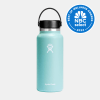
select Shop Traeger, GE and Ryobi products at their lowest prices during Home Depot’s Labor Day Sale
Best rei labor day deals in 2024.
Below, I rounded up the best sales to shop during REI’s Labor Day sale. The following products are either based on our previous coverage, NBC Select editor favorites or are highly rated at REI.
The best REI Labor Day tech deals
Garmin forerunner 265.
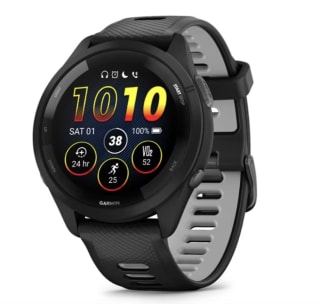
The Garmin Forerunner watches are some of our favorite fitness trackers . This lightweight model has a touch-screen display that shows data on your health, including sleep, recovery and training. It also offers personalized daily suggested workouts and has over 30 built-in activity profiles, including running, cycling and open-water swimming. The watch, which connects to Android and Apple products, has up to 13 days of battery life in smartwatch mode and up to 20 hours in GPS mode — this watch can even send a message with your live location to emergency contacts if needed.
JBL Flip 6 Speaker
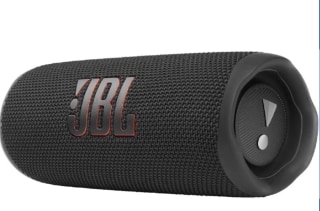
This Bluetooth speaker is waterproof and dustproof, making it a great portable speaker to take outdoors or enjoy from the comfort of your home. It has up to 12 hours of playtime on a single charge and can connect up to two smartphones or devices simultaneously.
BioLite Charge 40 PD Power Bank
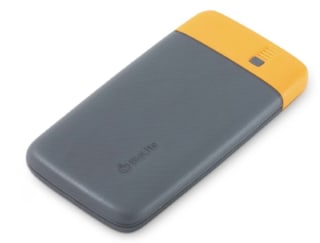
Don’t risk the possibility of your phone, tablet or other electronic devices dying; instead, carry this portable and durable power bank that can quickly charge multiple devices simultaneously. It can do so because it has three ports — two USB-A options and one USB-C port. BioLite has two additional sizes of this portable charger (20 and 80 PD), but this option can charge roughly 2.5 smartphones with a full battery.
The best REI Labor Day footwear deals
Hoka speedgoat 5 women's trail-running shoes .
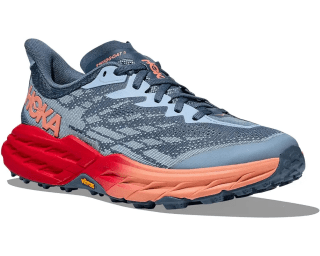
Hoka Speedgoat 5 Women's Trail-Running Shoes
These trail running shoes from Hoka find the right balance between being lightweight, comfortable and having enough security for outdoor runs. They have Hoka’s Vibram megagrip traction for a more secure grip, a meta-rocker for a smooth ride despite the trail’s terrain and a protective toe cap to keep your feet safe from rocks and other debris you may encounter during the run, according to the brand.
Nike Women’s Vomero 17 Road-Running Shoes
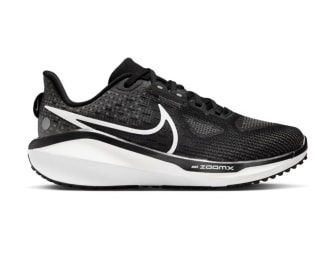
Reviewers say these women’s running shoes are great for tempo runs, recovery miles, training, daily runs and leisurely walks thanks to the plush interior which protects their joints, is responsive to movements and increases overall comfort. It has cushioned insoles and stacked foam that balances the foot, creates a softer stride and smooths heel-to-toe transitions. It also has padded tongues and collars to improve comfortability, according to the brand.
On Men's Cloudflyer 4 Road-Running Shoes
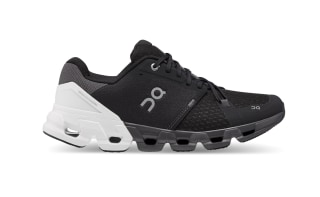
On Men's Cloudflyer 4 Road-Running Shoes
The Cloudflyer 4 men’s running shoes are versatile. ou can wear them during short and long runs, road running, training and more. The brand’s dual-density CloudTec midsoles provide support and cushioning, especially on the heel. At the same time, On’s Helion superfoam focuses on the forefoot area, so when combined, you have softer landings and more responsive, propelling takeoffs, according to the brand.
La Sportiva Men’s Wildcat Trail-Running Shoes
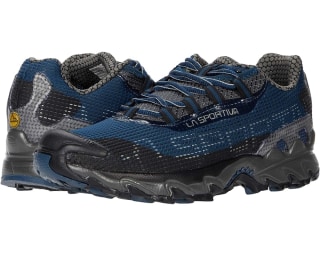
La Sportiva Wildcat Trail-Running Shoes - Men's
If you’re looking for a trail running shoe with stability and plenty of cushioning, consider this pair from La Sportiva. The shoe has a breathable and washable interior, dual-density midsoles, a moisture-wicking lining and, most importantly, a slanted lug pattern that will reduce impact and increase traction on all trails, according to the brand.
Altra Women’s Timp 5 Trail-Running Shoes
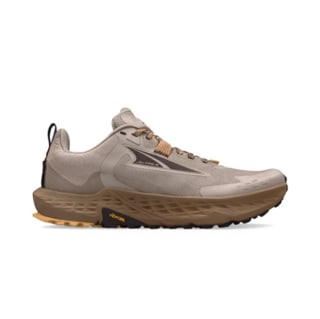
These trail running shoes have traction suitable for wet and dry surfaces thanks to their rugged rubber outsole. Its interior has a wide toe box , and the midsole is lightweight and gives a slight bounce, according to the brand. The sneakers are also available in men’s sizes , and the brand recommends sizing them up by half a size for more room or if you are between sizes.
The best REI Labor Day camping deals
Rumpl nanoloft puffy travel blanket.

This blanket is great for travel and camping because it’s easily portable and packable — all you have to do is roll it into its bag (no bigger than a water bottle) and clip it onto your backpack or other camping gear. The water-repellent blanket is comfortable and warm, and you can even wear it hands-free as you walk around or sleep, according to the brand behind our NBC Select Travel Awards Winner .
REI Co-op Siesta Hooded 20 Sleeping Bag
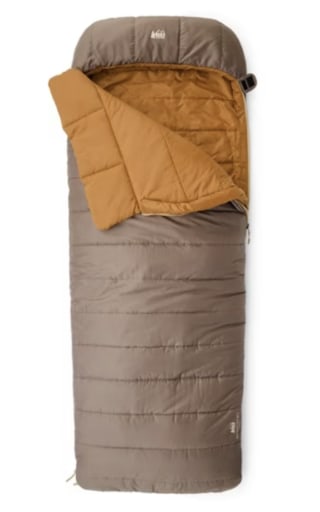
Available in two sizes, this hooded sleeping bag will keep you warm throughout the night with its quilt construction (which prevents cold spots and stabilizes insulation) and draft collar (which retains heat). According to REI, you can also use this water-repellent camping essential as a blanket when you’re not sleeping or simply roll it into its accompanying sack to save space on your campsite.
REI Co-op Skyward 6 Tent
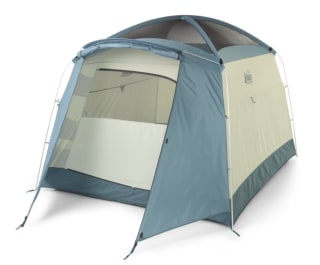
Skyward 6 Tent
This 6-person tent is excellent for multiple campers or if you’re simply looking to maximize space and comfort. The interior of the cabin-shaped tent allows individuals up to 6’3” to comfortably stand up straight and has multiple areas for convenient storage. The exterior is water-repellent and the tent has bugproof mesh panels and cap-style fly mesh covers for ventilation, according to REI.
The best REI Labor Day travel deals
Thule compression packing cube set.

Compression packing cubes are a travel essential because, like this duo from Thule, they maximize packing space by reducing excess air from the cube. The cubes open up to make packing easy, and when you’ve compressed them, they have a fabric that allows you to see what’s inside without being too obvious, according to the brand. Both the small and medium compression cubes can be used during multiple trips because they have a nylon exterior, which is durable and water-repellent.
REI Co-op Ruckpack 18 Recycled Daypack
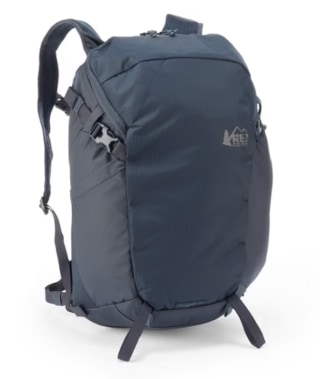
This 18-liter travel backpack makes trekking around a more comfortable and convenient experience. It has a water-repellent exterior, padded shoulder straps, easy-access side panels and attachments that can be removed or tucked away when not used. It also gives you peace of mind with features, including a sternum-strap buckle that doubles as a survival whistle and zippers that can be locked for safekeeping (if you purchase a lock separately.)
Nemo Double Haul 55 L Convertible Duffel and Tote
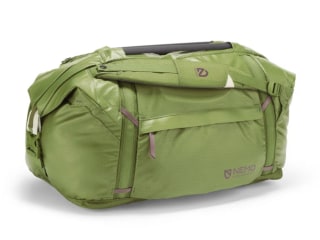
This water- and stain-resistant bag can become a duffel , tote or backpack, depending on how you choose to carry it. It has stiffened trusses to hold its structure regardless of how you use it, and it has a spacious interior with internal and external compartments for easy organization. It also comes with a carrying case that can double as a packing cube, according to the brand.
The best REI Labor Day fitness equipment deals
Hydro flask wide-mouth vacuum water bottle with flex straw cap.

Hydroflask Wide-Mouth Water Bottle with Straw Cap
After trying multiple alternatives, this reusable water bottle remains my favorite and continues to be the only one I use. After filling it with ice water, my drink stays cold and chilled for more than a day — sometimes even two. I can throw it in my work bag because this stainless steel bottle doesn’t leak or spill, and when I’m ready to use it, I can do so easily because of the straw cap. The NBC Select Wellness Award winner comes either with the standard lid or straw cap — you can easily interchange them based on your preference.
Manduka PROlite Yoga Mat
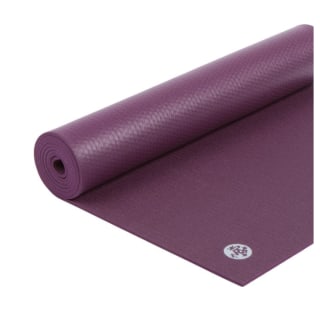
This yoga mat has high-density foam cushioning that doesn’t absorb moisture as you sweat throughout your practice. If you do, you don’t have to worry because it has a slip-resistant surface that doesn’t get sticky — it’s also slip-resistant on the bottom to prevent it from moving. If your mat has a problem, it is under a lifetime guarantee with Manduka.
REI Co-op Swiftland 5 Hydration Vest

For runners, hikers and everyone outside for long periods, stay hydrated as you participate in activities with this hydration vest. The machine washable vest (which was runner-tested by REI) has a 1.5-liter reservoir with a valve that self-seals and twists on and off to prevent leaks when you’re not drinking from it, according to the brand. It also has an adjustable snug fit to prevent it from moving around and has pockets for storage to carry essentials as you work out.
Thule T2 Pro XTR 2-Bike Hitch Rack
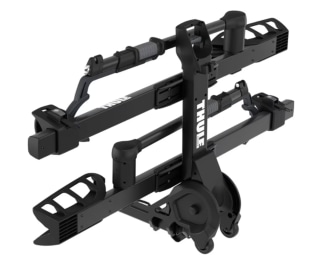
Carry up to four bikes with this rack that is compatible with most bikes up to 60 pounds each, according to the brand. Reviewers say they love how easy it is to attach to the back of their cars since it requires no tools and has integrated wheels to get the rack on and off. When you don’t need to use the bike rack, it can fold up and tilt away so you can access your trunk, according to Thule.
More sales from REI’s Labor Day Sale and Clearance Event 2024
All of the products listed below are at least 20% off and have a 4-star rating or higher at REI.
Best footwear and apparel sales
- Up to 30% off Patagonia Nano Puff Jacket
- Up to 30% off REI Co-op Sahara Shade Hoodie
- Up to 25% off On Cloudsurfer Road-running shoes
- Up to 25% off Saucony Tempus Road-running shoes
- Up to 25% off Salomon Speedcross 6 Trail-running shoes
- Up to 25% off Keen Zionic Waterproof Hiking Shoes
- Up to 25% off Targhee IV Mid Waterproof Hiking Boots
- Up to 25% off Darn Tough Hiker Micro Crew Cushion Socks
- Up to 25% off Rab Microlight Alpine Down Jacket
- Up to 25% off REI Co-op Rainier Rain Jacket
Best camping sales
- Up to 46% off Black Diamond Zip Lantern
- Up to 40% off The North Face Wawona 4 Tent
- Up to 40% off Helinox Chair Zero
- Up to 40% off Eureka Ignite 2-Burner Camp Stove
- Up to 30% off Caddis Rapid Shelter
- Up to 25% off Stanley 14-Piece Prep & Cook Set
- Up to 25% off Eno TechNest Hammock
- Up to 25% off Hest Foamy Sleeping Pad
- Up to 25% off Jetboil Flash Cooking System
- Up to 25% off Black Diamond Spot 400 Headlamp
- Up to 25% off Sol Flat Pack Collapsible Sink
Best travel sales
- Up to 29% off Gregory Quad Pro Hardcase Wheeled Luggage
- Up to 28% off Gregory Alpaca 60 Duffle
- Up to 25% off Osprey Sirrus 24 Pack
- Up to 25% off Sherpani Tote Pack
- Up to 25% off Osprey Sojourn Porter 46 Travel Pack
- Up to 25% off Humangear GoToob+ Large Squeeze Bottle Pack
- Up to 20% off Thule Force XL L Roof Box
Best fitness equipment
- Up to 49% off JBL Tune Flex Earbuds
- Up to 40% off REI Co-op Multi Towel Lite
- Up to 25% off Nathan Adjustable Fit Zipster 2.0 Running Belt
- Up to 20% off Yeti Rambler Vacuum Bottle with Chug Cap
- Up to 20% off Co-op DRT 1.1 Mountain Bike
- Up to 20% off Co-op Cycles Rev 16 Kids’ Bike

select Our editors parsed through 100s of Labor Day deals on Amazon — these are the best ones
How i found the best labor day sales at rei.
All of my recommendations above are based on NBC Select’s previous coverage and reporting. I also included products the NBC Select staff tested, including Wellness Award and Travel Award winners. All the products I recommend are at least 20% off, as well as highly rated items with at least a 4.0-star average rating from hundreds of reviews.
Why trust NBC Select?
I’m an associate reporter for NBC Select who covers beauty and wellness and special sale events like Amazon Prime Day, Target Circle Week and Black Friday. Many of the sales I cover include fitness equipment, wellness items, apparel and more.
Catch up on NBC Select’s in-depth coverage of personal finance , tech and tools , wellness and more, and follow us on Facebook , Instagram , Twitter and TikTok to stay up to date.
Bianca Alvarez is an associate reporter at NBC Select.

IMAGES
COMMENTS
Patagonia isn't all about multi-day treks, as sometimes the shorter it is the sweeter it tastes. Laguna Esmeralda is an easy 9 kilometre hike to the base of a glacier known as Glaciar Del Albino. If you prefer to spend extra time taking in the stunning views, a refugios ' campsite' is available near the lake towards the end of the hike ...
Best short hikes in Patagonia. Lago Nordenskjöld in Torres del Paine NP, Chile. Mirador Los Condores and Las Aguilas in Los Glaciares NP, Argentina. Cerro Campanario in Nahuel Huapi National Park. Mirador of Exploradores Glaciar in Laguna San Rafael NP, Chile. Best day hikes in Patagonia.
Trekking in Patagonia and Tierra Del Fuego (included in this list of hikes) is largely confined to the peak and shoulder seasons of November to late March. ... Best easy hike. 0.5 mile (700m) loop, 30 minutes, easy. Alerce trees are the giants of Patagonia. Growing up to 148ft (45m) in height and living for up to 3000 years, and used for making ...
Difficulty level: easy to moderate. The hike to Laguna Esmeralda is one of the easy hikes in Patagonia. It takes you to a beautiful emerald lagoon at the base of Glacier Albino. The starting point of the hike to Laguna Esmeralda is in Valle de Los Lobos, about 17 Km (10.5 miles) east of Ushuaia, along Ruta 3.
Other hikes in Torres del Paine National Park: There are dozens of trails in the park, so read my guide to the best Torres del Paine day hikes for inspiration. 10. Hike to Cabo Froward, Punta Arenas. The beginning of the Cabo Froward trail, a truly beyond-the-beaten-trail hiking route in Patagonia.
Difficulty level - moderate, easy in the beginning, steep ascend at the end + long distance ; Starting/finishing point - El Chalten; Accessibility - on foot; Admission fee - free; Trekking in El Chalten is one of the best experiences in Argentinian Patagonia and one of the most beautiful places in the region. The park has good ...
Patagonia's hiking trails offer varying levels of difficulty, from relatively easy day hikes to challenging multi-day treks. The difficulty of your hike depends on factors such as trail conditions, terrain, and weather. Here's a breakdown: Easy Hikes: Short, well-marked trails with minimal elevation gain, suitable for beginners and families.
Tronador. Looking up at the Cerro Tronador hanging glacier. Difficulty: Medium. Length: 36km, overnight. At the north end of Patagonia in Argentina, the Tronador hanging glacier trek is an excellent introduction to the region. If you're starting up there like I did, don't miss this hike. The trail starts after a 2-ish hour bus ride from the ...
Patagonia is an incredibly varied trekking destination. This is a true natural wonderland where condors soar and volcanos smoke. Patagonia hiking trails offer, in my opinion, some of the best treks in South America!. In 2022 I was lucky enough to spend a few months in Patagonia hiking and exploring.
11 Best Hikes in Patagonia. 1. W Trek. Duration: 4-5 days, 80km/50mi. Best Time to Go: Summer. Difficulty Level: Moderate. Country: Chile. The W Trek is one of the best hikes in Patagonia. The W Trek is one of the most popular hikes in all of South America, as well as the most famous trek in Torres del Paine National Park, so it's a no ...
Hiking the W Trek in Torres del Paine is expensive. Especially when compared to other places in Patagonia like Bariloche and El Chalten. But there's ways to make this experience cheaper like bringing our own food and camping gear. Overview (per person): Our Costs. Accommodation + Gear (3 nights): $345 USD.
5. Get a tent suited for Patagonian weather. A normal tent isn't going to be a good choice in Patagonia, where winds can reach upwards of 100km/hour. That is some serious wind and the shape of the tent, plus strength of the tent poles, both matter a lot so that nothing breaks while you're midway through a trek.
Ascent: 2956 ft of elevation gain. Time: 7 - 9 hours. The first day of this 4 day W trek itinerary in Patagonia will cover a lot of ground. You'll kick off the day bright and early departing from Puerto Natales. A 2-hour drive delivers you to the Laguna Amarga entrance gate of Torres del Paine National Park.
Length: Variable; shortest route is 16 miles (26 kilometers) Difficulty: Moderate to challenging. Access: El Chaltén serves as the starting point for Fitz Roy hikes. The town is easily reachable from El Calafate by bus. One of the most legendary views in Patagonia, Fitz Roy is a famous and popular trek for good reason.
4. The Laguna Torre Trek The Laguna Torre Trek . The wind-whipped village of El Chaltén is Argentina's premier trekking capital, with some of the most scenic hikes in South America. The most popular day hike from town, which can be extended into a multi-day hike for more adventurous travelers, is Laguna Torre also known as the Fitz Roy Trek.This 20-kilometer, in-and-out route takes you to ...
Start and finish: The W Trek traverses a roughly w-shaped route through Torres del Paine National Park between Refugio Las Torres in the east and Refugio Paine Grande in the west. For this itinerary, we start in the east and hike west. Distance: appx. 74 kilometres (46 miles) one-way.
Multi-day Treks vs. Day Hikes in Patagonia. Trekking in Patagonia requires athleticism, endurance and a spirit of adventure. ... However, Europe is easy to visit at any age, while Patagonia is a place that will test your endurance. Better go there while you are still young and energetic, lol! Reply. Michelle. April 14, 2018 at 1:00 pm.
The W Trek in Patagonia is a moderately difficult hike covering 46 miles (76km) and typically takes 4-5 days to complete. It includes mainly gentle terrain with some challenging climbs of up to 800m. Be sure to come prepared for varying weather conditions.
Come explore one of the world's most premier adventure travel destinations on your next unforgettable hiking vacation! Check out our list of Guided Patagonia hiking and trekking tour options below or give us a call at 1-800-715-HIKE (4453) to request more information or reserve a spot today! Explore.
O and W circuits - Torres Del Paine, Chile. 110km - 7 to 10 days. The most iconic trail in all of Patagonia. The Torres day hike as well as the W & O treks have a lot of hype surrounding them, but in our opinion they really do live up to it all. The walk is incredibly scenic and enjoyable and easily one of the best multi-day hikes in Patagonia.
Top 10 trekking companies in Patagonia with reviews. I ntrepid Travel, 4 tours with 46 reviews. OneSeed Expeditions, 2 tours with 3 reviews. G Adventures, 3 tours with 33 reviews. Exodus Travels, 2 tours with 47 reviews. Peregrine Adventures, 1 tour. PhotoFly Travel Club, 1 tour.
Accessibility - by car/bus from Coyhaique or Villa Cerro Castillo. Admission fee+camping in the park - CLP 30 000/US$3 5. Accommodation options - camping. The Cerro Castillo trek is one of our favorite long-distance treks in Patagonia. The route goes through the Cerro Castillo National Park.
Patagonia Hiking & Trekking Tours. Patagonia's world-class hikes put it firmly at the top of most trekkers lists. Explore granite pinnacles of Paine and Fitz Roy, walk across the ice cap or trek up volcanoes. From the rainforests to wind-tortured steppe, day hikes to multi-day expeditions, let the scenery draw you in and take your breath away.
This scenic and relatively easy trek is perfect for all skill levels. Spanning about 4.5 miles round trip, the trail takes you through beautiful forests and offers stunning views of Mount Fitz Roy. The highlight is reaching Laguna Capri, a serene lake with crystal-clear waters, providing a perfect spot to relax and take in the majestic scenery.
We've tested the best hiking pants for men, including our favorites from OR, Black Diamond, Patagonia, and REI. Get ready to hit the trail.
Stock up for adventure during the REI Labor Day sale, where top outdoor gear brands are up to 70 percent off through the holiday weekend. Score big on hiking boots, camping gear, travel bags, and ...
This 18-liter travel backpack makes trekking around a more comfortable and convenient experience. It has a water-repellent exterior, padded shoulder straps, easy-access side panels and attachments ...